Table of contents

Best Camping Pillows of 2024

Some of the links on this page are affiliate links
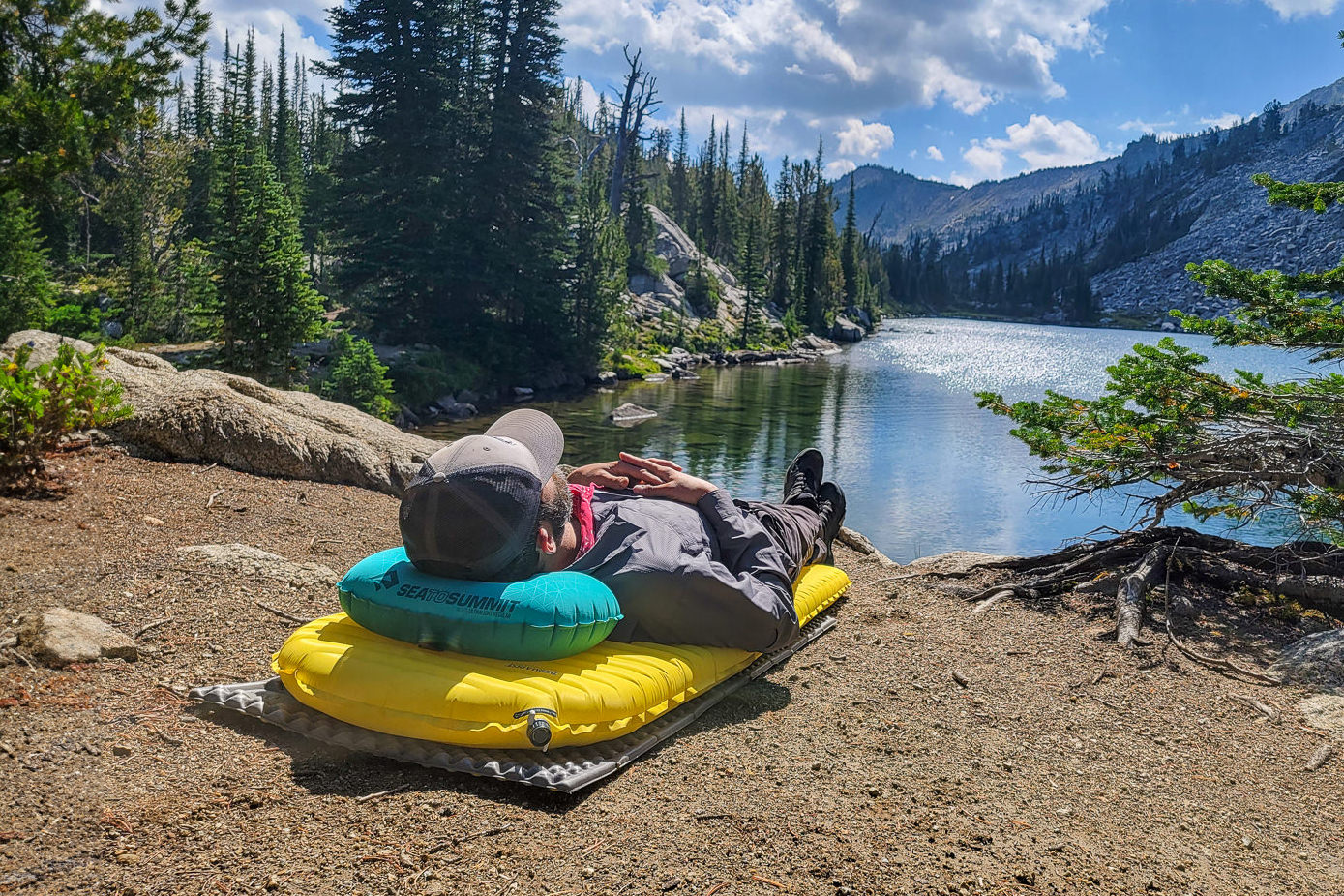
A pillow can make all the difference between sleeping like a baby and tossing and turning through the night. We’ve spent over 1,000 nights sleeping under the stars trying more than 30 different models in our pursuit of the best pillows for camping and backpacking. In this guide, we cover options from brands like Therm-a-Rest, Trekology, NEMO, Hest, and more to figure out which ones are the most comfy, supportive, easy to use, and packable so you can get your best rest on your outdoor adventures.
And for more info, check out some of our other most popular gear guides:
- Best Backpacking Tents
- Best Backpacking Sleeping Pads
- Best Backpacking Sleeping Bags
- Best Backpacking Backpacks
- Best Hiking Shoes for Men / Best Hiking Shoes for Women
Quick Picks for Backpacking And Camping Pillows
Check out this quick list of our favorite backpacking and camping pillows if you’re in a hurry, or continue scrolling to see our full list of favorites with in-depth reviews.
Best Camping & Backpacking Pillow Overall: Therm-a-Rest Compressible ($32)
Best Budget Backpacking Pillow: Trekology Aluft Pro ($22)
Best Stuff Sack Pillow for Ultralight Backpacking: Hyperlite Mountain Gear Stuff Sack Pillow ($59)
Best Budget Camping Pillow: Wise Owl Outfitters Camping Pillow ($25)
Best Full-Size Camping Pillow: HEST Pillow ($89)
Most Comfortable Air Pillow: Klymit Luxe ($50)
Comfy & Durable Air-Foam Hybrid Pillow: NEMO Fillo ($45)
Best Ultralight Air Pillow: Sea to Summit Aeros Premium ($55)
Best Air Pillow for Back-Sleepers: NEMO Fillo Elite Luxury ($70)
Ultralight Air Pillow with a Warm & Comfy Down Layer: Sea to Summit Aeros Down ($65)
Affordable & Comfy Foam Pillow for Camping: REI Trailmade Mummy Bag Pillow ($25)
We’ve been testing several new backpacking and camping pillows on our recent adventures, and there have been some big changes to our list.
- Trekology’s Aluft Pro pillow earns the number two spot and the title of best budget backpacking pillow.
- The Wise Owl Outfitters Camp Pillow lands at number four and takes the title of best budget camping pillow.
- We added the Klymit Luxe for its unrivaled comfort.
- The NEMO Fillo Elite Luxury beats out the standard Fillo Elite for a spot on our list because it’s larger and more comfy for a very small increase in weight and bulk.
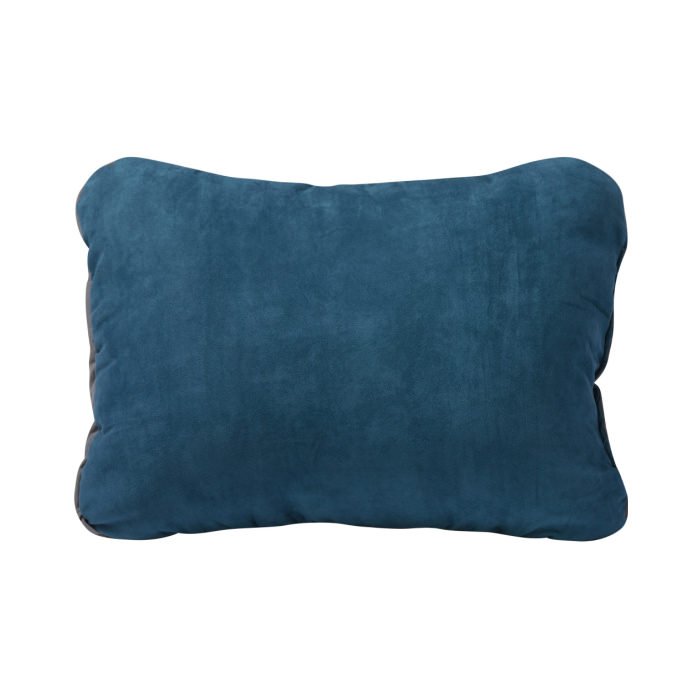
Therm-a-Rest Compressible
Best Camping & Backpacking Pillow Overall
Weight: 7 oz.
Pillow Type: Compressible foam
- Very comfortable
- Less expensive
- Very durable
- Machine washable
- Fun pillowcase patterns
- A bit heavy for backpacking
The Therm-a-Rest Compressible pillow feels almost like camping with the pillow you use at home, but it’s more compact and it doesn’t matter if it gets dropped in the dirt. While it’s bulkier than some of the other pillows on our list, we’d usually rather pack this ultra-comfy pillow than a smaller one that’s less plush.
The Compressible is comprised of a soft polyester cover with upcycled foam chunks inside. It packs into a sleeve on the cover, and the foam can be compressed down to eliminate some of the bulk. When you’re ready to use the pillow, the foam springs back to its original loft shortly after unfolding it. There’s also a drawcord on the cover that can be cinched to tailor the firmness and support to your liking.
The Compressible is CleverHiker Founder Dave Collins’s all-time favorite pillow. He’s used it for some of his most challenging backpacking trips – including multi-day treks through Jasper , Yosemite , and Banff National Parks – because he knows the great night’s sleep he’ll get with it far outweighs the extra ounces and bulk in his backpack.
The Compressible Pillow comes in several sizes for different use cases. We prefer the small size since it cuts out some weight and bulk for challenging backpacking trips, but it’s still large enough to feel luxurious in the frontcountry. Folks who tend to car camp more than backpack might prefer the medium for its larger size and still-reasonable weight, while dedicated glampers will likely find the large to be the best option.
The bottom line is: if you’re looking for a backpacking pillow that will most closely match the feeling of the one you use on your bed at home, this is it.
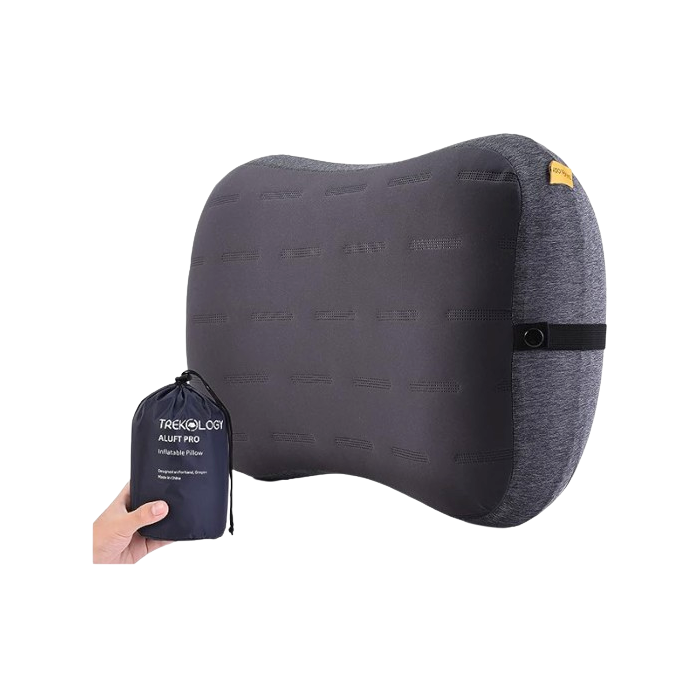
Trekology Aluft Pro
Best Budget Backpacking Pillow
Weight: 6.3 oz.
Pillow Type: Air
- Removable cover is machine washable
- Height provides excellent support
- Strap keeps pillow in case
- A bit heavier & bulkier than some
- Some users report durability issues
The Trekology Aluft Pro is one of the most affordable backpacking pillows on the market, and it’s also one of the most comfortable we’ve tested. This budget-friendly pillow has a surprising amount of premium features that make it feel like a real luxury in the backcountry.
Our favorite detail on the Aluft Pro is the strap that keeps it in place. Nothing’s worse than fighting through the night to keep your inflatable pillow on your pad, so we find that this feature adds a ton of value for very little weight. That said, the strap is removable if you don’t struggle with this and want to save a few grams.
If you’re like us, you sleep like a baby in the backcountry after a hard day of hiking. And snoozing hard can often lead to… drool. The cover of the Aluft Pro is removable and machine-washable, so sunscreen, sweat, and saliva are no problem. You can start each adventure with a fresh, clean pillow.
We absolutely love this model, and have very few downsides to note. Although there are enough users reporting the Aluft Pro leaking air after a few uses that it definitely bears mentioning. One of our gear testers tested this pillow over the course of about a month on the Arizona Trail without incident, and any gear that makes it through the prickly campsites of the AZT is pretty hardy in our view. Still, it’s always best to pack a patch kit and be prepared to perform field repairs if issues arise.
This pillow may be a little heavier and bulkier than some of the truly ultralight air-filled options on this list, but we think most hikers will be very pleased with the comfort and convenience of the Aluft Pro. However, if saving weight and bulk is a priority for you, take a look at the Aluft 2.0 . This pillow isn’t as thick and soft as the Pro model, but it’s a couple ounces lighter, considerably smaller when packed, and even more affordable.
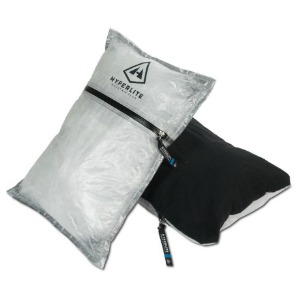
Hyperlite Mountain Gear Stuff Sack Pillow
Best Stuff Sack Pillow for Ultralight Backpacking
Weight: 1.7 oz.
Pillow Type: Stuff sack
- Very durable for the weight
- Doubles as waterproof stuff sack
- Requires extra clothing
- Slippery underside
For hikers who prioritize saving weight above all else, the Hyperlite Mountain Gear Stuff Sack Pillow is a very comfortable and functional option that serves a dual purpose.
With the Dyneema sides facing out, this is a waterproof stuff sack for your clothing or whatever else you want to keep protected from the elements. But turn it inside out at night to expose the fleece lining, and you’ve got a soft and comfortable pillow.
We find that this pillow is best used in warmer hiking months. Since you need something to stuff inside to give it loft, it’s better in temperatures where you won’t need to sleep in all of your clothes. A down jacket is an excellent way to fill out the pillow, and then you can add other things – like extra socks or base layers – to dial in the firmness.
Of course, you may run into the unexpected chilly night when you do end up wearing all your extra clothes for sleeping, in which case your pillow won’t be very plush. But we’ve found that we usually have a few small things to stuff inside when this happens (like other stuff sacks, a pack towel , or toilet paper roll) to make a passable pillow for the night.
The HMG Stuff Sack Pillow is very similar to the Zpacks Medium-Plus Dry Bag Pillow . Both cost the same, weigh the same, and are great choices, but there are a couple of key differences. The Zpacks pillow is a little longer and made with slightly thicker Dyneema fabric. However, the HMG pillow wins the spot on this list over the Zpacks stuff pillow because the zipper placement is more convenient. The Zpacks zipper is at the very top, so you would need to pull things out to access clothes that are lower down. The HMG zipper splits the pillow about a quarter of the way down, making it more convenient to put small things up top and larger things in the bottom part with quick, easy access to both.
While the HMG pillow is made with a slightly thinner DCF fabric than the Zpacks pillow (0.8 oz./sq. yd. DCF vs 1 oz./sq. yd. DCF), we’d say the durability is pretty much a tie. CleverHiker Senior Gear Analyst, Casey Handley, finally reached the end of the road with her HMG Stuff Sack Pillow after about six years and 4,000 miles of hiking. Pretty impressive for a fleece-lined stuff sack weighing less than two ounces.
Though the HMG Stuff Sack Pillow is expensive, the durability makes it worth the cost – it’ll likely outlast many air pillows in the same price range. This is as light as it gets if you want to go minimal without sacrificing comfort.
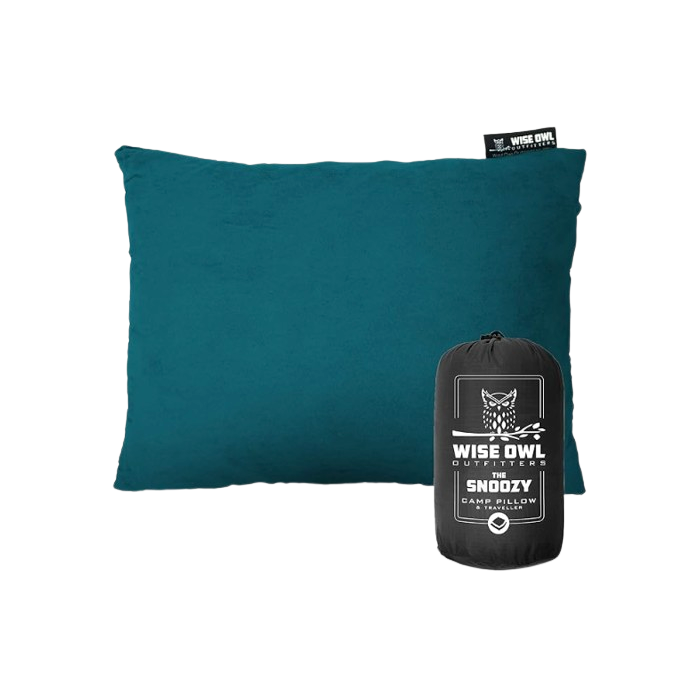
Wise Owl Outfitters Camping Pillow
Best Budget Camping Pillow
Weight: 9 oz.
Pillow Type: Foam
- Foam chips can feel lumpy
The supportive and affordable Camp Pillow from Wise Owl Outfitters offers a lot of comfort.
This pillow is pretty similar to our top pick, the Therm-a-Rest Compressible , but it’s a bit more geared towards frontcountry camping. The Wise Owl is one inch larger in length and width than the Therm-a-Rest Compressible, so naturally it weighs a few ounces more. When packed, this is one of the bulkiest pillows on our list, and it weighs over half a pound. We don’t recommend it for backpacking, but it does a great job of mimicking the pillows we use at home while car camping.
There are many cheap pillows like this one on the market, but the Wise Owl earns its place on this list for its supportive design. During testing, we found that similar budget pillows had a tendency to flatten out quickly, while the Wise Owl held its shape much better. The loft is adequate for side sleeping, and the foam filling can be shifted around inside to tailor the support.
Among the affordable competitors, the Teton Sports Camp Pillow is the most comparable option as far as quality for the price. This pillow has a synthetic feather-like fill that flattens out more than the Wise Owl’s foam fill, so it could be a more enticing option for back-sleepers who don’t want their head to rest so high.
Both the Wise Owl and Teton Sports camping pillows are great options, and if we were choosing between the two – we’d probably just buy whichever one was running a better sale at the time.
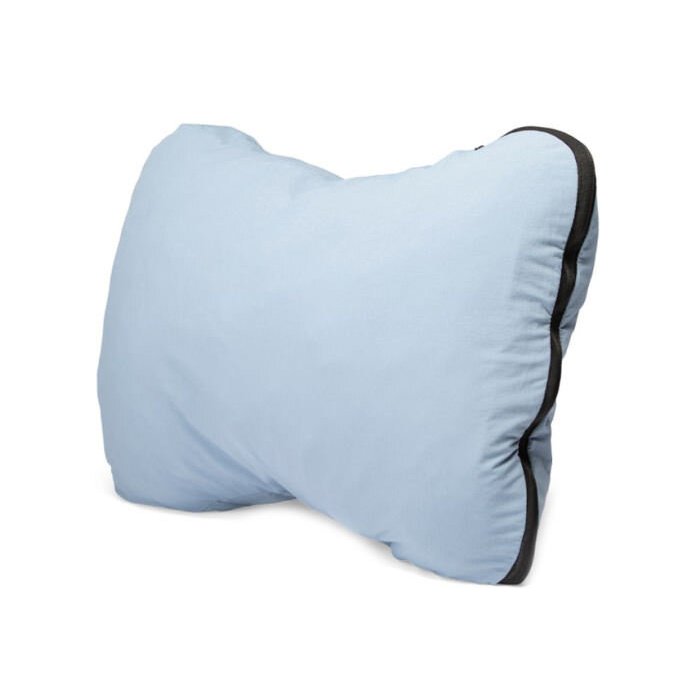
HEST Pillow
Best Full-Size Camping Pillow
Weight: 2 lb. 3.2 oz.
- Too heavy & bulky for backpacking
The HEST Camp Pillow brings the comfort of home to your frontcountry endeavors. It’s nearly as large as a regular bed pillow, and the shredded memory foam fill provides excellent support that doesn’t flatten out.
At 2 lb. 3.2 oz., the HEST Pillow is one of the heaviest and bulkiest pillows we tested, so it’s not for backpacking. But it’s the perfect luxury pillow for car camping and travel when comfort is a priority.
For the ultimate plush setup, we like to pair this pillow with the Exped MegaMat from our list of the Best Camping Mattresses . This dream duo will have you sleeping like a rock and may make you forget all about your bed at home.
The regular size is plenty big for our needs, but an even larger Standard Pillow is also available if you’re after maximum luxury. Just keep in mind that the Standard costs quite a bit more and will take up more space in your gear storage if you’re stuck deciding between the two.
The HEST Camp Pillow is our top recommendation for those who value comfort above all else and for campers who have a hard time catching Z’s when away from their bed at home. Though it’s quite expensive, the high-quality materials and washable cover will keep it adventure-ready for many years of outdoor fun.
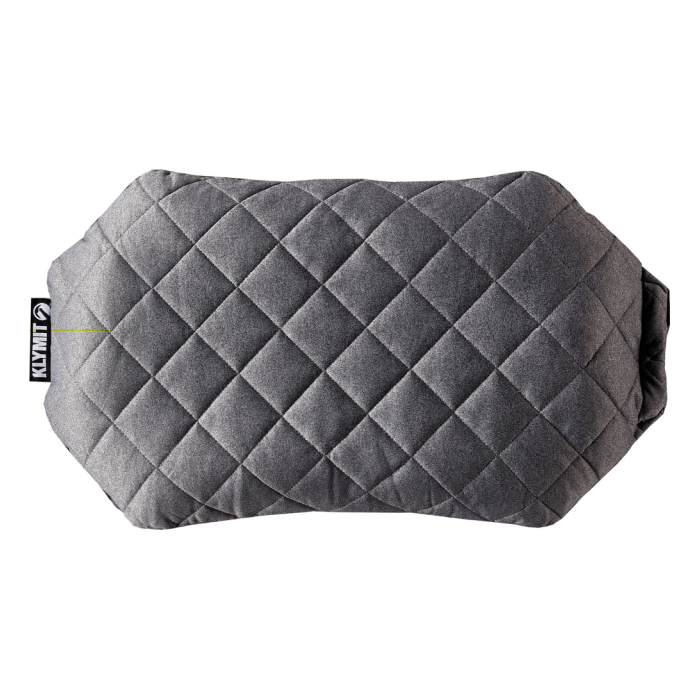
Klymit Luxe
Most Comfortable Air Pillow
- Wider than most backpacking pillows
- Lightweight for the size
- Machine washable cover
- A bit expensive
The Klymit Luxe pillow is our top recommendation for backpackers who prioritize comfort. This large, supportive pillow is heavier and bulkier than the pillows we usually take for long backpacking trips, but it’s by far the most comfortable air pillow we’ve tested.
At 22 inches long and 12.5 inches wide, the Luxe is the largest backpacking pillow on our list. It’s also one of the thickest with a whole five inches of loft. When you consider the dimensions, the weight and packed size are actually a lot more impressive. We firmly believe that if your backpacking pillow isn’t comfortable, it’s wasted weight and space anyway. So we’re willing to carry the Luxe into the backcountry over an ultralight option for its significant boost in comfort.
Though the Luxe is far from affordable, we think it’s actually a pretty fair price for what you’re getting. You’d pay the same for a smaller, lighter pillow that maybe isn’t as comfortable. And if you’re going to be spending the same amount of money, it’s definitely worthwhile to consider trading in the weight savings for added comfort.
Like many modern camp pillows, the Luxe comes with a removable cover that can safely go through the washing machine. What makes this cover a bit unique, though, is the snap closure on the end that hides away the valve stem. This small detail eliminates any chance of the valve interfering with your sleep, and we’ve really come to appreciate it.
Car campers and backpackers alike will love the Klymit Luxe for its unrivaled balance of comfort, weight, and price. Those who don’t mind carrying a little extra weight and bulk in exchange for more comfort should stop the pillow search here.
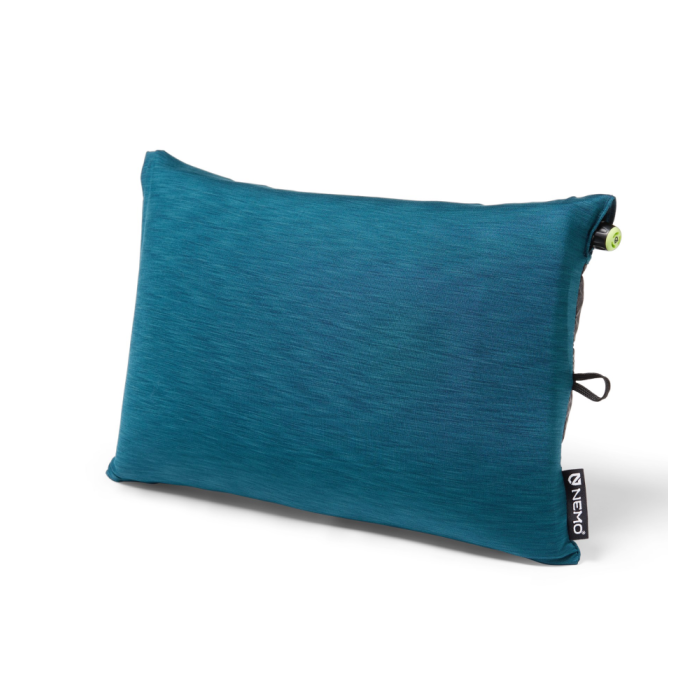
Comfy & Durable Air-Foam Hybrid Pillow
Pillow Type: Foam/air
- Above-average durability for an air pillow
- Machine washable case
- Integrated stuff sack
- A bit bulky/heavy for backpacking
The NEMO Fillo has been one of the most popular camping pillows on the market for many years because it’s well-made, provides excellent support, and it’s plush enough for the frontcountry while still being reasonably light for the backcountry.
Its soft, removable cover, durable air bladder, and sturdy valve make this pillow a high-quality investment that will really up the comfort on your camping trips. But what really sets the Fillo apart from other air pillows is the thick foam topper. Some air pillows can end up feeling like you’re sleeping on a pool toy, but this layer of foam – combined with the I-beam air chambers and the soft microsuede/jersey cover – make for a much more comfy night’s sleep.
At nine ounces, the Fillo isn’t our first choice for long backpacking trips, but it’s a comfortable option for car camping, travel, and short backcountry adventures. And while it’s also a bit bulkier than many of the pillows we prefer to backpack with, the plush design is worth it for those who prioritize a cozy night’s sleep when hitting the trail for multi-day trips.
For backpacking, we prefer the Fillo Elite Luxury and Fillo Elite listed below for their lower weight and bulk. But you’ll miss out on the cushy foam layer of the standard Fillo and an extra inch of thickness with those alternatives.
Users who will get the most value out of the Fillo are those who are looking for a pillow that feels luxurious for car camping while being light enough for the occasional trek into the backcountry.
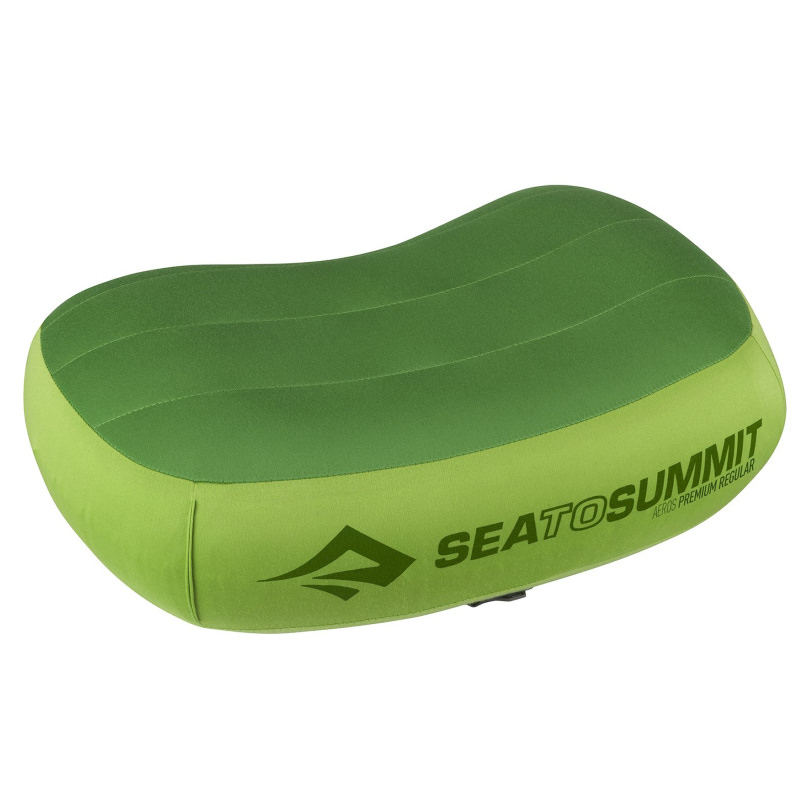
Sea to Summit Aeros Premium
Best Ultralight Air Pillow
Weight: 2.7 oz.
- Too firm for some
- Minimally insulated
The Sea to Summit Aeros Premium is one of our all-time favorite air pillows for backpacking since it strikes the perfect balance between comfort and low weight.
At just 2.7 ounces, the Aeros Premium is one of the lightest air pillows on the market, and it also packs down incredibly small. Don’t let its tiny size fool you though, this thing packs a ton of comfort. The regular size – our size preference for saving weight on backpacking trips – sits at 4.3 inches high, so it’s got a great amount of loft and support for side sleepers.
That said – when inflated to its full height – the Aeros Premium is pretty firm, and it can start to hurt your ear if you lay on one side for too long. You can easily let out some air to make it a bit squishier, but we still find pillows with foam tops (like the admittedly much heavier NEMO Fillo ) to be more comfortable for side sleeping.
One of our favorite features of the Aeros Premium is the multifunctional valve. The first flap opens up to a one-way valve for quick deflation, and you can also press the center of this valve to make micro-adjustments to the firmness. Opening the second flap reveals the dump valve which makes for quick and easy deflation.
Another unique detail is this pillow’s compatibility with Sea to Summit’s PillowLock system. PillowLock is a set of soft Velcro-like stickers that come with Sea to Summit backpacking sleeping pads . These special tabs latch on to the fabric of the Aeros line of pillows and lock them in place while you sleep. Unfortunately, PillowLock isn’t sold on its own at this time, so you can only take advantage of this feature if you also have a Sea to Summit pad.
Backpackers looking to cut out weight without sacrificing support should keep the Aeros Premium at the top of their list. This tried-and-true favorite sits taller than many other ultralight air pillows, and its superb valve makes it easy to dial in your perfect firmness.
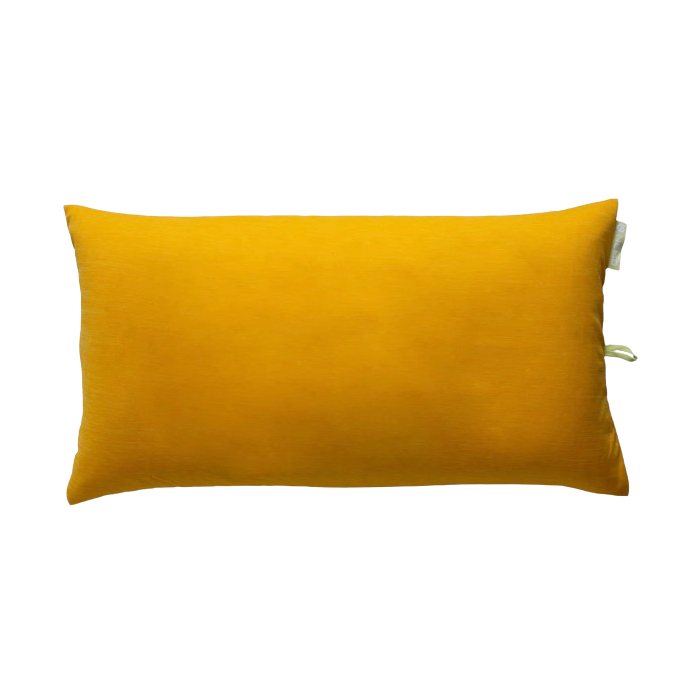
NEMO Fillo Elite Luxury
Best air pillow for back-sleepers
Weight: 4 oz.
- Lightweight
- Very comfortable for back-sleepers
- A bit heavier/bulkier than UL backpacking options
The NEMO Fillo Elite Luxury has become one of our go-tos due to its generous dimensions, soft surface, and low weight.
At 21 inches wide, the Fillo Elite Luxury stretches across the entire width of a regular-size backpacking sleeping pad , so you have plenty of room to roll around without coming off the pillow. Backpacking pillows have a tendency to slide off of pads, but we find the extra length usually ensures that at least part of the pillow remains in place for a comfy night’s sleep.
The Fillo Elite Luxury sits at three inches high, so it’s not the most supportive option for side-sleepers. But back-sleepers will appreciate that this pillow doesn’t strain your neck by keeping your head too high. CleverHiker Senior Gear Analyst Casey Handley, who is a rotisserie-sleeper that usually ends up on her back or stomach, tested this pillow over 500 miles of the Arizona Trail, and she found that the width gave her plenty of room to change positions and the height was perfect for providing support while sleeping on her back.
Hikers looking to shave off a few grams may find the standard Fillo Elite to be a good middle-ground between weight and comfort. It’s only 15 inches wide (a full six inches less than the Luxury model), but it weighs in at just 2.8 ounces and packs down smaller. While there’s less room to wriggle around on the Fillo Elite, those who tend to stay stationary through the night will likely prefer this lighter and less expensive version.
With a light layer of synthetic insulation on top and a soft jersey case, the Fillo Elite Luxury is more comfortable than most other inflatables. It’s a bit pricey, but it’s well-designed with an integrated stuff sack that’s impossible to lose, a removable case for easy washing, and a top-notch valve.
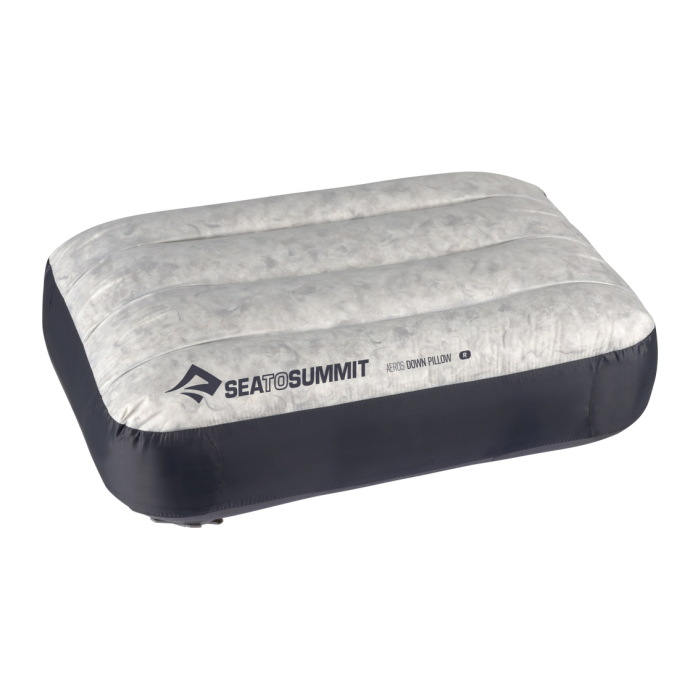
Sea to Summit Aeros Down
Ultralight air pillow with a warm & comfy down layer
Weight: 2.5 oz.
The Sea to Summit Aeros Down pillow is the lightest air pillow on our list and it’s more padded and comfy than the average ultralight option.
This pillow has a thin layer of down cushioning on top that provides some extra comfort and warmth, but it’s also what makes it a bit spendier than many others. That said, we think the Aeros Down is worth the cost for its quality build. CleverHiker Senior Gear Analyst, Casey Handley, has spent more than 75 nights in the backcountry – including her thru-hikes of the Colorado Trail and Long Trail – with the Down Pillow, and it’s still going strong.
Just like the Aeros Premium above, the Aeros Down also has an excellent valve system. The first flap conceals the one-way inflation valve that also allows for easy micro-adjustments, and the second flap opens up the dump valve for effortless deflation.
Hikers looking to shave every gram possible without sacrificing the comfort and support of an air pillow can’t go wrong with the Aeros Down Pillow.
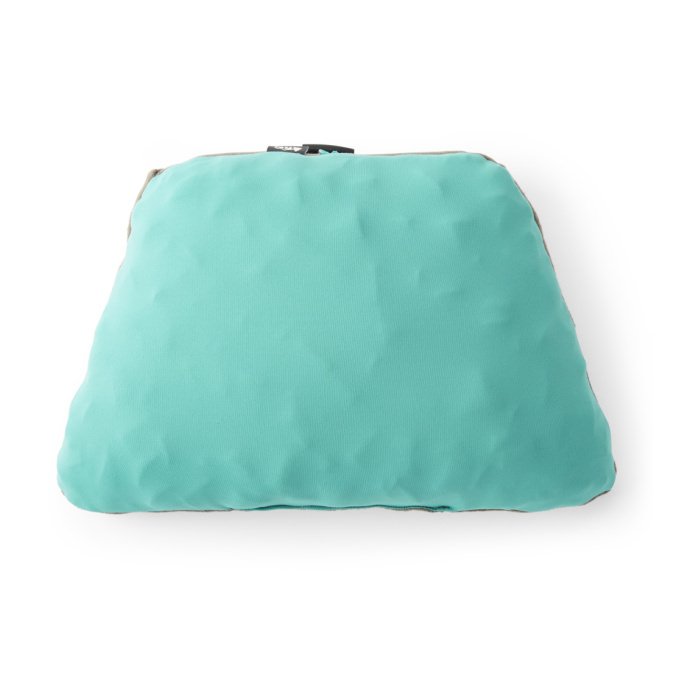
REI Trailmade Mummy Bag Pillow
Affordable & Comfy Foam Pillow for Camping
Weight: 5.25 oz.
- Very comfortable once you get the foam situated
- Heavier/bulkier than some
The REI Trailmade Mummy Bag Pillow is an affordable option that slips inside the hood of a mummy sleeping bag for all-night comfort that stays put. This pillow is plush enough for camping, light enough for backpacking, and packable enough for travel, so it’s an excellent choice if you’re looking for a do-it-all pillow.
We find the foam filling of this pillow to be comfier than many air pillows since it’s not as firm and it conforms to your body shape. However, the Trailmade feels lumpy compared to our favorite foam pillow, the Therm-a-Rest Compressible , listed above. Still, the Trailmade is lighter and more affordable, so it’s a solid option for budget-conscious hikers. And you can always shift the shredded foam fill around to customize the shape a bit.
One of the best features of the Trailmade is the innovative cover. It has a cozy fleece side and a cool polyester side, so you can flip it to optimize comfort depending on the conditions. When you’re ready to pack up in the morning, the foam pillow compresses into the cover to save space in your backpack. And then once you’re back home, pop the whole thing in the washing machine to bring it back to good as new.
We tend to opt for a lighter and smaller pillow on long, challenging backcountry trips. But the Trailmade only weighs 5.25 ounces, so it’s totally backpacking-worthy if comfort is a priority.
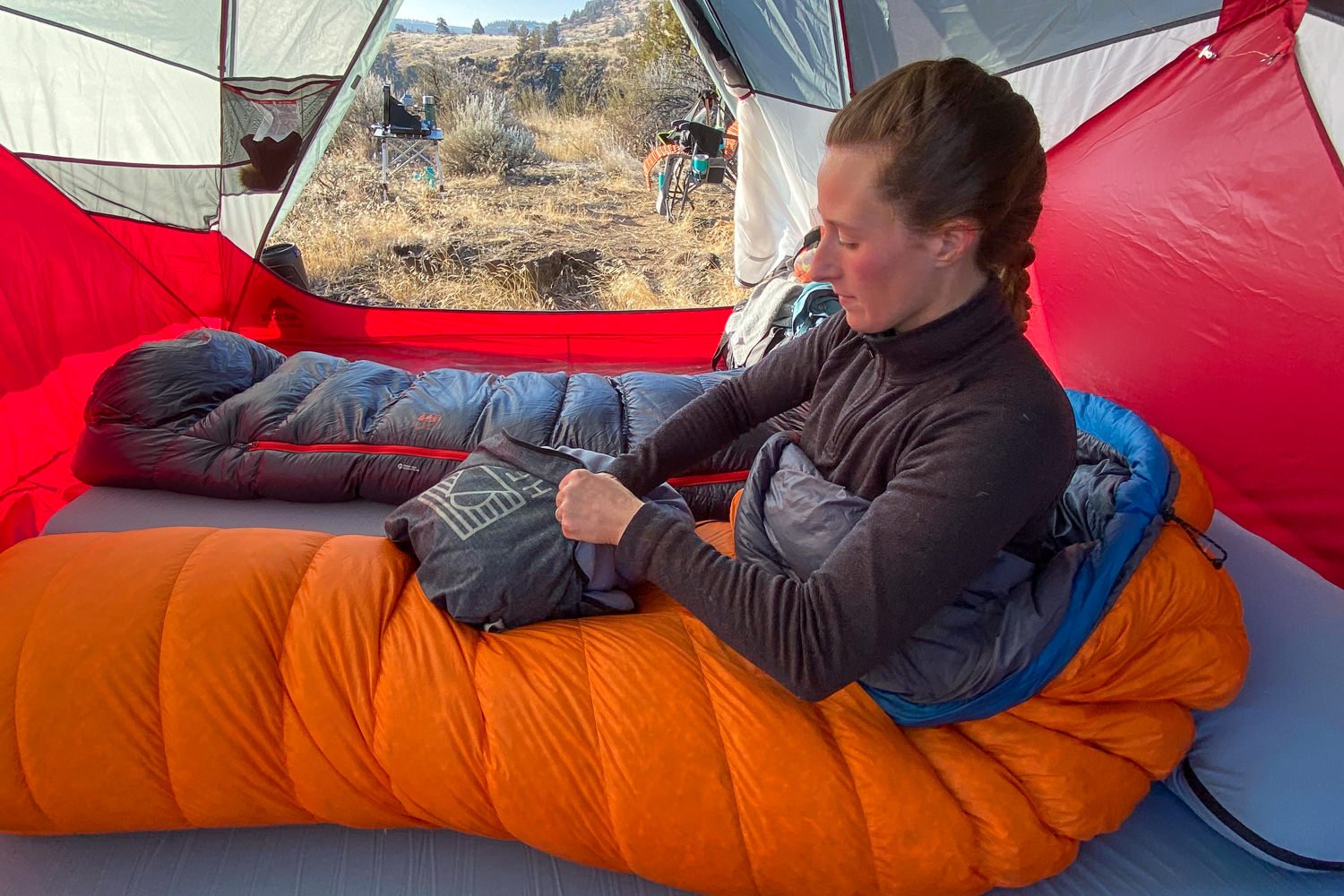
Product Comparison Table
How we test & methodology.
Here, we outline what we look for in the best backpacking pillows, including comfort, support, weight and packed size, and ease of use. We take every pillow on our list backpacking for a minimum of seven nights to identify the benefits and limitations that impact sleep quality.
We evaluate the pillow’s material composition and texture, looking at how the fabric and the type of pillow – foam, synthetic, air, or hybrid – contribute to overall comfort. Pillows with soft, brushed fabrics that offer an outstanding skin feel as well as sweat, condensation, and moisture-wicking properties lead this category because these features keep the pillow dry and comfortable. Top performers for comfort usually have ergonomic designs and are highly adjustable for firmness, so we test features like inflation systems and prioritize pillows with contoured shapes that work well in any sleeping position. We also use these pillows for months and years to assess their long-term durability and performance, and how well they maintain that comfort level over time.
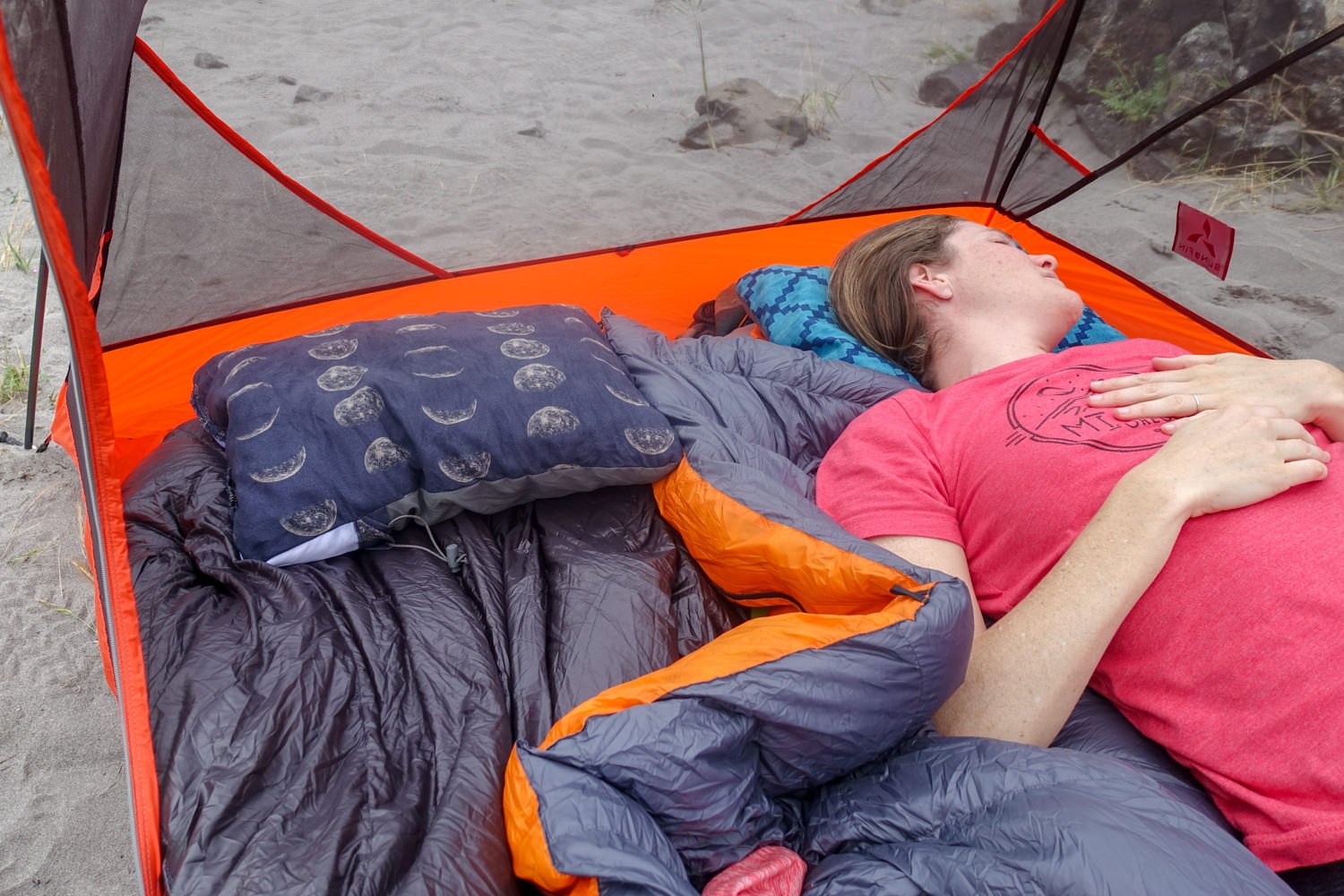
To understand how supportive backpacking pillows are, we conduct detailed assessments while on overnight trips over many months. We sleep on our backs, sides, and stomachs to learn how well each pillow keeps proper spinal alignment and reduces pressure points, preventing discomfort and promoting restful sleep for all sleeping styles. And, we consider the materials used in construction, prioritizing pillows that offer both support and durability without compromising on weight or packability.
WEIGHT & PACKABILITY
To measure the weight and packed size of pillows, we spent many nights in the backcountry field testing each model and looking at how well each pillow fits within the limited space of a backpack. We measure each pillow’s initial weight and dimensions to understand how packable and portable they are. Through rigorous compressibility tests – namely, rolling, compressing, and shoving them into our backpacks – we determine how tightly each pillow can be packed and how well it integrates with other gear. We scrutinize the materials used and the style of pillow – inflatable versus compressible foams – with winners offering lightweight yet durable fabrics and fills that keep the overall weight low.
EASE OF USE
Easy-to-use pillows are fast to set up and require only a couple of steps, so we start by addressing the inflation and deflation mechanisms and discuss how intuitive and efficient they are for adjusting pillow firmness. We evaluate setup and pack-down to be sure pillows are straightforward to deploy at camp and easy to stow away when on the move. We look for pillows with features like integrated stuff sacks and storage pockets to understand how practical they are for organizing and using the pillow when setting up camp. We also consider how easy a given pillow is to clean and maintain, noting materials that are convenient to wipe down or machine wash.
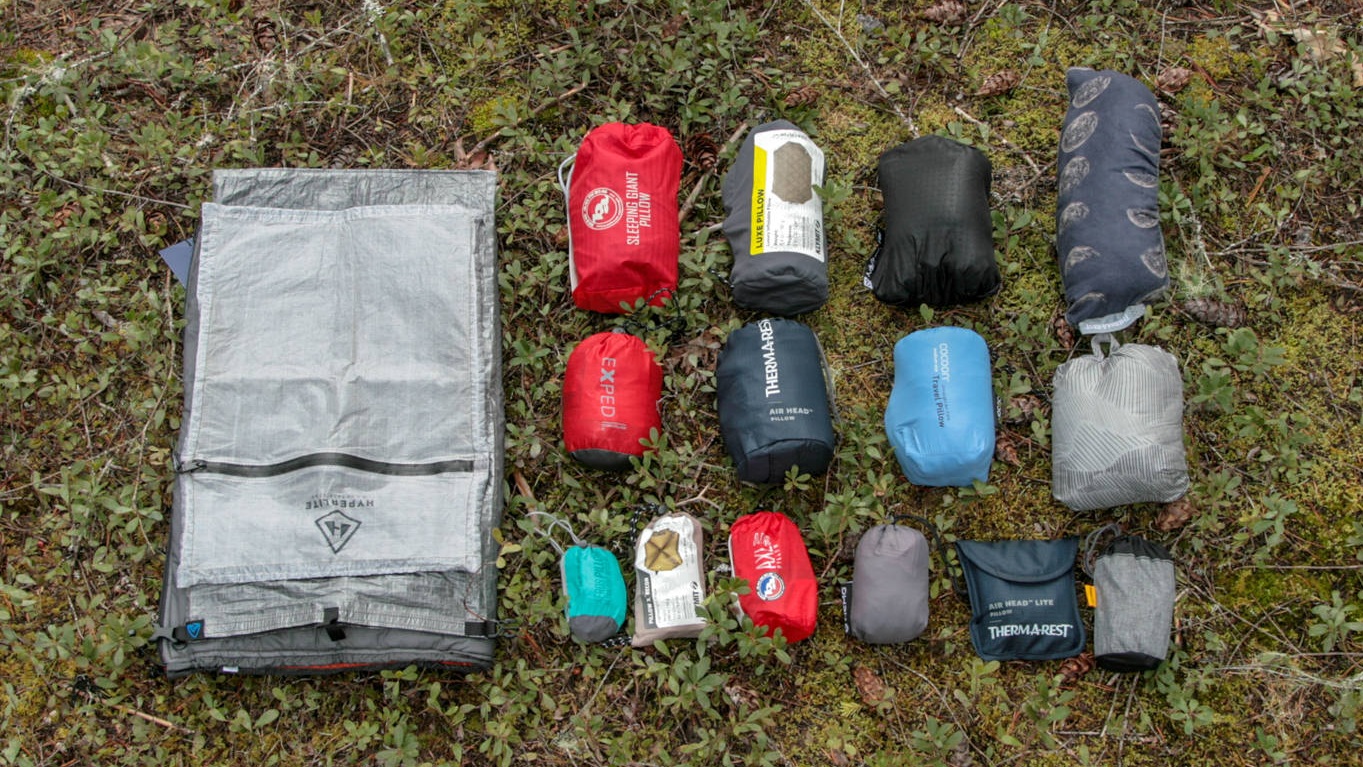
Why Trust CleverHiker
With more than 1,000 nights sleeping outdoors, the CleverHiker team knows a thing or two about comfort in the wild. Gear Analyst, Casey Handley , has tackled thousands of trail miles along the Appalachian Trail, Colorado Trail, and Arizona Trail, thoroughly testing dozens of backpacking pillows to make sure only the top performers land on our list. With a background in gear sales and detailed product reviews, she sets the bar high for quality and functionality when it comes to gear reviews. Her deep knowledge of long-distance hiking guarantees her recommendations are spot-on for adventurers at any level.
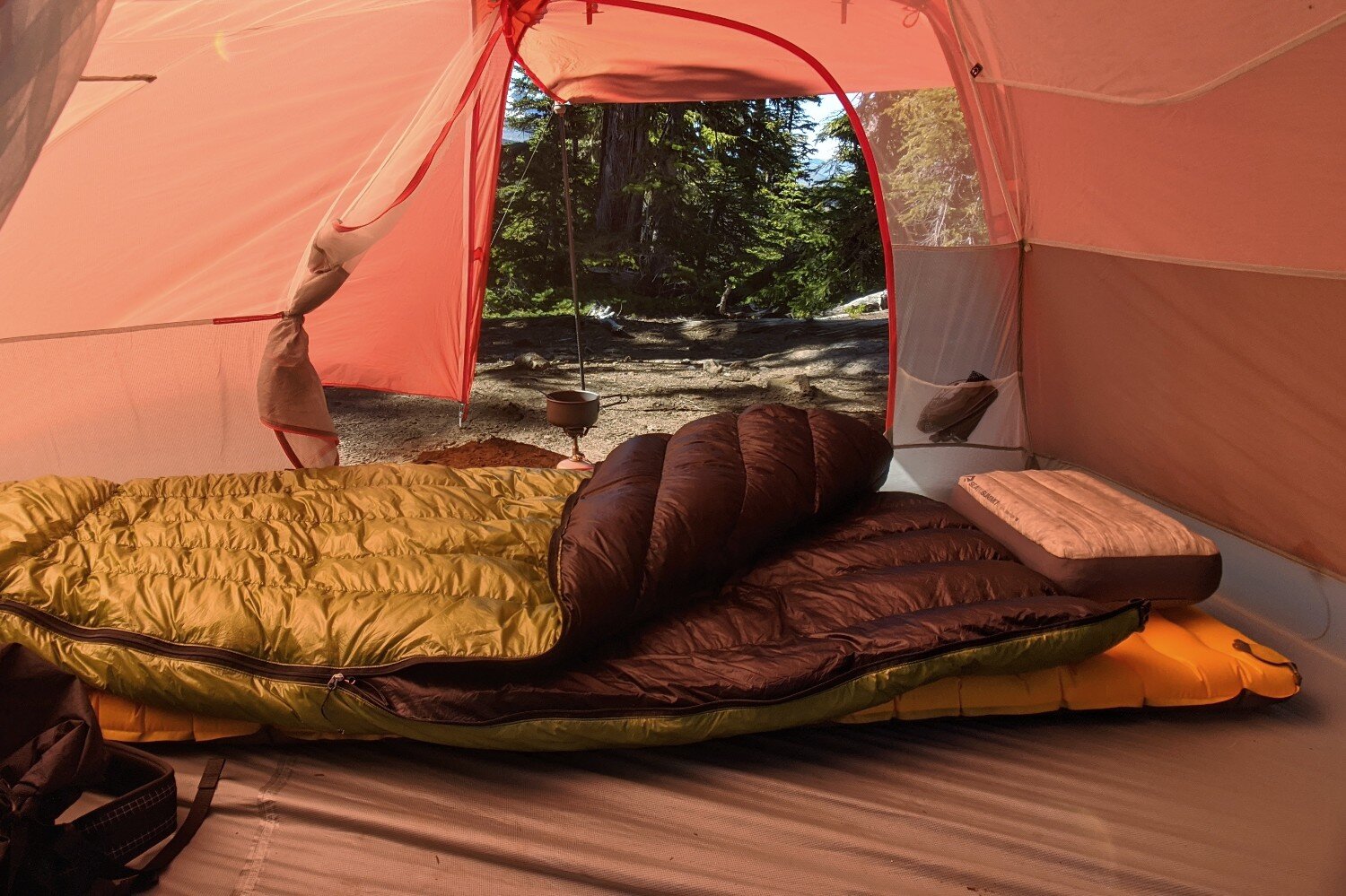
Analysis & Results
Rest easy and keep scrolling to find out which pillows are the best when looking at comfort, support, weight and packability, and ease of use.
Performance is crucial for our backpacking pillows, but we also look for models that offer long-term value. From cost-effective picks to high-end, we only add the best pillows so every backpacker can find their perfect fit.
The best value pillows are the REI Trailmade Mummy Bag Pillow , the Therm-a-Rest Compressible , and the Sea to Summit Aeros Down . These three offer outstanding comfort, portability, and durability that make them a great deal for backpackers looking to save space and weight.
The REI Trailmade Mummy Bag Pillow stands out with its dual functionality as both a pillow and a storage sack, offering a small, soft surface to rest your head, and organization for gear when you’re hiking, for one of the lowest prices on our list. The Therm-a-Rest Compressible Pillow is a close second with a soft surface, upcycled foam construction, and long-lasting support. And, the Sea to Summit Aeros Down Pillow is one of the cushiest options we tried – its luxurious down filling offers exceptional warmth and comfort, especially in cold conditions, and its efficient multi-function valve makes for effortless inflation and adjustments.
The HEST Pillow is our top pick for comfort – it’s not only one of the most ergonomic pillows we tried, but one of the best for support. Its soft memory foam core offers stellar neck and head stabilization for excellent alignment all night long, and the contoured shape and plush outer fabric make it as cozy as camp pillows come.
We also love the Wise Owl Outfitters Camping Pillow for its lightweight, compressible design. It caters perfectly to backpackers who value portability and versatility in their gear – and because its adjustable inflation system is so sensitive, you can customize the firmness to your exact preference. Its microfiber cover and incredibly compact size when deflated make it a dream for backpacking. Also on the podium is the NEMO Fillo , which stands out for its unique combination of memory foam paired with an inflatable design. Its luxurious cushioning – with a suede or jersey cover – offers amazing comfort that packs small into its own stuff sack for easy carrying.
Both the Sea to Summit Aeros Premium , the HEST Pillow , and the Therm-A-Rest Compressible provide excellent support for the head and neck during backpacking trips and reduce the chance of strain, pain, or cramping after a long day of hiking.
The Sea to Summit Aeros Premium is easy to inflate in just a few breaths and fine-tune with the valve. Its ergonomic design with a scalloped bottom edge that coddles your head and wraps around your shoulders accommodates back, belly, and side sleepers. The HEST Pillow is a very close second, but it achieves excellent support thanks to a memory foam core that quickly softens and molds around the contours of your head and neck for proper alignment while reducing pressure points. We also love the Therm-a-Rest Compressible backpacking pillow because its foam filling provides consistent cushioning, its shape cradles the head and neck perfectly, and the adjustable loft is a dream for personalized comfort.

If you’re looking for the lightest, most compressible backpacking pillows on the market, you’ll want to consider the Hyperlite Mountain Gear Stuff Sack Pillow , Sea to Summit Aeros Premium , and Sea to Summit Aeros Down pillows. Each one features materials and construction aimed at reducing overall weight – but without compromising comfort and support.
The Hyperlite Mountain Gear Stuff Sack Pillow is a unique, dual-purpose option. It’s essentially a zippered stuff sack with a fleece lining that you turn inside out to serve as a pillow at night – simply stuff it with extra clothes to your desired firmness. And, you can either roll it up during the day or turn it inside out again and use it as a gear sack. The Sea to Summit Aeros Premium Pillow stands out for its combination of inflatable and synthetic cushioning that packs incredibly small. Similarly, the Sea to Summit Aeros Down Pillow is basically the same model but uses a premium down filling, making it perfect for cold-weather nights, but still packs down small in your backpack.
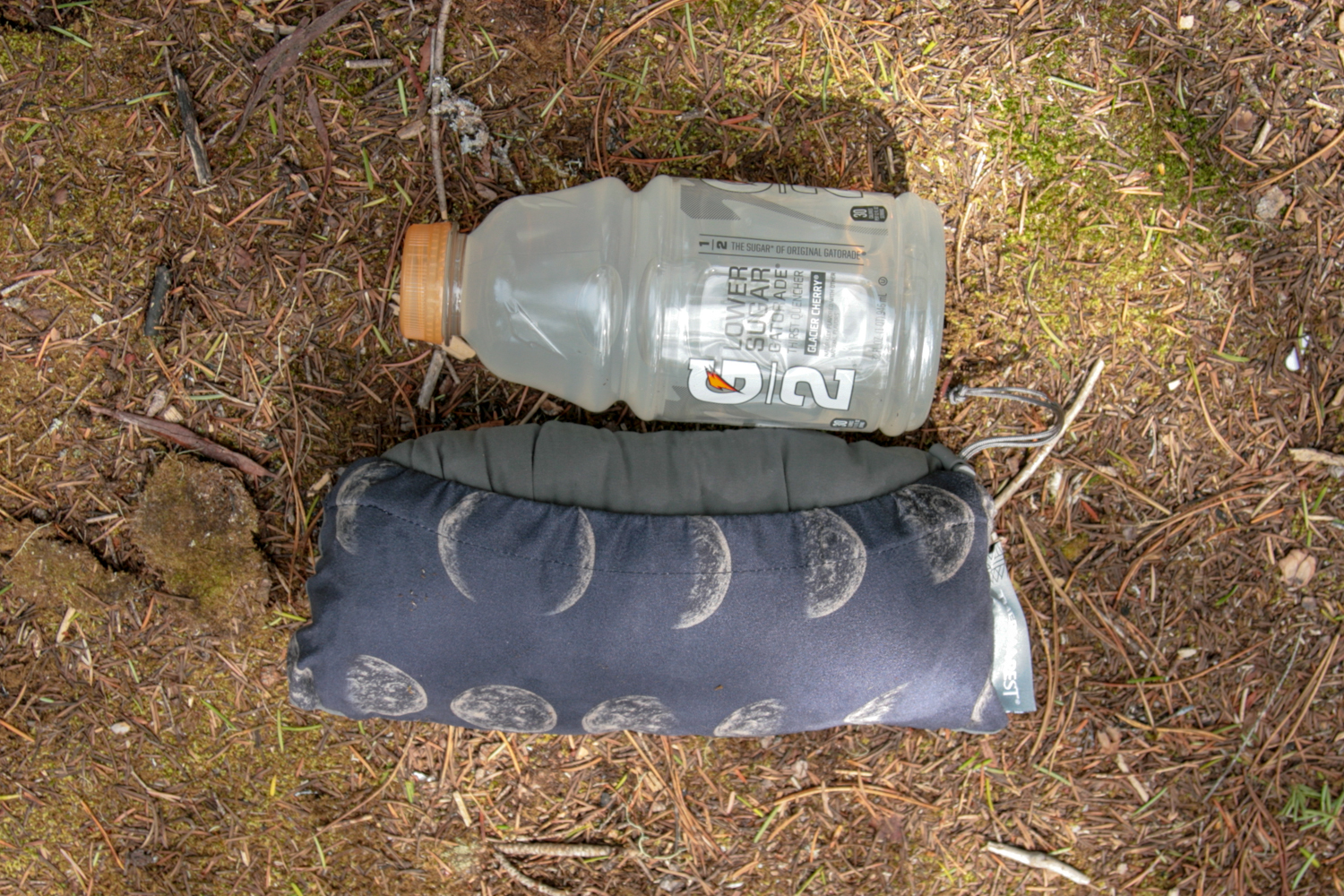
The Therm-a-Rest Compressible , the Wise Owl Outfitters Camping Pillow , and the NEMO Fillo are in the top positions when it comes to ease of use. The Therm-a-Rest Compressible Pillow is as simple as it gets since it doesn’t need any inflation. This one can be compressed or expanded with a simple drawcord thanks to foam fill that rebounds quickly for instant comfort. The Compressible fits into its own integrated stuff sack for convenient storage and transport. The Wise Owl Outfitters Camping Pillow is our other top pick: the adjustable inflation system makes getting the perfect firmness a breeze, and the soft microfiber cover can be removed for cleaning. The NEMO Fillo is another great option because its integrated stuff sack allows for effortless storage and portability, and the easy-to-use inflation system makes for a quick setup and precise adjustment, perfect for backpackers on the go.
How to Choose a Backpacking Pillow
Backpacking & camping pillow types.
There are pros and cons to every type of camping pillow. Here are the main categories of backcountry pillows and some quick links to our top recommendations.
Stuff Sack Pillows
Stuff sack pillows are ultralight and excellent for backpacking, but they require a puffy jacket or other soft clothing to give them loft. They can be very comfortable with the right stuffing, but depending on what you fill them with, they can also be hard or compress too much. Our top picks: Zpacks Medium Dry Bag Pillow & HMG Large Stuff Sack Pillow
UL Inflatable Pillows
Ultralight inflatable pillows weigh next to nothing and hold their shape to offer good height and support for side-sleepers. If you choose an air pillow, make sure to figure out the firmness that works best for you. Over-inflated air pillows can be a bit unstable, difficult to keep in place, they can be hard on the ears after a few hours. Our top picks: Sea to Summit Aeros Premium & NEMO Fillo Elite .
Compressible Pillows
Compressible pillows are made of materials that expand, like shredded pieces of foam. They’re often very comfortable and closely mimic the pillows we use at home, but they also tend to be much bulkier and heavier than stuff sack pillows and ultralight inflatables. We usually choose these types of pillows for car camping, but a small one can also be a real game-changer for backpacking. Our top picks: Therm-a-rest Compressible & HEST Pillow .
Hybrid Pillows
Hybrid pillows often consist of an air bladder topped with a layer of foam or down insulation. They share the same height and support benefits of ultralight air pillows, but they’re typically much more comfortable. These pillows are heavier and bulkier than ultralight air pillows, but they’re often lighter and more compact than compressible pillows. Our top pick: NEMO Fillo .
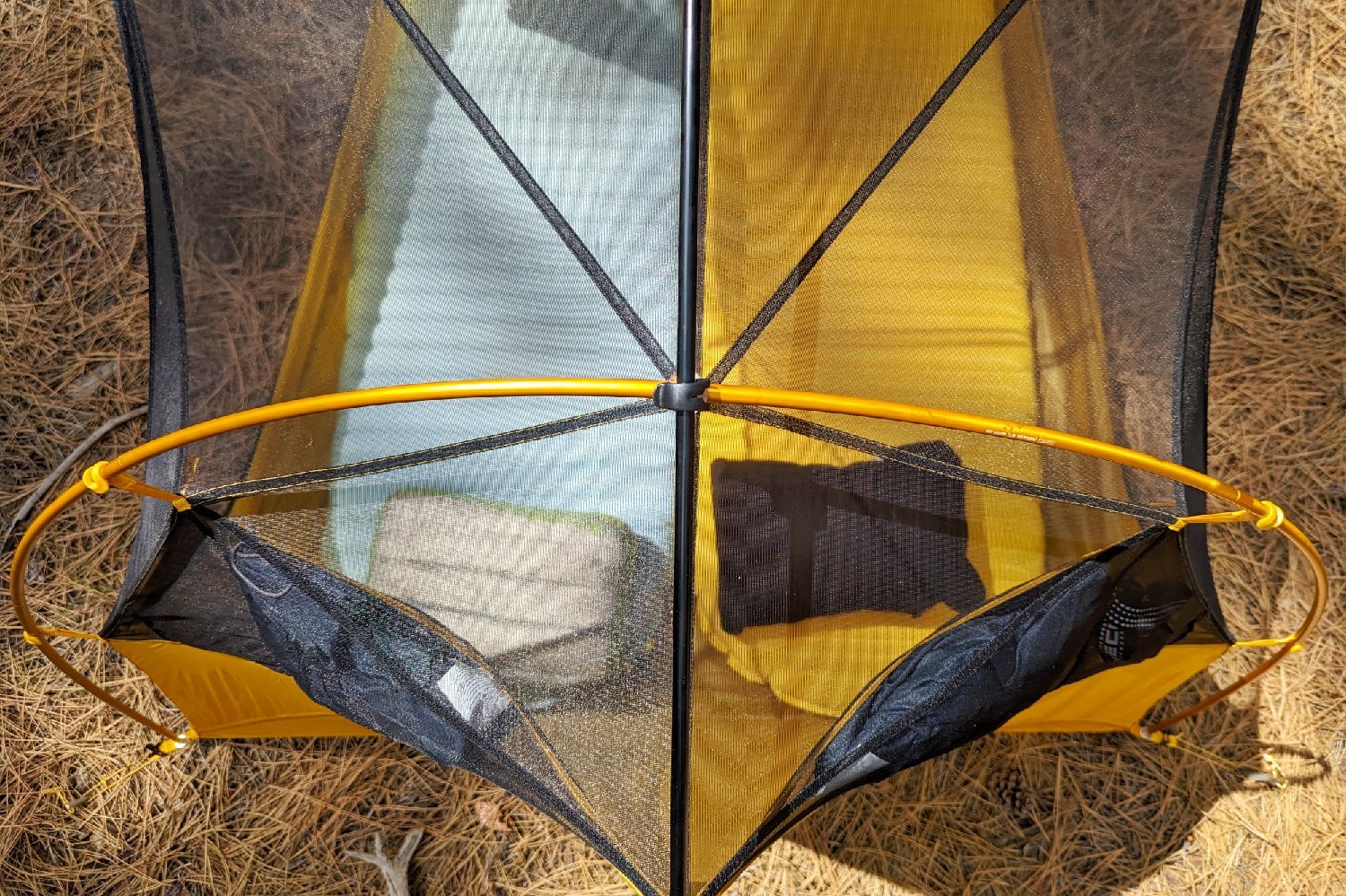
SLEEPING STYLES
Size, shape, warmth, and surface all come together to determine how comfortable a camping pillow is. Look for one that compliments the position you like to sleep in, accommodates your size, and satisfies your preferences for softness or firmness. Side sleepers commonly prefer pillows with a bit more height to support the neck and shoulder, while back sleepers might prefer softer, lower-profile pillows.
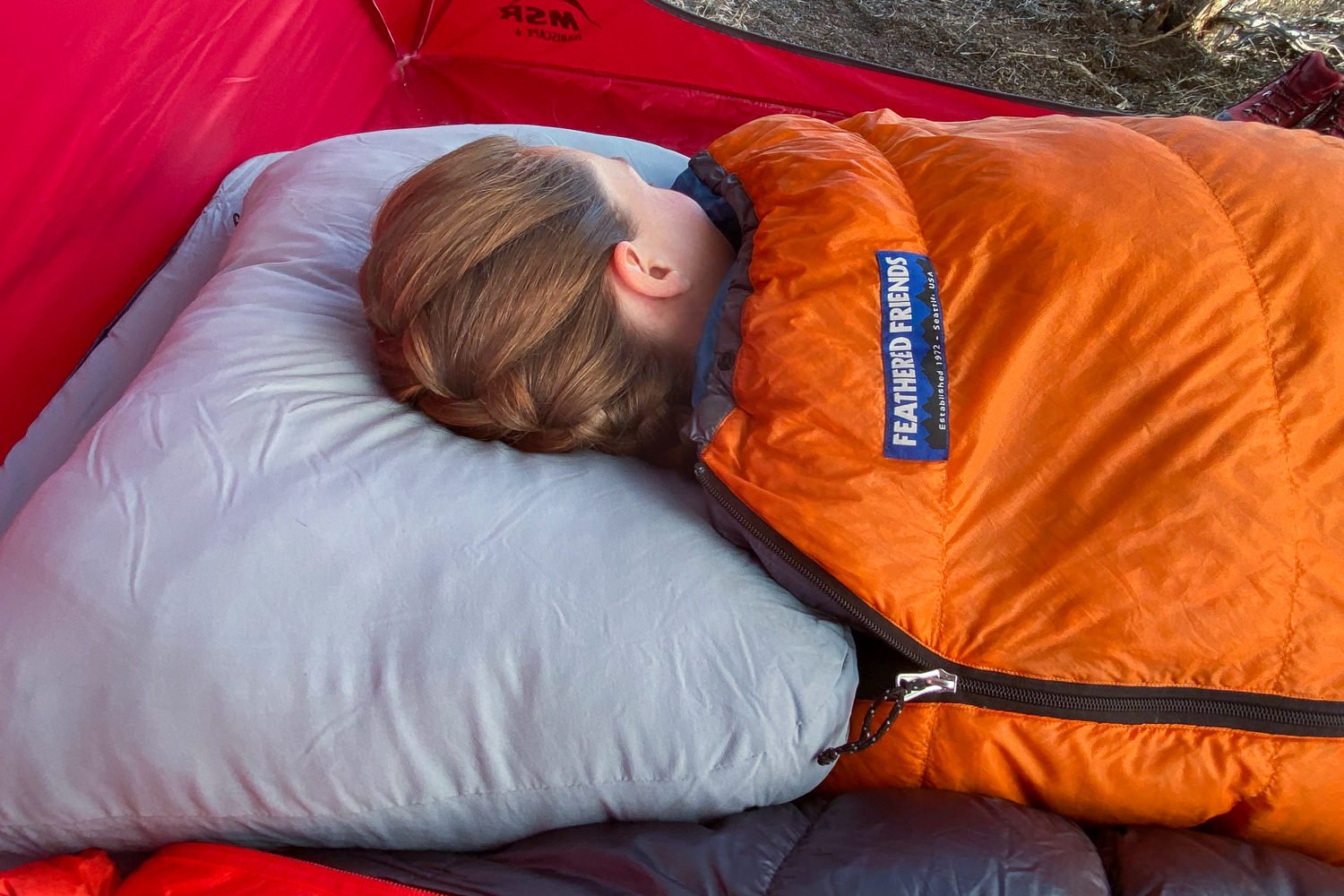
TEMPERATURE
Just like it’s important to have a sleeping pad that insulates you from the cold ground, it’s key to have a pillow that protects your head and face from the cold night air. Especially if you go for an inflatable, consider that the air temperature will penetrate through the baffles of the pillow and transfer to your body. Having a barrier of insulation (like fleece, down, or foam) between your head and the air chamber will keep you a lot warmer and more comfortable. Similarly, you’ll want to choose a pillow that has a comfortable fabric surface that will wick away sweat and keep you cool on warm summer nights.

A pillow that keeps sliding out from under your head can be really annoying and disturb your sleep, and that’s a common annoyance with backpacking/camping pillows. But there’s an easy fix!
Some pillows have tabs on the sides to attach an elastic cord that will secure around your pad, or you can use a few inches of adhesive velcro to create your own pillow-lock system. Simply adhere the soft side (loops) to your pad and the rough side (hooks) to the underside of your pillow – being careful to line them up right. And voilà, your pillow will stay put much better.

Unfortunately, some of the lightest pillows are also the noisiest due to the crinkly materials they’re made from. While Dyneema and plastics may be ultralight, it can be like trying to sleep with your ear pressed up against a potato chip bag.
Everyone shifts and moves some during the night and it’s likely you’ll hear some rustling no matter which pillow you choose. If you’re a particularly fidgety sleeper, you may want to choose accordingly or bring earplugs for your tentmate.
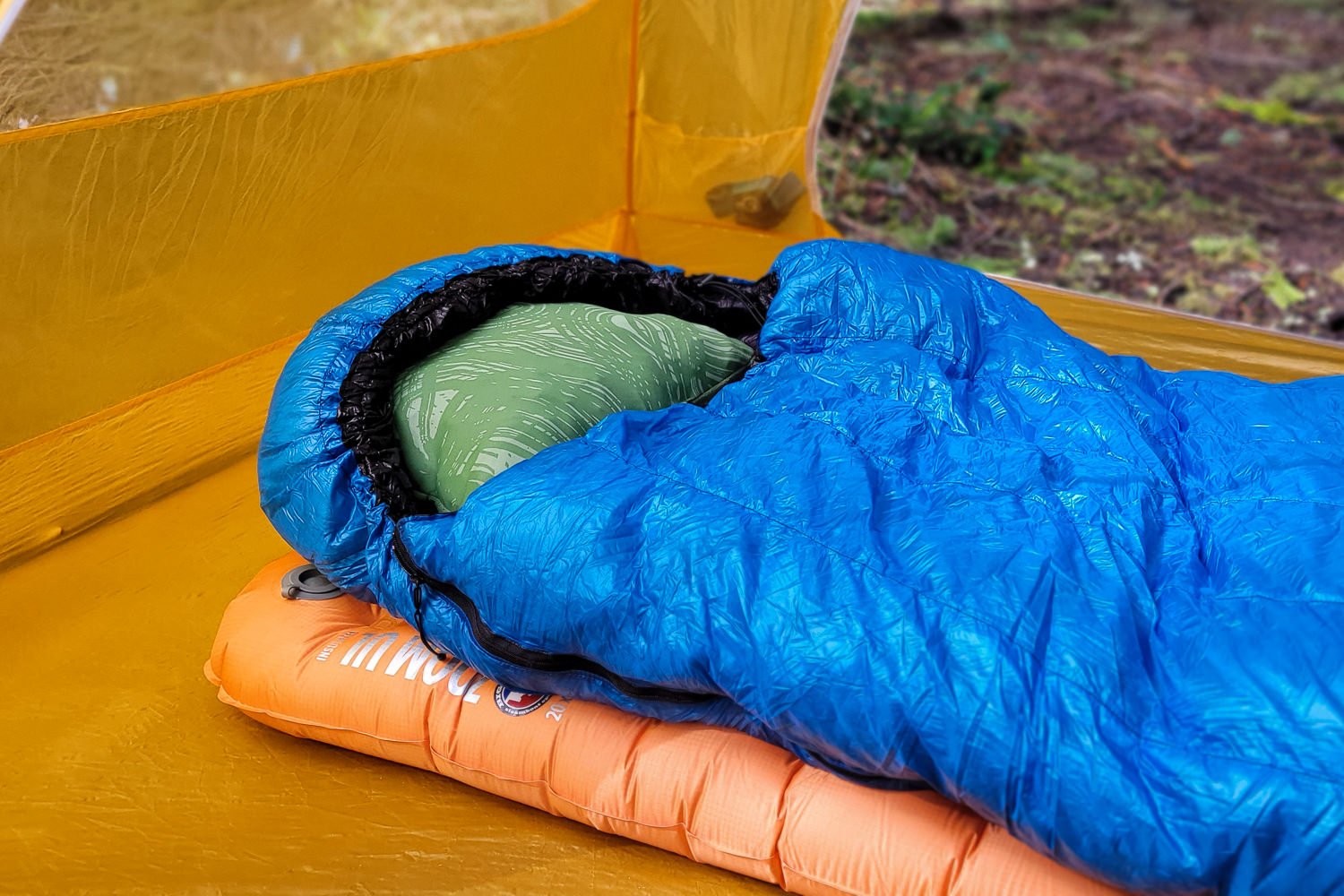
WASHABILITY
Dirt and grime are part of the backpacking/camping lifestyle and many just learn to live with it. But for more fastidious hikers, there are pillows with removable cases that can easily be machine-washed with your clothing after each trip. Down pillows require a bit more care as dirt, sweat, hair oils, and drool can eventually cause them to lose their loft, but it isn’t difficult to rejuvenate them with a little know-how. Check out our tutorial on How to Wash a Down Coat for some pro tips.
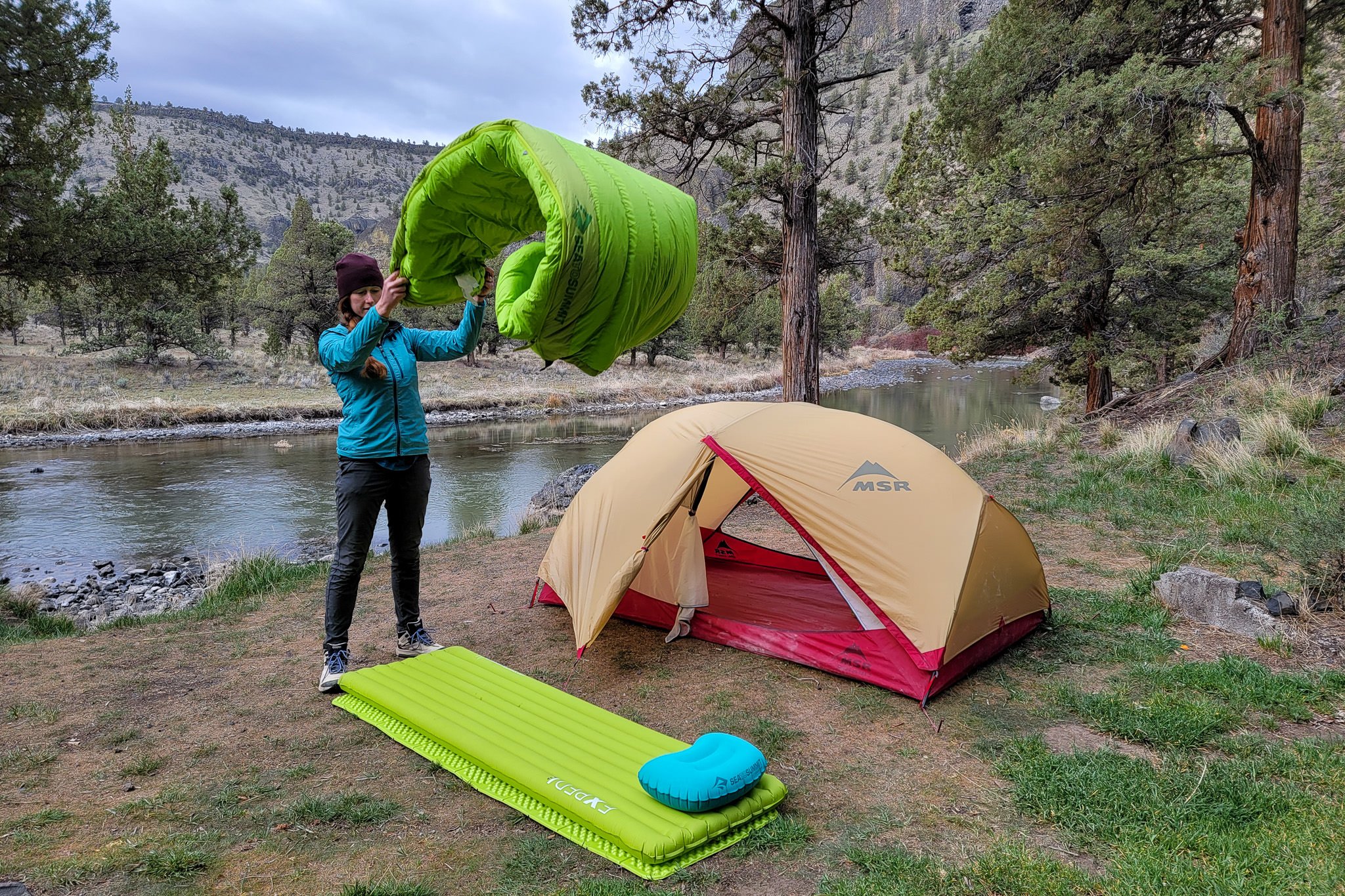
Why rough it when you can rest easy? A pillow that balances comfort, support, weight and packability in an easy-to-use package will help you wake up without giving you a crick in your neck or adding bulk to your setup. Whether you prefer an inflatable, compressible, or hybrid design, picking the right pillow for your next adventure will make every night’s rest as refreshing as the day’s adventure.

Why trust us?
We understand how tough it is to find trustworthy gear advice, and that’s one of the main reasons we built CleverHiker. We live for outdoor adventure, and we take these guides very seriously.
- Our recommendations are completely independent and based on hands-on experience.
- We test outdoor gear for a living – we’ve logged over 20,000 trail miles and 1,000 nights in the wilderness.
- Our team has thru-hiked some of the most iconic long trails, including the Continental Divide Trail, Pacific Crest Trail, Appalachian Trail, Colorado Trail, Long Trail, Oregon Coast Trail, Arizona Trail, Pinhoti Trail, Superior Hiking Trail, as well as extensive peak bagging, and international treks.
- We field test every product we recommend, which is sadly not the norm.
- We travel to industry trade shows to stay up-to-date on product innovations.
- We continuously update our guides throughout the year and when new products launch.
- We treat recommendations to our readers as if they were for our family and friends.
- We’re lifelong learners and we’re always open to feedback. If you think we’ve missed a worthy product or got something wrong, we’d love to know about it.
Need more Backpacking Equipment advice?
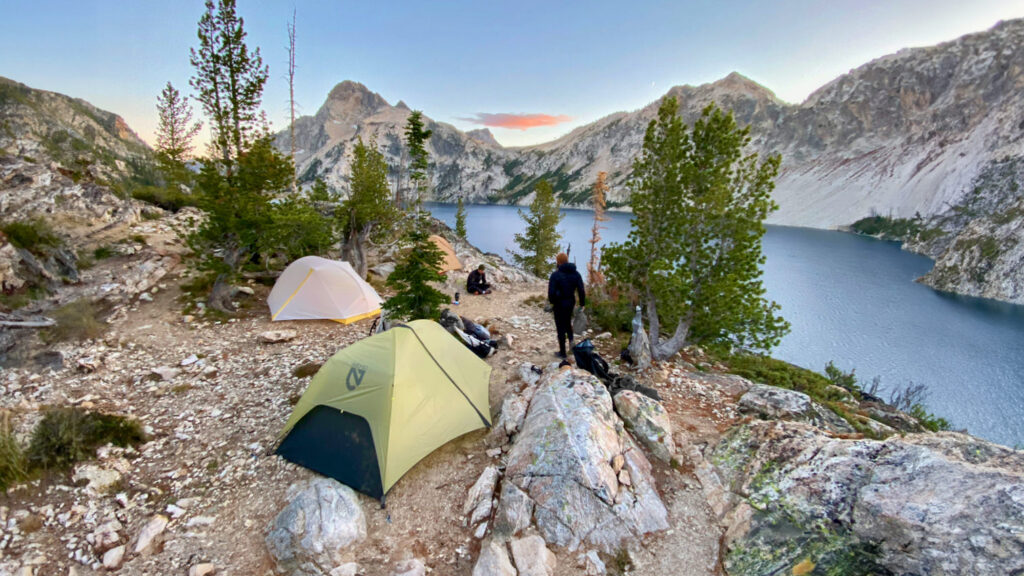
Best Backpacking Tents of 2024
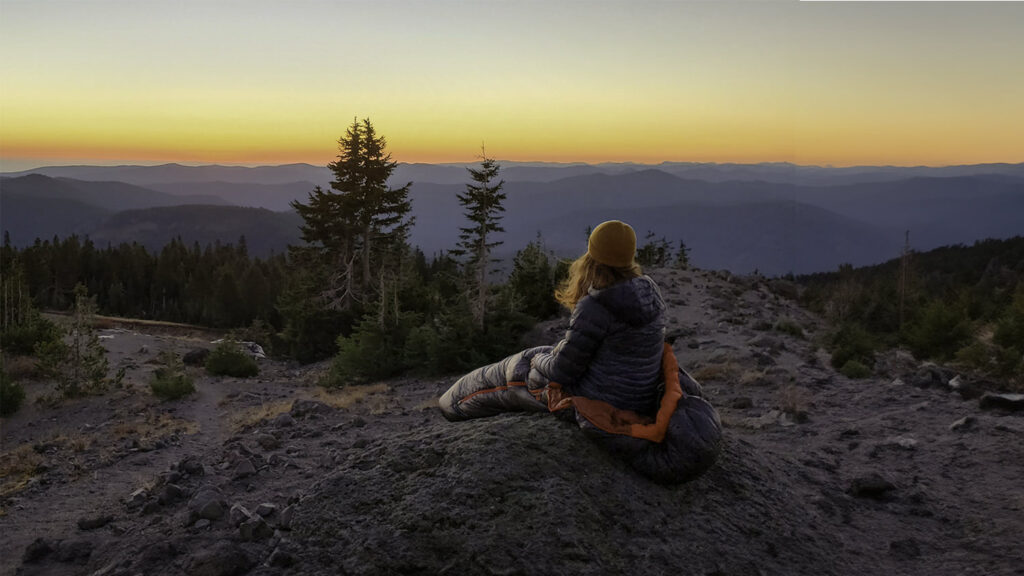
Best Backpacking Sleeping Bags of 2024
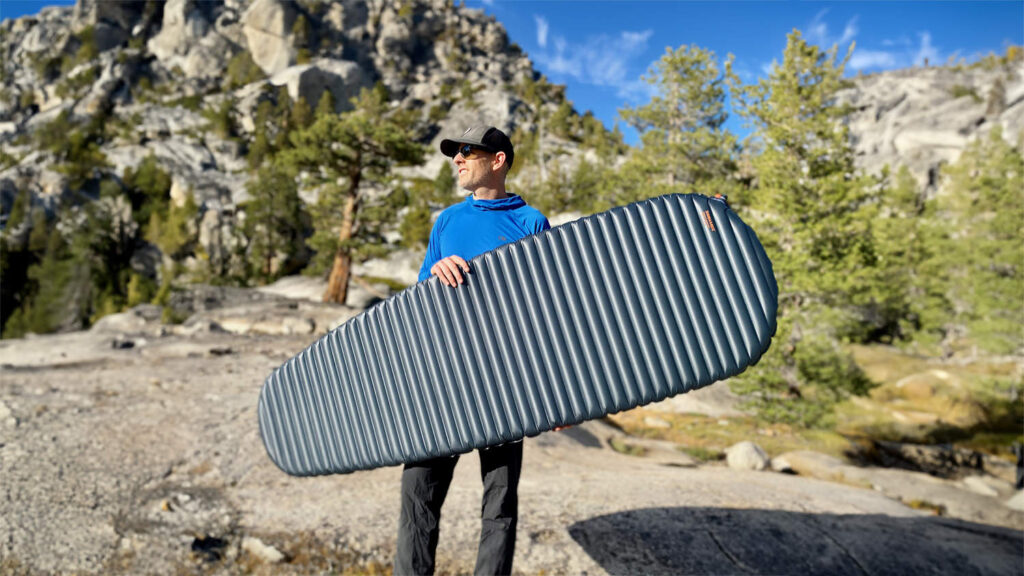
Best Backpacking Sleeping Pads of 2024
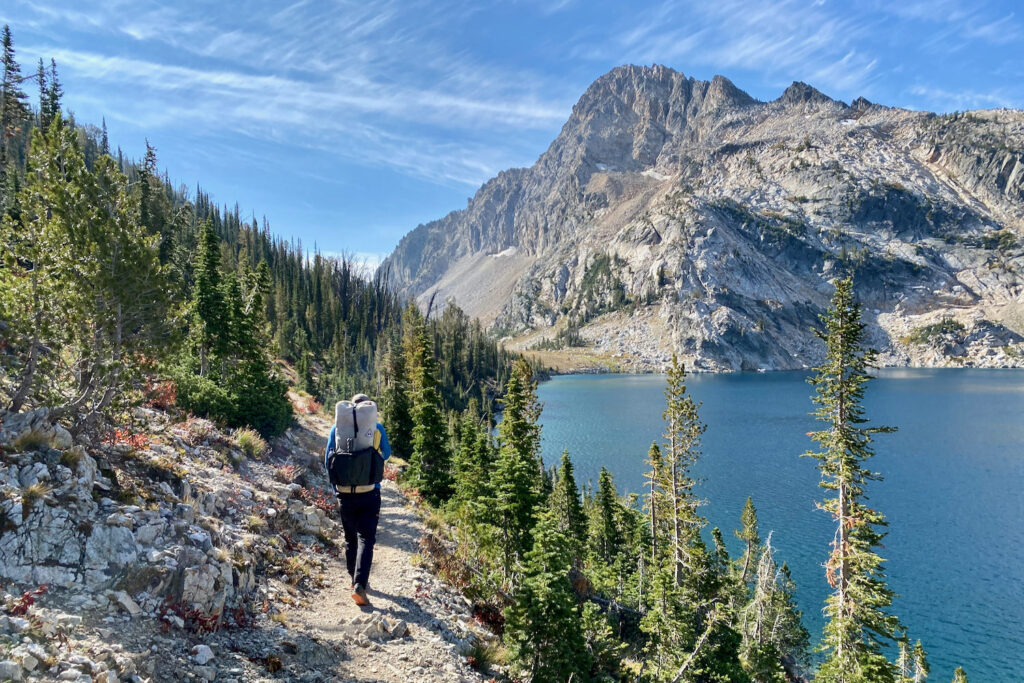
Best Backpacking Backpacks of 2024
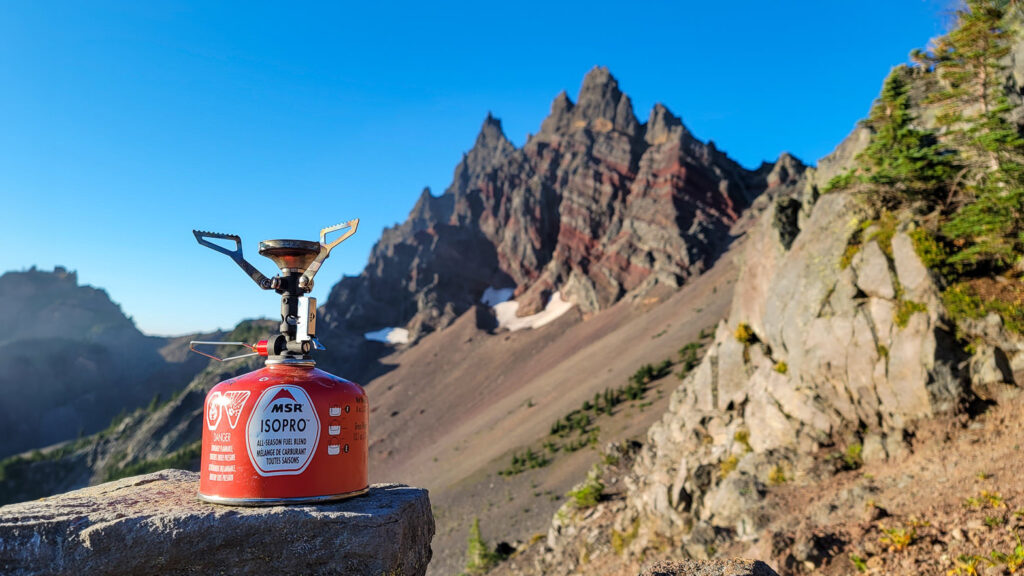
Best Backpacking Stoves of 2024
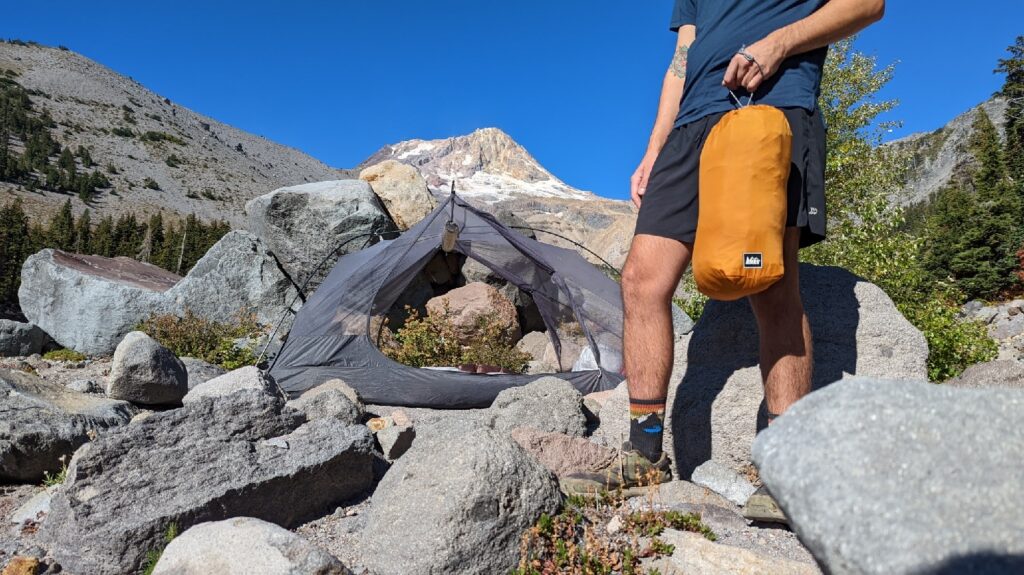
Best Stuff Sacks of 2024
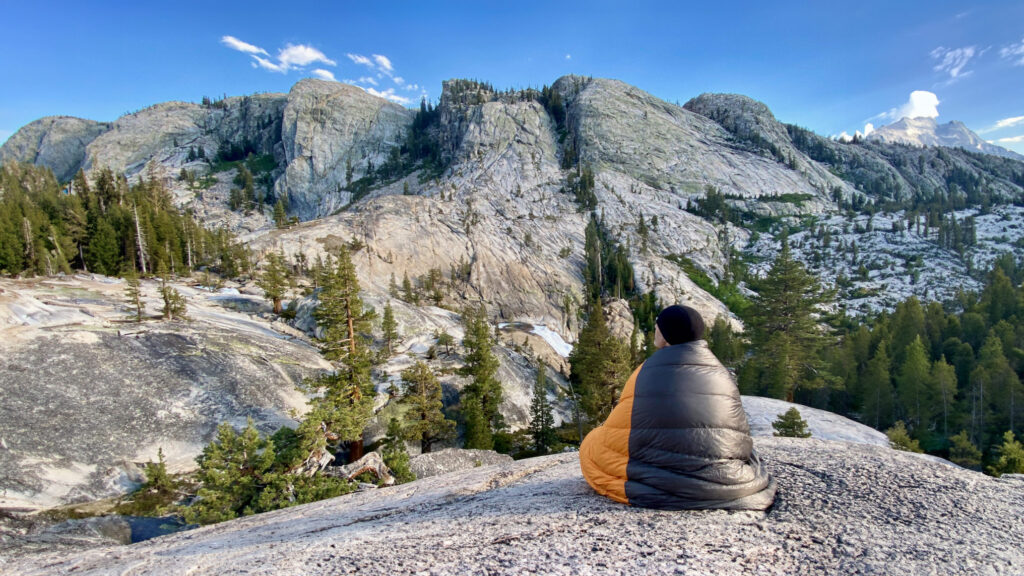
Best Backpacking Quilts of 2024
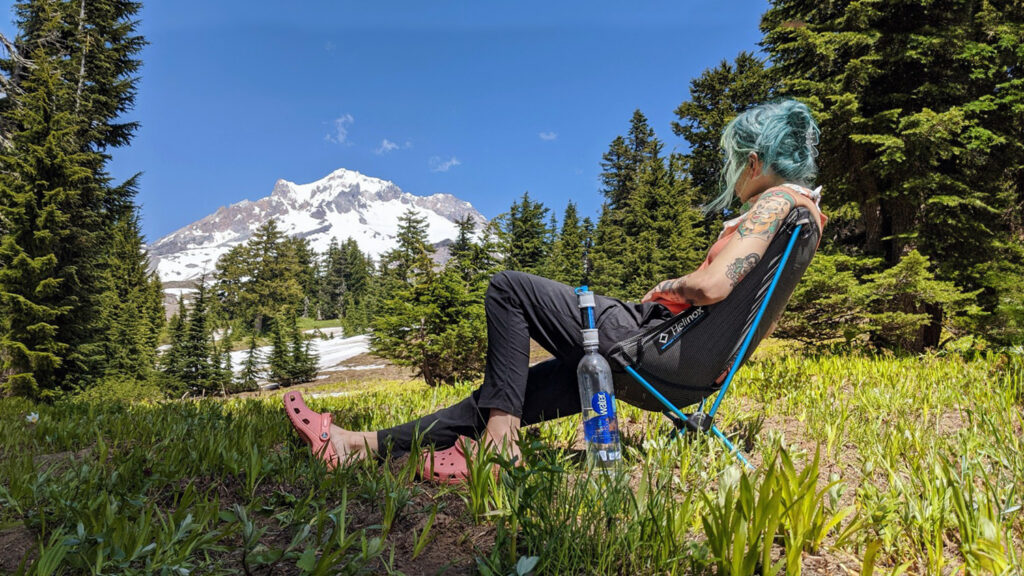
Best Backpacking Chairs of 2024
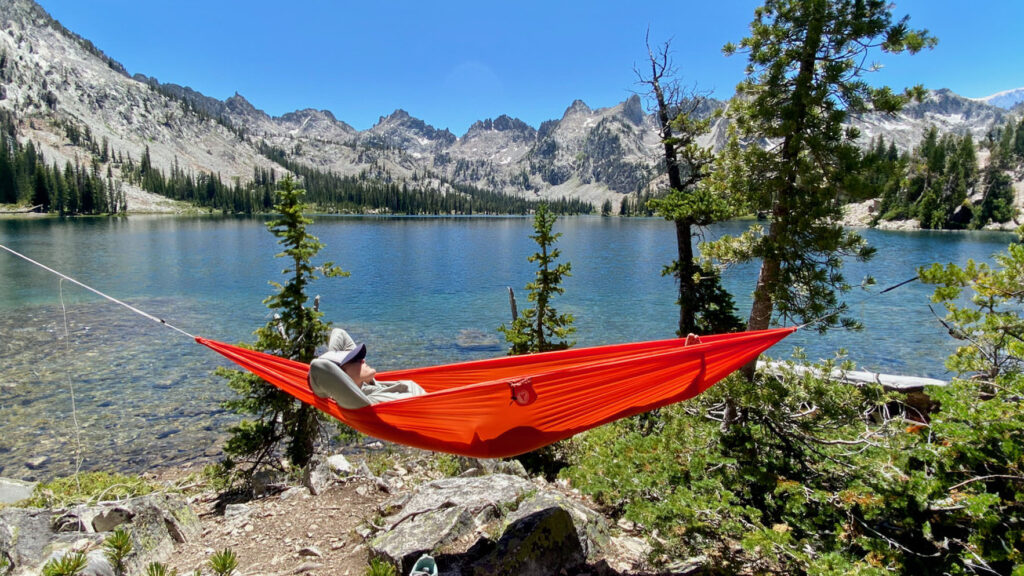
Best Camping Hammocks of 2024
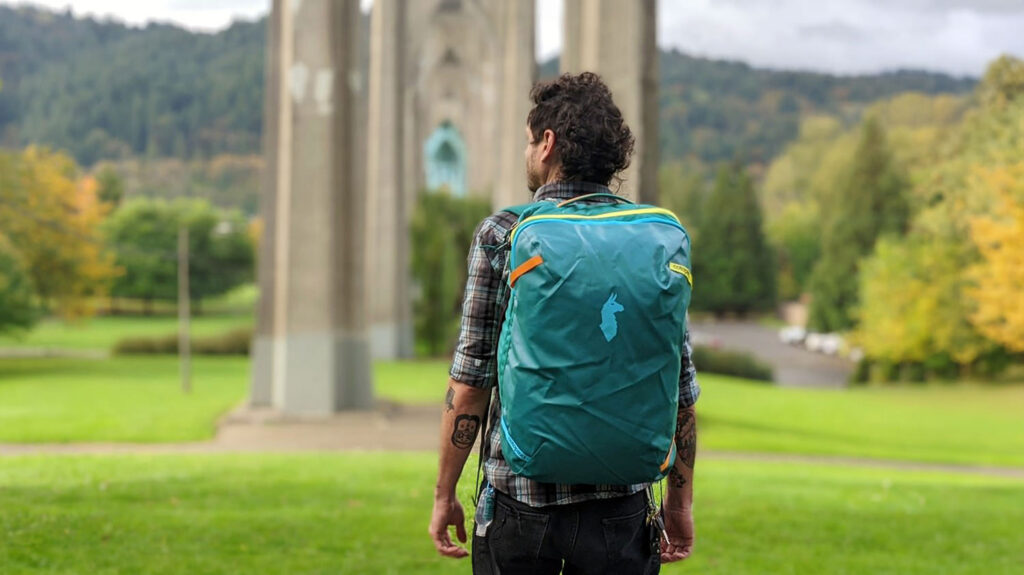
10 Best Travel Backpacks of 2024
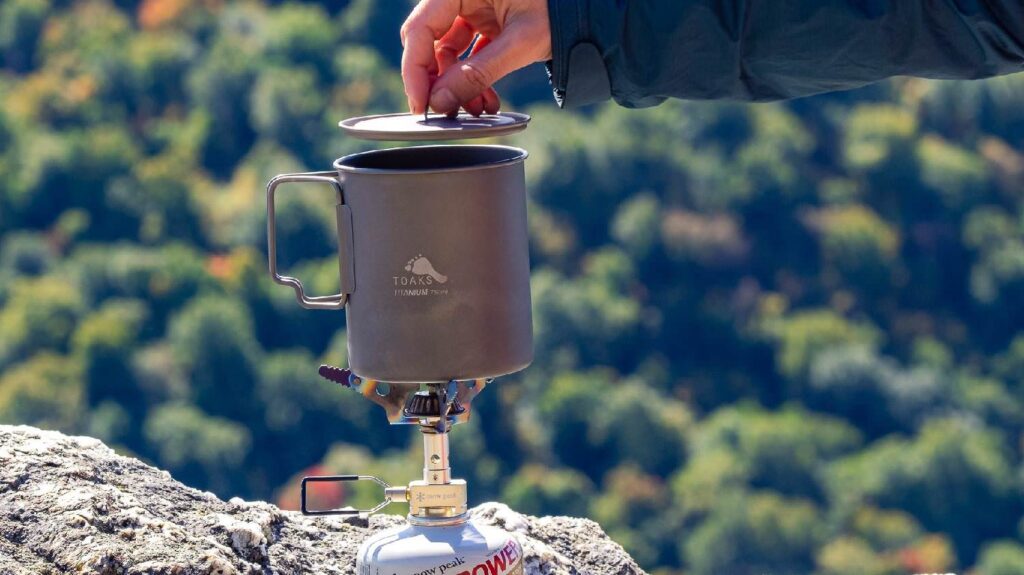
Best Backpacking Cookware of 2024
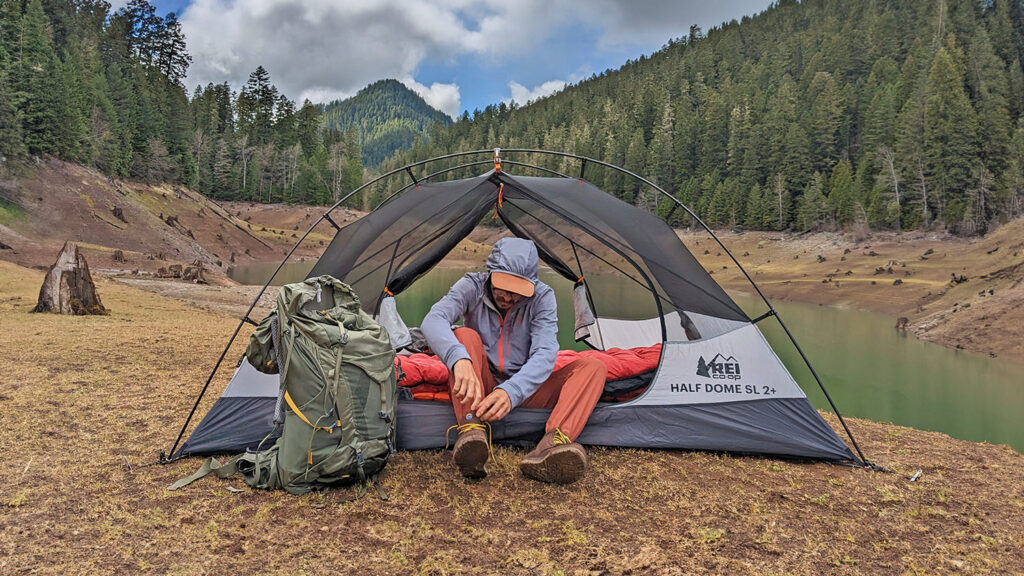
Best Budget Tents of 2024
Get the best content from cleverhiker & around the backpacking world.
Social media is great, but our bi-weekly newsletter is a much better way to stay in the know.
Sign up to get our curated emails with the best content from CleverHiker and around the backpacking world. You’ll be turned on to new videos, trip reports, gear reviews, inspiring outdoor stories and much more. So get in the mix!

Best Camping and Backpacking Pillows of 2024
From ultralight inflatables for backpacking to plush memory foam designs for ultimate car camping luxury, we break down the year’s top outdoor pillows.
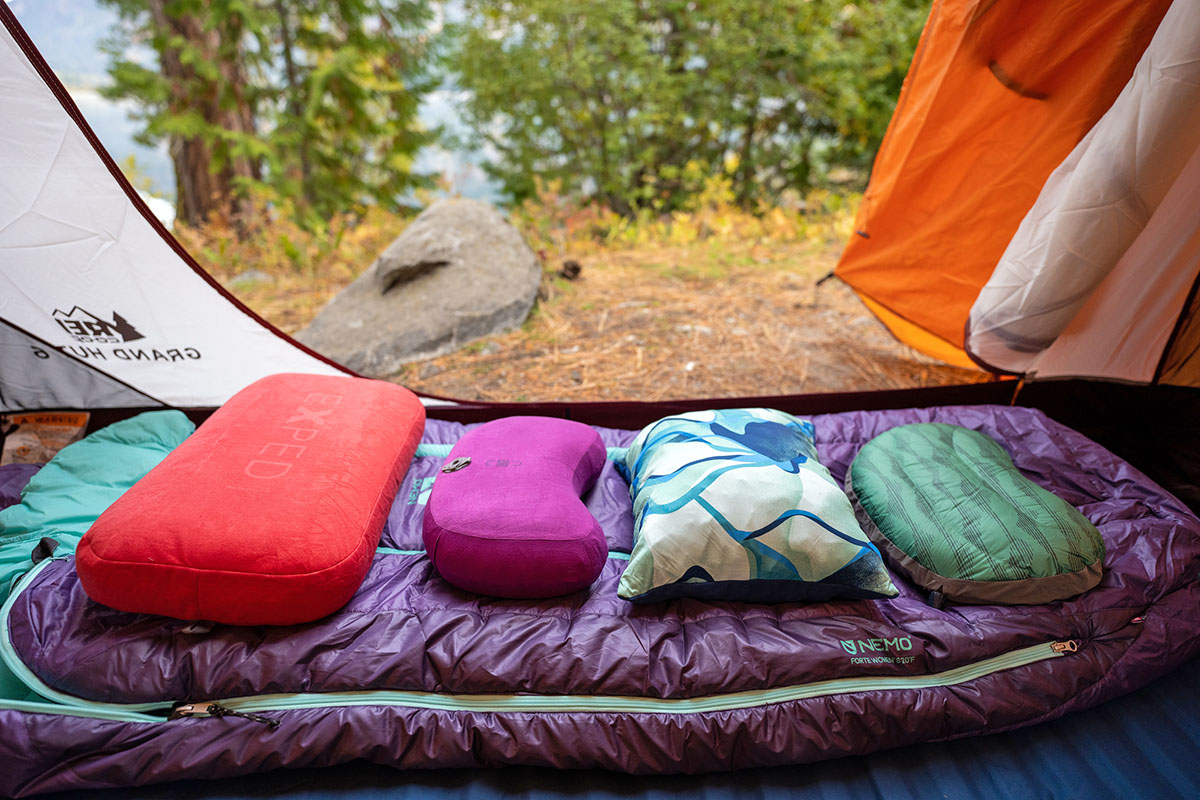
Jason Hummel Photography
We use affiliate links and may receive a small commission on purchases. Read more about us .
While small and relatively unassuming, a quality outdoor pillow can go a long way toward improving your sleep, whether you’re spending the night at your local state park or trekking miles into the backcountry. Designs range from ultralight and compressible inflatable models for multi-day backpacking missions to plush memory foam designs for ultimate car camping luxury, with many of our picks offering a good balance of comfort and weight to pull double duty. We’ve been testing the full gamut since 2022, and below we break down our favorite 16 camping and backpacking pillows of 2024. For more background information, check out our detailed comparison table and buying advice below the picks.
Editor’s note: We updated this guide on June 12, 2024, for refine our list of camping and backpacking pillows. We also included information about our testing practices and added a section on sustainability in the buying advice.
Our Team's Camping and Backpacking Pillow Picks
- Best Overall Camping Pillow: Therm-a-Rest Compressible Pillow
- A Close Second (That's More Packable): Nemo Fillo Pillow
- Best Budget Camping Pillow: Teton Sports Camping Pillow
- Best Lightweight Pillow for Backpacking: Sea to Summit Aeros Ultralight
- Best Premium Camping Pillow for Comfort Seekers: Hest Camp Pillow
- Best Stuff Sack Pillow for Ultralight Adventures: Zpacks Medium-Plus Pillow
Best Overall Camping Pillow
1. therm-a-rest compressible pillow ($37).
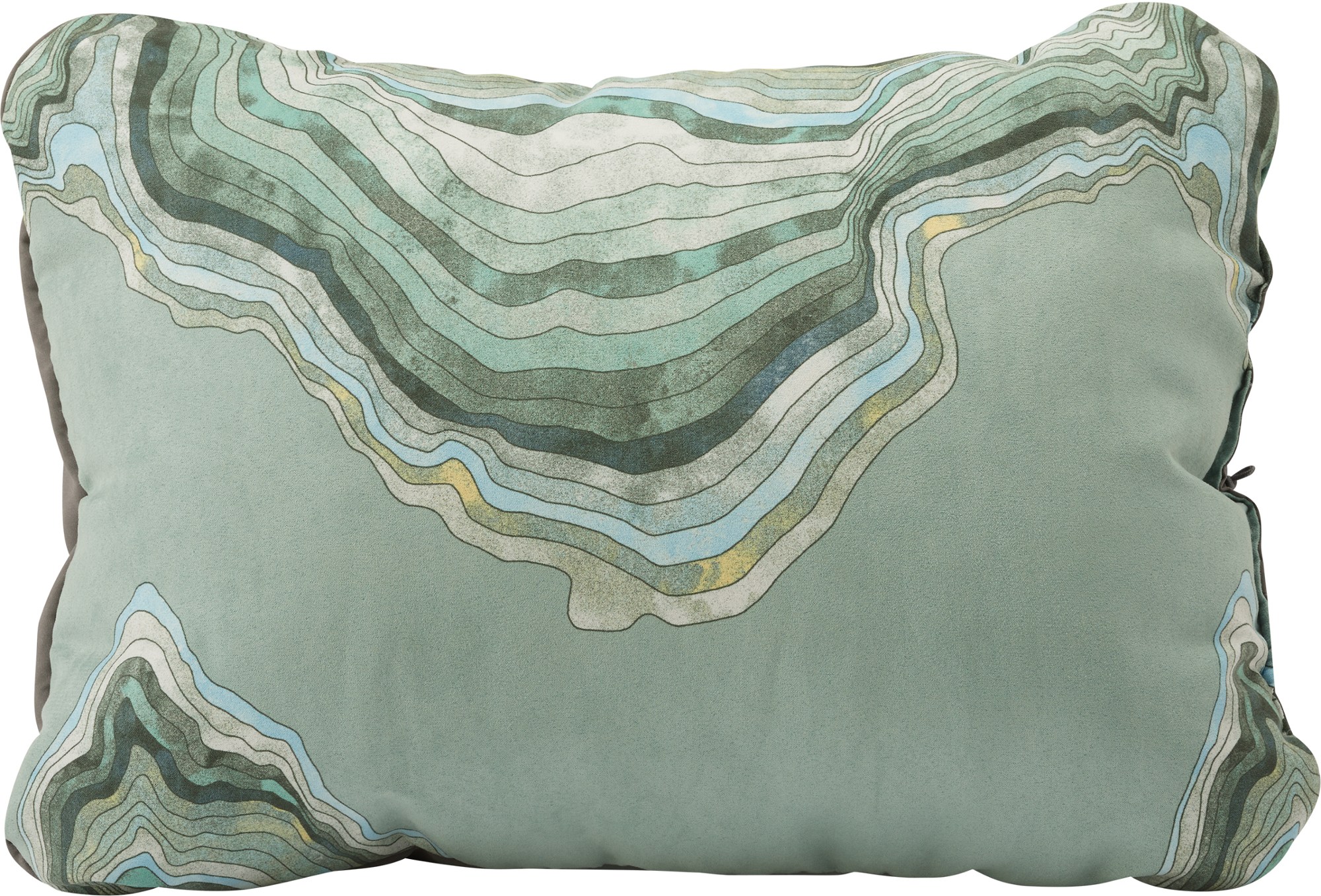
Therm-a-Rest makes some of our favorite sleeping pads on the market, and that expertise transfers over nicely to their pillow collection. During testing, their Compressible Pillow was quick to win us over: The exterior uses a soft and supple polyester cover, while the inside is filled with compressible but supportive foam that’s been upcycled using excess material from their sleeping pads. We’re also big fans of the cinch cord at the side, which allows you to tailor firmness depending on your sleeping preferences. Therm-a-Rest also added an additional layer of light insulation at the top, which is intended to minimize lumps. And a final bonus: The pillow is machine-washable—simply throw it in with your other clothing when it needs a cleaning.
What’s not to like with the Therm-a-Rest Compressible Pillow? First is the lack of backcountry appeal: Despite its “compressible” designation, the pillow’s foam insulation adds weight and bulk and doesn’t allow it to stuff down small for backpacking missions. For comparison, inflatable designs like Sea to Summit’s Aeros Ultralight below are far lighter (by nearly 8 oz.) and more compressible, although they come with drawbacks in terms of comfort and durability. The Therm-a-Rest’s foam also takes some time to expand—we recommend undoing the cinch cord as soon as you get to camp and fluffing it up to speed up the process. Compression requires similar planning, including rolling it twice to smooth things out before packing away. Despite these drawbacks, the Compressible Pillow offers great comfort and support for the weight, earning it our endorsement as the best overall camping pillow this season (it makes a decent travel companion, too). See the Therm-a-Rest Compressible Pillow
A Close Second (That's More Packable)
2. nemo fillo pillow ($45).
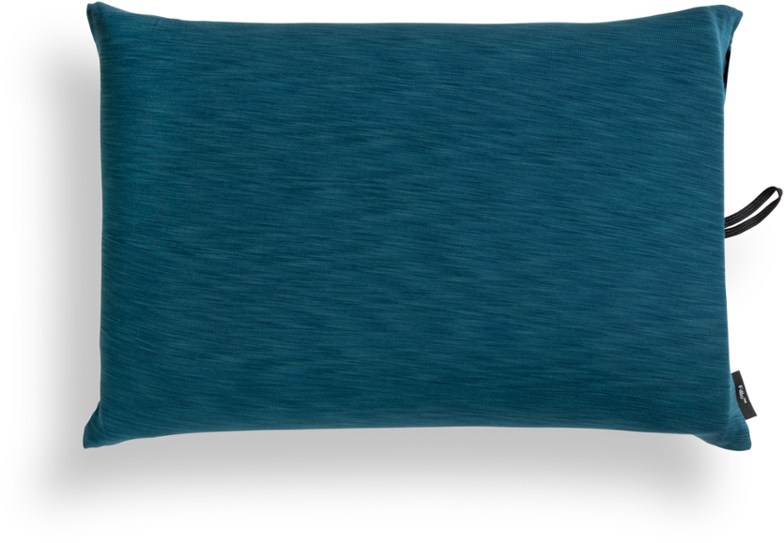
The Therm-a-Rest Compressible Pillow above is filled exclusively with foam, which offers great cushioning and support but adds some weight and bulk. Enter Nemo's Fillo Pillow, which has a hybrid foam/air construction that allows it to be a bit lighter and far more compressible without a major impact on all-night comfort. All in all, it’s a simple but well-executed design: Once removed from its attached stuff sack, the foam inside will begin to inflate, and you can top it off by blowing into the air valve at the side, which is easy to open and close with a quick twist. This gives the Fillo a super plush and premium feel without the balloon-like shape of standard inflatable designs like Sea to Summit’s Aeros offerings below. And at a manageable 6 x 4 inches when compressed, the Fillo is noticeably smaller than Therm-a-Rest’s Compressible Pillow above (12 x 7 x 4 in.), making it the better pick for bringing along on the occasional backpacking trip.
No pillow is perfect, however, and the Nemo Fillo does come with a few downsides. First, at 17 inches long and 11 inches wide, it’s noticeably smaller than Therm-a-Rest’s Compressible Pillow above, which measures 18 x 13 inches for the “regular” size. It’s also thinner at 4 inches compared to the Therm-a-Rest’s 6-inch-thick build, which is a downside for side sleepers and those prone to tossing and turning throughout the night. It’s worth noting that Nemo does make the Fillo in a larger “King” version , which is 17 inches long, 14 inches wide, and 6 inches thick but costs $30 more than the standard version here (and double the price of the Therm-a-Rest). Finally, the Fillo takes some patience and finesse to get back into its stuff sack—we’ve found it works best to fold it in half lengthwise before rolling it up. But there’s a reason this pillow is so popular: If the dimensions work for you, the Fillo packs in excellent comfort and support for its weight and size. See the Nemo Fillo Pillow
Best Budget Camping Pillow
3. teton sports camping pillow ($20).
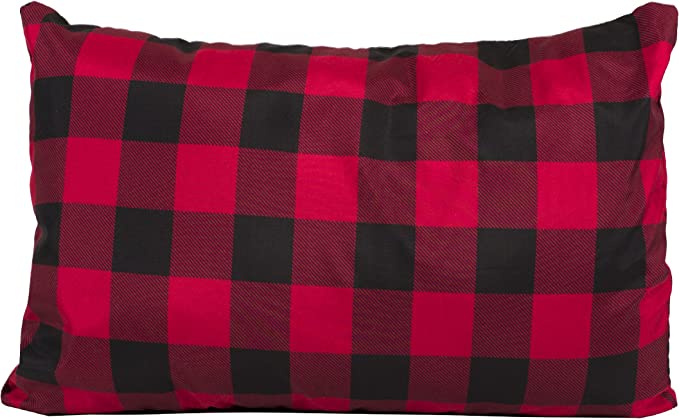
Camp pillows are inherently a pretty affordable bunch, but that doesn’t mean there aren’t great deals to be found. Teton Sports’ Camping Pillow is a shining example: For just $20 full price and often available for less on Amazon, this pillow boasts a brushed flannel exterior that’s reminiscent of the brand’s plush sleeping bags. This is entirely subjective, but we also love the checkerboard-like patterning that gives off cozy cabin and outdoorsy vibes. Teton also included a handy drawstring-equipped storage bag for travel, and the pillow can be thrown directly in the wash with other clothing at the end of your trip. All told, it’s a no-frills but entirely practical option for most campers.
What do you sacrifice by saving with the Teton Sports Camping Pillow? As with most budget designs, the materials are on the cheaper end, which translates to added heft and bulk compared to more premium competitors like the Therm-a-Rest Compressible and Nemo Fillo above. Further, the synthetic fill doesn’t loft evenly when uncompressed, which can lead to air pockets and lumpiness. It also has a softer feel in general and lacks the firmness and support of many other picks here, plus there’s no cinch cord or valve to add air for additional structure. But if you prefer a soft pillow and want to keep costs low, the Teton Sports Camping Pillow is a solid value for what you get and comes in far more colorway options than the similarly priced REI Trailmade Mummy Bag Pillow below. See the Teton Sports Camping Pillow
Best Lightweight Pillow for Backpacking
4. sea to summit aeros ultralight ($45).
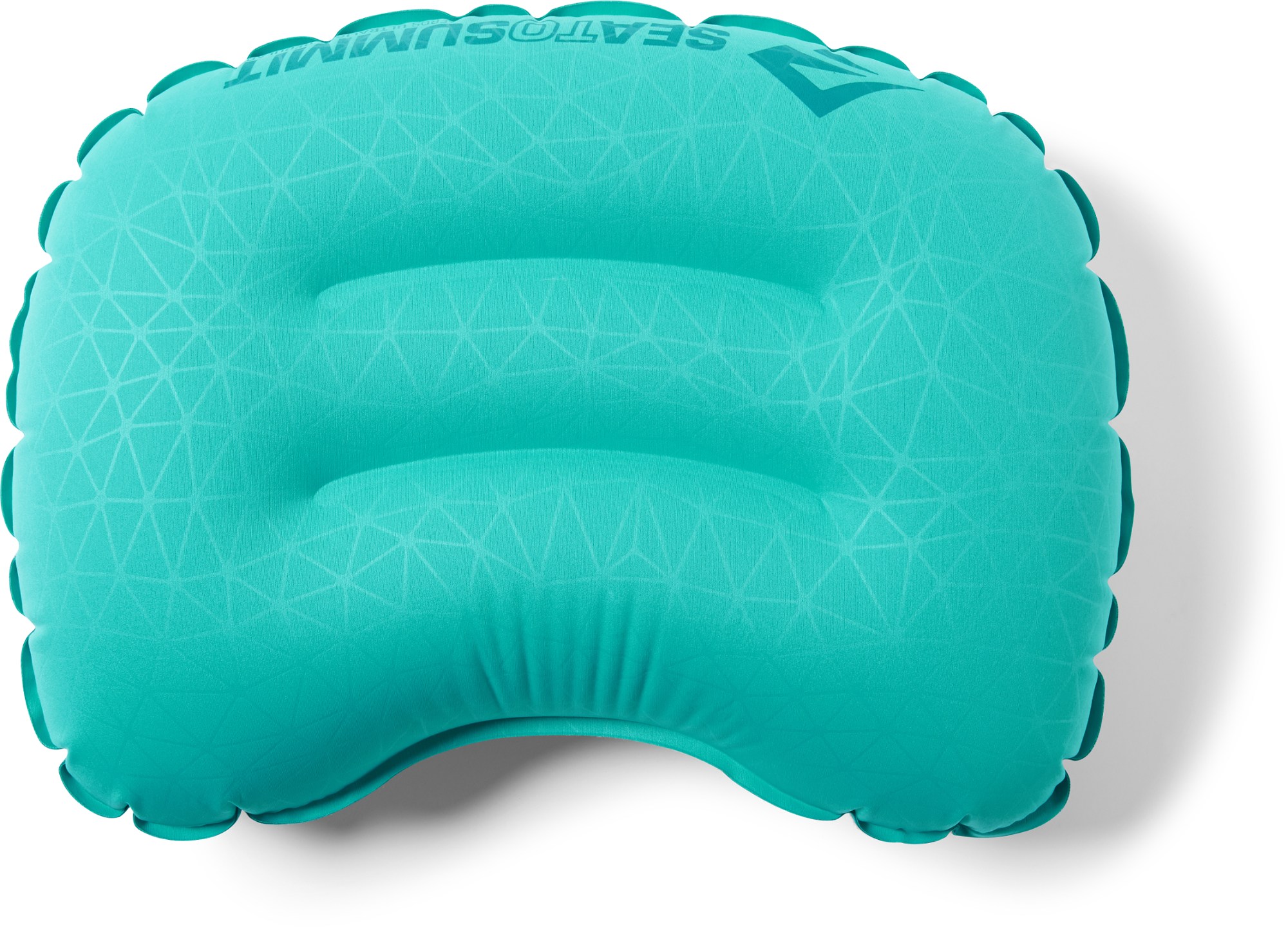
The pillows above offer great comfort and support for car camping, but for minimalist backpacking adventures that take us deep into the backcountry, we turn to ultralight inflatable designs like Sea to Summit’s Aeros collection. Clocking in at a scant 2.1 ounces, the Aeros Ultralight Pillow here is the lightest model in the lineup and well suited for multi-day trips when you’ll want to keep weight to a minimum. Packed size is equally impressive: The pillow compresses down to about the size of a baseball, making it a no-brainer to bring along even on gear-intensive missions when space is at a premium. Finally, despite its ultralight build, the Aeros includes thoughtful touches like quick and easy inflation via the low-profile valve (it just takes a couple breaths), a soft stretch-knit fabric that’s comfortable against the skin, and curved internal baffles to keep your head centered on the pillow.
We’ve been using Sea to Summit’s Aeros Ultralight for multiple seasons, and it quickly became a must-have item in our pack. That said, on car camping adventures, we typically leave the Aeros behind and instead opt for a plusher foam option like the Compressible Pillow or Nemo Fillo above. While heavier, these pillows offer a sizable boost in all-night comfort with softer materials and larger dimensions. We’ve also found the Aeros prone to sliding around when fully inflated unless secured inside the hood of a mummy bag (many campers opt for roomier rectangular bags that typically forgo hoods). Alternatively, all of Sea to Summit’s sleeping pads come with adhesive hook-and-loop patches to secure their pillows in place. A final gripe is the Aeros’ thin 20-denier shell, which has a delicate feel and gives us pause around sharp gear (although we haven’t had any issues to date). But for backpackers who want to keep things light without forgoing some creature comforts, the Aeros Ultralight has its place. See the Sea to Summit Aeros Ultralight
Best Premium Camping Pillow for Comfort Seekers
5. hest camp pillow ($89).
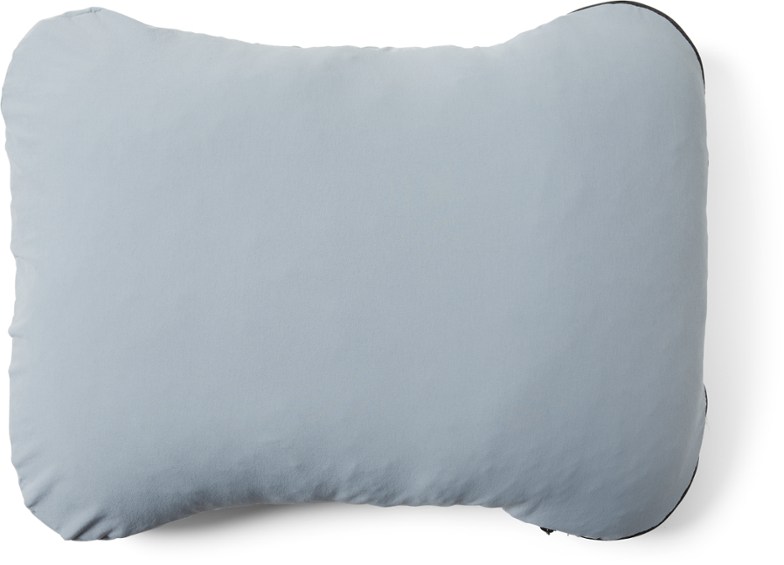
Hest has broken into the car camping scene with a Yeti cooler-like focus on quality. The brand’s Camp Pillow is a case in point, utilizing a premium blend of memory foam and polyester in a generous, 8-inch-thick design for excellent support and structure, especially for side sleepers. The stretch-woven nylon exterior is also very soft against the skin, while the curved shape helps cradle your head and neck. All of the smaller details are equally well sorted, including zippered access to fine-tune height and firmness, a PU coating along the shell for added assurance against moisture and stains, and a removable and washable cover for easy cleaning. And when it's time to pack up camp, simply turn the pillow inside out and zip the cover shut—there’s also a built-in carry loop for clipping to a duffel or pack. All told, it’s a luxurious-feeling pillow that will likely make you forget you’re sleeping in the woods and can easily pull double duty at home for guests.
All that said, there are some major downsides to the Hest Camp Pillow’s decidedly luxe design. First is weight: At 2 pounds 3.2 ounces, the Hest is the heaviest option here by a wide margin. It’s also the bulkiest, which means it’s best suited for car campers who aren’t limited on space. Finally, at $89, you’re paying a pretty steep premium for the high-end materials and construction. You can certainly bring along your pillow from home as a substitute, but the Hest's dirt- and water-resistant cover and integrated stuff sack add sizable benefits for long-term outdoor use. In the end, the Hest will be overkill for some, but it leaves little to be desired for serious comfort seekers. Hest also offers a larger version called the Standard Pillow , which measures 26 inches long by 20 inches wide, weighs a pound more, and costs $119. See the Hest Camp Pillow
Best Stuff Sack Pillow for Ultralight Adventures
6. zpacks medium-plus pillow ($60).
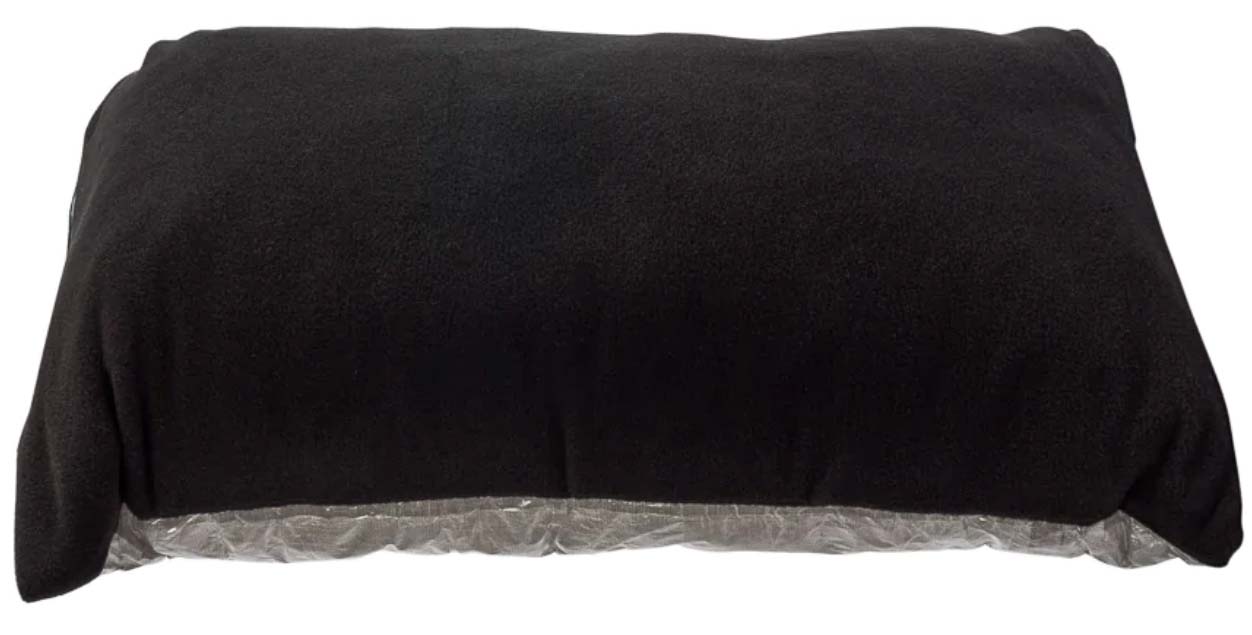
For minimalists and ultralight adventurers who scoff at adding unnecessary ounces to their base weight, a stuff sack pillow could be a good compromise. Essentially specialized pillowcases, these designs are uninsulated and provide a space to stuff extra clothing (which you’re already carrying) to create a makeshift pillow at night. Zpacks’ Medium-Plus Pillow is our favorite option in this category and stands out for its versatility: Made with highly water-resistant Dyneema fabrics and protective details like fully taped seams and a waterproof main zipper, the pillow can function as a dry bag to protect your gear on the trail. At night, simply turn the Medium-Plus inside out to reveal the soft microfleece surface and stuff any spare clothes inside for use as a pillow. At just 1.6 ounces, the Medium-Plus adds a negligible amount of weight to your pack, and the dual-purpose build makes it even easier to justify.
In terms of downsides, stuff sack pillows like the Zpacks Medium-Plus aren’t as intuitive or user-friendly as traditional designs. In short, it can be difficult and time-consuming to achieve an even and consistent packing job—rather than just inflating the pillow, you’ll need to take some time to intentionally stuff clothing inside until you reach your desired firmness. The bottom of the pillow (without the microfleece) also tends to slide around throughout the night, and we recommend purchasing Zpacks’ Pillow Attachment Cord (a $6 add-on) to keep it in place. Finally, at $60, the Medium-Plus is pricey for what you get, and most recreational backpackers will be better off saving with an option like the Sea to Summit Aeros Ultralight above (which is just 0.5 oz. heavier). But for weight- and space-conscious missions, the Zpacks’ two-in-one design certainly has its appeal. For a similarly built option from another leading UL brand, check out Hyperlite Mountain Gear’s Stuff Sack Pillow ($59 and 1.7 oz.). See the Zpacks Medium-Plus Pillow
Best of the Rest
7. sea to summit aeros premium ($55).
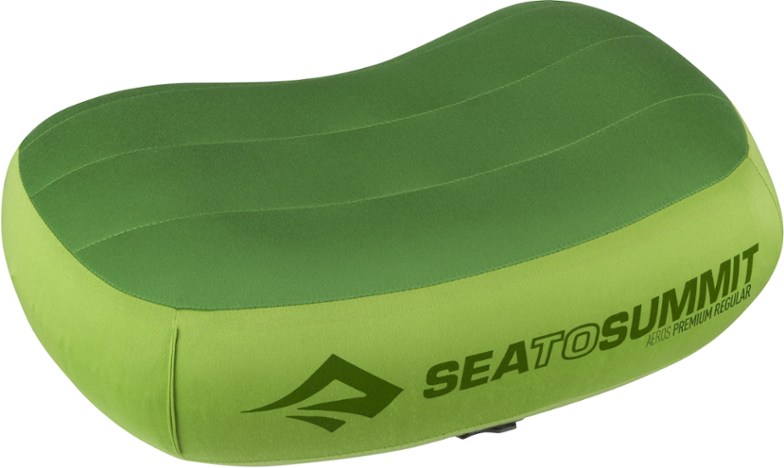
The second Sea to Summit model to make our list this season is their Aeros Premium Pillow, which offers a step up in comfort and durability compared to the Aeros Ultralight above. For just 0.7 ounces more, the Aeros Premium adds a light layer of synthetic insulation between the top surface and TPU air bladder, which gives the pillow a slightly plusher and cozier feel. The Aeros Premium also has a noticeably thicker 50-denier shell, which feels much more confidence-inspiring around sharp gear than the 20-denier Aeros Ultralight. The rest of the design is largely similar to the UL model, including an intuitive multi-function valve for easy inflation and deflation, curved internal baffles to keep your head in place, and a scalloped bottom edge to help the pillow stay centered around your shoulders when you’re sleeping or relaxing in your camp chair before bed.
Why do we have the Sea to Summit Aeros Premium ranked below the Aeros Ultralight? Despite the clear advantages in all-around comfort and durability, the Premium is a little smaller at 13.4 inches wide and 9.4 inches long (versus 14.2 x 10.2 in. for the Ultralight). It’s also a little thinner at 4.3 inches compared to the Ultralight’s 4.7-inch-thick build, which is a potential downside for side sleepers and those prone to tossing and turning. Finally, like the Ultralight, the Aeros Premium tends to slide around when fully inflated—it works best in a mummy bag when you can stuff it inside the hood to secure it in place (alternatively, it will also work with one of Sea to Summit’s PillowLock-equipped sleeping mats). That said, you’d be hard-pressed to find better comfort and durability for the weight, making the Aeros Premium a nice alternative to the Ultralight above for backpackers who are hard on their gear. See the Sea to Summit Aeros Premium
8. Exped MegaPillow ($60)
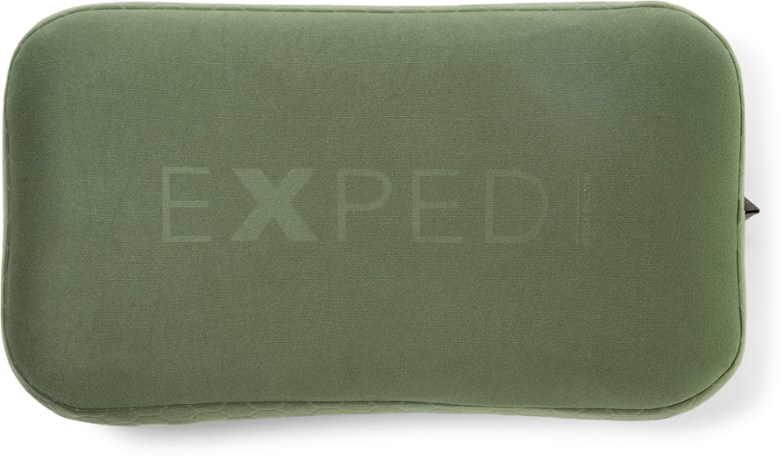
Exped’s MegaMat is legendary in the camping world, offering excellent cushioning and support that rival the comfort of your at-home mattress. Their MegaPillow sticks to a similar formula, combining high-end materials and Exped’s proven tech in a premium-feeling package. Like the MegaMat, the MegaPillow boasts near-vertical sidewalls designed to maximize the amount of surface area for your head. The tricot nylon exterior also has a velvety feel that’s noticeably soft against the skin and is backed with a layer of synthetic insulation for added coziness and comfort. Exped didn’t skimp on the smaller details, either, including fabric eyelets at the sides for attaching to a sleeping mat, a removable air cushion for easy cleaning, and a low-profile valve that doesn’t protrude and makes fine-tuning firmness quick and easy. Finally, at 20.9 inches wide and 12.6 inches long, the aptly named MegaPillow is one of the largest options here while checking in at a very manageable 6 ounces.
What pushed the Exped MegaPillow to a mid-pack finish? While comfort seekers will love the generous dimension, the rectangular shape doesn’t nestle easily into the hood of a mummy bag, which most backpackers (and some campers) prefer. If you anticipate using your pillow for both camping and backpacking adventures, Exped’s DeepSleep Pillow (6.3 oz.) and Down Pillow (5.3 oz. for the medium, 6.7 oz. for the large) are slightly smaller but have curved shapes that are more sleeping bag-friendly. But there’s little to be desired from a comfort perspective, which lands the MegaPillow midway up our list. See the Exped MegaPillow
9. Cocoon Air-Core Hood/Camp Pillow ($30)
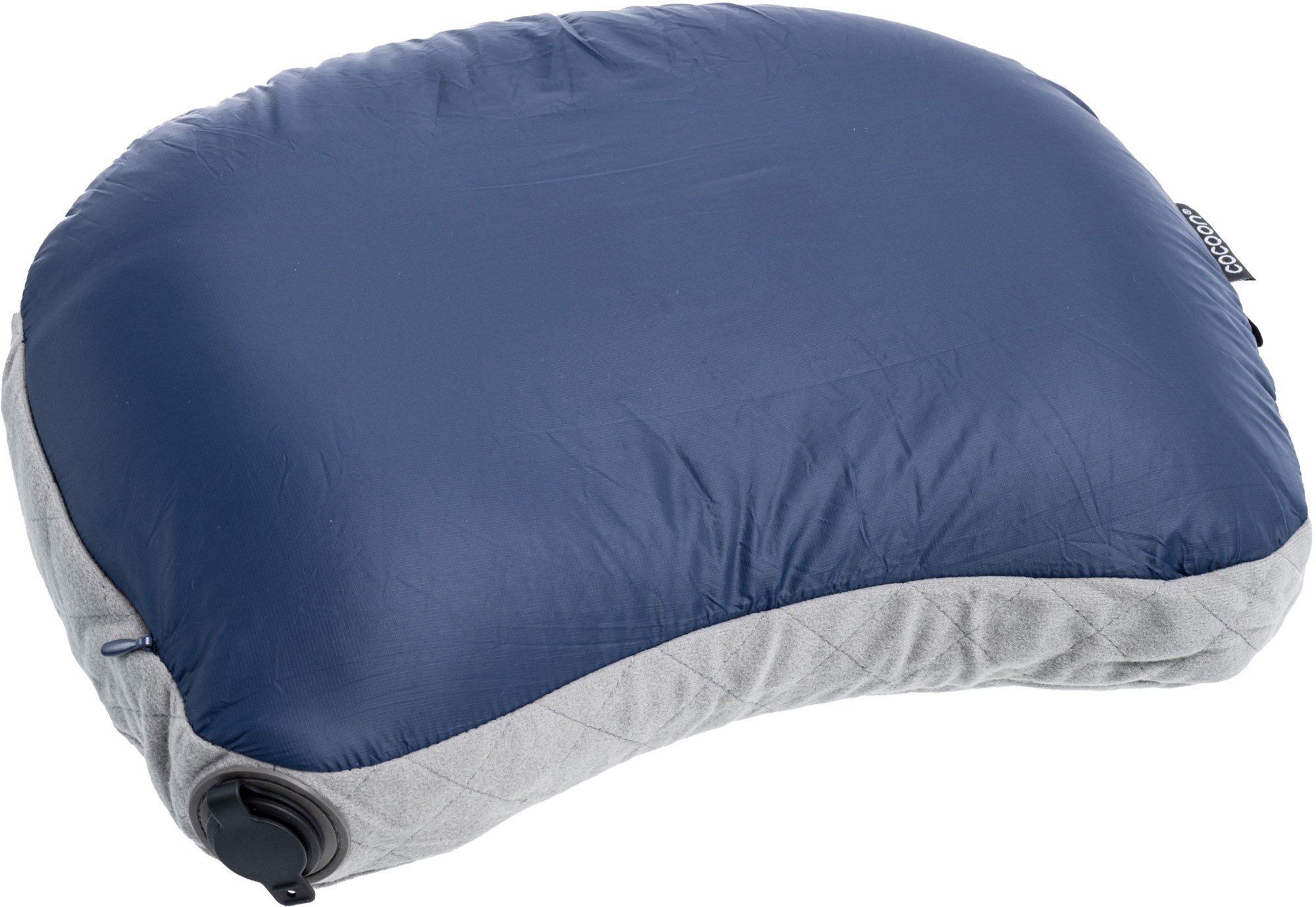
Cocoon may lack the name recognition of brands like Therm-a-Rest and Sea to Summit, but we’ve had positive experiences with their pillow collection thus far. Our favorite in their lineup is the Air-Core Hood/Camp Pillow, which is similar to designs like the Sea to Summit Aeros Premium and Nemo Fillo Elite Luxury above with an inflatable air bladder surrounded by synthetic fill for added support and comfort. Where the Cocoon sets itself apart is versatility: The pillow is double-sided with cozy polyester microfiber on one side for cold nights; in balmy weather, flip it over to reveal smooth nylon that feels cool and soft against the skin. We also found it easy to adjust the amount of air inside with a simple push of the valve at the bottom corner. Finally, the pillow’s curved shape pairs well inside a mummy bag, and the hidden zipper allows you to quickly remove the cover for cleaning (Cocoon recommends washing by hand).
In comparing the Cocoon Air-Core to other leading designs, the polyester microfiber side felt quite a bit softer and plusher than other UL designs we’ve tested, including Therm-a-Rest’s Air Head Lite (a lighter version of the standard Air Head below). That said, despite the competitive 3.8-ounce weight, the Cocoon’s 4.7 x 3.1-inch packed size is on the larger end in the UL category, and we found it a little tough to compress the pillow into its stuff sack. At 14.6 inches wide and 11 inches long, it’s also smaller than competitors like the Air Head Lite (15.5 x 11 in.) and Nemo's Fillo Elite Luxury (21 x 11 in.) above. But the Cocoon is the most versatile of the bunch with its double-sided design, and it’s also the cheapest at just $30. The rest of the brand’s lineup is equally well executed, including the roomier, rectangular Air-Core Ultralight and feathery, 2.7-ounce Air-Core Hyperlite . See the Cocoon Air-Core Hood/Camp Pillow
10. REI Co-op Trailmade Mummy Bag Pillow ($25)
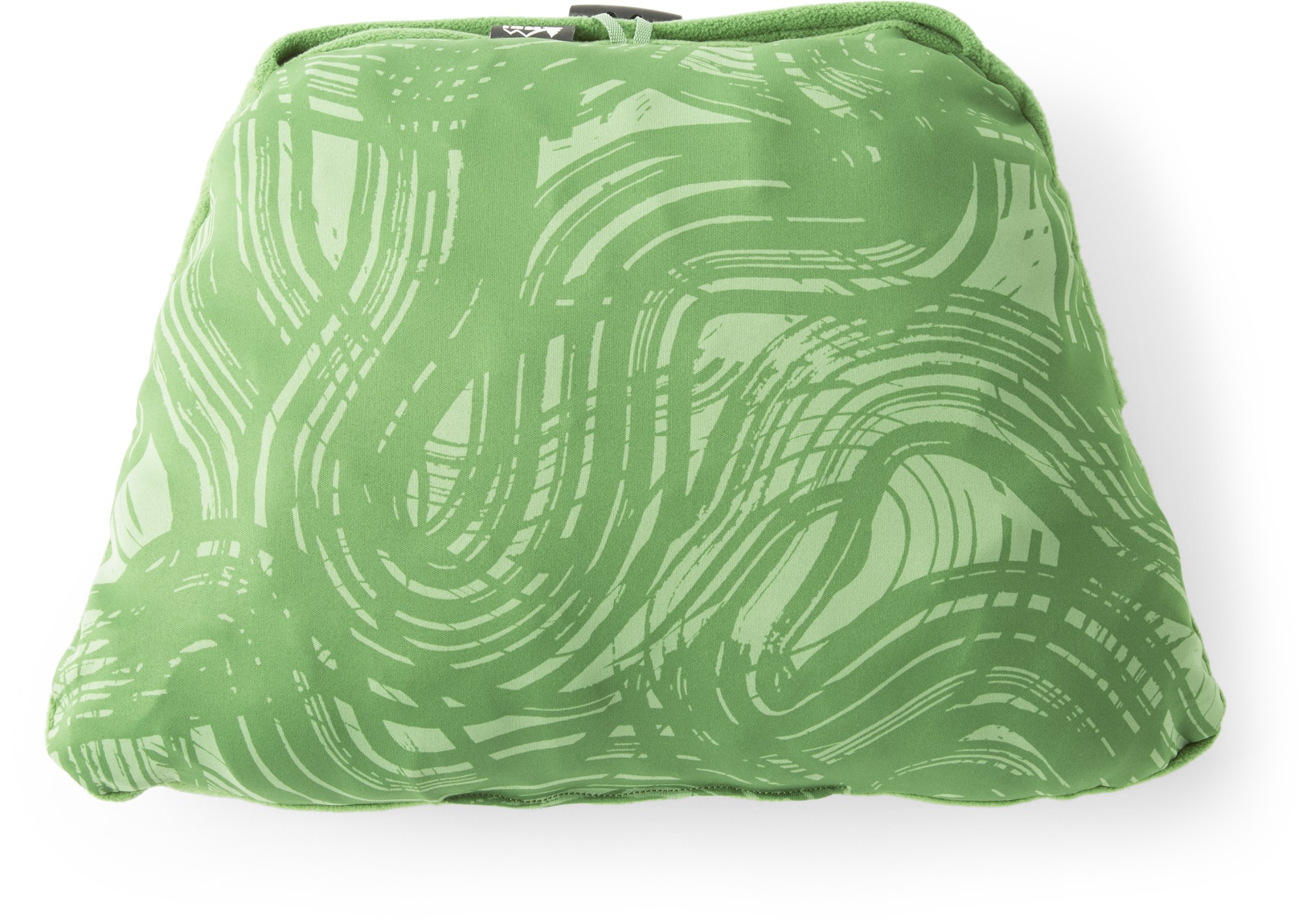
Joining the Teton Sports Camping Pillow above is another budget-friendly option to have on your radar: REI’s Trailmade Mummy Bag Pillow. At just $25, the Trailmade undercuts most of the competition by around $15 to $20 but doesn’t skimp on all-night comfort with plush fleece on one side and a soft polyester fabric on the other. As its name suggests, the Trailmade is also shaped to tuck neatly inside the hood of most mummy bags—including roomier models like the Nemo Forte —while offering a little more pillow space than curved designs like Sea to Summit's Aeros models. Finally, we love that the Trailmade is made with recycled materials and excess foam from REI’s self-inflating sleeping pads—a nice reflection of the brand’s ongoing sustainability efforts.
However, the REI Trailmade isn’t without shortcomings. First, while the foam insulation compresses surprisingly well—when stuffed down, it’s noticeably smaller than the Therm-a-Rest Compressible above—it still adds bulk compared to inflatable options. The REI also has a tendency to form lumps, although that’s fairly common among non-inflatable designs, and massaging the foam should help achieve an even sleeping surface. Finally, the Trailmade is on the smaller side for camping at 15.1 inches long by 9.6 inches wide, which can result in sliding around inside the hood of a rectangular sleeping bag (it works best in a mummy bag). But we keep coming back to value: The REI is competitively well-rounded for the price and light enough to double as a “luxury” item on backpacking trips. For $5 more, we also like REI’s Campwell Camp Pillow which is no featherweight at 14.5 ounces but is considerably larger than the Trailmade at 20 by 15 inches. See the REI Trailmade Mummy Bag Pillow
11. Nemo Fillo Elite Luxury ($70)
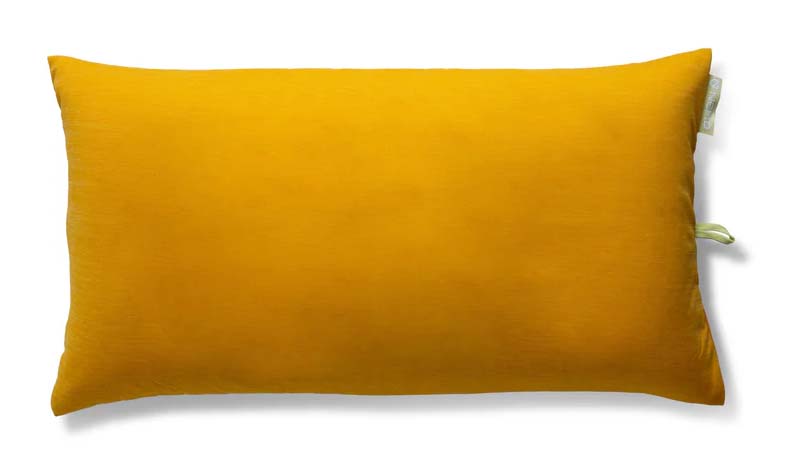
Nemo's Fillo above was quick to win us over on car camping trips, but some backpackers may find it too heavy and bulky to warrant packing on long backpacking missions. For this type of use, we turn to the Fillo Elite Luxury, which trades the standard model’s foam insulation for lighter and more compressible PrimaLoft synthetic fill. The result is a sizable drop in both weight and packed size, with the Fillo Elite Luxury checking in around 5 ounces lighter and compressing down to just 5 x 3 inches in its integrated stuff sack (compared to 6 x 4 in. for the standard Fillo). The rest of the build lines up similarly, including a soft and cozy cover that’s machine-washable, easy inflation and deflation via the ergonomic valve, and Nemo's baffled air cell tech that helps distribute the air evenly across the entire surface of the pillow. Taken together, the Fillo Elite Luxury is a nice upgrade over the standard Fillo for backpackers who want to keep things light without skimping on all-night comfort.
In addition to being lighter and more compressible than the Fillo above, the Nemo Fillo Elite Luxury is also wider by 4 inches, which has its pros and cons. On the plus side, the roomy rectangular shape will feel more like your pillow at home. However, similar to our complaint with the Exped MegaPillow above, it’s too large to fit inside the hood of most mummy bags. If this is a dealbreaker for you, Nemo also offers the standard Fillo Elite (no “Luxury”) and Fillo Elite Ultralight , both of which are narrower, lighter, and cheaper than the Luxury version. However, they’re also on the thinner end at 3 inches thick, and side sleepers will likely prefer additional padding (like what you get with Sea to Summit’s 4.3-in.-thick Aeros Premium above). But if the shape works for you, the Fillo Elite Luxury is impressively light and comfortable for its size. See the Nemo Fillo Elite Luxury
12. Therm-a-Rest Air Head ($53)
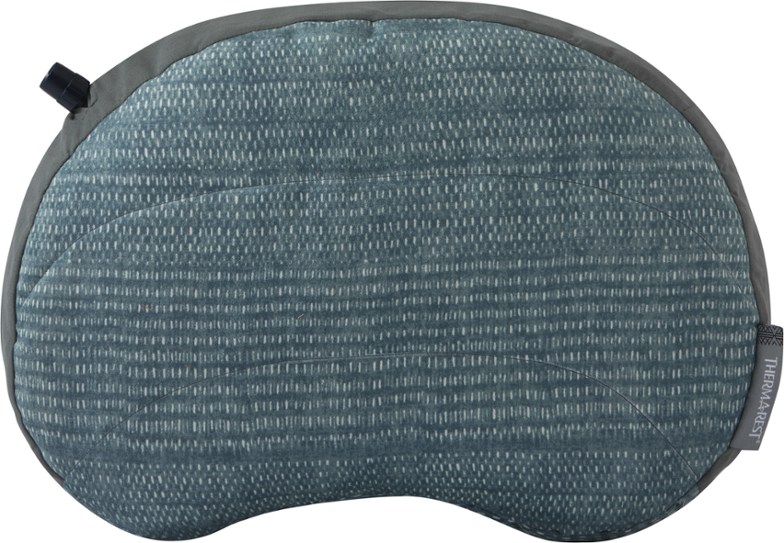
Therm-a-Rest’s Compressible Pillow above is our favorite overall camping design this year, but the all-foam build makes it a little too heavy to cross over for backpacking. Enter Therm-a-Rest’s own Air Head, which uses a mix of air and lightweight synthetic insulation under the top surface to shave weight and minimize bulk. For reference, at 5.6 ounces, the Air Head clocks in around half the weight of the Compressible and packs down noticeably smaller inside its stuff sack, which gives it the clear edge for backcountry adventures. We also like the nonslip fabric along the bottom, which does a great job keeping the pillow in place (unlike Sea to Summit’s Aeros models above, which are noticeably slippery underneath). Tack on a removable cover for easy cleaning and a curved shape to nestle into the hood of your sleeping bag, and the result is a versatile design that works well for everything from multi-day backpacking missions to overnight camping trips and air travel.
Despite its well-rounded build, the Air Head does come with a few drawbacks. Our biggest complaints relate to the internal air bladder, which is on the thinner end and has been plagued by reports of punctures and premature leaks. The bladder’s plastic construction is also relatively crinkly and noisy, meaning finicky sleepers and those prone to moving around throughout the night should steer clear. Finally, the inflate/deflate valve is an old-fashioned design that sticks out the side of the pillow, which makes it less user-friendly when rolling up for storage. Of note: Therm-a-Rest does offer the 2-ounce Air Head Lite , which shares the same dimensions but forgoes the synthetic insulation to shave weight and bulk. And for a boost in comfort and support, you can upgrade to the 4.9-ounce Air Head Down , which is insulated with 650-fill duck down. See the Therm-a-Rest Air Head
13. Sea to Summit Aeros Down ($65)
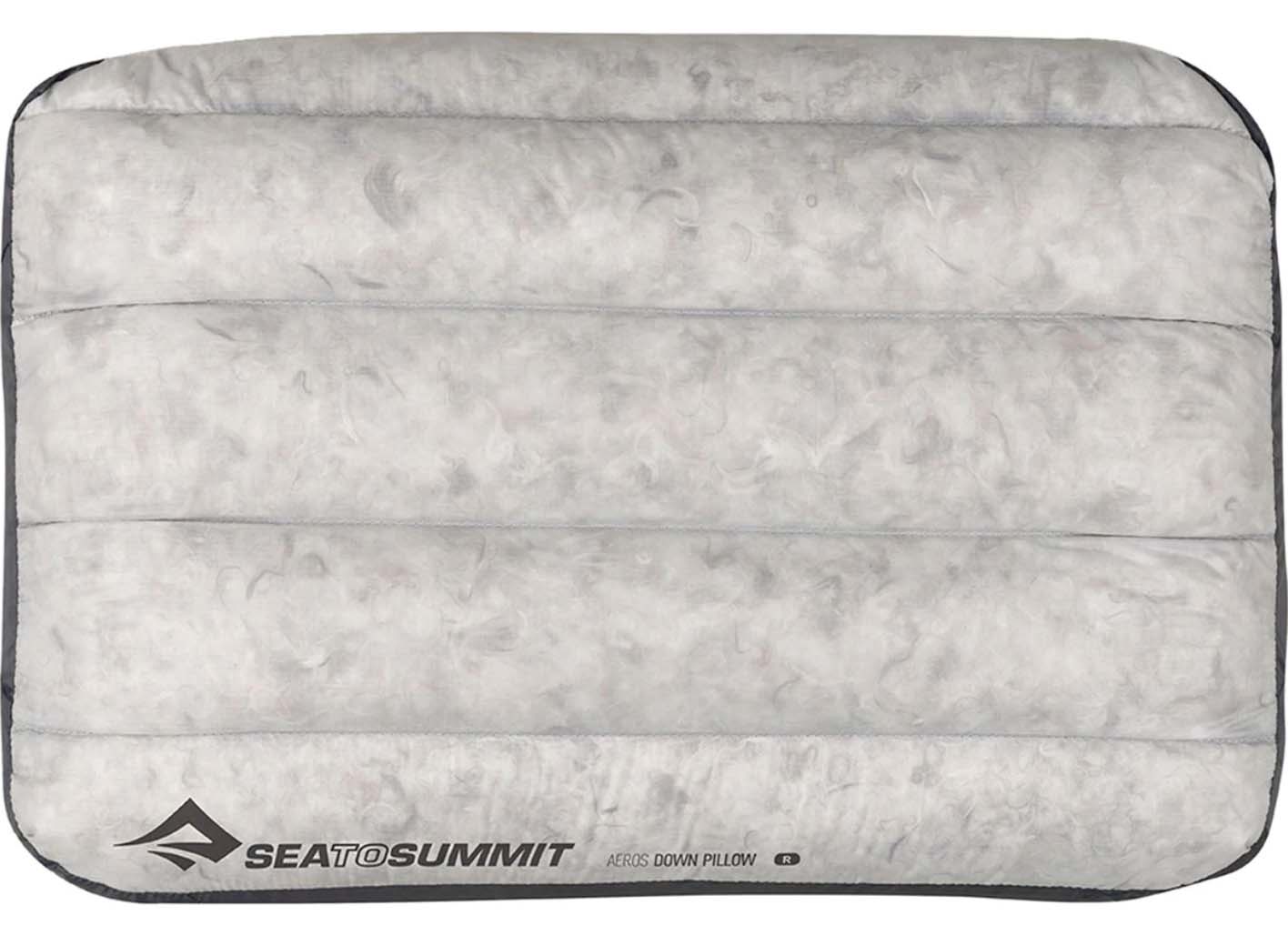
Joining the other two Sea to Summit models above is the Aeros Down, which splits the difference between the Aeros Ultralight (2.1 oz.) and Premium (2.8 oz.) above at 2.5 ounces. It’s also the only model in the collection—and on our list—to include down cushioning along the top, which adds a nice boost in overall comfort and warmth while keeping things light and packable (down is known for being very warm for the weight and highly compressible). Adding to its ultralight focus, Sea to Summit utilized fabrics from their Spark and Flame sleeping bag collections, which are noticeably thin but reasonably tear-resistant (provided you exercise caution). Rounding out the design is a supportive TPU air bladder, low-profile inflation/deflation valve, and compatibility with Sea to Summit’s PillowLock system to secure the pillow to any of their sleeping mats.
However, like most specialized UL designs, the Sea to Summit Aeros Down isn’t a great all-rounder. While decently durable for how thin it is, the 10-denier shell has a delicate feel and will need to be treated with care to avoid punctures. The fabrics are also relatively noisy, slippery, and lack the soft hand feel that you get with the other Aeros models, which use plusher stretch-knit polyester along the top (you could always throw on a lightweight pillowcase to boost coziness). Finally, the Aeros Down forgoes the curved internal baffles and scalloped bottom edge of the Aeros Ultralight and Premium, which we appreciate for keeping our head in place throughout the night. But the down cushioning certainly has its benefits, including a modest boost in overall comfort and warmth with minimal impact on weight and bulk. See the Sea to Summit Aeros Down
14. Rumpl Stuffable Pillowcase ($40)
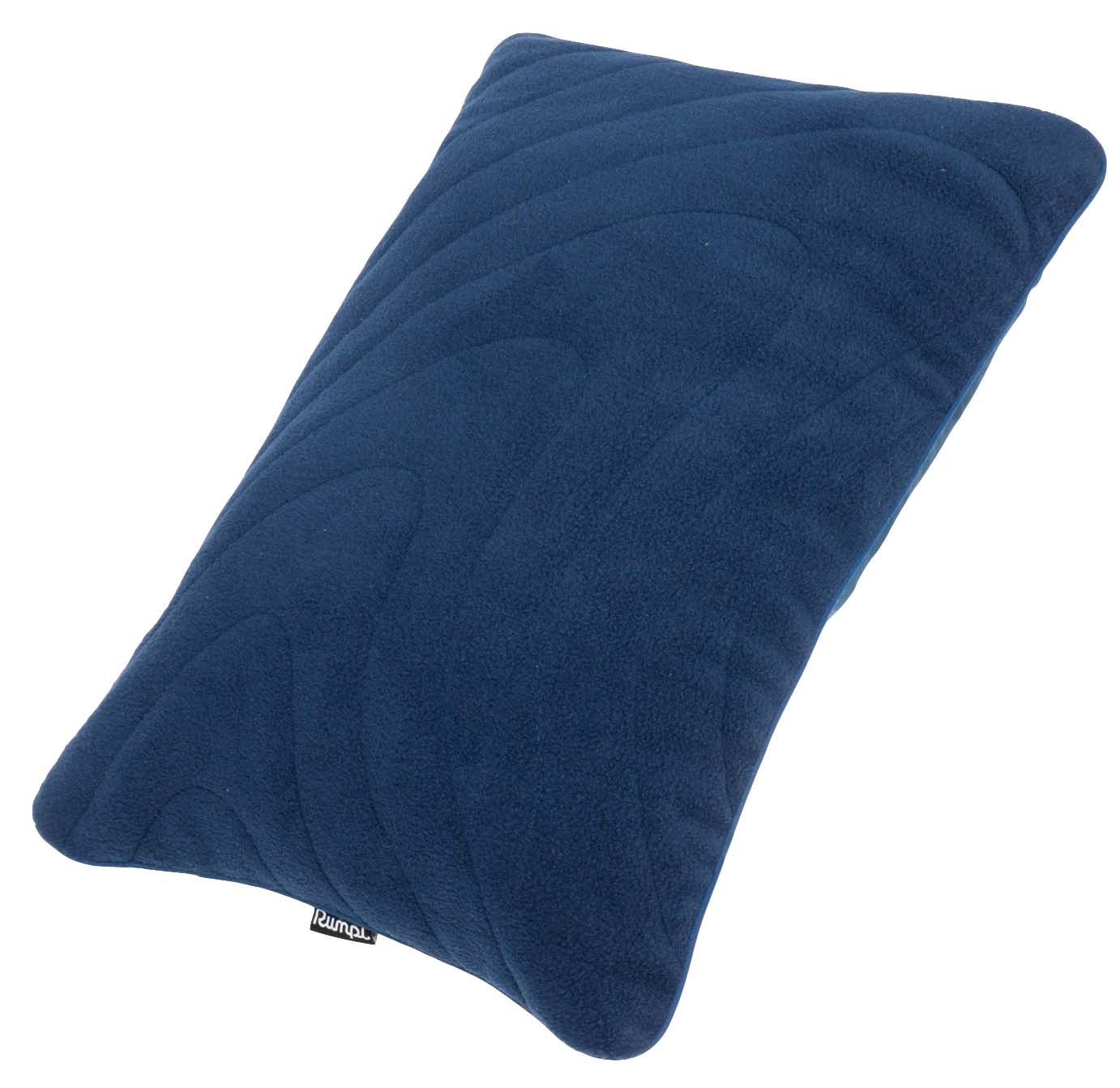
Rumpl is best known for their modern and vibrant outdoor blankets , but they’ve recently started to expand into the rest of the camping market. Their Stuffable Pillowcase is a logical addition to the lineup and competes with Zpacks’ Medium-Plus above as a lightweight stuff sack pillow for minimalist campers and backpackers. The Rumpl’s biggest advantage over the Zpacks is comfort: The double-sided design is considerably plusher and softer with thick polar fleece on one side and smooth ripstop polyester on the other. Like most of Rumpl’s offerings, the Stuffable Pillowcase is also sold in a nice selection of fun colors and patterns (compared to the Zpacks’ single bland colorway) and sustainably built with recycled fleece and a shell made from recycled plastic bottles. And at $40, the Rumpl is a considerable $20 cheaper than the Zpacks, giving it the clear edge in value, too.
That said, apart from the benefits in comfort, price, and sustainability, the Rumpl Stuffable Pillowcase falls short of the Zpacks Medium-Plus in most other areas: It’s heavier by 1.6 ounces, doesn’t pack down as well for storing in a pack, and is smaller at 11 x 16 inches compared to the 11.25 x 20-inch Zpacks. The Medium-Plus’ Dyneema build also allows it to double as a dry bag to protect your clothing on the trail, while the Rumpl’s standard DWR finish will wet out quickly in sustained moisture. In other words, the Zpacks Medium-Plus is the more specialized but versatile pick for ultralight backpacking, while the Rumpl Stuffable Pillowcase offers better comfort for car camping, road trips, and travel. For a more traditional option from Rumpl, their Camp Pillow ($49) features a removable insert for tailoring firmness and a practical two-sided design with cooling polyester on one side and cozy polar fleece on the other. See the Rumpl Stuffable Pillowcase
15. Wise Owl Outfitters Camp & Travel Memory Foam Pillow ($25)
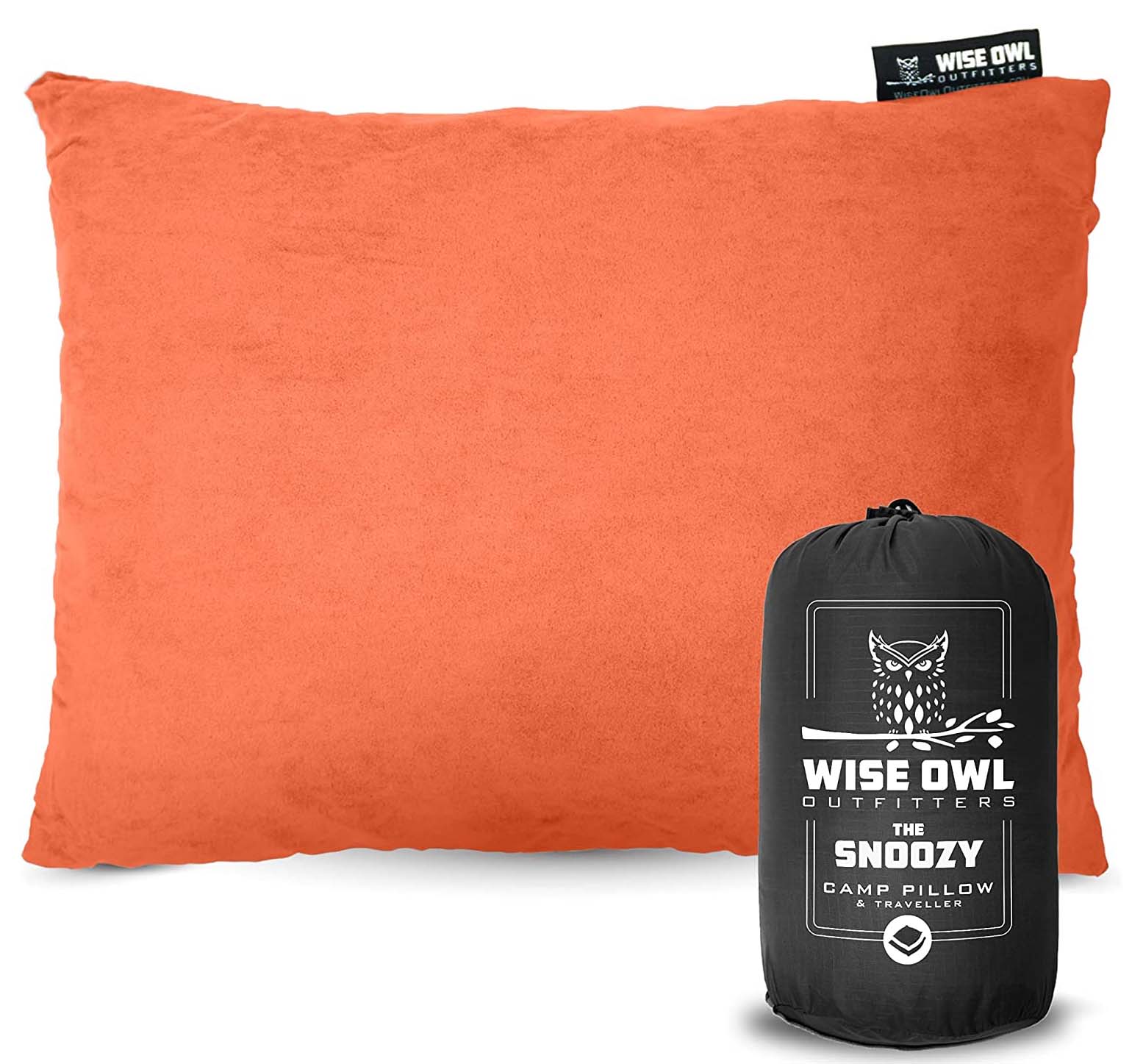
Hest's Camp Pillow above is our favorite memory foam design for campers who prioritize comfort above all else, but it’s no small investment at $89. Enter Wise Owl Outfitters’ Camp & Travel Memory Foam Pillow, which retails for less than 1/3 the price of the Hest (it’s often less on Amazon) but stacks up well in terms of all-night comfort and support. The memory foam is wrapped in a soft micro-suede cover, which feels very smooth and cozy against the skin, and it’s sold in a nice selection of bright colorways that give it the edge in styling, too. Finally, at just 11 ounces for the medium size (9 oz. for the small), the Wise Owl pillow is well over a pound lighter than the Hest and packs down noticeably smaller for stuffing in a pack or duffel bag during travel.
What pushes the Wise Owl Camp & Travel Pillow toward the bottom of our list? At 14 x 18 inches, it’s significantly smaller than the 22 x 15-inch Hest Camp Pillow. Side sleepers may also find it too thin at just 4 inches thick compared to the Hest's generous 8-inch-thick build. Again, the Wise Owl gets the clear edge for travel due to its better packability, but it’s still too heavy and bulky to bring along on backpacking trips. This tweener status puts the Wise Owl pillow in a bit of an awkward spot in our eyes. But we keep coming back to value: The Wise Owl gets you memory foam comfort at a true cut-rate price. See the Wise Owl Camp & Travel Memory Foam Pillow
16. Klymit Pillow X ($27)
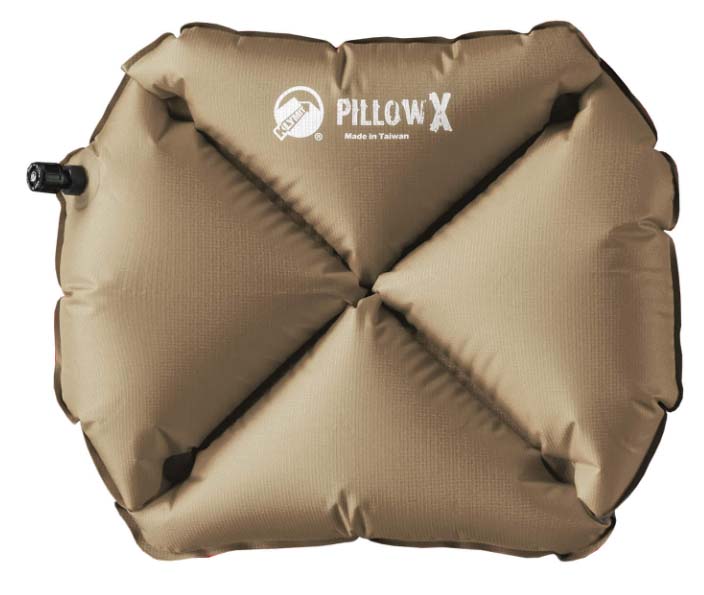
A final camping pillow to have on your radar is Klymit’s aptly named Pillow X. Right away, it’s clear that Klymit went a little off-script with the design: In place of a smooth top, Klymit opted for a unique X shape that’s intended to keep your head centered throughout the night. The rest of the build is highly competitive with other leading backpacking designs, including a feathery 2.5-ounce weight, excellent packability (the pillow measures just 4.5 x 2.5 x 1 in. when compressed in its stuff sack), and a 30D polyester shell that's moderately tough (most UL competitors are 20D or thinner). Finally, at around $18-$27 on Amazon at the time of publishing (depending on the colorway), the Klymit Pillow X will save you a little cash over most of the options above.
All that said, the Klymit Pillow X's distinct shape is a love-it or hate-it feature. Additionally, the standard polyester shell lacks the plush padding and softness of most other designs here, and it’s pretty noisy and slippery, too. You can remedy these issues by bringing along a pillowcase or stuffing the pillow inside a jacket at night, but that will negate some of the pillow’s self-centering tech. In the end, the Pillow X has its place, but the lack of comfort is hard to overlook. For around $10-$20 more, most folks will be better off with a more traditional and softer design like the Sea to Summit Aeros Ultralight or Cocoon's Air-Core above. Alternatively, Klymit’s own Luxe Pillow features a plush, quilted cover and more traditional rectangular shape for $50 (it’s around half the price on Amazon currently). See the Klymit Pillow X
Camping and Backpacking Pillow Comparison Table
About our testing process.
While camping mattresses and sleeping bags get the lion’s share of attention, we always take a pillow with us when car camping and rarely leave it behind on backpacking adventures, too. These small but practical designs add a nice dose of comfort to any sleep system without incurring a major weight penalty and pack down nicely between outings. The Switchback Travel team has been testing outdoor pillows since 2022 when we started this list with 15 picks. To get the lay of the land, we took over a dozen pillows on an inaugural testing trip in Washington state, where we evaluated performance while camping along the shores of Lake Wenatchee and backpacking in the Alpine Lakes Wilderness. Our current list showcases 16 picks that range from ultralight and ultra-packable designs that disappear in a pack to cushy memory foam options for a true home-in-the-woods experience. Since the pillow market is growing and ever-changing, we’re continually updating this list with our favorite offerings.
Managing editor Sarah Nelson spearheaded this guide and leaned on other members of the Switchback team to provide feedback. An avid climber, trail runner, and backpacker, Sarah spends half the year traveling in a truck camper and understands the importance of a comfortable night’s sleep. While priorities vary depending on your intended use(s), all of the pillows on our list are quality designs built to withstand frequent outdoor use. Considerations like thickness, weight, packability, and weather resistance all come into play during testing, and we also appreciate when pillows are easy to launder between trips. Read on to learn more about the finer details and how to choose the best option for you.
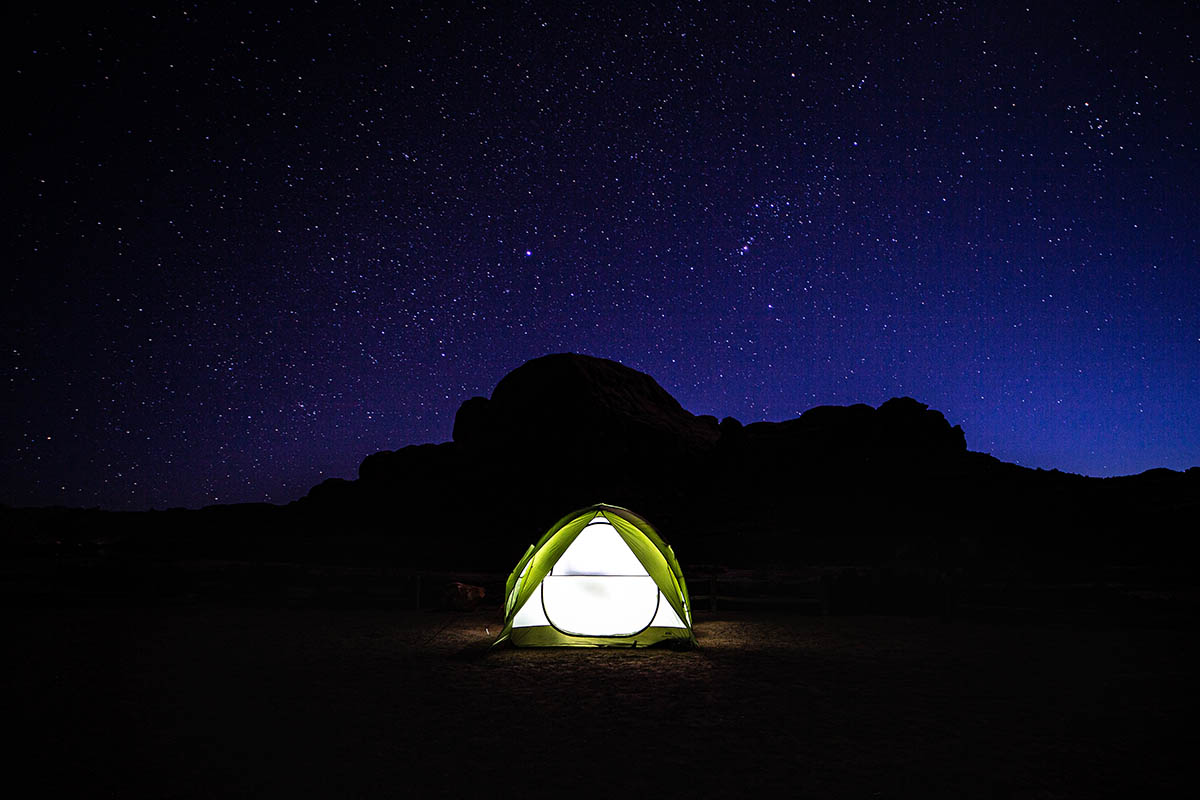
Camping and Backpacking Pillow Buying Advice
- Best Uses: Camping And/or Backpacking
- Stuff Sack Pillows
Pillow Comfort and Thickness
Pillow dimensions: length and width, weight and packability, pillow shape and sleeping bag compatibility, durability (denier), weather resistance, inflation and deflation valves.
- Other Features
Sustainability
Washing and care, using your camping pillow for travel, do you need a camping/backpacking pillow, best uses: camping and/or backpacking.
The first question to answer when choosing the right pillow for you is how and where you plan to use it most. For car camping, we prioritize comfort above all else and look for soft-touch fabrics, thick and supportive padding, and generous dimensions to maximize the amount of surface area for our head. On gear-intensive backpacking missions, we’re willing to compromise a little on all-out comfort to keep weight and bulk to a minimum and instead turn to light and compressible inflatable designs that stash easily into the crevices of our pack. There are many factors at play here, including shell thickness (which we cover in the “ Durability ” section below), construction type (e.g., inflatable vs. memory foam designs), and overall size and dimensions. The good news is that many of the options above cross over decently well for both disciplines, including well-rounded options like the Nemo Fillo Pillow and Therm-a-Rest Air Head.
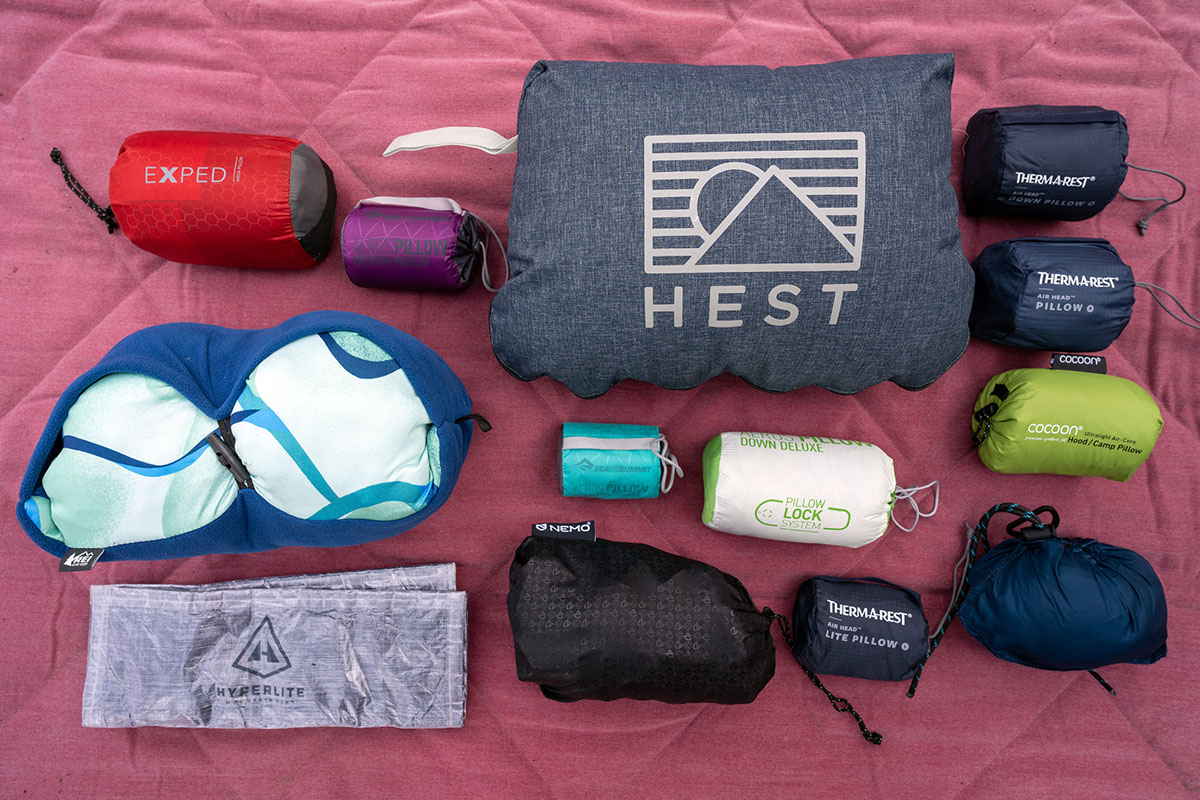
Pillow Types: Construction and Insulation
Pillow construction varies widely, from ultralight and packable inflatable designs like the Sea to Summit Aeros Ultralight to premium memory foam options with plush cushioning for ultimate camping comfort. As we cover in “ Weight and Packability ” below, inflatable options are typically the lightest and most compressible due to the fact that the interior is exclusively filled with air. Some inflatables, like the Sea to Summit Aeros Premium and Aeros Down, also add a light layer of synthetic or down insulation under the cover for a small boost in comfort and warmth (along with a slight weight penalty).
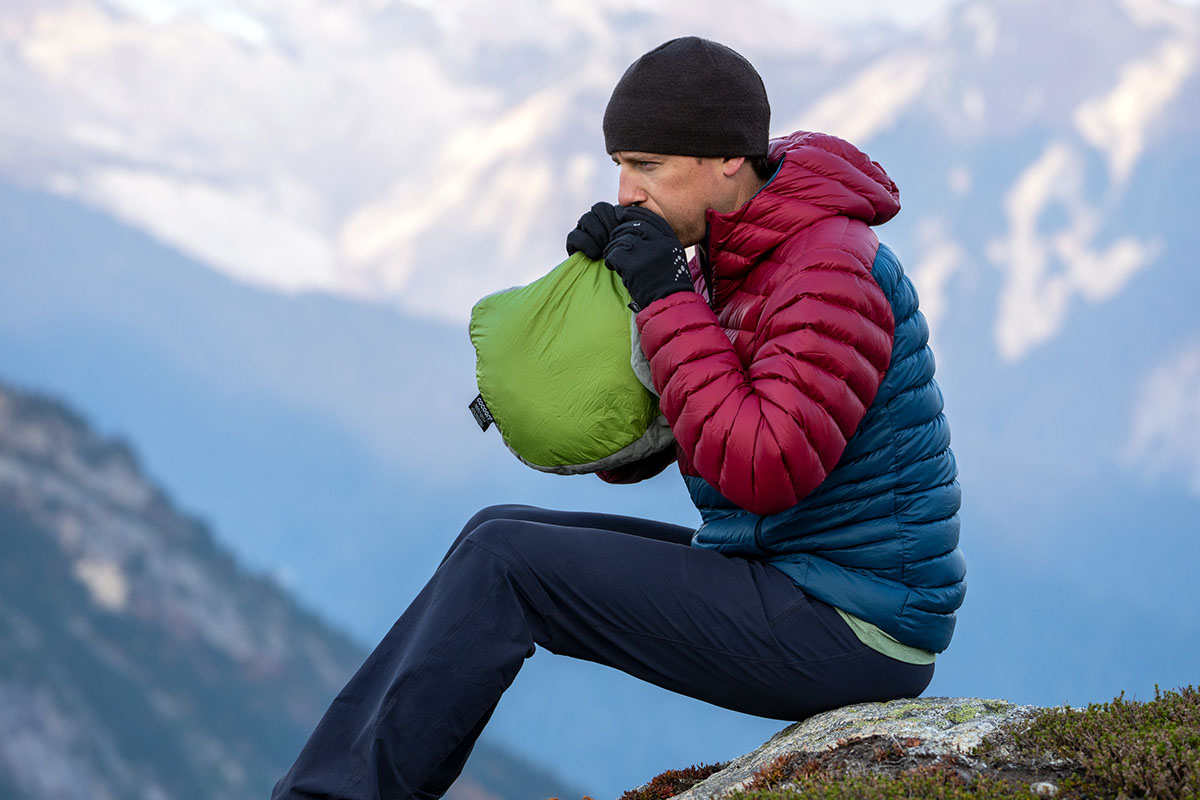
At the other end of the spectrum are non-inflatable models like the Therm-a-Rest Compressible Pillow , Hest Camp Pillow, REI Trailmade Mummy Bag Pillow, and Wise Owl Outfitters Camp & Travel Memory Foam Pillow. These designs utilize foam or memory foam constructions with no air, which adds weight and bulk but comes with sizable benefits in all-around comfort and cushioning. They’re also more resistant to punctures, and you’ll still have some semblance of padding if your pillow deflates in the middle of the night. In the end, we love the premium comfort of non-inflatable foam pillows for car camping but turn to inflatable designs when we’re headed into the backcountry and want to minimize weight and bulk. Again, a final decision will come down to your sleeping preferences and intended use(s).
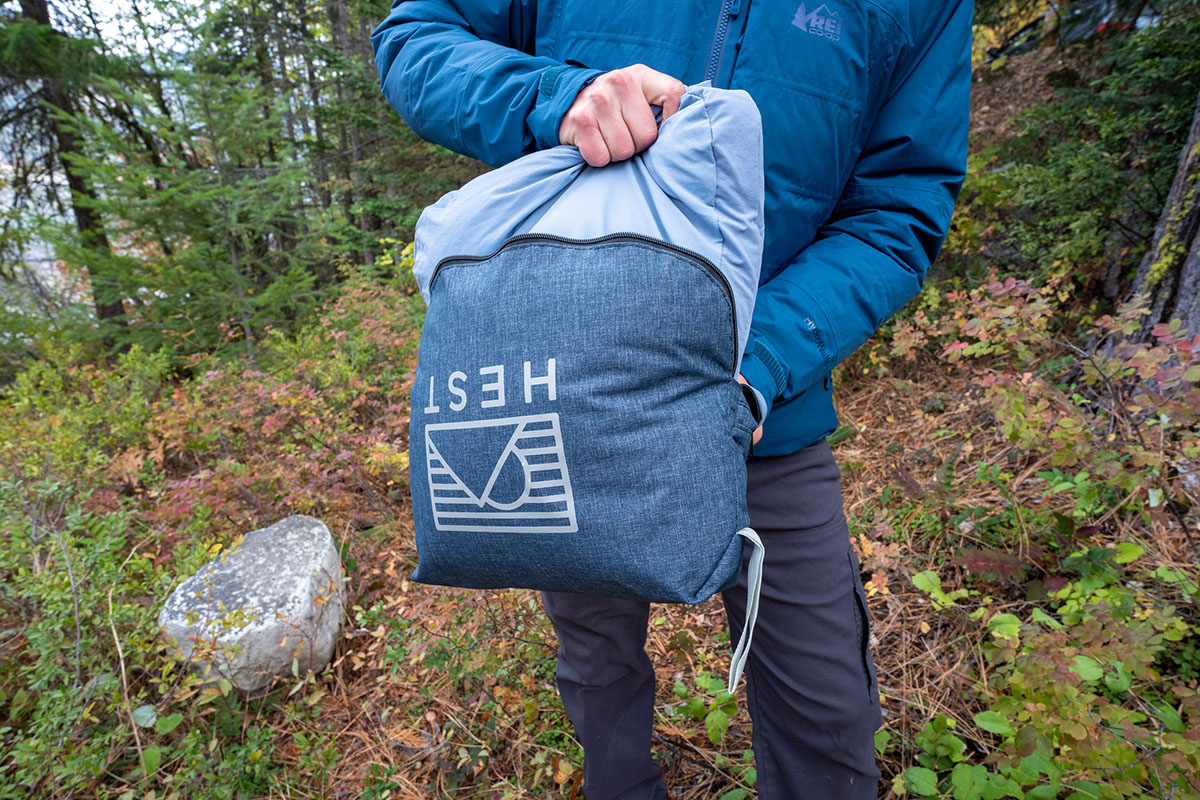
Stuff Sack Pillows Stuff sack pillows are a bit of a misnomer: Essentially specialized and outdoor-ready pillowcases, these designs require stuffing clothing inside for use as a pillow. In addition to being very light and packable, stuff sack pillows like the Zpacks Medium-Plus and Rumpl Stuffable Pillowcase are also highly versatile, providing a space to stash clothing or other gear during the day. The Zpacks can also double as a dry bag to protect your clothes from moisture thanks to its highly water-resistant Dyneema build.
Convenience is the biggest drawback: It takes some effort and patience to achieve an even and consistent (read: lump-free) packing job—rather than just inflating your pillow, you’ll need to take time to intentionally stuff clothing inside until you reach your desired firmness. Comfort is also largely dependent on what you stuff inside (lofty down or synthetic jackets work well). In the end, stuff sack pillows aren’t for everyone, but they’re a great UL pick for minimalists and those who don’t mind putting in some extra work before hitting the hay.
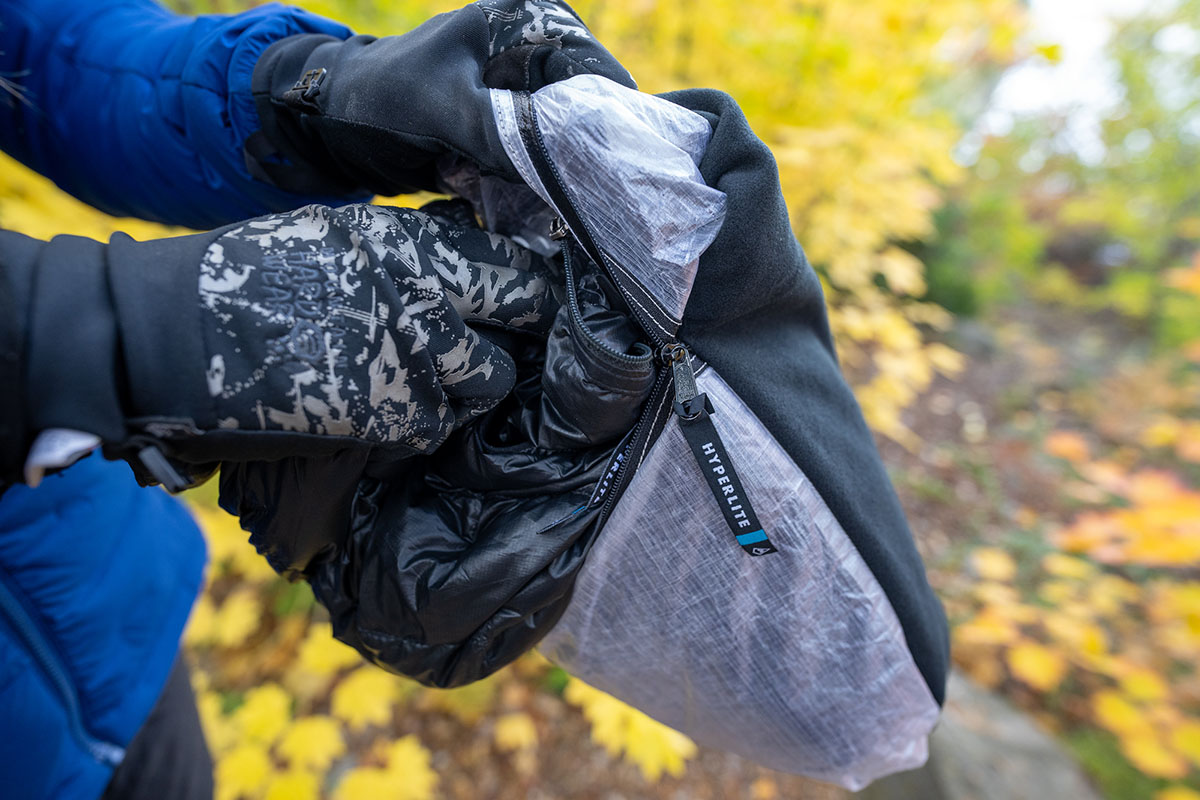
Comfort is relative when sleeping on the ground, and most people who can’t handle a night under the stars don’t camp or backpack at all. That said, there’s still a wide gap between ultralight, backpacking-ready designs and car camping pillows, with the latter typically offering thicker, softer cushioning for better all-night comfort (for more weight and bulk). For instance, Therm-a-Rest’s Compressible Pillow (which is designed for camping) is 6 inches thick, and the all-foam construction offers far better support than most inflatable designs. At the other end of the spectrum is Nemo's Fillo Elite Luxury (best for backpacking), which is around 6 ounces lighter than the Therm-a-Rest but just half the thickness (3 in.). Most designs fall somewhere in the middle at around 4-5 inches thick and hit a nice sweet spot between weight and comfort.
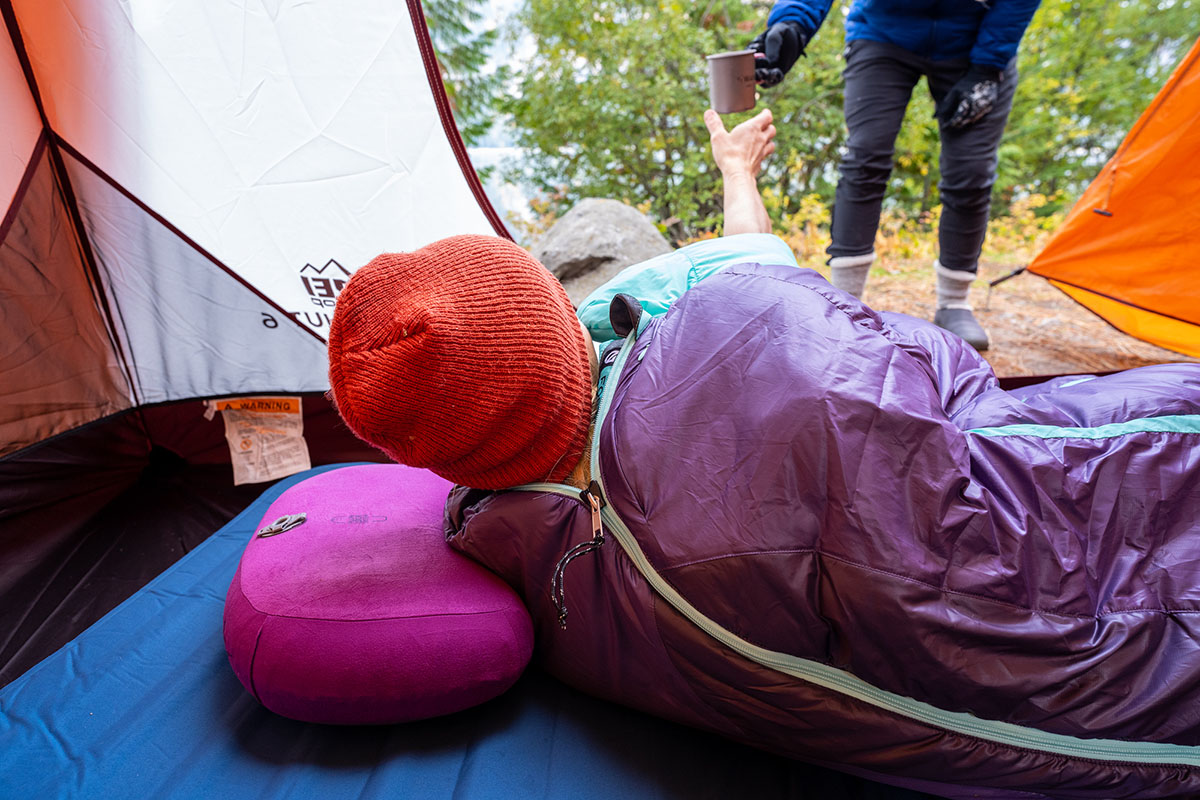
You may notice some chatter in product comments about being a back sleeper or a side sleeper. While this typically has more of an impact when selecting a sleeping pad, it can still be helpful to factor in when choosing a pillow. Height is the most important consideration: You’ll want to make sure your head is in line with your neck and spine, meaning side sleepers will likely want to upgrade to a thicker and firmer design (like the 8-in.-thick Hest Camp Pillow or 6-in.-thick Therm-a-Rest Compressible Pillow) to achieve proper alignment. Back sleepers can typically get away with less padding, but this is largely a matter of personal preference. Shape can also play a role: UL models like the Sea to Summit Aeros Ultralight are molded around the head and neck in a way that works best for us when lying on our backs (again, this can vary from person to person).
Along with thickness, a pillow’s length and width can also have a considerable impact on all-around comfort. At the larger end are camping-focused rectangular designs like the Therm-a-Rest Compressible Pillow (18 x 13 in.), Hest Camp Pillow (22 x 15 in.), and Exped MegaPillow (20.9 x 12.6 in.), which have generous dimensions and plenty of surface area to move around throughout the night without your head falling off the pillow. On the flip side are dedicated backpacking-ready models like the Sea to Summit Aeros Premium (13.4 x 9.4 in.) and Cocoon Air-Head Hood/Camp Pillow (14.6 x 11 in.) that shave off excess material to keep weight and bulk to a minimum. As we cover below, many backpacking pillows also have curved shapes that fit nicely into the hood of a sleeping bag, which is another factor to consider if you plan to spend a lot of time in the backcountry.
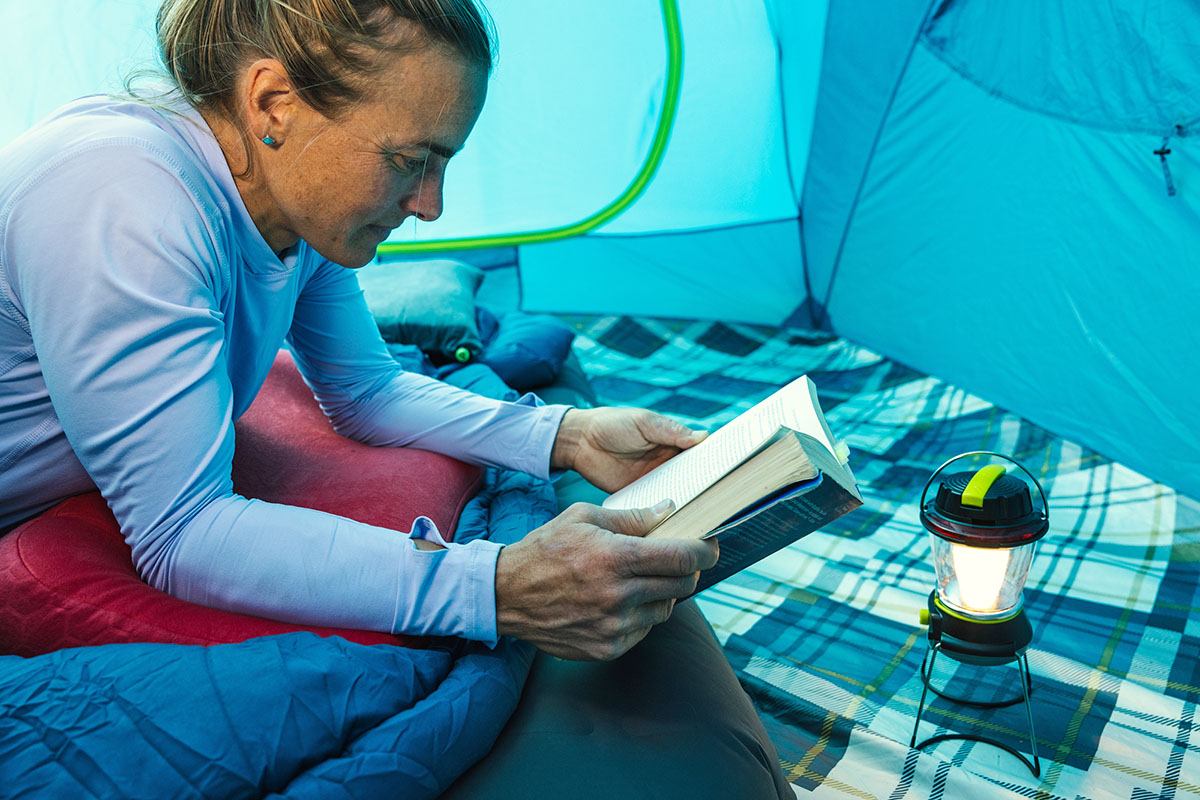
Given their small size, pillows are inherently a pretty lightweight bunch. That said, there’s a decent spread between car camping and backpacking designs, which makes sense considering that backpackers generally want to keep weight as low as possible when hauling gear on their back for miles. For comparison, the lightest option on our list is Zpacks’ Medium-Plus stuff sack pillow at a scant 1.6 ounces, followed by inflatable designs like the Sea to Summit Aeros Ultralight (2.1 oz.) and Aeros Down (2.5 oz.). At the other end of the spectrum are plush memory foam models like Hest's Camp Pillow (2 lb. 3.2 oz.) and Wise Owl Outfitters’ Camp & Travel Pillow (11 oz.). Most options fall somewhere in the middle, with the majority of the pack hovering in the 3- to 10-ounce range. Backpackers will likely want to stick toward the lighter end to minimize the amount of weight on their backs, while car campers can get away with more heft and bulk since they won’t be traveling too far from the trailhead.
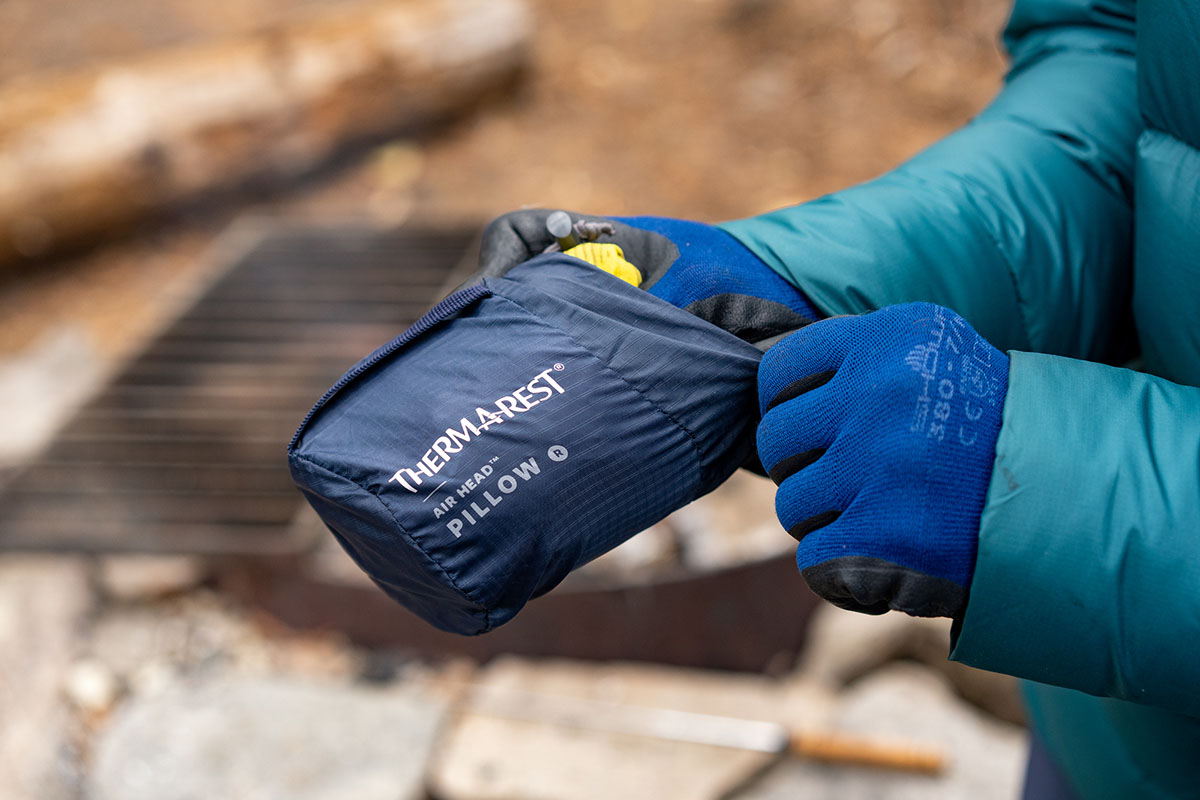
Packed size generally correlates closely with weight and is a function of the pillow type, amount of insulation, and fabric thickness. Uninsulated or lightly insulated inflatable pillows are far and away the most compact, while memory foam pillows like the Hest Camp Pillow add considerable weight and bulk —for comparison, the Hest measures 14 x 9 inches when compressed versus the Sea to Summit Aeros Ultralight at just 2 x 2.8 inches. As we mentioned above, backpackers covering long distances typically prefer lighter and more packable options that disappear into a pack, while car campers who aren’t limited on space are often willing to trade some weight and bulk for added comfort and support. And a final note: Most pillows come with separate stuff sacks that can be misplaced, while integrated designs like the Nemo Fillo and Hest Camp Pillow are less common but nice for absent-minded campers.
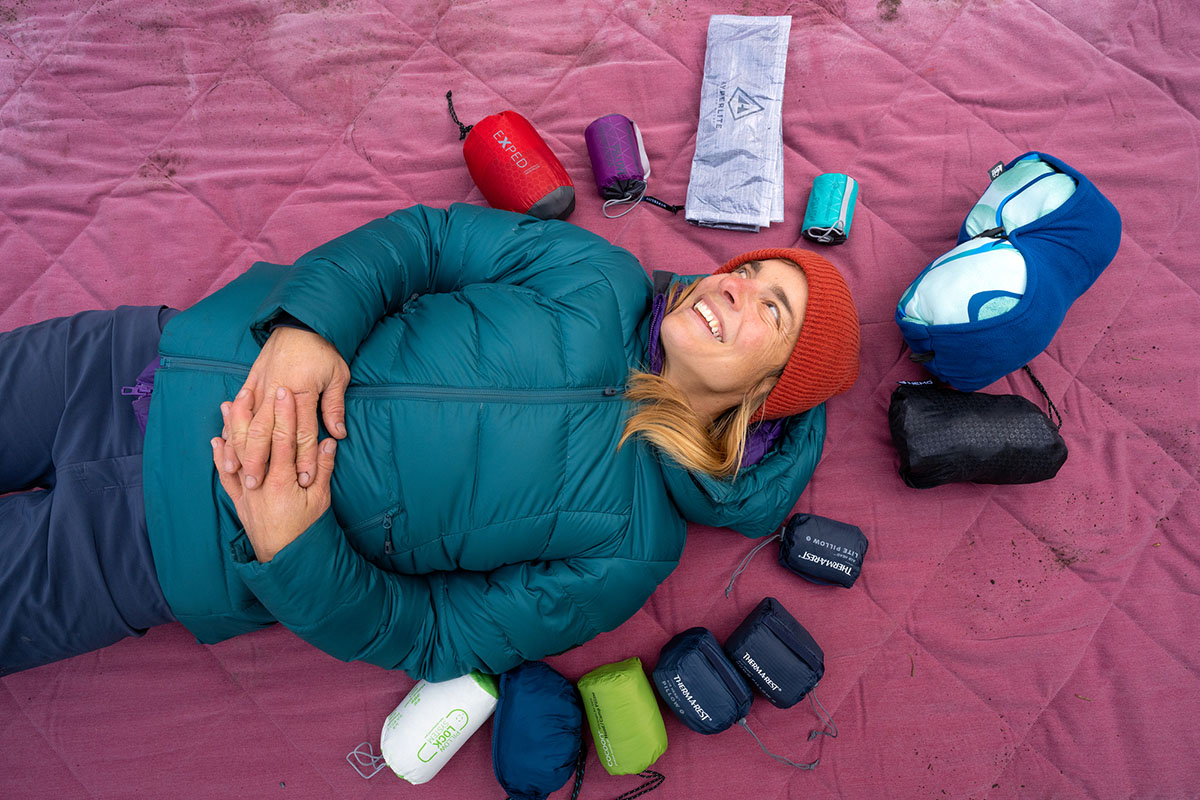
There aren’t too many variations in pillow shape, and a decision will largely come down to how and where you plan to use your pillow most. Rectangular designs like the Therm-a-Rest Compressible , Exped MegaPillow, Hest Camp Pillow, and Nemo Fillo Elite Luxury will feel most similar to your pillow at home, with generous dimensions that maximize the amount of surface area for your head. The biggest drawback is sleeping bag compatibility: Rectangular pillows don’t fit easily into the hood of most sleeping bags, which can lead to sliding around throughout the night.
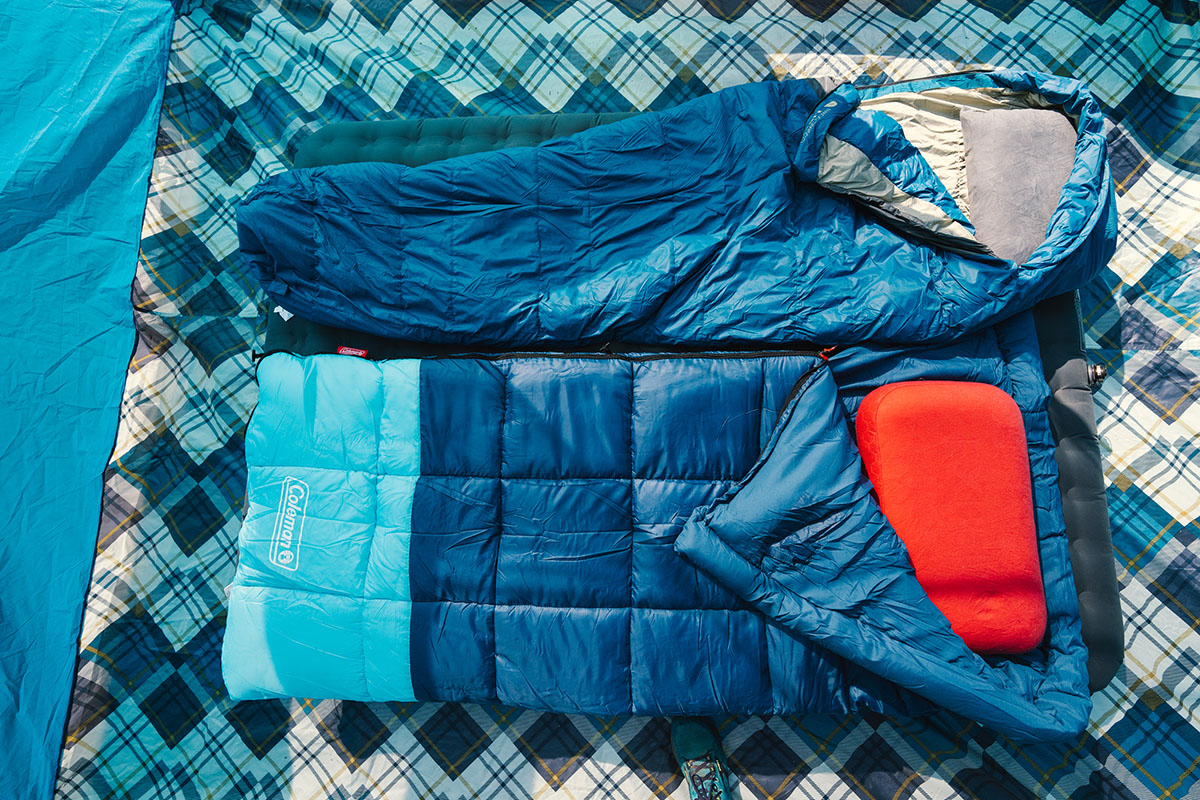
If you plan to pair your pillow inside a sleeping bag , we recommend opting for one with a curved shape (like what you get with the Sea to Summit Aeros Ultralight and Premium, Therm-a-Rest Air Head, Cocoon Air-Core Hood/Camp Pillow , and others above). While typically smaller, curved pillows are our preferred option for backpacking due to their sleeping bag-friendly shape, and the lack of material along the bottom helps keep weight and bulk to a minimum. One exception is REI's Trailmade Mummy Bag Pillow , which has a trapezoidal shape but is small enough that it fits nicely inside a mummy bag hood (hence its name). Many campers use rectangular sleeping bags that forgo a hood, in which case a larger rectangular model could be the better bet.
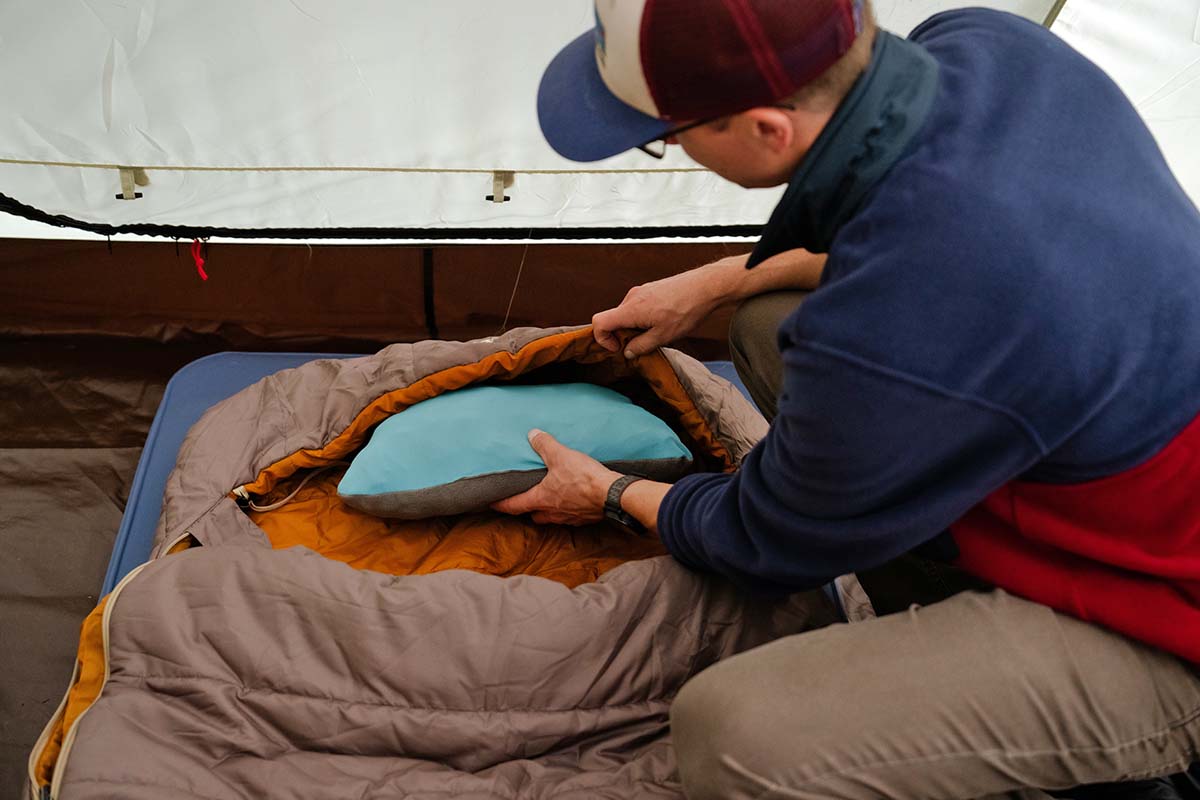
The most common measure of durability in the outdoor gear world is denier (D), which measures the thickness of a fabric. In general, lower-denier fabrics have a much shorter lifespan, a higher propensity for durability issues in the backcountry, and are typically reserved for ounce-counting backpackers who know how to take care of their gear. For example, Sea to Summit’s Aeros Down has a delicate 10D shell that’s practically see-through, while their Aeros Premium’s 50D shell is noticeably thicker and more confidence-inspiring. Most designs fall somewhere in the middle, with 20D being fairly standard in the pillow market.
It's important to note that ultralight inflatable pillows will need to be treated with the most care, as a puncture can quickly render the pillow useless (we recommend bringing along the patch kit that comes with most inflatable pillows for repairs in the field). Alternatively, all-foam pillows are the safest bet, and those that use a mix of foam and air will still offer some padding if your pillow deflates in the middle of the night.
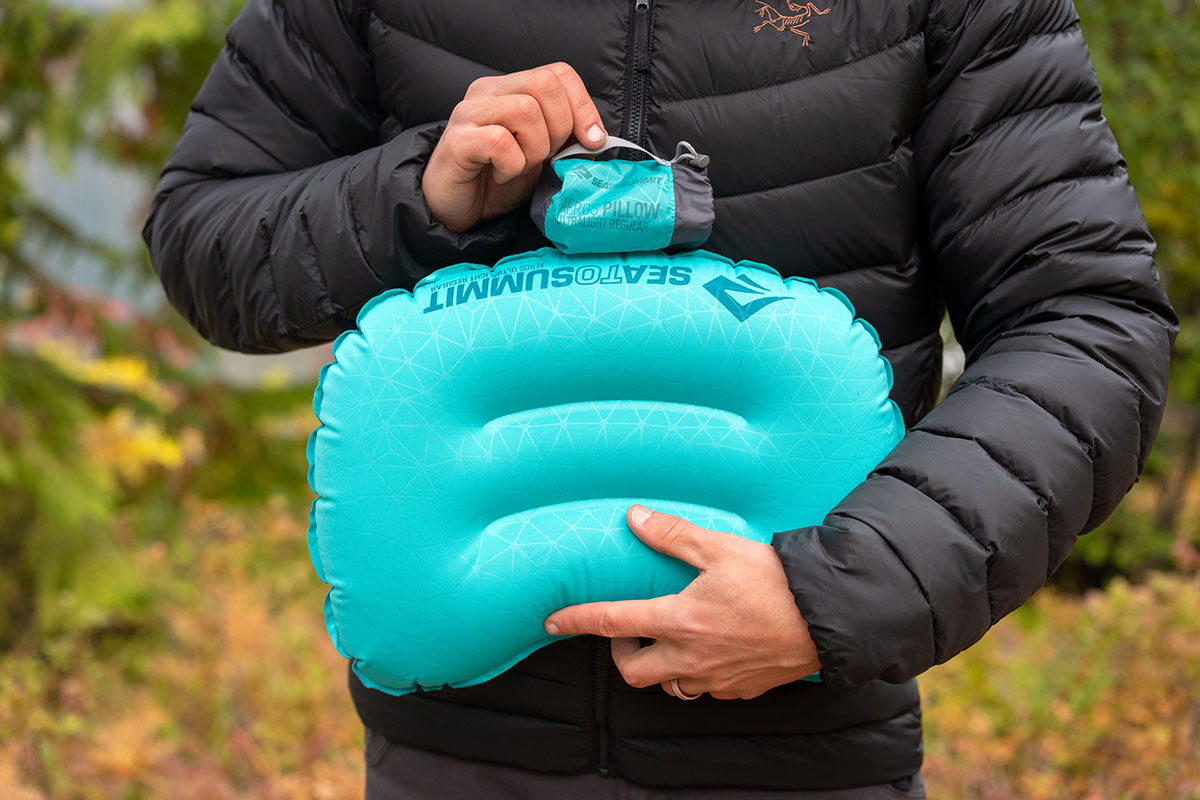
Most campers and backpackers won’t be using their pillow outside of their tent, but a little added moisture resistance can be beneficial when sitting outside by the fire or cowboy camping under the stars. Most of the designs above have a standard durable water repellent (DWR) coating that will allow light moisture to bead up and roll off the surface rather than soaking through the outer shell. Hest's Camp Pillow takes things a step further with a polyurethane (PU) coating along the nylon cover, which sheds both water and dirt. Finally, Zpacks’ Medium-Plus stuff sack pillow is the most weather-ready option here with a highly water-resistant Dyneema build, taped seams, and a waterproof zipper that allow it to double as a dry bag to protect your clothing and gear on the trail. In the end, weather resistance won’t be a critical consideration for most, but it certainly has its benefits.
All of the inflatable pillows above boast valves to add or remove excess air, which makes inflation and deflation easy and allows you to quickly tailor firmness depending on your sleeping preferences. That said, not all valves are created equal, and the difference in ease of use can be quite significant. The most basic is the traditional twist valve (as seen in Therm-a-Rest’s Air Head and Nemo's Fillo and Fillo Elite Luxury), which opens and closes by pushing or pulling a round plastic valve connected to the side of the pillow. These work pretty well in general, but there are downsides to be aware of. For one, the valve works inefficiently because it’s completely open while inflating, which allows some air to escape in between breaths. Further, their upright profile takes up space when rolled up (and pokes out while you’re sleeping), and they are slow to deflate.
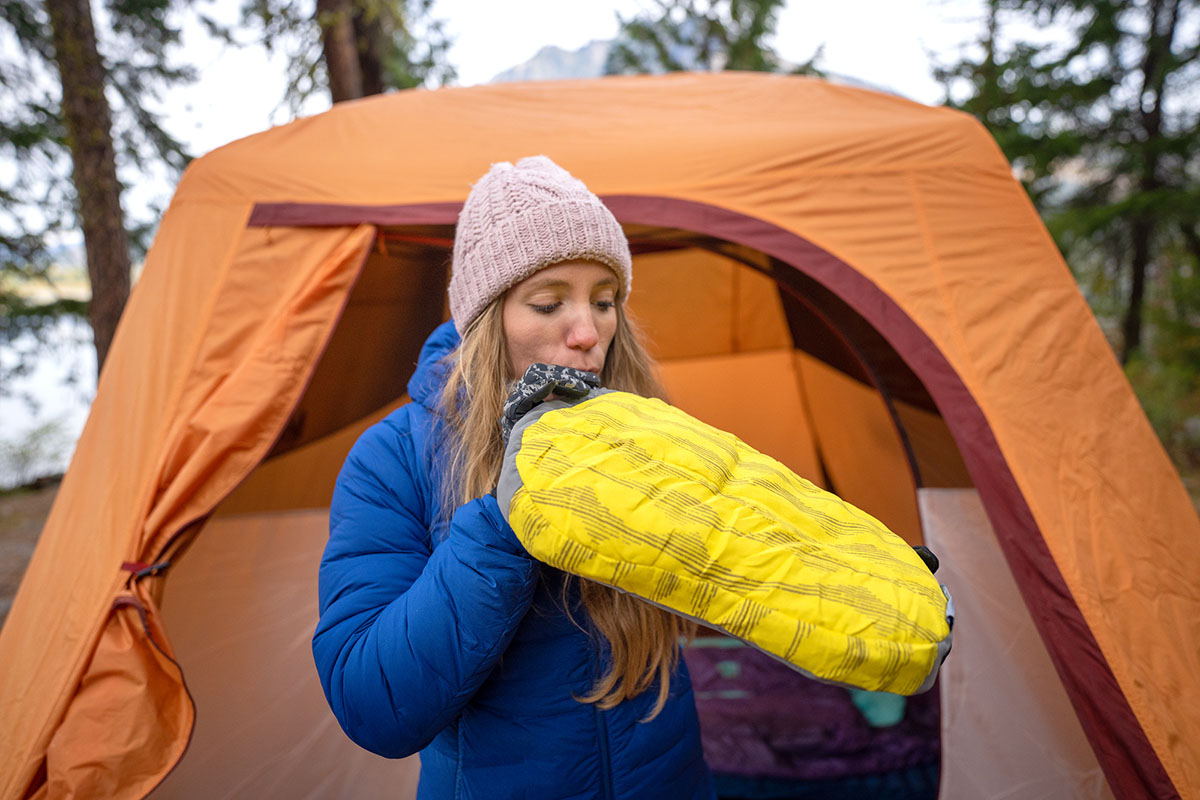
To address these issues, a number of manufacturers have turned to flat valves. Beyond the slim profile, they often have dedicated openings for inflating and deflating and, importantly, a flap that keeps air from escaping while blowing into the opening. Some of our favorite designs with intuitive and quality low-profile valves include the Exped MegaPillow , Cocoon Air-Head Hood/Camp Pillow, and Sea to Summit’s Aeros collection, including the Aeros Ultralight, Premium, and Down models. Overall, we’ve found these designs are reliable, efficient (it takes just a few breaths to inflate, and deflation is almost instantaneous), and add essentially no weight—all excellent characteristics.
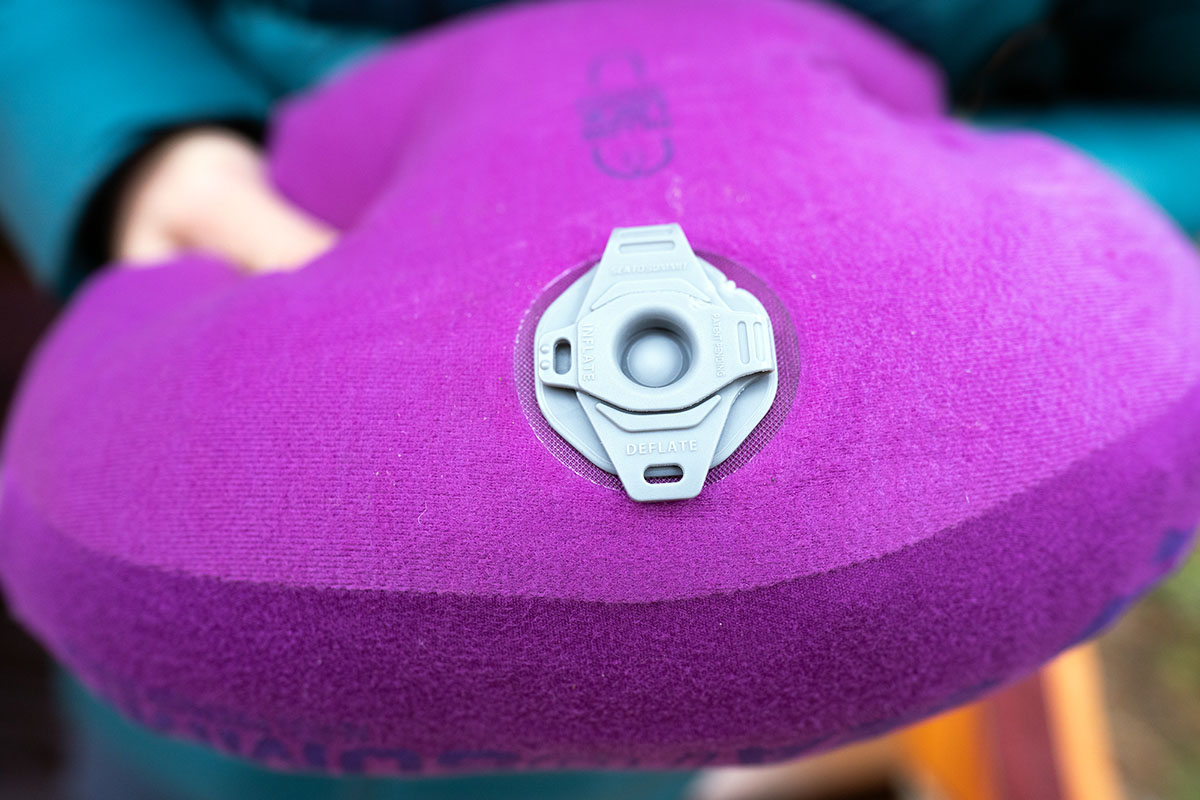
Other Features
Camping and backpacking pillows are inherently basic, but there are a few helpful features worth calling out. First, we appreciate when pillows offer quick and easy cleaning solutions (more on this below). Given their tendency to slide around during the night, it’s also helpful when pillows come with attachment points to secure to your sleeping pad. Exped’s MegaPillow is one example with thin fabric eyelets along the sides, and Zpacks also sells a Pillow Attachment Cord (a $6 add-on) to secure their Medium-Plus stuff sack pillow to your pad. Alternatively, all of Sea to Summit’s Aeros pillows boast their PillowLock tech, which attaches to any of their sleeping mats via hook-and-loop adhesive patches. A final feature worth calling out is the Cocoon Air-Core Hood/Camp Pillow’s two-sided design, which features plush polyester microfiber on one side for cold nights and smooth nylon on the other for added breathability in warm weather.
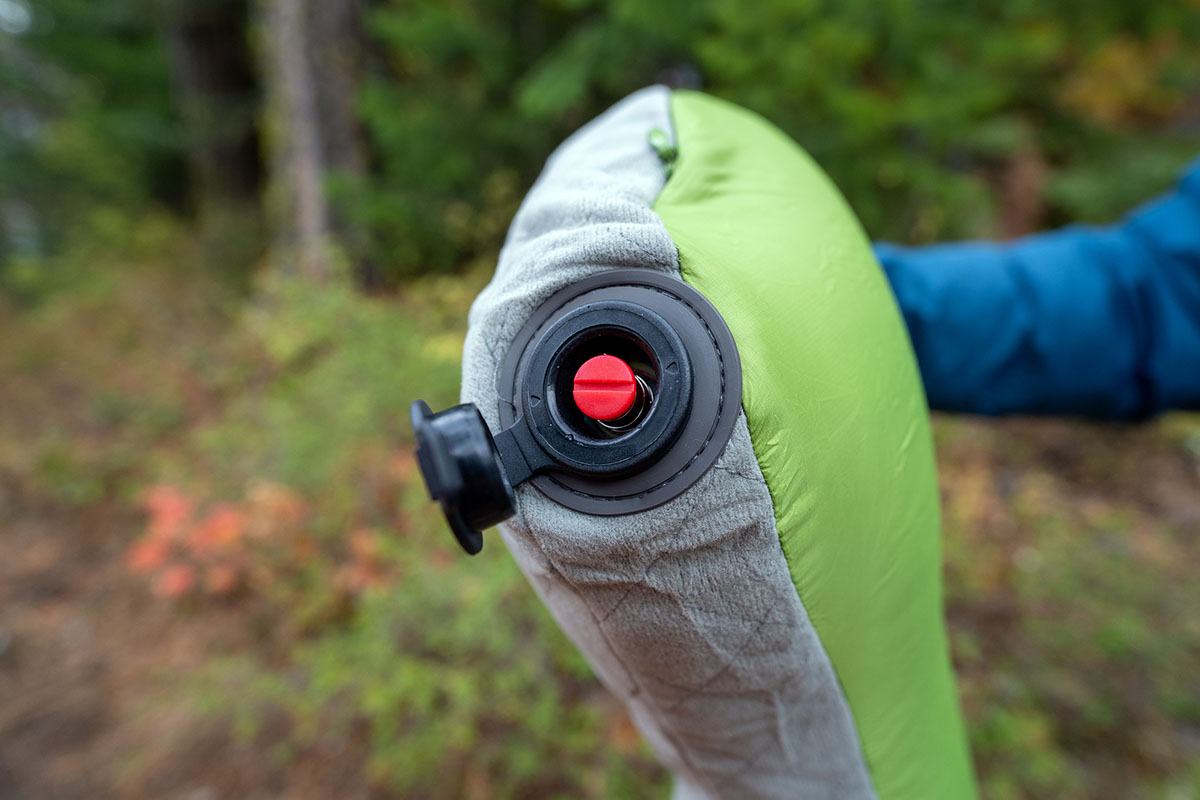
We appreciate when brands go the extra mile in creating eco-friendlier products, and one of the most common measures we see in the pillow market is the use of recycled fabrics and materials. Nemo’s Fillo Elite Luxury Pillow, for instance, uses 100% post-consumer recycled synthetic insulation, while the REI Trailmade Mummy Bag Pillow utilizes recycled polyester and excess foam from REI’s self-inflating sleeping pads. Rumpl is another standout in this realm, and their Stuffable Pillowcase above is a nice example with recycled fleece and a polyester shell made from recycled plastic bottles. It’s worth noting that PFC-free DWR finishes are quickly becoming the norm in other categories (e.g., rain jackets and hardshells ), and we hope to see that shift trickle down into the pillow market soon. Currently, most pillows still employ DWR finishes that contain harmful perfluorocarbons—“forever chemicals” known to have negative effects on human health and the environment.
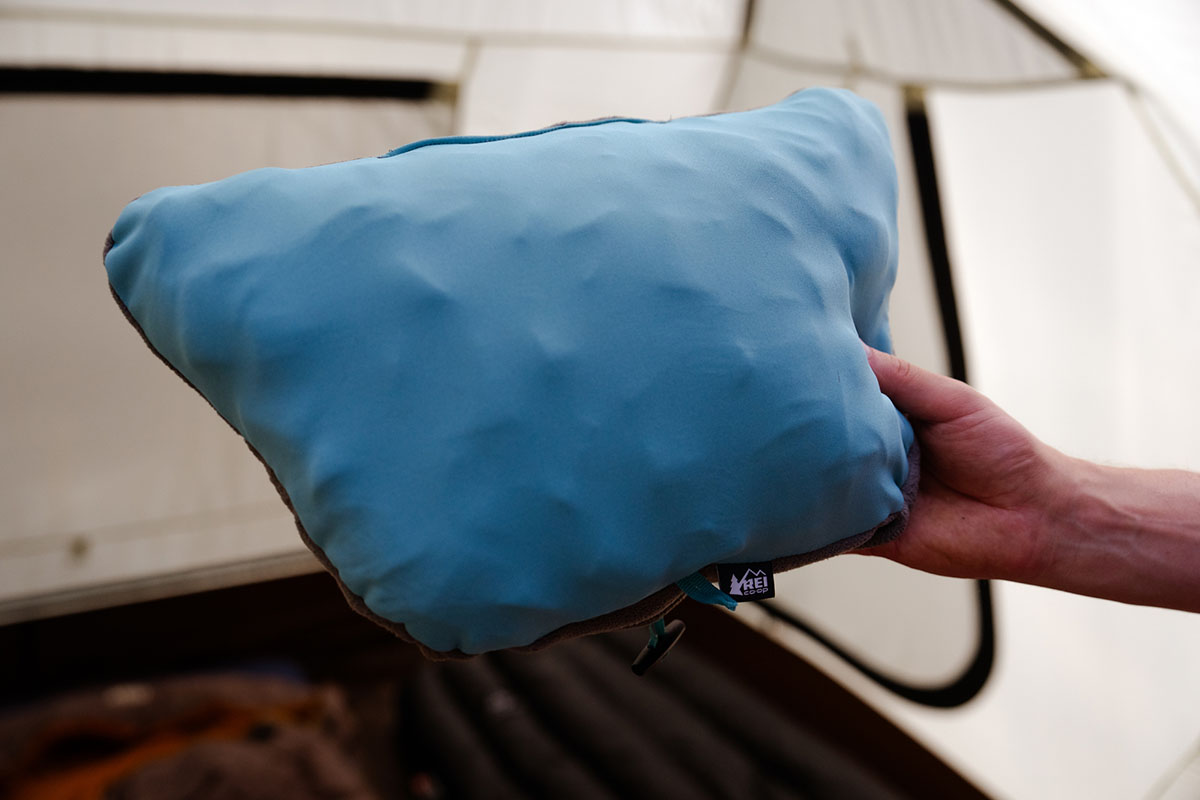
Pillows can get dirty quickly, especially if you’re a frequent camper or backpacker who gets out multiple times each season. The good news is that many outdoor-ready pillows have removable covers that can be thrown in the wash with other clothing, including designs like the Hest Camp Pillow, Therm-a-Rest Air Head, Exped MegaPillow, and others above. Cocoon’s Air-Core Hood/Camp Pillow also has a removable pillowcase, although Cocoon recommends hand-washing in lukewarm water and tumble drying to maximize its lifespan. Some non-inflatable designs like Therm-a-Rest's Compressible Pillow and Teton Sports’ Camping Pillow forgo removable covers but can simply be thrown directly into the washing machine. Finally, for inflatables without removable covers, it’s best to remove all the air from the pillow and keep it rolled in its stuff sack to protect it from punctures.
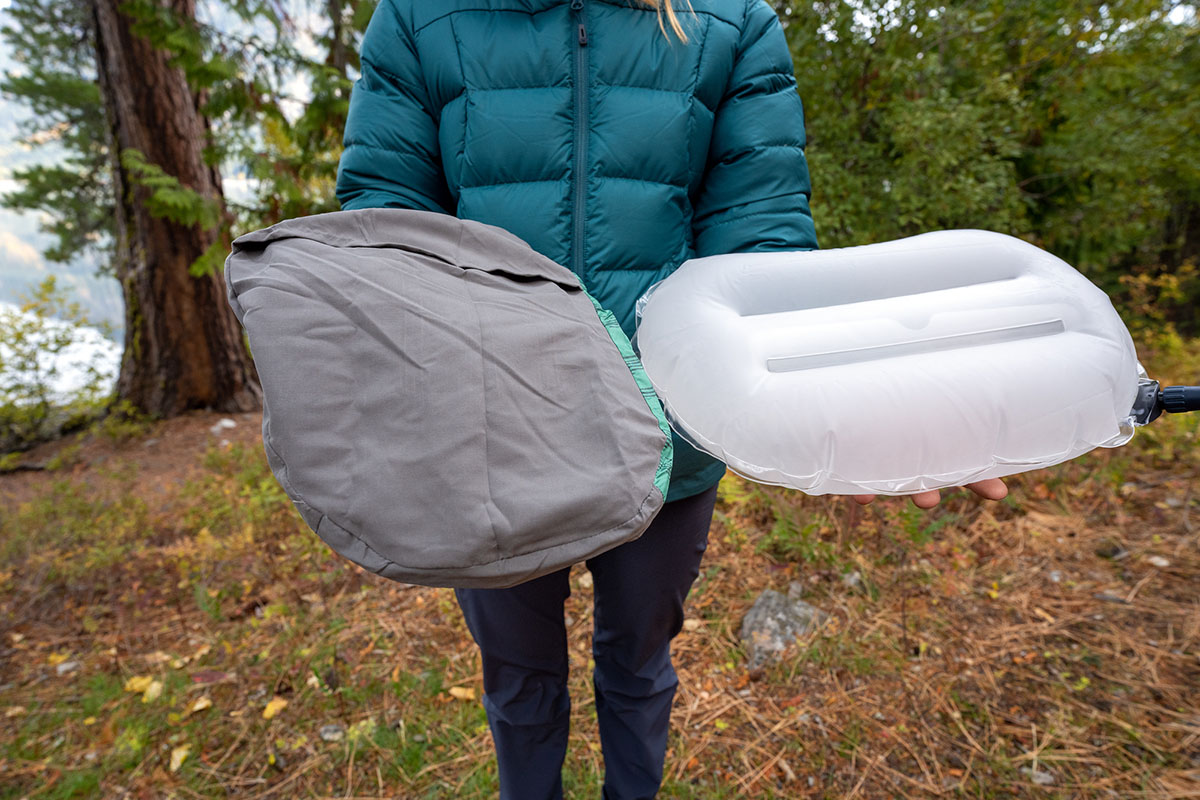
All of the pillows above are built primarily for outdoor use, but many cross over decently well for travel, too. Rumpl’s Stuffable Pillowcase is one of our favorites for this type of use, allowing you to tailor firmness and thickness by varying the types of clothing you stuff inside (e.g., baselayers for less cushioning and puffy down jackets for better loft and support). Therm-a-Rest’s Compressible Pillow is another viable option with soft and comfortable materials that compress down reasonably well for stashing in a duffel bag or pack when you reach your destination.
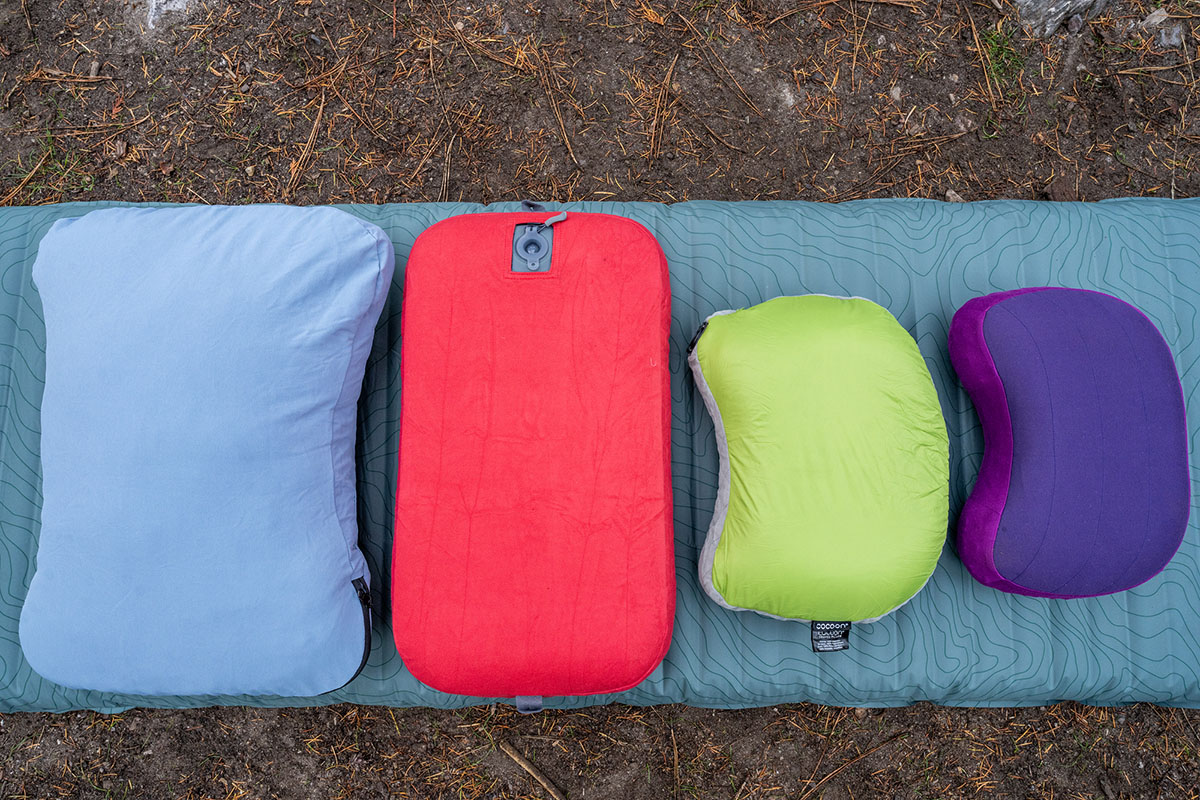
That said, frequent travelers and those who don’t plan to use their pillow outside often will likely want to opt for a dedicated travel design. Unlike the options above, these pillows typically boast U-shaped designs that curve around the neck to keep your head in place while sitting upright on a plane or bus. While typically heavier and less packable, the boost in neck support is sizable, and you often get a cinch cord at the front for securing the pillow in place while you sleep. There are plenty of affordable options available on Amazon, but many of the brands we cover above also offer dedicated designs in travel-friendly shapes. A few of our favorites are Cocoon’s U-Shaped Neck Pillow and Sea to Summit’s Aeros Premium Traveller and Ultralight Traveller pillows.
From personal experience, we went years without owning a dedicated camping/backpacking pillow and were able to make do by using a jacket or two for head support at night. Alternatively, you can always bring along a pillow from home or stuff clothing inside a cheap pillowcase while car camping (similar to stuff sack designs like the Zpacks Medium-Plus Pillow and Rumpl Stuffable Pillowcase above). That said, outdoor pillows are a pretty affordable bunch at around $20-$40, come with specialized fabrics and features that will stand up well to long-term outdoor use, and take up minimal space when stored. The boost in all-night comfort is also noticeable enough that we no longer camp or backpack without one. In the end, only you can decide whether or not the cost is justifiable (it may come down to how frequently you sleep outside), but we feel it’s a small price to pay for a sizable bump in outright comfort and support. Back to Our Top Pillow Picks Back to Our Pillow Comparison Table
Read More From Switchback Travel
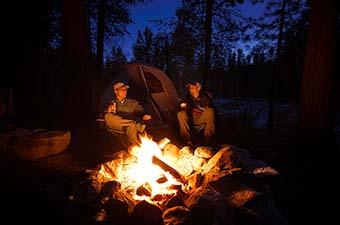
Camping Gear Reviews
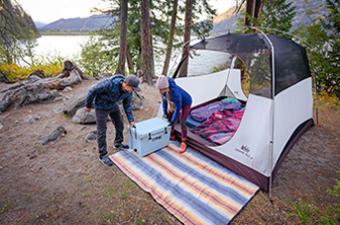
Best Camping Gear of 2024
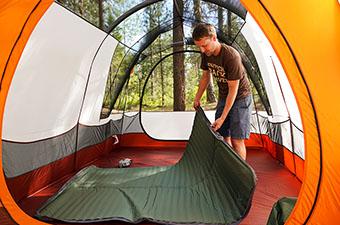
Exped MegaMat Duo 10 Review
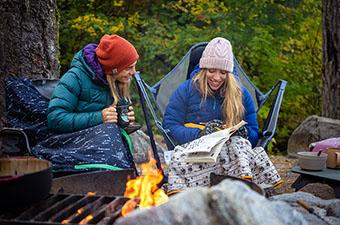
Best Camping Blankets of 2024
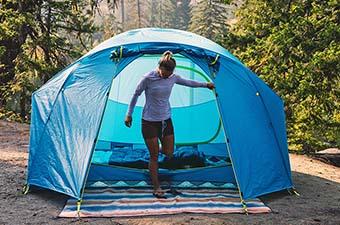
Nemo Aurora Highrise 6P Tent Review
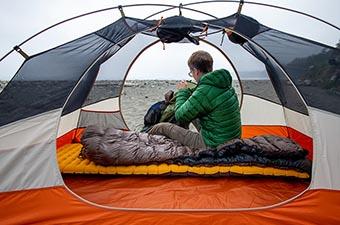
Best Backpacking Sleeping Pads of 2024
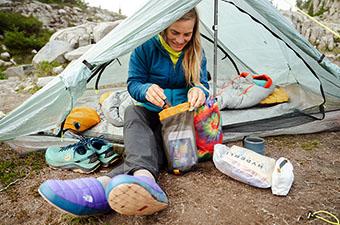
Best Stuff Sacks of 2024
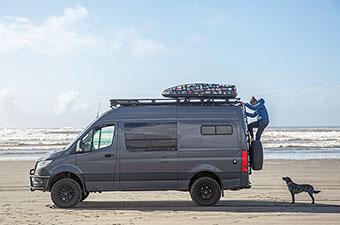
Rhino the Adventure Van: Our 2019 Sprinter 2500 4X4
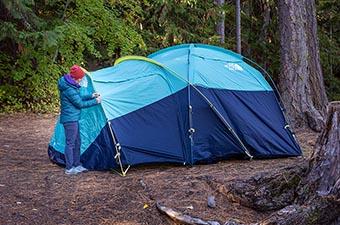
Best Camping Tents of 2024

Mobile Menu
Megamenu - desktop hamburger menu.
- Hiking Gear
- Backpacking Gear
- Biking Gear
- Camping Gear
- Footwear Reviews
- Climbing Gear
- Skiing Gear
- Winter Gear Reviews
- In-Depth Gear Reviews
- Hiking Shoes
- Hiking Boots
- Trail Running Shoes
- Mountain Bike Shoes
- Approach Shoes
- Climbing Shoes
- Beginner Climbing Shoes
- Mountaineering Boots
- Winter Boots
- Rain Jackets
- Down Jackets
- Synthetic Jackets
- Fleece Jackets
- Hardshell Jackets
- Softshell Jackets
- Windbreaker Jackets
- Ski Jackets
- Winter Jackets
- Hiking Pants
- Hiking Socks
- Trekking Poles
- Baby Carriers
- Running Vests
- Backpacking Tents
- Backpacking Packs
- Backpacking Sleeping Bags
- Backpacking Sleeping Pads
- Backpacking Stoves
- Backpacking Food
- Water Filters
- Altimeter Watches
- Handheld GPS
- Mountain Bike Helmets
- Mountain Bikes
- Mountain Bikes Under $1,000
- Mountain Bikes Under $2,000
- Gravel Bikes
- Bike Brands
- Kids' Bikes
- Hitch Bike Racks
- Camping Tents
- Rooftop Tents
- Camping Sleeping Bags
- Camping Mattresses
- Camping Chairs
- Camping Stoves
- Duffel Bags
- Rock Climbing Shoes
- Climbing Helmets
- Climbing Harnesses
- Climbing Quickdraws
- Belay Devices
- Climbing Ropes
- Climbing Backpacks
- Winter Gloves
- 4-Season Tents
- Ski Helmets
- Ski Goggles
- Ski Backpacks
- All-Mountain Skis
- Ski Bindings
- Backcountry Skis
- Backcountry Ski Boots
- Skis for Beginners
- Hardpack Skis
- Mirrorless Cameras
- Full-Frame Cameras
- DSLR Cameras
- Point-and-Shoot Cameras
- Travel Cameras
- DSLR Lenses
- Mirrorless Lenses
- Lofoten Islands
- Lofoten Hiking
- Hardangervidda
- Jotunheimen
- 10 Great Norway Hikes
- Public Huts
- Torres del Paine
- Chalten and Glaciares
- Lake District
- Patagonia National Park
- Milford Sound
- Abel Tasman
- Marlborough
- Great Walks
- Adventure Towns
Add adventure to your inbox
- Privacy Policy
- Terms of Service
© 2024 Switchback Travel. All Rights Reserved. No part of this site may be reproduced without our written permission.
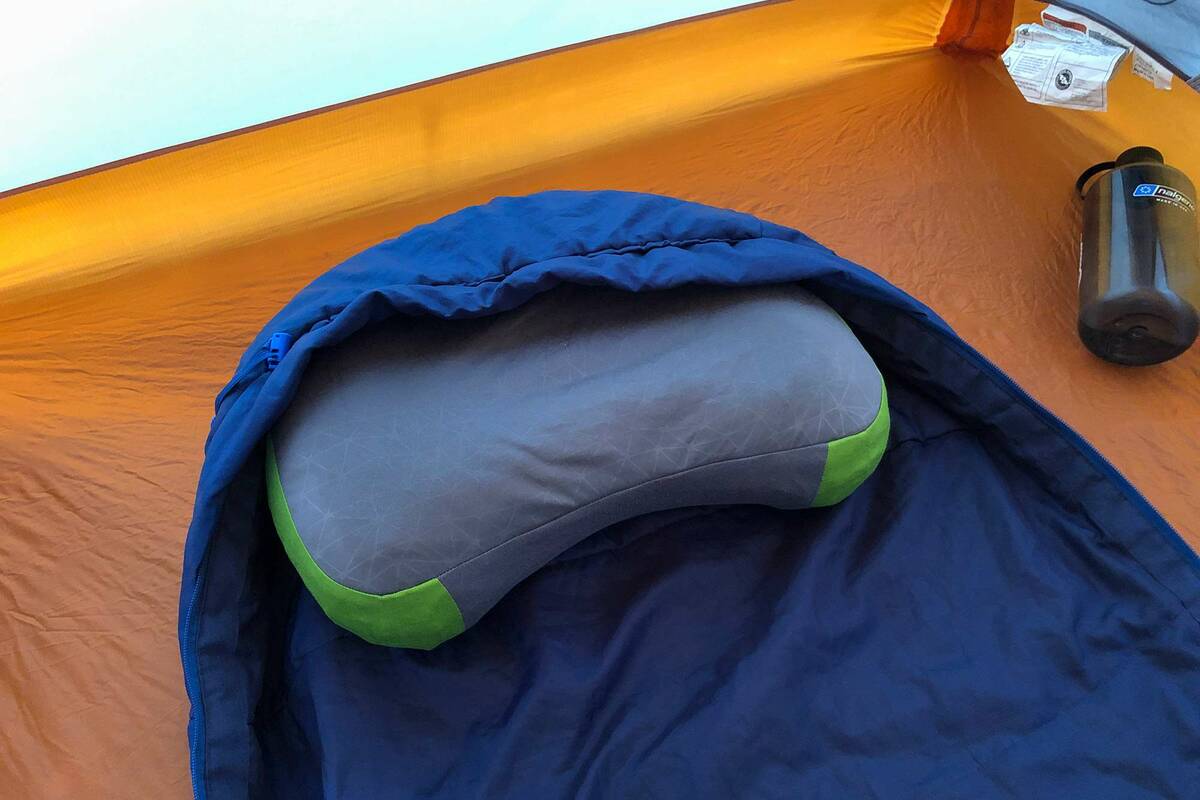
The Best Backpacking Pillows of 2023
- Comparison Table
- Best Backpacking Pillows
Even the most spectacular outdoor getaways can be ruined by an uncomfortable night in a tent. Being unprepared has its consequences, and a night without a proper backpacking pillow may result in a painfully kinked spine. No one wants to see you emerge from your tent with a bent neck like some kind of horror movie monster.
So, how do you avoid crawling out of your backcountry shelter looking like the girl from The Ring? Use a backpacking pillow, of course! We’re giving you the skinny on the best backpacking pillows around. The information below will show you which pillows are best for your sleeping position, the type of cushy insulation they’re filled with, and how easily they will pack away. Backpacking pillows can be ultralight, they can be deluxe, and they can give your neck the much needed support it deserves.
We’ve spent many, many nights in the great outdoors and are happy to use our experiences to put together this Best Backpacking Pillows guide for you. I don’t want to see anymore creepy early morning wendigos walking the trail. Get a proper pillow below!
Backpacking Pillow Comparison Table
The best luxury backpacking pillow.
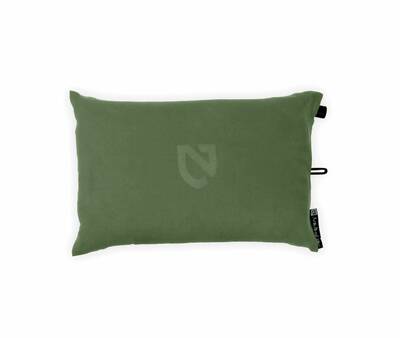
- Weight: 9 oz
- Cost: $39.95
- Best For: Car Camper , Wilderness Backpacker
The NEMO Fillo is a powerhouse of comfort when it comes to your typical backpacking pillow. NEMO utilizes a combination of air and high-grade foam to turn an otherwise airy sleep experience into something that’s more akin to the memory foam pillow you have at home.
The pillow has NEMO’s Twist and Pull Valve, which works well and has a satisfying lock sound to signal the air is in. The model we prefer also has a removable micro-suede exterior, which is comfortable against the face. The air chamber can be blown up to be quite puffy, or much less for a more relaxed (flat) pillow. When combined with the foam this makes the Fillo great for those who don’t want a fully inflated pillow. That said, it’s pretty heavy for a backpacking pillow at nine ounces, and still doesn’t come close to your actual pillow at home. It also doesn’t pack nearly as small as other pillows, if space is your concern.
The Best Ultralight Backpacking Pillow
Sea to summit aeros pillow.
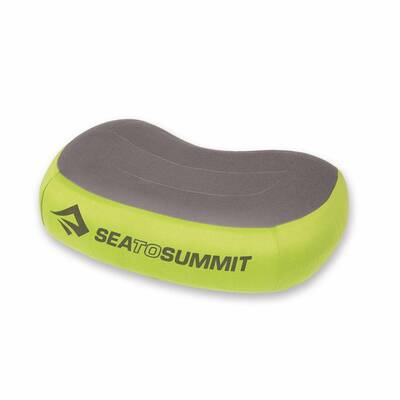
- Weight: 2.8 oz
- Cost: $42.95
- Best For: Ultralight Backpacker
The Sea to Summit Aeros Pillow has become the tiny, ultralight standard of backpacking pillows. It packs to what is often described as “nothing”, which in reality is just a couple inches that can be stuffed anywhere in your pack. It weighs under three ounces as well, and yet uses high-quality 50D polyester fabric and a solid flat valve for easy inflation and deflation. The shape is what we call kidney bean, in that it’s not a full rectangular pillow, and it has a small indent near your neck for solid positioning.
The Aeros Pillow has roughly four inches of height when fully inflated, and isn’t too bouncy. That said, it’s a full air pillow, and won’t be as comfortable when partially inflated because it will be bouncy or feel like it lacks air. If you want one of the lightest backpacking pillows out there, and prefer air over a rolled up jacket, this may be your best bet. Sea to Summit also offers different versions of the Aeros, like the Ultralight and Deluxe, which are lighter and more supportive, respectively.
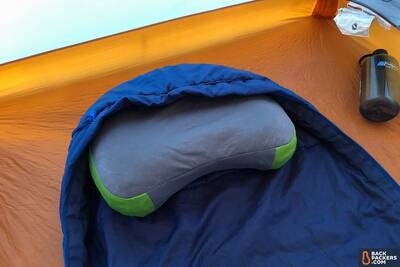
Sea to Summit Aeros Pillow Star Rating
- Adjustability
- Packability
The Sea to Summit Aeros Premium Pillow takes the traditional travel pillow to the next level with plush fabric and an easy-adjust valve for customizable comfort on the trail or anywhere you’ll find a weary traveler.
The Best Backpacking Pillow on a Budget
Therm-a-rest compressible pillow.
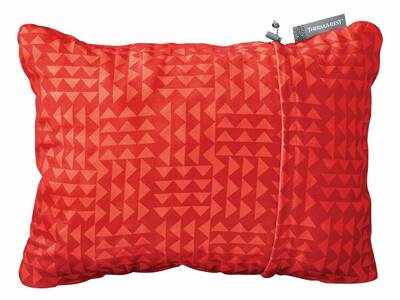
- Weight: 7 oz
- Cost: $24.95
The Therm-a-Rest Compressible Pillow may be the most comfortable on this list if foam support is what you’re into. Unlike the other pillows here the Compressible Pillow uses a lot of foam, and no valve inflation, to create a sleeping surface you can dream upon. The specs listed are for the “small” pillow, which is still decently sized, and competes in terms of height and head-resting space with other pillows on this list. But, because it uses upcycled foam from its pad manufacturing process, the Compressible Pillow is much more comfortable and has almost none of the inflated-feeling that you get from air pillows. The Compressible Pillow is so-named because it can roll and stuff into itself — just crunch it down into the attached flap, then drawstring cinch it tight, and you’ve got a relatively small, fully foam pillow to carry. You can use this packed-up pillow as a lumbar pad or thick headrest, making this the only pillow with a “packed” purpose on this list. All this for a 7-ounce pillow, which contends well with the competition. That said, the big downside is packability — the Compressible Pillow is much larger when packed than any pillow on this list. If foam-based support is what you need, and space isn’t an issue, you can’t go wrong here. Especially for the price. Make sure to get the size you want, as Therm-a-Rest has pillows that range from Small to Extra Large (almost the size of your pillow at home!) (https://www.thermarest.com/compressible-pillow).
The Best Backpacking Pillow for Back Sleepers
Klymit pillow x.

- Weight: 1.95 oz
The Klymit Pillow X’s price, size, and simple design has taken the backpacking market by storm, and many people are popping this in their packs without a second thought. It’s a very basic air pillow with a twist and pull valve, four inches of height, and a sturdy 75D bottom to keep you from popping. The unique design feature (typical of Klymit) is the large X in the middle, which helps to cradle your head. This is best for back sleepers who want their head in one position for the night. The Pillow X has similar design features as the Luxe, but is much smaller and uses only air. It’s also not the most comfortable fabric, especially against your skin, so covering it with a shirt or something is recommended.
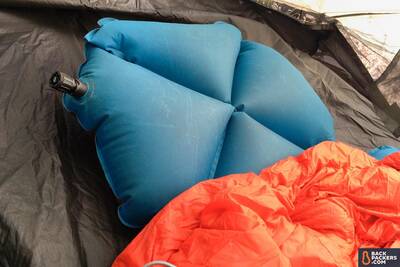
Klymit Pillow X Star Rating
The Klymit X Pillow is an ultralight, highly packable backpacking pillow with one key design feature: an X where your head goes. This keeps your head in place while sleeping, allowing for surprising comfort on your back. It weighs under two ounces, inflates in a couple breaths, and is a no-brainer when backpacking.
The Best Down Backpacking Pillow
Sierra designs dridown pillow.
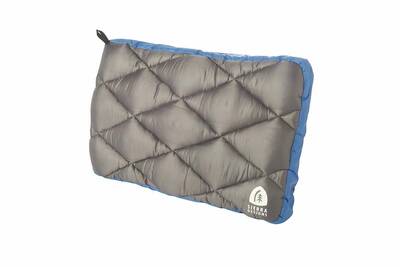
- Weight: 5 oz
- Cost: $29.95
The Sierra Designs DriDown Pillow is unique in a couple of ways and differentiates itself from others on this list. First, the DriDown Pillow actually has two separate pillow components — a quilted down sleeve that has comfort, warmth, and some height to it all by itself, and then a synthetic-fill pillow insert that goes in the topper. You can combine these for a full pillow experience, or leave the insert at home and stuff the quilted topper with a jacket on the trail, thereby saving space and making a piece of gear multipurpose. The second major differentiated factor is the down. There are lots of pillows that use down, but we think the Sierra Designs DriDown Pillow is the best of these. The down is used only in the quilted topper and provides a fine layer of comfort and warmth right where you put your face. The pillow has a nice and even shape, does not use air for height, and packs up quite small. Its main downsides are thicknesses — because of the synthetic fill and down feathers it compresses quite a bit, so is best for those who like a very flat pillow (stomach sleepers!). The insert, overall, could be better, or made of down, or foam, which would make it a must-have. Currently, the DriDown pillow actually makes more sense when only taking the quilted topper and stuffing with a jacket, but you then shouldn’t be paying roughly $30 for a quilted stuff sack. All that said, this is a unique pillow with multiple options, an included stuff sack, and that sweet down sleep experience. (https://sierradesigns.com/dridown-pillow-650-dridown/).
The Best of the Rest
Exped mega pillow.
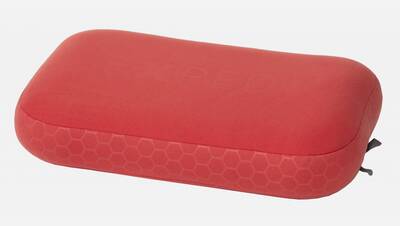
- Weight: 6 oz
- Cost: $49.00
The Exped Mega Pillow takes after its name — it’s huge, provides lots of cushion, and is more about comfort than anything. The Mega Pillow also takes after the semi-legendary MegaMat, Exped’s outstanding 3D-walled camping mattress (LINK), and its goal is maximum comfort and size. It also pairs well with the MegaMat pad, but that’s really for car camping, not backpacking. That said, for a backpacking pillow the Mega Pillow does work — it comes in at 6 ounces, which is not light, but not exorbitantly heavy for true comfort seekers. It has the second-largest footprint and height after the Klymit Luxe, but has an added dose of comfort due to the fleece synthetic fill in the pillow itself. This creates a soft, warm surface for your head — who hasn’t curled your fleece jacket into a ball to sleep on? The Mega Pillow has a two-way flat valve that allows fine-tuning of air pressure, and the top is a comfortable material to rest your head on. The main downside is packed size, which, like the Therm-a-Rest Compressible Pillow, is quite large. Fleece just doesn’t compress well. If comfort is your main component and you want a large pillow that works on backpacking and camping trips, Exped’s Mega Pillow is certainly worth a look. (http://www.exped.com/usa/en/mega-pillow-1).
Exped Air Pillow

- Weight: 2.5 oz
- Best For: Ultralight Backpacker , Wilderness Backpacker
The Exped Air Pillow utilizes a thoroughly engineered design from the Swiss experts on outdoor equipment to create a fairly large, very light air pillow perfect for backpacking. Exped’s Air Pillow weighs just 2.5 ounces and packs up tiny, yet has an impressive 15 x 10-inch footprint when fully inflated, with just over 4 inches of height. This creates a large surface to rest your head on — larger than comparable air pads, so if you want a lot of pillow but little weight, this is a good bet. The Air Pillow has a small indent for side sleepers and is higher on one side than the other, allowing you to find the perfect adjustment level for your needs. Finally, Exped put two baffle depressions in the middle, which lock in your head to keep from sliding at night. This couples with separate inflate and deflate flat valves — the best in the industry. The inflate flat valve can be depressed to let out a little air, too. Overall the Exped Air Pillow is comfortable, light, and quite large. You can get it in the Large version, or you can go the Ultralight or Lite route, which utilize thinner materials and slightly smaller design to save a bit of weight, but we feel this thing is already quite light. (http://www.exped.com/usa/en/air-pillow-m).
Klymit Luxe Pillow
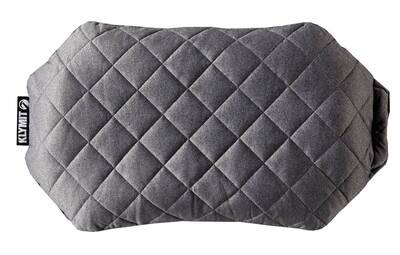
- Weight: 6.4 oz
The Klymit Luxe Pillow will surprise you with its size. The weight makes it a backpacking pillow (just over 6 ounces), but the impressive 22-inch width gives it a true-pillow ability, allowing you to roll your head side to side like you’re on a real bed. The Luxe also uses a removable and washable quilted soft fabric sleeve, which provides a soft surface to sleep on. The twist and pull valve is tucked under the sleeve, a nice touch that keeps it out of the way, and you can adjust the inflation level to up to 5 and a half inches of height, quite a bit more than other pillows on this list. Finally, it uses Klymit’s iconic X design in the center, which cradles and rolls your heads towards the center of the X, giving back-sleepers an upper hand. The Klymit Luxe Pillow is an excellent choice for comfort-oriented sleepers, and won’t totally kill your pack weight. (https://www.klymit.com/luxe-pillow.html).
Cocoon Air Core Ultralight Travel Pillow
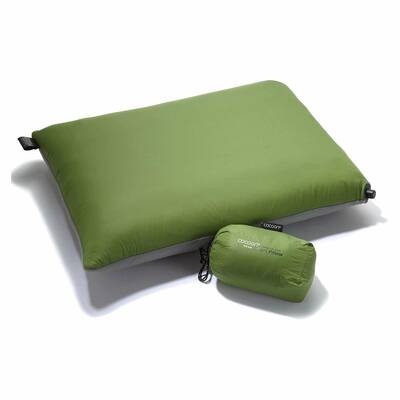
- Weight: 6.7 oz
- Cost: $32.95
- Best For: Car Camper , Urban Hiker , Wilderness Backpacker
Cocoon is well-known as a travel accessories brand, and they have a large line of camping and travel pillows. The Air Core Ultralight pillow is the most appropriate for backpacking, and is a good mix of air and insulation to create a warm, comfy sleeping experience. It’s in the mid-range of weight, coming in at under 7 ounces, but has a little more size than the lighter pillows. The main difference is the synthetic insulation inside the Air Core Ultralight pillow, which acts like foam to create a combination of air and material, allowing you a more substantial surface to rest your head on. The Air Core Ultra also has a warm microfiber side to sleep on during cold nights, and a cooling micro-ripstop nylon side for warm nights. You can remove the cover for washing and repairs, and the twist valve doesn’t pull, which makes it easier to operate, and allows you to adjust while laying on it. Overall Cocoon is actually quite good at making comfort accessories for traveling, and the Air Core Ultralight travel pillow is a good mix of everything, retaining decent comfort in a small package. (https://www.cocoon.at/products/index.php/p/kissen_en).
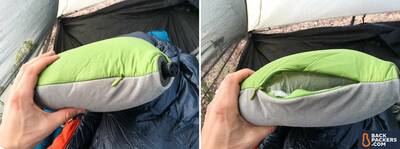
Cocoon Pillow Air Core Ultralight Star Rating
The Cocoon Air-Core Pillow in the ultralight variety strikes an excellent balance between packability, weight, and sleep comfort. It has a synthetic layer that’s removable and washable, and, depending on the size you pick, weighs well under 5 ounces.
Trekology Pillow Ultralight Inflating
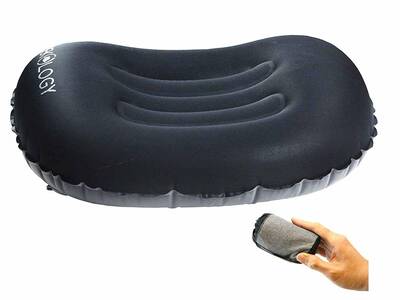
- Cost: $15.47
The Trekology Pillow is one of those Amazon only products that has taken a top performing pillow (the Sea to Summit Aeros) and copied it as closely as possible, with a few design tweaks, and offers it for much less money. We put it on this list, despite having less specs than we prefer, because the price savings is pretty enormous, especially for a small item like a pillow. The Trekology pillow, like the Aeros, weighs 2.8 ounces, packs up incredibly small, has a rough Kidney shape, and utilizes a flat valve, though the valve isn’t as robust. The Trekology Pillow has a different ridge and dip system on top to keep you from slipping, and is a little larger overall. It has a one year warranty, and there are reports of individual units not holding air, but that’s to be expected with a product like this. If you aren’t concerned about name brand or a lifetime of backpacking pillow functionality, the Trekology may be the cheap and easy choice for your adventures. (https://www.amazon.com/Trekology-Ultralight-Inflating-Camping-Pillows/dp/B07BWFJVPH).
Your Pillow
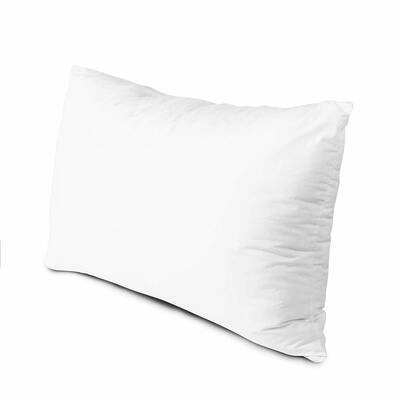
- Weight: 16+ oz
We like to be practical, and it would be impractical to leave out a common and easy choice for backpacking pillows. While taking your own pillow is not the lightest or most packable option, it certainly works. Most backpacks allow you to strap a last-minute item between the brain and the body of the pack, ostensibly the perfect place for a pillow. If you value sleep and don’t mind the extra weight, we don’t really see a legitimate reason why bringing a pillow is a terrible idea, so consider it. It’s cheaper than buying the above, and it might be more comfortable, too. That said, if you want to skimp entirely, you can just ball up some jackets/clothes and use that as a pillow.
Backpacking Pillows vs Camping Pillows
The primary differences between backpacking and camping pillows are weight and packability.
A good camping pillow can offer the same luxurious comfort as your pillows at home. Heck, your favorite camping pillow may just be your nightly bedroom pillow. When car camping, you need not worry so much about how bulky your pillow is — you can cram that baby into any nook or cranny in your trunk, even if it’s full of camping chairs, propane canisters, and overloaded coolers.
Backpacking pillows, on the other hand, need to fit snugly into your backpack — along with everything else you need for a night (or many) in the wilderness. The best backpacking pillows weigh about as much as a full bag of chips and pack down nearly as well as an empty bag of chips, however, backpacking pillows are significantly more comfortable to rest your head on for extended periods of time than said bag of chips.
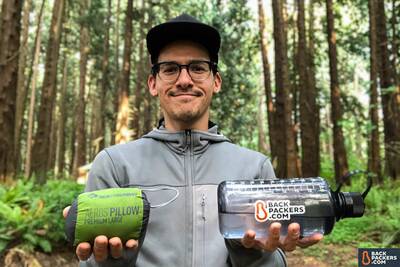
The Sea to Summit Aeros Pillow, even in a size Large, packs down quite small.
The less weight on your back, the more you can snack! No wait, that’s not the saying — I must have chips on the brain. What’s the backpacker’s mantra again? Oh, yes. Less weight equals more fun. That’s right!
But seriously, your backpacking pillow should be lightweight and packable enough so as to be nearly unnoticeable inside of your backpack while you’re hiking. A good backpacking pillow is also versatile. If you pack it away in an easily accessible location it can be a comfortable seat or snack table on short rest breaks. Who says pillows are only for sleeping?
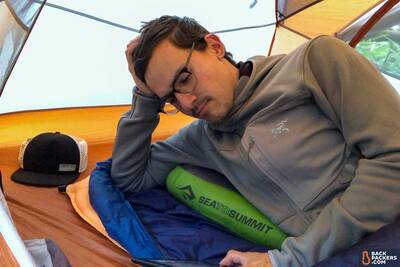
Backpacking pillows: a versatile side-rest, seat, or makeshift table.
Sleeping Positions and Your Pillow
It’s important to consider the way you sleep before purchasing a backpacking pillow. These aren’t your standard one-size-fits-all fluffy rectangles from Target. Backpacking pillows have highly-refined designs which cut down on size and weight, and, as a result, many are engineered for a specific sleep position — two at most.
Those who religiously sleep on their sides should look at sleeping solutions like the Exped Air Pillow. This backpacking pillow has an indent for your shoulder, and it sleeps higher on one side than the other to help side sleepers find the perfect sleeping position. The NEMO Fillo and Therm-a-Rest Compressible Pillows are also good options for side sleepers, as they use foam, which compresses nicely to fit in between the space between your neck, jawline, and the ground.
Back sleepers will find the Klymit Pillow X to be a comfortable ultralight option. The intentional “X” creases of the pillow keep your head centered while the surrounding cushion raises to support your head. Side sleepers would end up with a crooked nose come morning time as a result of this pillow’s shape. The Sea to Summit Aeros works well for back sleepers, too.

X marks the spot in the Klymit X Pillow, providing specific position-locking support for back sleepers.
Pro Tip : Personally, I’ve found that I’m a side sleeper at home, but I sleep on my back when lying on a backpacking pad, and so the Klymit Inertia O Zone sleeping pad with attached X Pillow is my go-to backpacking set up. Do you sleep differently on the trail than you do at home? Best find out!
Backpacking Pillows Types
There are a number of backpacking pillow insulation and interior constructions to choose from. Here’s a breakdown of the various materials inside a backpacking pillow and what you can expect from them.
Air filled backpacking pillows are inflated via your own breath through flat or twist-and-pull valves. Air pillows, like the Sea to Summit Aeros Pillow, are the most lightweight and most packable backpacking pillows on our list as they’re full of nothing but your very own hot air. Excessive inflation can make for a bouncy pillow, though you can adjust the pillow inflation to the exact amount you prefer. Once you’re done catching Zs you can roll the pillow into a little taquito that will pack away into literally any crevice.
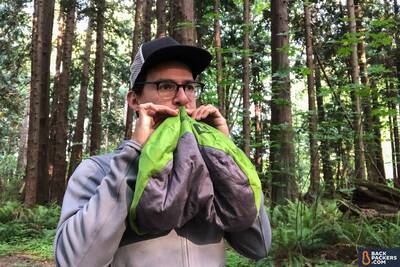
Air is the key ingredient for many backpacking pillows. Add the right amount and you’ll sleep well!
Foam pillows provide firm support and cradle your face with specifically engineered material, much like a memory foam mattress, rather than air pressure. No huffing and puffing is required, and the comfort is typically more like a real pillow at home. Then again, foam pillows like the Therm-a-Rest Compressible Pillow don’t pack down nearly as small as air pillows and weigh quite a bit more. Many people prefer the supportive cushion of foam pillows and consider their ample comfort to outweigh their bulk.
The best of both worlds (or worst, depending on your needs), can be found in a combined Air + Foam pillow , such as in the NEMO Fillo. This is the same tech used in most self-inflating sleeping pads. The interior foam fluffs up once it has the chance to decompress, pulling in outside air through a valve as it does, and then you can add in a few breaths to dial in the perfect amount of firmness. We think this makes for an ideal combo (as do many people), but your preferences may differ.
Down and synthetic fill pillows combine comforting physical material like foam pillows, along with some insulation properties, but also have the lighter weight of air pillows. The downside (ha) is that these materials compress while you sleep. This won’t be an issue if you prefer flat pillows, but if thick, cushiony support is your game you’ll have to look elsewhere. That compression does have its benefits, however, such as when you need to stuff the pillow into your pack. The main down pillow we recommend is the Sierra Designs DriDown pillow, though it does suffer from the “flatness” mentioned above.
How to Buy Backpacking Pillows
Understanding the different types of backpacking pillows, along with their costs and benefits, goes a long way to finding your perfect pillow. We’ve gone over much of what the different backpacking pillows have to offer, and now let’s discuss a few key considerations to think over before choosing your next pillow.
Consider Your Other Sleep Gear
Your outdoor sleeping setup will greatly affect your backpacking pillow needs. If you’re like the majority of backpackers out there who sleep in a tent on top of an inflated sleeping pad, most pillows will work for you.
Depending on how plush your sleeping pad is, you may need to consider how thick your backpacking pillow will be, or get an air pillow that can be adjusted on the fly. If your body sinks into your luxuriously-soft sleeping pad, you can rest assured that a thick pillow will not, and so you may find your head held too high for comfort.
Consider the fabric that your face will be rest on as well. A silky fleece will feel great against your rosy cheeks while direct contact with rubbery plastic will make your face sweat. Gross. Though, if you use a sleeping bag with a hood, you’ll find that stickier pillow fabrics will help to keep your head from slipping off in the middle of the night. Tossing and turning with nylon on fleece will cause you to shoot your pillow into your tent wall like a slippery bar of wet soap.
Lastly, if you tarp or cowboy camp, thin, ultralight materials may not be your best bet. Look for a backpacking pillow with thicker walls, like the Klymit Luxe, that can withstand brushing up against a renegade twig.
Buying Backpacking Pillows Online vs in Store
Unless you’re completely new to the outdoor gear world, there’s nothing surprising to be found in a backpacking pillow. The exterior fabrics and interior insulation materials are all familiar to anyone who has browsed the racks at REI before.
That said, if you really want to check out backpacking pillows in person, go for it. You’ll likely see a few on display at your local gear store and you may be able to unpackage some, with permission from an employee, to experience first hand.
Most shoppers, though, will be able to choose a great backpacking pillow while browsing online. The specs and materials are all laid out in orderly fashion on every gear site and online store. Using the information we’ve provided in this article, and scrutinizing the fantastic backpacking pillows showcased on our list, will give you a head start on the hunt.
Used vs New Backpacking Pillows
Normally, I have no problem with buying used outdoor gear. I’ve perused my fair share of Craigslist ads and REI Garage Sales, but for a backpacking pillow I’d prefer to buy brand new.
As far as gear goes, new backpacking pillows aren’t all that expensive. I’d rather save face (ha, again) and get a new pillow that hasn’t been inundated with someone else’s sweat, oils, and moisturizing lotion.
That’s just my opinion and you might not care about old face grime so much. If that’s the case, go ahead and keep your eye out for someone else’s “like new” backpacking pillow.
Then there’s the fact that most backpacking pillows can be “popped”, just like a sleeping pad, which is something you’d have to test at length before buying used.
Keep in mind, though, that if you’re looking to save a few bucks, why not carry your home pillow or ball up a bunch of your hiking clothes into an on-the-go pillow? I’ll throw my down jacket into a bug head net as a last-minute alternative — works great for a night or two on the trail! And you can always take your pillow from home — just sandwich it between your backpack’s top lid and main chute. Yes, the extra weight will suck, but a good night’s rest is worth it.
Backpacking Pillows are like Electric Cars
They keep improving year after year.
Like their brother-from-another-mother sleeping pad companions, backpacking pillows are consistently getting more refined as outdoor tech improves. Lighter, more comfortable materials are paired with the latest innovative insulations in each new rendition. New valves, baffle designs, and synthetic materials are just a few of the advancements to look forward to.
And yet they’re still a fairly inexpensive product that holds tremendous value to anyone who covets a good night’s sleep. Grab one now, but keep your eyes peeled for more advanced backpacking pillows in the years ahead.
Backpackers.com Affiliate Policy : This guide contains affiliate links, which help fund our website. When you click on the links to purchase the gear we get a commission, and this goes a long way to creating guides, gear reviews, and other excellent content.
Arthur McMahon
Arthur loves to walk. It's as simple as that. He believes walking is the best way to experience the world. Thru-hiking the Pacific Crest Trail was his first backpacking foray, and he hasn't stopped since. Follow his adventures and stories on Instagram .
Leave a Reply Cancel reply
Your email address will not be published. Required fields are marked *
Welcome to Backpackers.com. We are a small, independent team writing gear reviews and useful outdoor guides.
Our mission is to empower all walks of life to be ambassadors of the outdoors. Read our About page for more information, and check out our gear reviews , trip reports , and outdoor guides .
Best Backpacking Sleeping Bags: Trialed & Tested [2024 Edition]
We've field-tested numerous brands and models to find the best sleeping bag for backpacking - ranging from lightweight options for summer adventures to warm down cocoons designed for chilly weather excursions.
Every backpacker knows that a good night’s sleep is crucial to recharge after a day on the trail, but choosing a sleeping bag that offers comfort, warmth, and portability can be a challenge. Faced with varying temperatures, unpredictable weather, and the need to keep the backpack light, finding that perfect balance of features often seems like an elusive task.
Nobody wants to be stuck shivering through a cold night or lugging around an overly bulky bag. That’s why we’ve dedicated this article to helping you find the best backpacking sleeping bag, ensuring restful nights and delightful mornings, preparing you for each day’s journey ahead.
Whether you’re looking for a summer sleeping bag or the warmest sleeping bag your money can buy, we’ll review 11 of the top backpacking sleeping bags of 2024, explain why the Feathered Friends Hummingbird 30 is our pick for best overall backpacking sleeping bag, and explain what features to consider when buying sleeping bags for backpacking.

Table of Contents
Feathered Friends Hummingbird 20
Enlightened equipment revelation quilt 10°, kelty cosmic down 20°, nemo disco 15°, feathered friends swallow ul 30, mountain hardwear bishop pass 15, big agnes sentinel 30 double, feathered friends tanager 20 cfl, sea to summit spark spii 28, marmot trestles elite eco 20, the north face eco trail synthetic 20, backpacking & camping sleeping bag comparison table, temperature rating (warmth-to-weight ratio), down vs. synthetic insulation, weight and packed size, durability and shell denier (d), women’s sleeping bags, sleeping bags vs. backpacking quilts, at a glance: sleeping bag recommendations.
- Best Overall: Feathered Friends Hummingbird 20F “A backpacker favorite, the Feathered Friends Hummingbird 20 is lightweight, packable, and warm.”
- Best Backpacking Quilt: Enlightened Equipment Revelation Quilt 10° “If you’re an active sleeper or want a versatile sleep system, the Enlightenment Equipment Revelation quilt is worth considering.”
- Best Budget Down: Kelty Cosmic Down 20° “If your goal is comfort and warmth on a budget then the Kelty Cosmic Down 20 might be the perfect choice for you.”
- Best Budget Synthetic: Marmot Trestles 15 “If you’re looking for an affordable backpacking sleeping bag, the Marmot Trestles Elite Eco is a great choice, providing great warmth at a reasonable price.”
- Best Bag for Side Sleepers: NEMO Disco 15° “Active and side sleepers who want a more spacious sleeping bag should take a long hard look at the NEMO Disco 15, which offers more room than any other lightweight choice on our list.”
- Recommended: Feathered Friends Swallow UL30 “An excellently designed hood and zipper combined with a great warmth-to-weight ratio make the Swallow a joy to sleep in.”
- Best Value: Mountain Hardwear Bishop Pass 15 “The Mountain Hardwear Bishop Pass 15 has a good warmth-to-weight ratio and is a reasonably priced 3-season bag.”
- Best Double Sleeping Bag: Big Agnes Sentinel 30 Double “Want a lightweight sleeping bag that can keep both you and your significant other cozy on the trail? Our top pick is the Big Agnes Sentinel Double”
- Best Warmth-to-Weight Ratio: Feathered Friends Tanager 20 CFL “The Feathered Friends Tanager 20 CFL is one of the leading ultralight sleeping bags because of its minimalist lightweight design and its top-of-the-field warmth-to-weight ratio.”
- Best Ultralight Sleeping Bag: Sea to Summit Spark SpIl “Despite strong competition, the lightest bag on our list, the Sea to Summit Spark Spll is our top ultralight pick.”
- Most Durable: The North Face Eco Trail Synthetic 20 “If you’re looking for a durable synthetic bag that will see you through occasional backpacking as well as car camping trips, then we recommend the TNF Eco Trail 20.”
Which Model Is The Best Backpacking Sleeping Bag?
Field-tested, here are our picks for the best sleeping bags for backpacking in the list below.
- Feathered Friends Swallow 30
- Sea to Summit Spark SpII 28
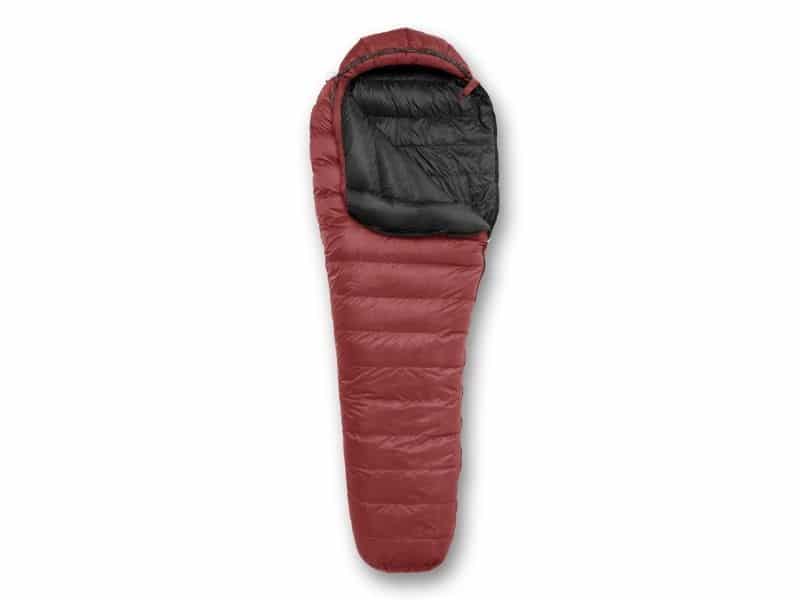
20℉ Comfort Limit (~12℉ Lower Limit) temperature rating ⸱ 950+ fill-power 14 oz fill weight goose down ⸱ 58” / 52” / 38” shoulder/waist/feet measurements ⸱ 1 lb 8 oz / 9 liter packed ⸱ Pertex® Endurance® UL shell
The Hummingbird is lightweight, packable, and uses high-end down to deliver a super warm and comfortable bag. A perennial favorite among trailgoers, it’s a worthy winner of our best backpacking sleeping bag award.
At 950+ fp the Hummingbird uses highest quality down available. The use of premium fill-down results in an ultralight mummy bag that weighs 1 lb 8 oz and packs down to just 9 liters. It also makes it as comfortable and cozy as sleeping bags come.
The temperature rating of 20℉ (lower limit) combined with low weight marks this model out as one of the best warmth-to-weight ratios on our list. It also makes it great for cold sleepers or those who plan on backpacking or camping in the shoulder seasons.
The high warmth rating is tied to the slender profile of the Hummingbirds shape, which is both a strength and weakness. The 58”/52” shoulder/waist measurement is one of the narrowest we came across in testing, so larger folks and active or side sleepers may feel a little claustrophobic. On the plus side, this narrow profile improves thermal efficiency on cold nights.
- Premium quality down fill
- Lightweight & packable
- Cozy and warm bag
- Very narrow around the shoulders
- Availability
Bottom-Line: The Feathered Friends Hummingbird 20 is a backpacker favorite for all the right reasons – it’s lightweight, packable, versatile, and warm.
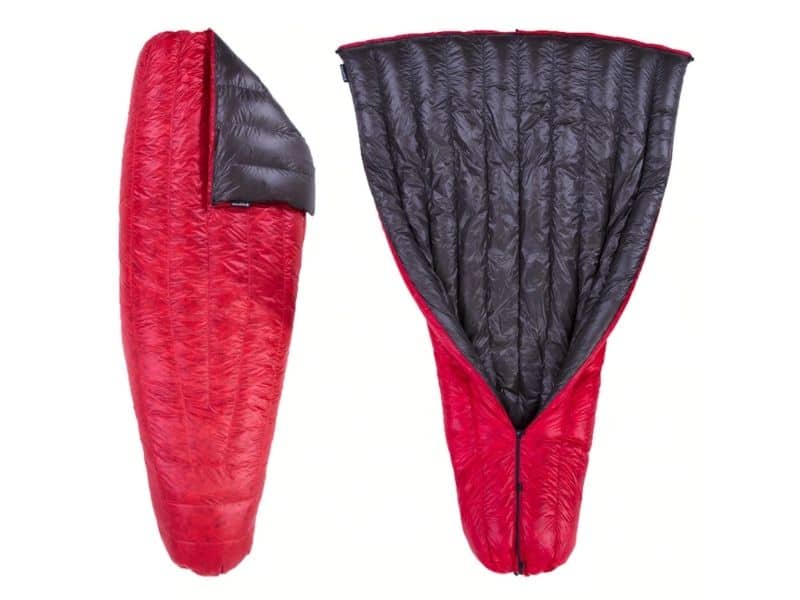
10℉ Lower Limit (~35℉ Comfort Limit) ⸱ 850 fill-power 17.87 oz fill weight goose down ⸱ Weight: 1 lb 14 oz ⸱ 10-denier shell & liner
The Enlightened Equipment Revelation is a versatile, handcrafted and great value quilt that’s our top pick for warmer-weather backpacking or backpackers who like a little more legroom.
The Revelation is available in six different temperatures ratings, ranging from 0℉ up to 50℉, so it’s easy to find one to suit the climate you’ll be camping in. While the Revelation can be cinched closed around the footbox area it will be draughtier than a traditional mummy bag, meaning that the comfort rating is closer to 15-25℉ higher than the Lower Limit (dependent on whether you’re a hot or cold sleeper).
The Revelation is filled with 850 FP goose down and uses 10D shell and inner liner fabrics to keep you toasty while keeping the weight down. This, in combination with the lack of full zip, means the Revelation weighs just 1 lb 14 oz, giving it a great warmth-to-weight ratio.
The main benefits of this quilt are versatility and the roomier fit. Having that full-length zipper allows you to use it as either a bag or duvet while the baggier sizing makes it more suitable for side and restless sleepers.
The off-the-shelf version of the Revelation is available in four sizes, but if you’re willing to pay a little more (and wait a little longer) you can order a bespoke model, choosing your preferred down type, temperature rating, length, width, and colors. You also have the option to add a draft collar.
The biggest downsides to the Revelation are that there’s no hood and a bigger gap between the Lower Limit and the Comfort Limit. If you’re planning on camping outside of summer, therefore, it’s best combined with a sleeping bag liner and/or a high R-value sleeping pad.
*All specs listed are for the 10℉ version of the quilt.
- Very versatile
- Great value for money
- Highly customizable to your needs
- Excellent US craftsmanship
- Care needed with the thin materials
- Not warm enough above the treeline or for winter use
- Custom orders can take some time
Bottom-Line: Active sleepers or those who want a more versatile sleep system will love the lightweight and comfortable Enlightenment Equipment Revelation quilt.

21℉ Lower Limit (32℉ Comfort Limit) ⸱ 550 fill-power 16.37 oz fill weight goose down ⸱ 62” / 58” shoulder/waist measurements ⸱ 2 lb 13.5 oz / 10.7 liter packed ⸱ 20-denier ripstop nylon shell
The Kelty Cosmic Down 20℉ is one of the cheapest down sleeping bags available, but don’t let the low price tag fool you. This is still a high-quality mummy bag and a worth winner of our best budget backpacking sleeping bag award.
The Cosmic Down use 16.37 ounces of 550FP goose down stuffed into trapezoidal baffles, creating a bag with a Lower Limit of 21℉ and a Comfort Limit of 32℉ (it’s also available in a 0℉ and a 40℉ version). That 32℉ limit should easily see you through all but the chilliest of nights in the shoulder season in comfort.
While warm and cheap, there’s a trade-off with weight and packed size. Weighing 2 lb 13.5 oz., and packing down to 10.7L, it’s one of the heaviest and bulkiest down bags on our list. However, it’s significantly smaller than comparable synthetic bags such as the Marmot Trestles 15.
The CD is available in three sizes (short, regular, and long), with the regular offering 62” around the shoulders and 58” around the waist. It is also available in a women’s sleeping bag version .
If you need to knock off a little weight, and your budget can stretch a little further then the Mountain Hardwear Bishop Pass is a slightly more expensive option but shaves nearly a pound off the total weight.
- Amazing price for a down bag
- Zippered stash pocket
- Tough shell fabric
- Heavy for its temperature rating
- Cheaper feel compared to the premium competitors
Bottom-Line: If budget is a concern, or you are a novice backpacker, then the Kelty Cosmic Down 20 is a great pick.

15℉ Lower Limit (~25℉ Comfort Limit) ⸱ 650 fill-power 22 oz fill weight goose down ⸱ 64” / 59” / 62” shoulder/waist/foot measurements ⸱ 2 lb 11 oz / 12.5 liter packed ⸱ 30D/40D Ripstop nylon w/DWR
The NEMO Disco is an excellent choice of sleeping bag for backpackers who like a little more room, or are cold sleepers or plan on backpacking in cooler climes.
The spoon-shape design gives the Disco significantly more room around the waist and feet compared to most sleeping bags. Measurments of 64”/59”/62” (shoulder/waist/feet) make it by the far the roomiest model on our list. This makes the NEMO Disco a good option for active or side sleepers who feel uncomfortable in mummy bags.
The Disco comes in both mens and women’s versions and is rated to 15℉ lower limit ( 30℉ available ). While warm, our testers were particularly enthusiastic about the Disco’s temperature regulation. This comes courtesy of the bag’s proprietary Thermo Gill™ vents, which allow you to release body heat without letting cold drafts in.
The Disco also other technical features that just make it stand out. This includes a DWR footbox, a pillow sleeve in the hood, and a Blanket Fold™ draft collar that lets you feel nicely “tucked in”.
At 2 lbs 11 ounces overall, and with a stuff sack size of 12.5L, this is a hefty and bulky down bag. Nevertheless, it’s a winner if comfort and warmth are your main priorities.
- Extremely roomy and comfortable
- With 30/40D materials more durable than most bags
- Thermo Gills are a very cool (get it?) design feature
- Built-in pillow pocket
- Heavy and bulky for a down sleeping bag
Bottom-Line: Active and side sleepers who want more room a long hard look at the NEMO Disco 15, the most versatile sleeping bag on our list.
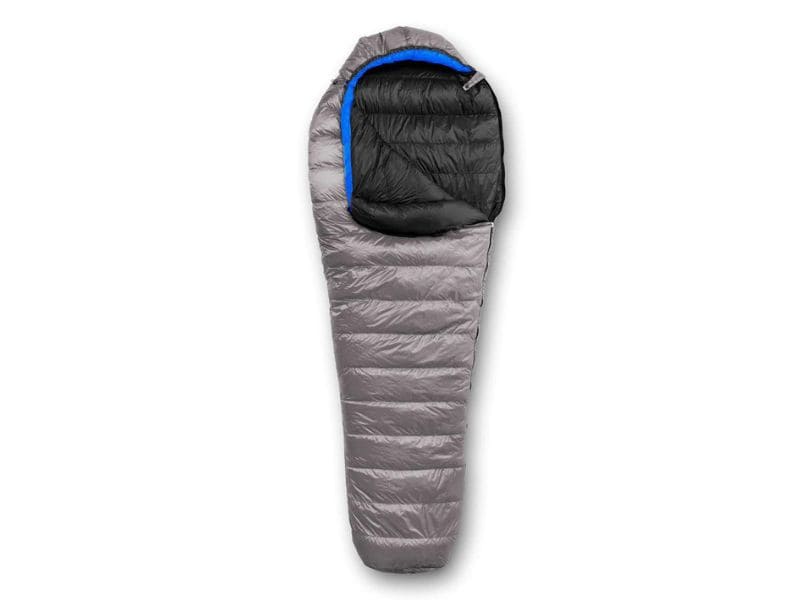
20℉ Comfort temperature rating ⸱ 950+ fill-power 13.6 oz fill weight goose down ⸱ 60” / 56” / 38” shoulder/waist/feet measurements ⸱ 1 lb 9 oz / 8-liter packed size ⸱ Pertex® Endurance® UL
The Feathered Friends Swallow 30 sleeping bag is a perennial favorite among trailgoers owing to its well-thought-out features, toasty insulation, and packability.
The Swallow’s 950+ fill power makes it one of the highest-quality bags we tested. Our testers were amazed by (and in love with!) the amount of loft and its excellent warmth-to-weight ratio. At 1 lb 9 oz., it’s a little heavier than other 30-degree bags we tested, but those few ounces are accounted for by a wider fit, tough shell, and a comfortable lining – all well worth having.
The features in this bag also impressed in the field, particularly the fuss-free zipper and well-designed hood. Less impressive is the lack of a draft collar, but this wasn’t a dealbreaker.
The Swallow is a little heavier than the Hummingbird, but it’s also more spacious, measuring 60″ at the shoulders and 56″ at the hips (compared to 56″/52″). This makes it a great option if you’re a restless sleeper, side sleeper, or just prefer a little legroom.
- Lightweight and packable
- Cozy and warm sleeping bag
- Pricey for a 30-degree bag
Bottom-Line: Lightweight, packable, and warm – the ideal summer backpacking sleeping bag.
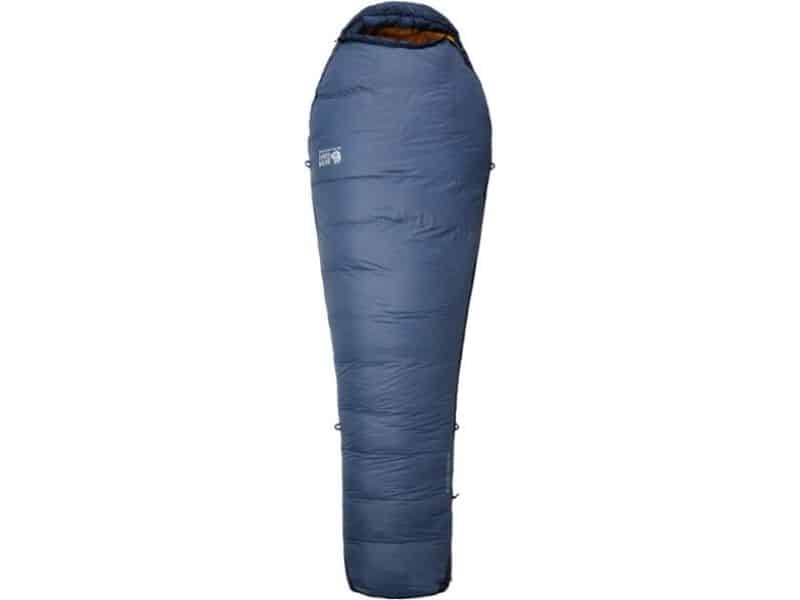
15℉ Lower Limit (~25℉ Comfort Limit) temperature ratings ⸱ 650 FP goose down ⸱ 1 lb 12.6 oz / 9.6 liter packed ⸱ 20D Ripstop Nylon with DWR
The Mountain Hardwear Bishop Pass 15 is a great value buy if your budget can’t stretch to a higher-end premium bag.
While weighing 2 lbs 5.4 oz, the Bishop Pass 15’s lower temp rating (15℉)makes it more versatile and suitable for summer, spring, and fall nights. Our testers mostly agreed that having a quiver-of-one bag was a ‘pro’ (it saves you buying another for other seasons), but only if you do some of your backpacking in colder climates or outside of the summer months.
The other downsides noted by our testers were a trimmer profile around the hips, which may be a little too tight for more active sleepers, and the 12.25-liter packed size. However, bags with this temp rating often cost significantly more, so it’s well worth a punt if you’re a colder sleeper and are happy carrying an extra few ounces.
- Great low weight
- Great price
- Narrow dimensions around the hips
- Average insulation and fabrics
- Basic design
Bottom-Line: The Mountain Hardwear Bishop Pass 15 is a solid but basic 3-season bag with a reasonable warmth-to-weight ratio at a brilliant price.

30℉ Lower Limit (~45℉ Comfort Limit) ⸱ 650 fp 20 oz fill weight goose down ⸱ Weight: 1 lb 12.6 oz / 9.6 liter packed ⸱ 105 / 105 / 84 shoulders/waist/feet measurements ⸱ 20D Ripstop Polyester Shell
The Big Agnes Sentinel 30 DoubleOne wins our testers’ vote as the best sleeping bag for couples courtest of its affordable pricing, roominess, and high-quality build.
This 105” doublewide bag is filled with 20 ounces of 650 fill DownTek™ goose down and is rated to 30℉(lower limit). This makes it good for most summer adventures. The Sentinel has a loose fit, so it’s susceptible to cold air creeping in and, therefore, runs colder than the lower limit – worth bearing in mind when buying.
The Sentinel has several interesting features such as a pillow sleeves to stop your pillows from wandering mid-slumber and an internally cinched hood drawcord that ensures you’re not groping around in the cold. It also has a stretchy sleeping pad sleeve and pad coupler that allows you to attach your pads easily.
The drawbacks with the Sentinel are common to all doublewide bags — packed size, weight and warmth. Weighing a hefty 3 lb 8 oz and with a packed storage sack size of 20.9L, the Sentinel is going to take up a lot of room in your backpack.
- All the spaciousness you’d expect
- Versatility
- Not the warmest bag
- Bulky and heavy
Bottom-Line: If you are on the hunt for a double bag for future backpacking trips with your significant other, then the Big Agnes Sentinel Double is our top pick.
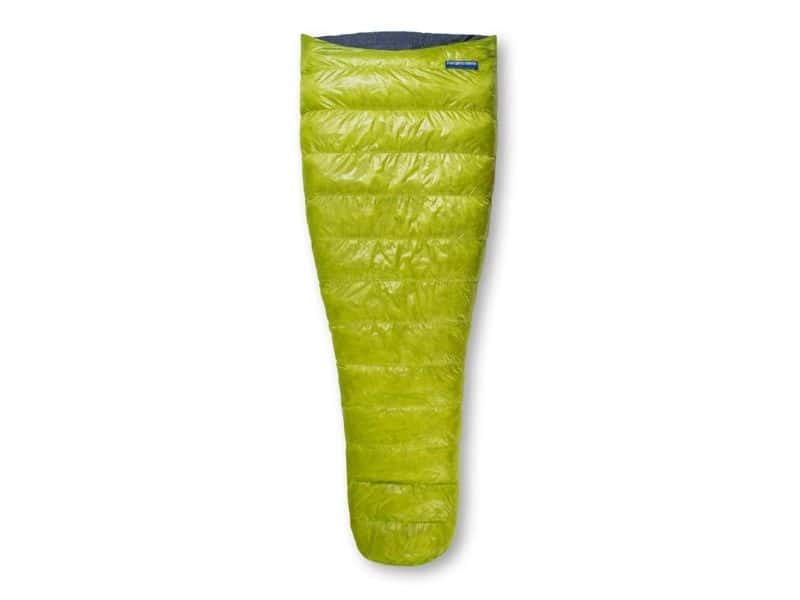
20℉ Lower Limit (~30℉ Comfort Limit) temperature ratings ⸱ 950+ FP 12.6 oz fill weight goose down ⸱ 62″ / 52″ / 38″ shoulder/waist/feet measurements ⸱ Weight: 1 lb 4.6 oz ⸱ Pertex® Quantum® 7D
The Feathered Friends Tanager 20 sleeping bag is one of the best ultralight sleeping bags on the market. It’s simple, light as a feather, and amazingly warm for the weight.
The Tanager packs 12.6 ounces of 950+ fill goose down and has a cozy lower limit of 20℉, which will see you through most 3-season backpacking trips. Given that it weighs just 1 lb 2.6 ounces, the 30℉ comfort limit is the best warmth-to-weight ratio we have seen.
Like many ultralight sleeping bags, one area that the Tanager cuts weight is by using thin materials in the construction. The Pertex® Quantum® 7D fabric is the thinnest material we’ve seen used, and it does require an extra level of care around the campsite.
To strip back the weight further the Tanager does not feature a hood, and rather than a zipper running the length of the entire bag, FF has done away with it completely. If you don’t mind the extra wiggle/dexterity it takes to get in/out of your bag, great. If you prefer convenience, look elsewhere.
Overall, this is one of the best sleeping bags out there for the weight-conscious backpacker and features the highest warmth-to-weight ratio we’ve seen. The title of best ultralight, however, goes to the Sea to Summit Spark due to its lighter weight and inclusion of a hood and a zipper.
- Simple ultralight design
- Best in class down insulation
- Amazing warmth-to-weight ratio
- Super-thin materials
- No zipper or hood
Bottom-Line: The Feathered Friends Tanager 20 CFL is one of the most popular backpacking sleeping bags amongst the ultralight community due to its bare-bones, lightweight design and superb warmth-to-weight ratio.
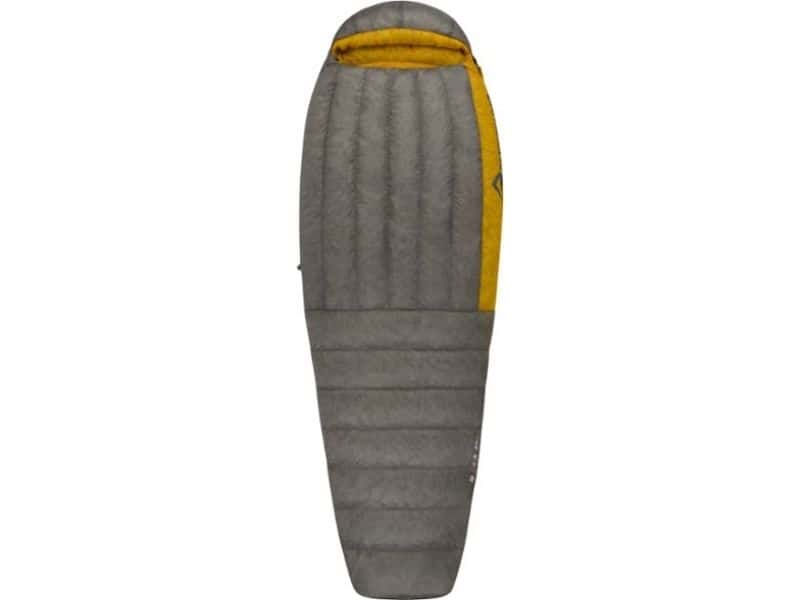
28℉ Lower Limit (~38℉ Comfort Limit) ⸱ 850+ FP 10.6 oz fill weight goose down ⸱ 59” / 51” / 35” shoulder/waist/feet measurements ⸱ Weight: 1 lb 1.3 oz / 6 liter packed ⸱ 10D nylon shell
The Sea to Summit Spark SPll 28 is an amazingly lightweight and packable bag that still packs a lot of warmth, making it ideal for summertime backpackers keen to shed every ounce.
The Spark weighs an incredible 1 lb and 1.3 oz, making it the lightest bag we tested, beating the Tanager and Hummingbird by a few ounces. The high-quality, 850+ fill goose down means great compressibility and, as a result, a 6-liter packed volume – the smallest of all the bags we tested.
Despite its low weight and packed size, the Spark has a lower limit of 28℉, giving it one of the best warmth-to-weight ratios. While not warm enough for the shoulder season, this makes it perfect for summer backpacking in most regions.
The Spark has a 10D nylon shell and a 7D taffeta liner. As these are on the skinny side, it will require a little extra care. The only other downside is the fit. The Spark is the trimmest model on our list with shoulder/hip/feet dimensions of 59”/51”/35” — if you hate being restricted in your bag or are a larger backpacker, then the Tanager and Disco are better options.
- Lightest and most compact sleeping bag we tested
- Excellent warmth-to-weight ratio
- High-end down insulation
Bottom-Line: Hands down the best ultralight sleeping bag out there!
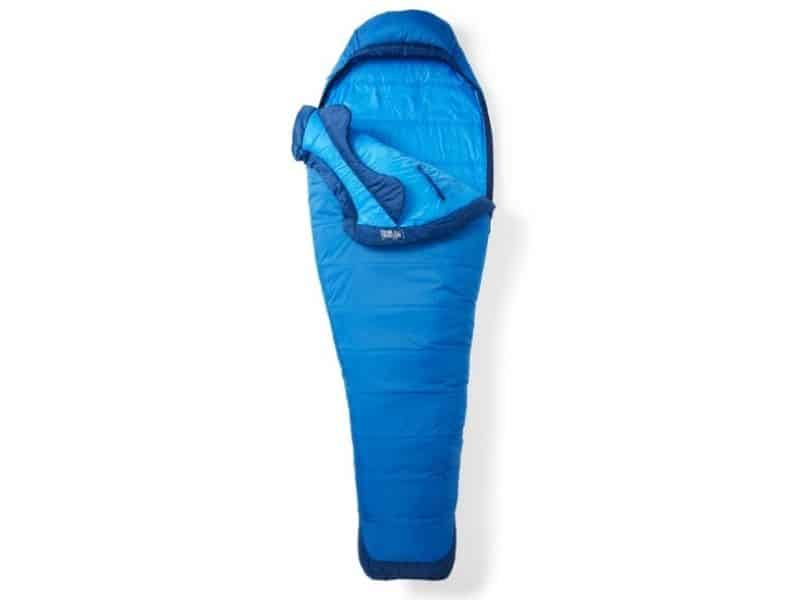
21.6℉ Lower Limit (32.2℉ Comfort Limit) temperature ratings ⸱ HL-ElixR ECO” Recycled Fibers ⸱ 60” / 56” shoulder/waist measurements ⸱ 2 lb 6 oz / 8.4 liter packed ⸱ 40d 100% Nylon Ripstop
The Marmot Trestles line of bags may be just the ticket if you’re looking for a synthetic sleeping bag or have a tighter budget. We tested the 20-degree version, which has a great temperature rating and an amazing price.
The Trestles comes in multiple temperature ratings (0℉, 20℉ & 30℉), all of which use HL-ElixR Eco Micro recycled synthetic fibers for insulation. The 20℉-rated bag packs has a comfort rating of 32.2°F, so is great for summer and warmer shoulder season backpacking. The synthetic insulation will also keep you warm when damp, which isn’t the case with down.
The biggest downside to the Marmot Trestles Elite Eco is its weight. While it packs down to 8.4 liters, the 20℉ version of the bag weighs 2 lbs 6 oz, which will make it a little too heavy for some.
- Affordable price tag
- Internal stash pocket
- Good temperature rating for a synthetic
- Durable shell & liner fabrics
- Tight around the footbox
Bottom-Line: If you’re looking for a cheap synthetic bag, then the Marmot Trestles Elite Eco is worth considering, providing great warmth for a brilliant price.

20℉ Lower Limit (29℉ Comfort Limit) ⸱ 100% Recycled Polyester ⸱ 63” / 58” shoulder/waist measurements ⸱ 3 lbs / 19-liter pack weight ⸱ 50D 100% Recycled Polyester Ripstop
The North Face Eco Trail is a durable and roomy synthetic sleeping bag that is one of the cheapest we tested. It’s a great option if you are looking for an affordable car camping bag that’s good for the occasional short backpacking trip.
It is filled with 100% recycled polyester insulation which is rated to 20℉ lower limit (29℉ comfort), which should keep you toasty even if the temperature drops below freezing.
The Eco Trail is a roomy 63”/59” across the shoulders and hips, making it a good option for side and active sleepers. These spacious dimensions are only beaten by our top pick for side sleepers, the Nemo Disco 15℉, which is far pricier.
Using 30/40 Denier fabrics, the Eco Trail is the most hardwearing and durable of all the bags we tested. Great if you need something that can take a more punishment when your out in the wild.
The downsides to TNF Eco Trail are its weight and packed size. At a whopping 3 lbs 14 oz., it’s a heavy option. As with all synthetic materials, it’s less compressible than comparable down bags. Its pack volume of 19L makes it about 25% smaller than our other synthetic pick, the Marmot Trestles, but double the volume (or more) of most down bags.
Unless you really want a synthetic bag or want a more durable bag for a mix of short backpacking trips and car camping, then we’d pick the Cosmic Down over the TNF Eco Trail. That said, the Eco Trail is a solid bag at a very cheap price if you don’t mind its weight and packed size.
- Most durable shell/liner fabrics of the bags we reviewed
- Pretty roomy
- Very heavy, suitable only for short backpacking trips or car camping
- Synthetic insulation isn’t easily compressible so bulky packed size.
Bottom-Line: If you want a durable synthetic bag that will see you through car camping trips and the occasional (short) backpacking adventure then we’d pick TNF Eco Trail 20.
How To Choose The Best Lightweight Backpacking Sleeping Bag?
The first step in finding the best backpacking sleeping bag is to understand what your needs are and how they’ll be met. Below, we have summarized some of the most important considerations and decisions you’ll need to make to find a model to suit your needs.
- Sleeping Bag temperature ratings
- Down vs. Synthetic Insulation
- Weight and Packed Size
- Durability and Shell Denier (D)
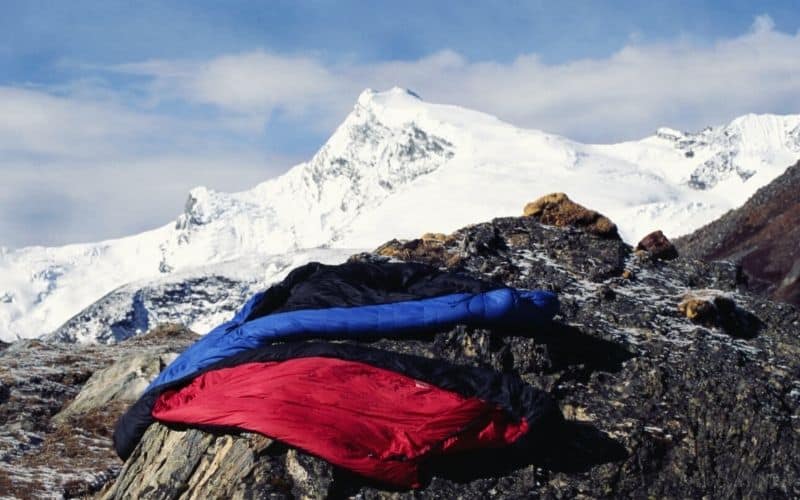
When choosing a sleeping bag, its temperature rating should be your top priority. However, as one of the heaviest items that you will carry (along with your sleeping pad, backpack, and shelter), striking a balance between warmth and weight is crucial.
Sleeping bags are rated with standardized temperature systems, such as European Norm (EN) or ISO.
Most bags are labeled using the EN Lower limit e.g. the NEMO Disco 15° has an EN Lower Limit of 15℉. The definition of Lower Limit is the temperature at which an average man can sleep for eight hours without waking. However, in our experience, this “average man” they use in testing is a darn deep sleeper.
The Comfort limit is defined as the temperature at which an average woman can sleep comfortably ( women sleep colder than men).
RELATED: Best Cold Weather Sleeping Bags
The comfort rating gives a more realistic idea of how a bag will perform outside of the lab and we prefer to use this number against the lowest temperatures we might encounter.
If you want to choose the right rating, it’s a good idea to know the temperatures you’ll experience overnight by checking weather forecasts and average overnight temperatures at the time of year in the areas you plan to visit.
There are many factors that contribute to your overall warmth, meaning picking the right sleeping bag temperature rating is not an exact science. Your clothing, the altitude of your campsite, whether you are a “cold sleeper” or not, how well hydrated or fed you are, along with the ratings of the rest of your sleep system will play a role.
It’s common for frequent backpackers to own multiple sleeping bags rated for different temperatures. To keep costs down, most backpackers start with one that will keep them warm in the lowest temperatures they plan to camp in.
There are, however, multiple ways of increasing the temperature rating of your “sleep system” without owning several bags.
First is the R-Value of your sleeping pad. The underside insulation gets compressed under your body weight and becomes less effective at trapping heat. Your sleeping pad is there to help provide more insulation between yourself and the cold ground. A beefier pad will serve you better.
Simple and cost-effective methods to stay warm include wearing warm clothing such as wool base layers, a warm hat, gloves, and a down jacket when sleeping. A sleeping bag liner can also add 3-10℉ of warmth to your existing bag.
Other tricks to try:
- using a hot water bottle
- eating dinner right before bed
- keeping well hydrated
- Finding natural insulators to place under your pad
As most backpackers don’t limit themselves to summer adventures only, most sleeping bags on our list are rated to around 20F (Lower Limit), so they should comfortably see you through chilly spring or fall nights.
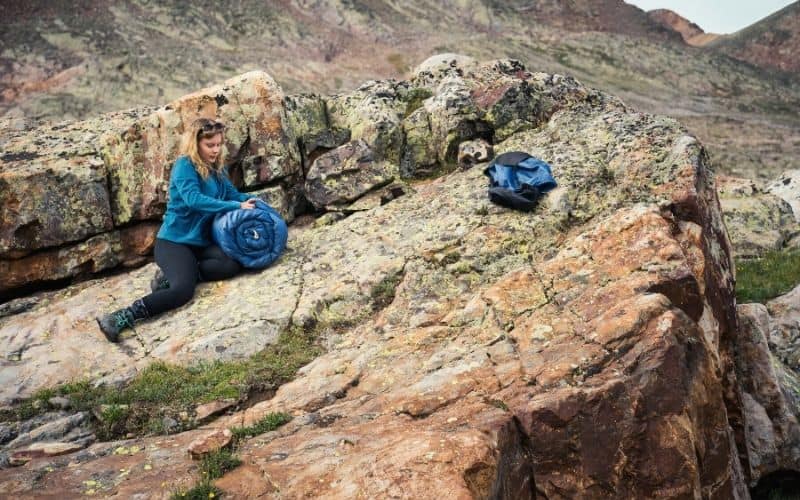
The next big decision when buying a sleeping bag is the insulation type: down or synthetic . Down insulation is more expensive but has a better warmth-to-weight ratio and compressibility than synthetics. This means you’ll get the same level of warmth with a smaller packed volume when opting for down.
Over the years we’ve found down bags also last longer if you take care of them properly.
Synthetic bags do have their advantages — they are cheaper than down bags and are able to retain heat better when damp or wet. This disparity has reduced in recent years thanks to companies applying water-resistant treatments to some (but not all) down bags to make them hydrophobic.
We think that if a down bag is within your budget, in most cases it’s going to be the better option.
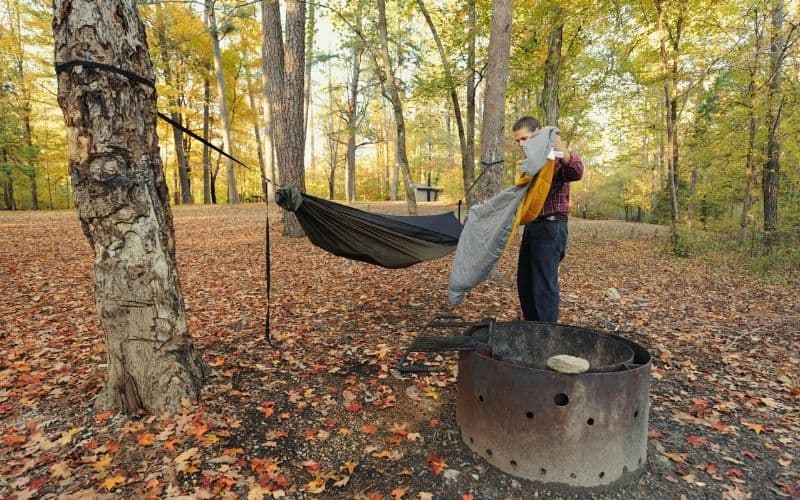
Another critical consideration when choosing a sleeping bag is fill power, which distinguish the quality of the down used.
Fill power is a measure of how much loft or fluffiness the down clusters have, and this correlates to warmth. The less fill power you have, the more the bag will have to weigh to give the same warmth.
The cheapest down bag on our shortlist is the Kelty Cosmic Down 20 with a 550 fill power and a 21℉ lower limit. A comparison with the 900+ Fill power Feathered Friends Swallow YF (20℉ lower limit) shows the Cosmic Down is nearly a pound heavier (13.3 ounces) and has the same temperature rating.
Second to fill power is fill weight. Fill weight is the amount of insulation that has been used in the sleeping bag. If you’re torn between two with similar insulation, look at the fill weight in order to determine which will be warmer. While this is a reasonable rule of thumb, it’s important to remember that a bag with a slender cut may have less insulation than a bag with a roomy cut.
From such a comparison you can see how much more insulation is needed for a synthetic bag to compete with down. The Marmot Trestles, which uses synthetic insulation, weighs over a pound more than similarly rated 20℉ down bags.
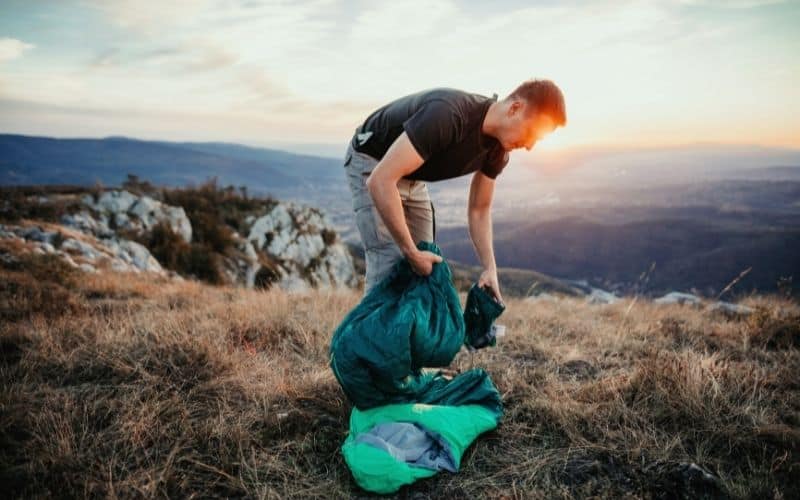
Your sleeping bag’s weigh and packed size is another vital consideration, especially for ultralight hikers. You bag is one of the heaviest and bulkiest items in your pack, so this where you can make significant weight and bulk savings. Ultralight sleeping bags can range from 1 pound for a premium model, to 3 pounds for a budget synthetic bag.
Weight savings are achieved by using premium fill-power down (800+), thin shell fabrics and zippers, plus trimmer profiles. Ultralight backpacking sleeping bags are pricey, but those thinner materials and the higher fill-power down could equate to carrying several ounces less and leave you a few extra liters of pack space.
Synthetic sleeping bags are the bulkiest options while the most compressible are high fill-power down bags rated for 3-season weather. With more insulation for colder weather or a lower fill-power down, the less compressible the bag will be.
The denier or thickness of the shell fabric dictates its durability, so this is another important metric to consider when buying your new sleeping bag. The range of shell fabric durability for 3-season sleeping bags is usually in the 10-30 D range, although there are some synthetics as high as 70D. The higher the number, the more durable the fabric.
For most backpackers, durability is not one of the foremost concerns when choosing a sleeping bag. Unless you plan to sleep in the open, your sleeping bag will rarely see anywhere except the bottom of your pack and the inside of your tent.
Some backpacking sleeping bag models have a women’s version. Women’s-specific sleeping bags are typically wider at the hips and narrower around the shoulders than to men’s, unisex, and youth versions. Also, more insulation is used targeted areas.
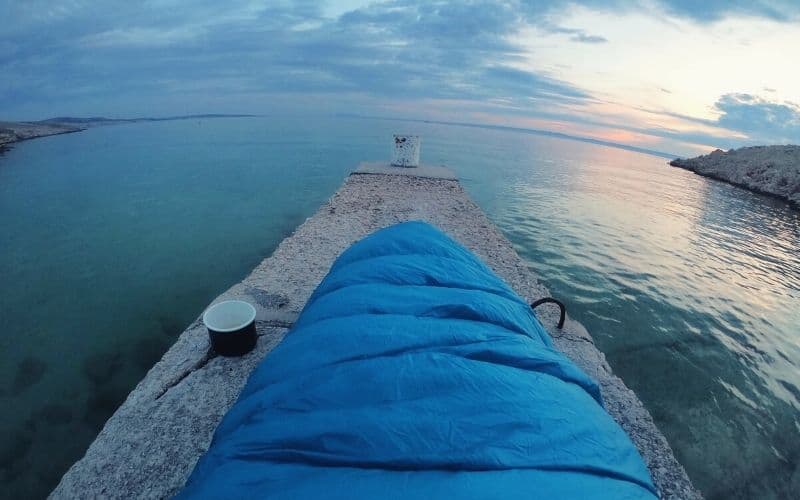
Choosig between a sleeping bag and quilt is a matter of personal preference, but there are a few differences worth noting.
The most significant difference is that, while both have insulation to keep you warm in cold weather, only a sleeping bag will enclose your entire body.
A backpacking quilt is designed with only a top layer of insulation and is intended to be strapped to your sleeping pad. This reduces weight as it removes the insulation under your body. As such, quilts have a better warmth-to-weight ratio than sleeping pads. However, it does mean sleeping directly on your pad.
Quilts are better suited to warmer conditions where nighttime temperatures don’t dip below freezing. They’re a favorite among backpackers who wish to shave weight, and for anyone who is an active sleeper or feels claustrophobic wrapped up in a mummy bag.
In cold and windy weather, we’d always opt for mummy bags as they trap body heat more efficiently and are less drafty.
To conclude, we believe the best backpacking sleeping bag you can buy is the Feathered Friends Hummingbird 20F. This bag is ultralight, toasty warm, and packs down to a tiny bundle, making it a great pick for 3-season backpacking. If the Hummingbird is too pricey, the Kelly Cosmic Down and Nemo Disco are solid alternatives if you don’t mind carrying a little extra weight.
If you have any questions or comments, drop us a line in the box below. And if you’d like to share this post, please do!
Last update on 2024-09-11 / Affiliate links / Images from Amazon Product Advertising API
Brian Conghalie
Brian has been an avid hiker and backpacker since he was a small kid, often being taken out into the wilderness on trips with his father. His dad knew everything about nature and the wilderness (or at least that's how it seemed to a ten year old Brian).
After high school, he went to university to read for both a BS and MS in Geology (primarily so he could spend his time outside rather than in a classroom). He's now hiked, camped, skied, backpacked or mapped on five continents (still need to bag Antarctica) & 30 of the US states.
Email - Portfolio
- Search Please fill out this field.
- Manage Your Subscription
- Give a Gift Subscription
- Newsletters
- Sweepstakes
We independently evaluate all of our recommendations. If you click on links we provide, we may receive compensation.
- Travel Products
- Activity + Adventure
- Camping + Hiking
The 8 Best Camping Pillows of 2024
Camping pillows can weigh as little as three ounces and pack down smaller than a deck of cards. There’s no reason not to bring one.
:max_bytes(150000):strip_icc():format(webp)/MaggieSlepian-3365fd7dc8a34ccd93f92ad344adc362.jpg)
In This Article
- Our Top Picks
- Tips for Buying
Frequently Asked Questions
- Why Trust T+L
Travel + Leisure / Maggie Slepian
As much as I’ve dedicated myself to ultralight backpacking, the one “non-essential” I’ll never give up is my camping pillow. I’ve spent plenty of trips sleeping on a greasy stuff sack filled with extra layers of clothing as my pillow, but after a long day on the trail, I prefer to blow two breaths into a backpacking pillow and call it a night. And unless you’re counting every gram in your pack, camping and backpacking pillows are so compact and light that I’d recommend them to anybody spending the night in a tent .
Camping pillows come in a wide range of weights, styles, and sizes, so they can be used for everything from backpacking trips , to road trips, to front-country camping. My favorite camp pillows inflate with just two or three breaths, weigh less than three ounces, and can be adjusted for different fill levels (I over-inflate for reading and then reduce the inflation for sleeping). I’ve used every pillow on this list and can personally recommend them all, regardless of what kind of camping trip you have planned.
Best Overall
Sea to summit aeros premium pillow.
This pillow combines a plush face fabric with the weight saving of lighter options.
The softer surface material can be harder to keep clean during long trips.
This is my top pick for a lot of reasons, but mostly because the extra weight of the plush cover, added baffles, and flat surface that feels more supportive than some of the springier air pillows, are 100 percent worth it. For such a lightweight pillow, the Aeros Premium has plenty of features like a knit polyester exterior, a contoured TPU air bladder that mimics a standard pillow, and a proprietary valve for maximum air fill customizing.
It also has more structure than the most minimal pillows out there, with actual internal baffles that help support the head and neck whether you're sleeping on your side, stomach, or back. It has held up really well for more than four seasons of use backpacking, traveling, and car camping, too. Deflating takes just a few seconds, and I can inflate the standard size with just two breaths. This pillow is available in two sizes, but I’ve been very happy with the regular model.
The Details: 13.4 x 9.4 x 4.3 inches | 2.8 ounces | Brushed 50D polyester and synthetic fill
Best Ultralight
Therm-a-rest air head lite pillow.
The dedicated non-slip material is a lifesaver on slippery sleeping bags or sleeping pads.
The intake valve doesn’t allow for as much inflation adjustability.
The two-ounce weight and 15-inch width of this pillow is aligned with the lightest pillows on the market and has a killer size-to-weight ratio. It’s also offered in a large size (2.8 ounces and 18 inches wide), though the regular size works just fine for me for backpacking. It has a non-slip material that keeps it from sliding around on my sleeping pad or sleeping bag , and it’s actually so tiny it gets lost in my bag when I’m digging through my gear at camp — a problem solved by tucking it into the bottom of my sleeping bag in the morning before I pack up.
The Details: 15 x 11 x 4 inches | 2 ounces | Polyester
Travel + Leisure / Maggie Slepian
Best for Backpacking
Sea to summit aeros ultralight pillow.
It’s super easy to fine-tune the level of air fill.
The baffles can lose their shape after a few seasons of use.
Sea to Summit makes one of my favorite sleeping pads, and they’ve built an integrated non-slip feature into their pillows to help them stay secure on the pads. For this reason (and the ridiculously light weight), this pillow is my go-to for backpacking — less sliding around at night means a better night’s sleep. Like the built-up Premium Pillow, this Aeros Ultralight has a contoured TPU bladder that helps maintain the pillow’s shape and supportive structure, and it inflates in just a few breaths. It’s super customizable with the brand’s lie-flat inflation nozzle, and I’ve never felt it lose air overnight. The only issue I’ve run into are the internal baffles blowing out after a few seasons. Luckily, Sea to Summit offers a warranty on all products, and it was an easy repair/replacement process.
The Details: 13.4 x 9.4 x 4.3 inches | 2.1 ounces | 20D polyester
Best for Car Camping
Nemo fillo backpacking & camping pillow.
The combination of memory foam and air-inflation is customizable and comfortable.
Some people might prefer a loftier pillow.
This half-foam-half-inflatable pillow is one of my must-have items for road trips , and it has a permanent place in my car-camping setup. It doesn’t roll up to the tiny size of air-filled pillows, but it does lie flat thanks to the memory-foam panel that provides a supportive backing when you inflate the front half. I usually leave this flat and roll it up inside my car-camping mattress , then have it immediately available when I unroll my mattress at night. It has a plush cover with a little bit of density, and the memory foam support feels close to a home pillow without the bulk of packing a non-inflatable. If that doesn’t convince you, it comes with its own stuff sack and has a removable, washable cover.
The Details: 17 x 11 x 4 inches | 9.2 ounces | Polyester or microsuede and memory foam
Most Comfortable
Sea to summit aeros down pillow.
For less than three ounces, you have a large pillow with down support.
Some people might think the top material is too slippery.
The Aeros Down Pillow has a customizable inflation valve that drops micro amounts of air with just a light push, then seals immediately when released. It has a layer of ultralight down feathers for a top cushion that feels as close to my at-home pillows as anything I’ve used outdoors, and the standard size still weighs just 2.5 ounces. Sea to Summit saves a bit of weight by using the same technical polyester materials they use in their ultralight Spark Sleeping Bags, so it’s lightweight and durable, but a little more slippery than the brushed polyester face fabric of most other camping pillows.
The Details: 13.4 x 9.4 x 4.7 inches | 2.5 ounces | Polyester and down fill
Best Supportive
Therm-a-rest compressible pillow.
This is a hardy, machine-washable pillow good for front-country camping, road trips, and air travel.
The fill can get lumpy after a lot of use and washing.
This classic pillow is really nice for front-country camping, overnighters, and even use in hostels. With a plush-yet-supportive synthetic fill and a soft polyester surface, this is my pick for base camping and extended trips. This is one of the original camping pillows, and I have plenty of outdoorsy friends who have had this in their front-country tent and hammock setup for years. It compresses down into its own pocket for easy stashing, and the whole pillow can be tossed in the washing machine when you get home. It has a layer of insulation over the fill that provides more structure and support, and it comes in fun patterns and designs.
The Details: 18 x 13 x 6 inches | 10.1 ounces | Polyester and synthetic fill
Best for Hammocks
Outdoor vitals ultralight travel pillow.
This is equally as comfortable for hammocks as it is for airplanes.
The horseshoe shape can be limiting in some sleeping situations.
Somewhat outside the normal design for camping pillows is this travel-pillow-inspired inflatable model from Outdoor Vitals. It’s just as comfortable for traveling as the most expensive travel-specific pillows, and it also packs down so minuscule I have to keep it in my pocket or else I may lose it. I like the horseshoe shape for unconventional camping systems like hammocks , where an ultralight standard pillow might be prone to flying out of the hammock without a mummy bag or tent walls to keep it in place. Just blow a few breaths of air in, seal it with the flat-lying valve, wedge it around your neck, and it’s not going anywhere. The travel-pillow shape isn’t for everyone, but for hammock camping and airline travel, it’s a great (and affordable) option.
The Details: 16 x 10 inches | 1.1 ounces | 30D stretch nylon
Best Budget
Cocoon aircore hood / camp pillow.
This pillow shape was designed to stay in place in a sleeping bag hood.
This model developed leaks faster than others.
This ultralight camp pillow from Cocoon is a great budget option, retailing for less than $30, that still holds up in quality when it comes to weight, structure, and air-retention durability. It's also designed specifically to fit in the hood of a mummy bag, which is really nice since some of the more rectangular pillows don’t wedge inside the hoods as well and can create drafts and slide around. I also love the two-sided material options: one side has a soft microfiber for cold nights, and the other is a nylon with a smoother, cooling surface.
The Details: 11 x 15 inches | 3.8 ounces | Polyester, nylon, and synthetic fill
Tips for Buying a Camping Pillow
Prioritize comfort.
Unlike traditional pillows, camping pillows are designed to be lightweight and compact, but I’m a firm believer that this shouldn't come at the expense of comfort. Choose a pillow that offers adequate neck and head support, with materials that balance firmness with a nice surface material. Almost all of the pillows on this list are highly adjustable for inflation levels, which will help as well. Lastly, consider the pillow's size and shape to match your sleeping style, breathable materials, and make sure the pillow has either a washable cover or can be fully hand washed.
Think About your Sleep Setup
You’ll want to make sure your pillow matches your sleep system, especially for backpacking. A mummy bag with a hood will work best with a rounded-top pillow whereas open-top sleeping bags or quilts will be fine with more rectangular, larger pillows. Sleeping pad and sleeping bag materials are also slippery, and paired with a slippery pillow can make for hours of annoying sliding around. Sea to Summit makes compatible sleeping pad and pillow materials to help prevent this, and you can also look for brushed pillow materials to help everything stay in place.
Consider Portability
Your type of outing will directly impact the size of the pillow you get, and whether it has actual fill or is fully inflatable. For backpacking, prioritize ultra-lightweight and compact options, such as inflatable models, which can be easily stowed in a backpack without adding notable weight or bulk. For car camping, weight and space are usually less of a concern so you’ll have more flexibility and can opt for larger, more plush pillows that offer maximum comfort and more support.
I’ve always found that backpacking pillows significantly enhance my quality of sleep on the trail, which improves my energy levels on the whole trip. These pillows are designed to be lightweight and compact, fitting easily into your backpack without taking up space or adding excessive weight. Despite their portability, they do offer superior support and comfort compared to makeshift alternatives like rolled-up clothes, helping to prevent neck and back pain. Additionally, many backpacking pillows are made from durable, quick-drying, and moisture-wicking materials, so they’ll last multiple seasons and can be washed and air dried.
The slippery combo of pillow + sleeping bag + sleeping pad can be a pain. I don’t have a perfect solution, but consider your whole sleep system. Some sleeping pads come with built-in pillow pockets or straps where you can secure your pillow, or you can use Velcro strips or elastic bands to attach the pillow to the pad. For mummy bags, you can place the pillow inside the hood to keep it from shifting around during the night, and if you’re having a ton of trouble, try using clothing or extra gear to create a makeshift nest around the pillow. Finally, look for non-slip materials or grip dots on the bottom to help the pillow stay in place on the sleeping pad or tent floor.
Inflatable pillows are great for camping. They are highly compressible, making them extremely lightweight and easy to pack, and they take up minimal space in your pack. Most also have the option for varying the amount of air inside, allowing you to customize the support level to your preference for a comfortable night's sleep, and even the lightest models are made from robust materials built specifically to be puncture resistant for long seasons out on the trail.
Why Trust Travel + Leisure
Maggie Slepian is an avid hiker, backpacker, and bikepacker with more than a decade of professional gear testing experience. She has backpacked thousands of miles, and her hiking and backpacking has taken her from winter peak bagging and coastal backpacking to extended trips in the desert and high alpine. Maggie has spent hundreds of nights in a tent both front-country and backcountry, and tested a variety of camping pillows from the most minimalist ultralight to the plush car-camping models.
Love a great deal? Sign up for our T+L Recommends newsletter and we’ll send you our favorite travel products each week.
:max_bytes(150000):strip_icc():format(webp)/TaylorFoxHeadshot-7375be27aedf4b0ea0e0189a4befe7d0.jpeg)
Related Articles
- svg]:fill-accent-900"> 747K
- svg]:fill-accent-900"> 181K
- svg]:fill-accent-900"> 57.8K
The Best Backpacking Pillows
By Laura Lancaster
Updated on Oct 31, 2022 3:04 PM EDT
Best Overall
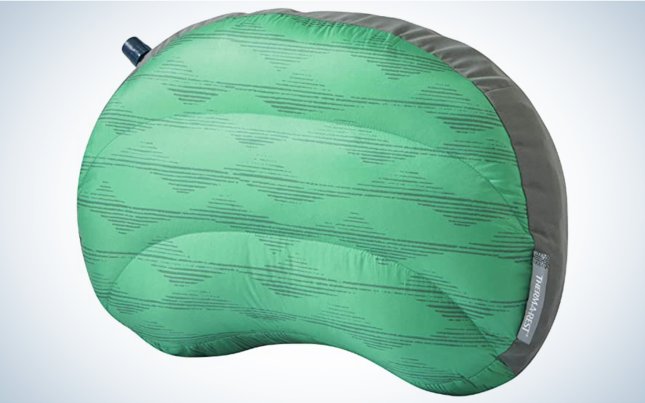
Therm-a-Rest Air Head Down Pillow
Best memory foam.

NEMO Fillo Backpacking & Camping Pillow
Best lightweight.

Therm-a-Rest Air Head Lite Pillow
We may earn revenue from the products available on this page and participate in affiliate programs. Learn More ›
If you peek into the pack of a seasoned long-distance hiker, there is one item that might surprise you: a backpacking pillow. Why, if you’re aiming for a sub-10-pound base weight, would they carry a luxury item like a pillow? I spent hundreds of nights sleeping outdoors with my puffer jacket balled up underneath my head before I started consistently sleeping through the night with a backpacking pillow. After testing out a number of the top options available, here are my picks for the best backpacking pillows:
Best Overall: Therm-a-Rest Air Head Down Pillow
Best memory foam: nemo fillo backpacking & camping pillow, best oversize: sea to summit aeros down pillow, best lightweight: therm-a-rest air head lite pillow, best budget: outdoor vitals ultralight stretch pillow, best pillowcase: rumpl stuffable pillowcase.
Why It Made the Cut The Air Head Down Pillow has the best balance of comfort, warmth, and weight out of everything I tried.
Key Features
- Weight: 4.9 ounces
- Size: 15.5 inches x 11 inches
- Packed size: 5 inches x 4 inches
- Height: 4 inches
- Lightweight
- Retains some warmth overnight
- Mid-height will work with most people
- Less comfortable fabric than other deluxe pillows
Product Description One of the biggest complaints people have about the air-only backpacking pillows is that they can be very cold. After a midnight bathroom break, it can be disconcerting to climb into one of the best sleeping bags and feel the cold polyester shell of an ultralightweight backpacking pillow.
The Thermarest Air Head Down Pillow uses a smidge of 650-fill power duck down, concentrated on one side of the pillow, to fix this problem. Down, the feathers found closest to the skin of ducks and geese retain warm air in small pockets created by the many barbules along the short shaft of the feather. In addition to adding warmth, they also add a bit of cushion. Despite the down, the size and shape of this pillow is similar to other ultralight designs, saving on weight. My only complaint is that the fabric on the side with the down wasn’t as smooth or comfortable as that used on other high-end backpacking pillows.
Why It Made the Cut If you prefer a stiffer, taller pillow that still cushions and conforms to the shape of your head, then the NEMO Fillo is the right choice for you.
- Weight: 9.2 ounces
- Size: 17 inches x 11 inches
- Packed size: 6 inches x 4 inches
- Height: 4 inches
- Integrated stuff sack is easier to find in the morning
- Comfortable fabric on the pillow side
- Stiffer than classic memory foam pillows
- Valve is slightly more complicated to use
Product Description Of all the pillows I tested, this is the one I have the most mixed feelings on. Its comparatively bulky packed size and significant weight addition raised my eyebrows, but when I put my head down, it was far and away the closest to the memory foam pillow I used at home. The knit fabric against my face was also comfortable for my skin, unlike some of the clammy polyesters and nylons used by the ultralight set. Not bad for just over half a pound.
The problem was when I woke up in the middle of the night with a stiff neck—I deflated the pillow some to try to create some “give,” to minimal effect. When I gave the NEMO Fillo to fellow campers to try, reviews were mixed—some found it incredibly comfortable throughout the night; others had the same experience that I did. I recommend having another individual check your neck alignment when lying down to ensure it isn’t at an angle before committing to a purchase.
Best Oversize
Sea to summit aeros down pillow.
Why It Made the Cut The Aeros Down is nearly as big as a standard bed pillow for only a couple of ounces more than my best overall pick.
- Weight: 6.7 ounces
- Size: 23 inches x 15 inches
- Packed size: 6 inches x 3.5 inches
- Height: 4.7 inches
- Closest to a standard bed pillow of anything in my test
- Down adds both cushion and warmth
- May be too tall for some individuals
Product Description Like my best overall pick, the Sea to Summit Aeros Down Pillow uses a layer of down to add both warmth and a bit of cushion. Unlike my best overall pick, the Sea to Summit Aeros Down Pillow is huge—easily one of the widest in my test. If you are the kind of person who tosses and turns at night, waking up to find your pillow anywhere other than under your head, this could be the solution you have been looking for. That goes double if you tend to stack two pillows on top of each other at home, as the 4.7-inch height of this pillow is fairly significant.
Why It Made the Cut This 2-ounce pillow packs up small and uses a knit polyester that is comfortable to the touch.
- Weight: 2 ounces
- Packed size: 4 inches x 3 inches
- Less expensive than more high-end options
- Low profile
- Not as comfortable as pillows that use down or memory foam
Product Description This is the classic backpacking pillow—lightweight, low profile, and filled with nothing but air. It’s far from the most comfortable pillow I tested, but it would be my first choice for a longer backpacking trip, where I expect to spend most of the day on my feet, and I’m so exhausted that I’m asleep by 9. On those days, I’m a lot less likely to appreciate the creature comforts of a down or memory foam pillow anyway.
Something I liked about the Air Head Lite is that it is one of the slimmer models (4 inches) I looked at, and it had a flat profile. Other pillows I tried, such as the EXPED Ultra Pillow, are thicker at the base of the pillow—to support your neck—but this can be distracting, and I find my head tends to slide off or rest at an uncomfortable angle (more often than not I just swap the side I’m sleeping on and use only half the pillow). The streamlined profile of the Therm-a-Rest Air Head Lite Pillow means that it will be comfortable for the widest range of people.
Best Budget
Outdoor vitals ultralight stretch pillow.
Why It Made the Cut This budget backpacking pillow is only a hair heavier than other top lightweight pillows, while coming in at a significantly reduced price.
- Weight: 3.1 ounces (as measured)
- Size: 16 inches x 10 inches
- Packed size: 4.5 inches x 3.5 inches
- Inexpensive
- Packs down small
- Neck support may be uncomfortable for some individuals
- Not quite as lightweight as similar models I looked at
Product Description This pillow, while not as comfortable as the other picks on this list, gets the job at a significantly reduced price. If you’re curious to see how a backpacking pillow can improve your sleep but wary about the price point of the higher-end models, then the Outdoor Vitals Ultralight Stretch Pillow is a good place to start.
Unlike the other backpacking pillows I looked at, this one was slightly higher at the bottom of the pillow than it was at the top, with a slight depression in the middle. Some people enjoy the neck support this type of design provides, but it can be uncomfortable for others.
Best Pillowcase
Rumpl stuffable pillowcase.
Why It Made the Cut The soft fleece side of this pillowcase felt great to the skin on cold nights. The adjustable height is best suited for stomach sleepers.
- Weight: 3.2 ounces
- Size: 16 inches x 11 inches
- Packed size: 6.5 inches x 3.5 inches
- Height: Not applicable
- Height of the pillow can be adjusted
- Small packed size
- On cold nights, you’ll have to decide between your puffer jacket and having a pillow
Product Description I’ll admit that I didn’t get to test the Rumpl Stuffable Pillowcase as much as I wanted because the second my three-year-old tried it, she claimed full ownership. But I see her point: the fleece-lined side was significantly nicer to the touch than the cold nylon or polyester of the other models I tested (even if these did warm up quick enough), and she could choose the exact height that the pillow would be when she laid down on one of the best backpacking sleeping pads . In her case, the puffer coat was much too tall, but a single long sleeve shirt gave her just the height she needed.
Things to Consider Before Buying Backpacking Pillows
Weight Backpacking pillows can vary in weight considerably, from two ounces to over half a pound. Your goal when choosing a backpacking pillow is to pick the option that optimizes your sleep without overly weighing down your backpack.
Packed Size While there are a number of high-quality foam pillows built for the outdoors, few pack down as small as the NEMO Fillo, making them a no-go for backpackers.
Insulation The smallest backpacking pillows are simple inflatables. While this helps to keep the cost, packed size, and weight down, these pillows do not retain much (if any) heat. While this can be offset by a sleeping pad with a higher R rating, light sleepers may find that shifting to a cold part of the pillow causes them to wake up more often than they would like.
Height The reason that a pillow can help to improve your sleep is that it helps to keep your neck at an even angle, something known as neutral alignment. The right height varies by person, but you can get a sense of your natural preference by looking at the height and number of pillows you currently use at home.
Methodology
I tested backpacking pillows on a series of summer overnights and shared them with the people I was camping and backpacking with in addition to using them myself. I looked at how comfortable the pillow was, whether it was clammy or soft to the touch when I first laid my head on it, and if I woke up in the middle of the night for any reason (neck pain, pillow shifted, etc.) While everyone agreed that a pillow—any pillow—was better than balling up one of the best puffer coats , not everyone agreed on which pillow was the most comfortable—or even comfortable at all. If you have the option to test out a number of pillows before making a purchase (such as at an outdoor retailer), that will help you make the right choice for yourself.
In addition to field testing the backpacking pillows, I also considered their price, packed size, and weight—all important considerations for backpackers.
Yes, they are worth it.
If you’re balling up your puffer coat to serve as a “pillow” in the backcountry, that’s the first sign that you need to get a real backpacking pillow. The next time you’re out, count the number of times you wake up in the middle of the night and adjust the jacket so that it’s still comfortable under your head. If the answer is more than “I never woke up” then you should strongly consider getting a backpacking pillow.
If you consistently sleep on your stomach, it’s possible that you won’t benefit from a backpacking pillow. One way to determine if this is the case for you is to swap out your regular pillow at home for something low profile or ditch it all together—if you sleep soundly through the night without it, then you can probably skip the pillow in the future.
Final Thoughts
After looking at a number of backpacking pillows, the Therm-a-Rest Air Head Down Pillow is the best balance of comfort and weight, while the two-ounce Air Head Lite is ideal for gram counters. Those looking for even more comfort appreciate the wide profile of the Sea to Summit Aeros Down Pillow or the memory-foam NEMO Fillo.
The Best Camping Pillows of 2024

It’s a common misconception that camping is equivalent to roughing it. Gone are the days of wadding up your down jacket and turning it into a makeshift camping pillow while you try to get a few winks. The truth is, sleeping in the great outdoors is just as comfortable as you make it. Nowadays, there are camping pillows for campers of every stripe.
Developers have been putting in some serious zzz ’s when it comes to putting together the best camping pillow, and it shows. You’ve got everything from heavy, ultra-plush pillows for car campers to ultralight inflatable ones for backpackers. There are even pillow options for side sleepers.
We took a good, hard look at some good, soft pillows, and we found the best pillows for camping and backpacking on the market. Over 3.5 years of sleeping — er, we mean testing — has led us to the cr è me de la cr è me of camp pillows.
We’ve tested more than a dozen pillows, including 7 in 2024 alone, throughout the Western U.S. These pillows have helped us sleep soundly on chilly fall nights and balmy summer ones, at campsites next to babbling brooks, in alpine basins and sometimes just the back of our trucks at a last-minute road trip parking lot (we’ve all been there).
We highly recommend scrolling through our list and checking out all the pillows. Also, take a look at our camping pillow Buyer’s Guide , Comparison Chart , and Price & Value sections at the end of this article if you need some more help deciding.
Editor’s Note: We updated our Best Camping Pillows guide on August 19, 2024, to totally revamp our current selections. Favorites include the EXPED Mega Pillow , L.L.Bean Flannel Camp Pillow , and Sea to Summit Aeros Down Ultralight Pillow .
- Best Overall Camping Pillow: EXPED Mega Pillow
- Best Budget Camping Pillow: Cocoon AirCore Hood/Camp Pillow
- Best Inflatable Camping Pillow: Sea to Summit Aeros Ultralight Pillow
- Best Camping Pillow for Side Sleepers: NEMO Fillo King
- Best Backpacking Ultralight Pillow: Zpacks Medium Pillow
- Best Down Insulated: Therm-a-Rest Air Head Down Pillow
- Best Summer Camp Pillow: L.L. Bean Flannel Camp Pillow
EXPED Mega Pillow
- Type Inflatable
- Materials Brushed tricot nylon exterior, 160 g/m Texpedloft microfiber insulation
- Weight 6 oz.
- Packed Volume 5.1 in x 3.9 in packed size, inflated dimensions 20.9 x 12.6 x 4.7 in
- Thickness 4.7"
- Stuff Sack Separate

- Large when inflated but packs down small
- Soft tricot nylon material feels good on skin
- Can be attached to a mat
- Removable, washable cover
- Doesn't fit easily in some sleeping bag hoods
- Can be a little too thick when fully inflated
Big pillow lovers, rejoice. You’ll never need to spend another camping night with your head sliding off the pillow or feeling like there juuuuust isn’t enough support. The EXPED Mega Pillow ($60) is mega in all the ways you want and none of the ways you don’t.
This pillow packs down relatively small and light, ideal for everything from car camping to backpacking, but blows up big. Hence the name. We loved how supportive and comfortable this pillow was. In fact, our secondary tester started out the night with this before our primary tester had to steal it and try for herself. It’s just that good. The soft cloth feels good on our face and both back and side sleepers will find adequate support.
It’s hard to find much to complain about. If fitting your pillow into your sleeping bag’s hood is important to you, and if your hood is super tight to seal in warmth, you might find the large square shape of this pillow tough to stuff in. Eyelets on the pillow’s sides allow you to attach the pillow to a mat if you’re sleeping outside your hood.
While this isn’t the lightest pillow on our list (the ALUFT 2.0 from Trekology manages to shave about 3 ounces and $30, for example, while Sea to Summit and Cocoon also have slightly lighter options), unless you’re packing your backpack ounce by ounce, you’re fine right here.
If you’re going to get just one camp pillow that’s comfy enough for truck camping but small and light enough to shove in a backpack without a second thought, the EXPED Mega Pillow is it.
Cocoon AirCore Hood/Camp Pillow
- Materials Nylon, polyester
- Weight 4-10.5 oz.
- Packed Size 4 in x 3 in – 7 in x 5 in
- Thickness N/A

- Tiny packed size
- Choice of two fabrics
- Budget-friendly
- Slightly finicky valve cap
We absolutely loved the Cocoon AirCore Hood/Camp Pillow ($30) as a budget-friendly camping pillow that is still comfortable and small enough for backpacking with ease.
For only $10-15 more than our cheapest pillow on the list, the AirCore Hood/Camp has a lot more bells and whistles. It’s the second smallest pillow on this list (only to the Aeros Down Ultralight Pillow ) and third cheapest (behind the REI Co-op Trailmade Mummy Bag Pillow and the Trekology ALUFT 2.0 .)
When we tested this pillow in Montana’s Swan Valley this spring, we really appreciated the difference in fabric between the two sides of the pillow. With nylon and quilted sides, you can decide if you want that cozy feel of the fleece-esque quilt or the cooling relief of nylon. We also found the setup to be a breeze: simply puff out two breaths, and the pillow is totally full. You can release pressure slightly if you want a softer pillow. Three sizes give campers a choice between small, medium, or full-sized pillows.
We loved this pillow so much that we took it on various hammock reading excursions in parks and by streams in Missoula. That’s when we noticed the need to firmly secure the cap to avoid losing air. Twice, we thought we had secured the cap, but instead, air was leaking out. Avoid doing this overnight by checking that the cap on the valve is firmly in place.
If you’re looking for a compact, lightweight pillow that won’t break the bank, look no further than the AirCore Hood/Camp Pillow . It’s safe to say we’re hooked.
Sea to Summit Aeros Ultralight Pillow
- Materials Polyester
- Weight 2.5-4.6 oz. depending on size
- Packed volume 0.4 L
- Thickness 4.7-5.5" depending on size

- Compresses well
- Sticks to Sea to Summit sleep pads like glue
- A tiny bit hard to get back in the stuff sack
- Not machine washable
Made of technical fabrics from the brand’s sleeping bags and laminated on a TPU air bladder, the Sea to Summit Aeros Ultralight Pillow ($45-65) is contoured to provide secure comfort while you sleep.
The scalloped bottom secures the pillow to your shoulders, keeping it in place whether you’re sleeping on your back, stomach, or side. It even works well when sleeping upright in a chair, making it a great choice for road trips or long flights.
One of our favorite details of this premium inflatable pillow is the three-way mini valve, which allows for rapid inflation and deflation. It also features a press-button release valve, which lets you fine-tune the pillow’s softness to your preference.
We also love Sea to Summit’s proprietary PillowLock system, which is on all of their pillows sold since 2019. This system works with Sea to Summit sleeping pads to stick to the pad and keep it in place while you sleep. When you pack it up, the pillow compresses into its stuff sack to about a third of the size of a water bottle, so you have no excuse to leave it at home. If you want an even pillow-ier topper, try the Aeros Down Pillow for very similar features with an extra layer of warmth and fluffiness.
The only thing we weren’t crazy about about the Aeros Ultralight Pillow was its price, which is on the high end comparatively. But when ounces count, it’s an easy trade-off we’d be willing to make again.
NEMO Fillo King
- Type Foam and inflatable
- Materials Polyester, open-cell foam
- Weight 14.1 oz.
- Packed volume 3.2 L
- Thickness 6"
- Stuff Sack Integrated

- Tons of loft
- Huge expanded size
- Integrated stuff sack
- Machine washable cover
- Larger packed size than regular-size pillows
The king-size version of the excellent Fillo camping pillow, the NEMO Fillo King ($75) offers 6 inches of loft, which provides great support for side sleepers. The first camp pillow that we’ve seen that incorporated recycled foam filling with an inflatable interior, the Fillo Series combines softness and support better than any other pillow we’ve used.
This mix is perfect for side sleepers. You can inflate the pillow to just the right amount of loft to sleep on your side without cranking your head toward the ground. In addition, the polyester jersey outer feels great against your face and soaks up drool (not a listed benefit, but we’ve verified this during repeated tests).
The stuff sack is integrated into the pillow, sliding into a pocket on the bottom of the pillow. This is huge for those of us who’ve tossed the contents of our tents looking for our pillow’s tiny stuff sack, only to find it stuck to the bottom of our sleeping bag . The soft face fabric mimics your favorite pillowcase at home.
The Fillo King is great for camping, but its packing size and functionality make it ideal for road trips, long flights, and even for lumbar support on the road.
Zpacks Medium Pillow
- Type Stuff sack
- Materials Dyneema Composite Fabric, microfleece
- Weight 1 oz.
- Packed Volume Unavailable
- Thickness Depends what you stuff in it

- Lightest pillow available
- Doubles as a stuff sack
- Optional pillow attachment cord keeps pillow where you need it
- Only as comfortable as what you pack inside it
- Limits use as stuff sack (avoid wet or sweaty clothes, food)
If saving weight is your goal, the Medium Pillow from Zpacks ($55) is the only way to go. Instead of designing a traditional pillow, Zpacks took its dry sack and sewed soft microfleece to one side of the interior. Rather than bringing a separate pillow with you, this brilliant design saves weight by using the stuff you’ve already brought with you as cushioning.
You can use it as a regular stuff sack while you hike, as the taped seams will keep everything dry even if you take a dunk in the creek. When it’s time to bed down, turn the sack inside out, fill it with your clothes, and then seal it up and get some shut-eye. Remember that this pillow will only be as cozy as whatever you fill it with!
Also, keep in mind what you store in the stuff sack during the day. If you use it to store wet clothes, your pillow will likely be wet. If you’re in bear country, food should never be stored in the stuff sack if it’s going to later be in your tent.
For the toss-and-turners, the Medium Pillow also sports two sewn-in tabs for attaching Zpacks Pillow Attachment Cord (or, seriously, just buy some shock cord and rig it up yourself MYOG-style). This cord snugs up around your backpacking pad and keeps your pillow locked in place, similar to the PillowLock system on many Sea to Summit camp pillows. If you’re averse to sticking Velcro tabs onto your pad, this can be a great option.
Packed size isn’t an issue, as you’ll be using it as a stuff sack, and at around an ounce, you won’t even notice this ultralight pillow in your pack.
The only issue is if you run out of clean clothes — the idea of sleeping on a pile of week-old socks is less than appealing. If you want to add an additional few ounces and a few more bells and whistles, we recommend the Sea to Summit Aeros Down Pillow .
Therm-a-Rest Air Head Down Pillow
- Type Inflatable and insulated
- Materials Partially recycled polyester, urethane insert, down fill
- Weight 4.9 oz. (regular size)
- Packed Volume 0.6 L
- Thickness 4 in"

- Very comfortable against skin
- Different sizes available
- Sleeping-bag-hood compatible
- Removable and washable cover
- Seasonal versatility
- More expensive
- A little sticky
- Side sleepers may want more support
The Therm-a-Rest Air Head Down Pillow ($63-73) is lightweight enough for extended backcountry missions but soft and insulated enough to feel like a luxury. How? This iteration of the Air Head pillow has a topper of down added underneath the polyester baffles on the outside of this inflatable pillow.
Aside from the insulation and comfort the down provides, the Air Head Down Pillow is also specifically designed to fit in the hood of a sleeping bag. We found good compatibility with snug mummy bags and spacious camping sacks alike.
The inflatable body inflates and holds air well across a whole variety of temps. And if you spend time camping or backpacking in any season outside of summer (think: winter camping or those fall hunting trips), you’ll be thankful to have a pillow like this when the temps drop. While testers reported that the down could feel a little sticky on hotter nights, there are none of the dreaded crinkle noises that some other down pillows may have.
Lastly, we love the Air Head because it comes in two sizes — so you can pick the best one to fit your sleeping bag or general backpacking needs.
L.L.Bean Flannel Camp Pillow
- Materials Cotton flannel, 70-denier nylon exterior, polyester fill
- Weight 1 lb.
- Packed size 6 in x 6 in x 10.5 in
- Stuff sack Separate

- Similar to your pillow at home
- Choose between cotton flannel or nylon
- Machine washable
- Too heavy for anything other than car camping
- Larger packed size
You don’t always need something fancy for a comfortable night’s sleep under the stars. The L.L.Bean Flannel Camp Pillow ($30) has everything you need and nothing you don’t for a classic camp getaway.
When we tested the L.L.Bean pillow in northwestern Montana this spring, it made us feel like we were at home in the great outdoors. The soft cotton flannel side of the pillow felt good on our skin and not too hot; the 70-denier nylon was cooling on the other side. The pillow is very user-friendly: just give it a quick shake or two, and it’s good to go, soft and fluffy enough to almost immediately go to sleep on.
While the stuff sack is definitely losable, everything else about this pillow felt very kid-friendly, ideal for a sleepover or summer camp excursion. It’s soft, comfortable and plush. At the end of a camping trip, just throw the cover into the washer and dryer to clean it right up. And at just under $30, if your kid rips it or somehow loses it, it’s not the end of the world.
This pillow excels for car camping, not human-powered, adventures. At one pound, it’s definitely too heavy for backpacking. And with the second-largest packed size of all the pillows on this list, it’s also best when you have ample room to pack and store your items.
We love a classic camp pillow that just screams summer. It makes us nostalgic for long summer nights, melting ice cream and simpler days. For your next car or RV camping trip, make sure to toss the Flannel Camp Pillow in your bag for a good night’s sleep.
Western Mountaineering Cloudrest Pillow
- Materials 30D nylon taffeta exterior, 800 fill power goose down fill
- Weight 5 oz.
- Packed Volume N/A
- Stuff Sack Attached

- Silky smooth and cool to the touch
- Can't lose the stuff sack
- Supportive despite smaller footprint
- Lightweight
- Small, independent company made in the USA
- Smaller full size than some other options
- No cloth side if you like that feel
Our lead tester is embarrassed to admit that she wasn’t as familiar with the company Western Mountaineering when she first took the Cloudrest Pillow out of the box, but now, she’s an evangelist for the cushion. Made in the U.S. by a small, independent company? Check. Small, lightweight but incredibly supportive pillow? Check. The Western Mountaineering Cloudrest Pillow ($82) should be on every outdoorsperson’s wishlist.
Our testers really liked the silky smooth 30D nylon taffeta. It feels great on your skin but also feels durable (maybe just keep it away from your dog’s sharp nails.) The pillow is so easy to set up: just take it out of the attached stuff sack, give it a few shakes, and you’re good to go. If you want the most plush sleeping experience possible, let the 800 goose down fill expand for longer while you’re tending the campfire.
This pillow isn’t the largest option out there (the EXPED Mega Pillow , is almost double the size), but honestly, we didn’t notice size being a problem while sleeping. And it’s nice to have a lightweight option (a mere 5 ounces) that’s down-filled, rather than inflatable. Our testers also appreciated the sewn-on stuff sack, since there’s nothing worse than losing a way to compress and carry your pillow.
The only downsides this pillow has, other than being a little more compact, are the lack of fabric options for different sleepers or temperatures. Other pillows on our list, like the Cocoon AirCore Hood/Camp Pillow , have a cloth and nylon side for variety. The price is also one of the more expensive ones, but supporting a small independent brand that still makes their products in the U.S. is never the cheapest option!
For backpacking trips where you’re looking for a compact, lightweight pillow that’s still soft and supportive despite the smaller footprint, don’t sleep on the Cloudrest Pillow .
HEST Camp Pillow
- Materials Memory foam, polyester blend
- Weight 2 lbs., 3.2 oz.

- Substantial size
- Washable cover
- Customizable loft
- Noisy zippers
- On the heavier and larger side
If you’re looking for a camp pillow that feels like your pillow at home, maybe even better, look no further than the HEST Camp Pillow ($89). We were pleasantly surprised when we unzipped this pillow from its traveling case and saw how large and supportive it was, right out of the bag.
This pillow is a little tricky to set up initially without instructions, especially if it’s dark and you’re already at your campsite for the night. We suggest checking out the instruction card prior to when you want to fall asleep. A little extra preparation is worth it, though: this pillow comes with an integrated stow cover that’s dirt and water-resistant for keeping it clean while transporting, as well as a machine washable cover to get out all the stink of camping. You can also adjust the loft by removing or adding more fluff for your ideal thickness and size. Go to the brand’s website for detailed instructions .
A blend of memory foam and polyester makes the pillow poofy, dense, and heavy — ideal for a good night sleep, but not a good option for backpacking or any other trip where space is at a premium. HEST has the largest packed size of all the pillows on this list. Our other knock on this model is zippers that one testing partner noted were noisy while sleeping and rattled around when he shifted his head.
The HEST Pillow is best for people who like a substantial feeling, soft, large pillow and don’t have weight or budget concerns. Pack it along on your next car camping trip for a luxurious touch and sound sleep.
Sea to Summit Aeros Down Pillow
- Materials Polyester with down pillow top
- Weight 2.5-6.7 oz.
- Packed Size 3 x 2.5 in-3.5 x 2.7 in depending on size

- Very lightweight
- Won't slip off pad
- Down pillow top for extra comfort
- Inflate with a few breaths
- Hot sleepers might not need or like the down topper
- A little noisy
Already an avid user of the Sea to Summit Aeros Ultralight pillow ? Upgrade your backpacking and camping kit with its sister, the luxuriously plush Aeros Down Ultralight Pillow ($65-90).
The Down Ultralight Pillow is, perhaps unsurprisingly, pretty similar to the Ultralight pillow from the same brand. New with this model, though, is the down pillow top for added insulation and comfort.
This pillow has all the same features we love in the Aeros Ultralight — a pillow lock system to keep your pillow on the brand’s sleeping pads, and technical fabrics used in the brand’s Spark sleeping bags to keep the weight down. The pillow is so small — the smallest packed size of our roundup — that we actually thought we lost it for a minute there. A good problem to have! Three sizes (regular, large, and deluxe) give campers a variety to choose from.
The pillow top, though very plush and comfortable, does crinkle a tiny bit. We didn’t find it to be a dealbreaker, but if you’re sensitive to noise, consider that fact. This pillow is also a little bit challenging to get back in its (very small) stuff sack prior to your morning coffee, and you’ll need to hand wash the pillow if it gets dirty or use a pillowcase if you’re concerned about washability. It’s for these reasons the Therm-a-Rest Air Head Down Pillow eeks out the award for down-insulated pillow.
Still a ridiculously comfortable, albeit pricey, camp pillow, the Sea to Summit Aeros Down Pillow is a soft and supportive option that’s incredibly compact. The down topper provides a nice bit of insulation and a little bit more lift for all of us side-sleepers.
REI Co-Op Trailmade Mummy Bag Pillow
- Materials Recycled polyester
- Weight 5.25 oz.
- Packed Size 15.1 x 9.6 in
- Thickness 5"

- Compresses fairly small
- Ideal fit for a mummy bag
- Recycled materials
- Takes a while to fluff up
- Not the smallest packed size
The REI Co-Op is known for its quality, budget-friendly outdoor gear, and the Trailmade Mummy Bag Pillow ($25) is no exception. For less than a concert ticket, you can up your camping game and support your head and neck all year long.
We like the foam-filled construction of this pillow — it’s cozy and supportive for those who prefer not sleeping on air with the other inflatable pillows on this list. The pillow is made with recycled materials and leftover bits of the foam used in REI’s sleeping pads, which keeps those scraps out of the landfill. If you have the REI Trailmade 20 sleeping bag , congrats, you’re in luck! This was designed specifically to fit into the hood of that bag, but its shape is also designed for most other mummy bags.
The attached stuff sack and innovative button and hook closure is a nice touch to keep everything together in your tent.
The Trailmade pillow packs down to about 1/5th of its full size. That puts this pillow in a fairly awkward spot on our list — on the bigger and heavier side for backpacking, while not having the size or features of a full glamping experience. While it won’t compress as much as some of the inflatable bags on this list, its packed size is about the same as the Western Mountaineering Cloudrest Pillow at a fraction of the price. That’s foam versus down for you!
The only reason it isn’t our absolute favorite budget pillow is because for about $10 more, you can get something much lighter and smaller packed size-wise from Cocoon’s AirCore Hood/Camp Pillow
Our only complaint about this pillow is that it’s a little lumpy. Make sure to shake it well and give the foam time to decompress. But for the price and comfort, it’s not the end of the world. The Trailmade Pillow is a steal, especially with discounts that REI frequently has during its sales.
Therm-a-Rest Compressible Pillow
- Materials Polyester, urethane foam scraps
- Weight 7-15 oz.
- Packed Volume 2.6 L
- Thickness 5-7", depending on size

- Incredibly soft
- Mimics the feel of a full-size pillow
- Fun patterns
- Takes time for the foam to fully expand
- Some users find it lumpy
- Not as lightweight as some competitors
A lightweight and compressible offering, the Therm-a-Rest Compressible Pillow ($32-47) is a close approximation to the pillow we sleep on at home. Filled with leftover pieces of the high-quality foam Therm-a-Rest uses in its sleeping pads, this pillow expands to a whopping 27 x 16.5 inches for the XL size.
The foam gives it a luxurious, fluffy feel, and provides a nice bit of insulation from any cold that comes up from the tent floor. The soft, recycled polyester fabric cover feels snuggly and warm against your face. When you’re not using it, the pillow packs into itself and compresses down to the size of a Nalgene bottle. If you can’t find this offering near you, the REI Trailmade Mummy Bag Pillow is a very similar alternative.
While not as light as some other pillows on this list (the XL weighs in at just under a pound (or 16 ounces), while options like our favorite EXPED Mega Pillow weighs almost 10 ounces less and the lightest option, the regular size of the Sea To Summit Aeros Down Pillow is a mere 2.5 ounces), the comfort-to-weight ratio on this Compressible Pillow is on point. It’s light enough for backpacking, and it’s plush enough to leave your bed pillows at home during car camping. This perfect blend of versatility and comfort make this the best camping pillow on our list.
One thing to note: The foam takes a while to puff up, so be sure to unpack it and let it expand as soon as you set up camp.
Wise Owl Outfitters Camping Pillow
- Materials Micro-suede, memory foam
- Weight 9-13 oz.
- Packed volume 4.1-4.8 L
- Thickness 4"

- Budget price
- Memory foam is soft, yet supportive
- Packed size is big
- Stuff sack isn’t as compressive as we’d like
If you’re looking for wallet-friendly comfort, the Camping Pillow from Wise Owl Outfitters ($25-31) is a smart choice. This memory foam camping pillow sports a microsuede cover for a soft feel, and it expands out to 5 inches thick to keep your head cushioned all night.
The foam packs down into the included waterproof stuff sack, compressing down to 12 x 7 inches for the large pillow. We love the fact that it’s machine washable and can go in the dryer. This is a huge plus for excessive droolers (you know who you are) and for getting out that campfire smoke odor.
The only real issue we’ve had with the pillow is that it doesn’t pack down very small. A big part of this is the stuff sack, which doesn’t compress the pillow down as much as it could. If you go with this pack, consider buying a small compression bag to really pack the Wise Owl Camping Pillow down to size. If you’re looking for something similar in terms of expandable foam materials but want to save a few additional bucks, we suggest the REI Trailmade Mummy Bag Pillow as an alternative.
Trekology ALUFT 2.0
- Materials Polyester, TPU
- Weight 3.4 oz.
- Packed volume 0.5 L

- Straps to keep the pillow in place
- Stuff sack is too small — it’s a pain to cram it in
The best inflatable pillow that we’ve seen for under $20, the ALUFT 2.0 from Trekology ($25) is perfect for ultralighters on a budget. The pillow is made of durable, water-resistant TPU fabric that’s just stretchy enough to provide some give when you lay your head on it.
Founded by a group of Ph.D. engineers in Portland, Ore., it’s clear that the designers put their degrees to good use. Details like tacky dots on the backside and elastic latches to hold it in place while you sleep are indicative of the thought that was put into its design. The contoured shape holds the head in place while you sleep, and the pillow only takes three to five breaths to completely inflate.
With no soft cover to be spoken of, you’ll need to cover this pillow with a (preferably clean) piece of clothing to up the comfort factor, which is why the ALUFT 2.0 finds itself near the bottom of our recommended list. A backpacking pillow like the Zpacks Medium Pillow will be much softer (though you’ll need to find something to stuff into it — there’s always a tradeoff with ultralight gear!)
When it’s time to hit the trail, the pillow packs down to about the size of a soda can (though getting it into the stuff sack is another story — one of our gripes). In addition, the curved design and loft are ideal for side and stomach sleepers.
Camping Pillow Comparison Chart
How we tested the best camping pillows.

The GearJunkie staff knows their way around a campsite, and we’ve brought together our collective experience here to find the best of the best camping pillows available today. In our search, we aimed to find and test pillows that every outdoors person across the spectrum could enjoy — from luxury-minded car campers to ounce-counting ultralight backpackers.
When we bedded down for testing, we paid close attention to a number of different factors, including overall comfort, durability, and packed size and weight (someone’s got to carry these pillows, after all). The better the sleep, the more likely we are to actually bring the pillow, and not resort to balling up layers and waking up with an aching neck.
Lead tester Kylie Mohr has been camping since YMCA camp in northwestern Washington as a homesick little kid; today, she likes to explore the Montana wilderness at her fingertips, as well as neighboring Idaho and Wyoming, on a variety of camping trips.
Car camping by a creek to later fish, or backpacking to an alpine basin to revel in wildflowers with friends, Mohr put these pillows to the test this spring on over five camping trips with multiple testing partners. She tested every pillow herself on at least one overnight in a tent, and another overnight in her bed at home, to really get a feel for every option in a variety of environments. She also packed them along on afternoon hammock hangs and reading sessions in parks to really bolster her comfort and log more testing hours.
We at GearJunkie have been testing camping pillows for a number of years, and while outdoor equipment won’t last forever, we’ve had good results in getting many seasons of use out of the options we’ve tried out so far.
Finally, the testing doesn’t stop here, and as new camping pillows hit the market we’ll be chucking them in our packs and continue testing, ensuring that our lineup is as fresh as can be.
Buyer’s Guide: How to Choose a Camping Pillow

Camping Style
Car camping.
Choosing the right pillow depends largely on how you usually camp. Specifically, do you sleep in your car, or do you hike out into the woods before you tuck in for the night?
Car campers can go the more luxurious route. Because you don’t have to carry the pillow around with you or fit it into a backpack, packed size and weight don’t matter.
Often, people will just bring along their everyday pillow to sleep on. But campfire smoke and the dirt and dust that come with living outdoors for a few weeks can leave your pillow smelly and dirty, rendering it unfit for use back home.
Car camping pillows are made of durable and easily cleaned materials, so you can beat them up at a campsite without worrying about whether they’ll be usable when you get back home.
When choosing a car camping pillow, comfort is king. Go for a bigger pillow and one that uses foam filling. Foam pillows like the Therm-a-Rest compressible pillow and the REI Co-op Trailmade Mummy Bag Pillow use foam cutaways from the brand’s sleeping pad construction. When unpacked, the foam puffs up and feels like a traditional feather pillow for a great night’s sleep.
Backpacking

Backpackers have a lot more to consider than car campers, as they’ll be carrying their pillows with them in the wild. Pack space and weight are issues here, as you’ll be working with limited space in your pack and feeling every ounce with every step.
Inflatable pillows are a good option for backpackers because they pack down small and don’t weigh as much. The downside to inflatable pillows is that they provide little insulation from the ground, and they can make a crunching sound when you move on them (to go along with your inflatable sleeping pad). They also tend to be firmer than foam pillows.
We’ve found that a pillow that combines foam cushioning and an air core, like NEMO’s Fillo, is a great compromise between the two. Upcycled foam from the brand’s production process is used on the head side, and the core is inflatable for extra loft.
Side sleepers love the Fillo King’s extra loft. The lightest one we’ve found is a converted stuff sack from Zpacks. Backpackers have often used stuff sacks filled with clothes as makeshift pillows, and Zpacks took this a step further by lining the inside with a soft fleece material for added comfort. Our lightest pillow that isn’t just a stuff sack is the Sea to Summit Aeros Ultralight Pillow , which, at its smallest size, is a mere 2.5 ounces.

It doesn’t matter how light a camping pillow is if it isn’t comfortable. Often, there is going to be a trade-off between comfort and lightness, but pillow companies are going to great lengths to minimize that compromise.
Some companies like Sea to Summit and Trekology have added contouring to their pillows, basically creating an inflatable hammock for the head. This lowers the chance of the pillow sliding around from underneath you.
It also helps to keep your head on the pillow if you tend to move around in your sleep. Other pillows feature straps or sticky material to prevent them from sliding around on your sleeping pad. Sometimes these locks are proprietary, meaning they only work with the brand’s own pads (like the Sea to Summit Aeros Ultralight Pillow or Aeros Down Pillow) — something to keep in mind.
The style of the pillow is also worth considering. Foam-filled pillows (like the vintage-feeling L.L.Bean Flannel Camp Pillow ) are softer and replicate feather pillows better than inflatable ones, but the additional weight and space requirements can be an issue. We’re fans of pillows that combine the two, whether the cushioning is actual foam or a lightweight synthetic fill. If you’re looking for the true feather pillow experience, look no further than the Western Mountaineering Cloudrest Pillow , that is filled with 3.5 ounces of 800-fill power goose down.
Cocoon’s Sleeping Bag Hood Pillow has a thin layer of synthetic fill over the air bladder for a soft feel at the head. One thing to note is that, when fully inflated, air pillows can feel too firm for some campers. Make sure to use the valve to fine-tune the softness of your pillow.
Face feel is another consideration, particularly for side and stomach sleepers. Most pillows feature a brushed polyester side for a softer touch. Many of our favorite pillows, including the EXPED Mega Pillow , have a choice between nylon and some sort of microfiber on the other. Don’t forget to consider the stuff sack. You might prefer it to be attached or sewn onto the pillow itself — like the Western Mountaineering Cloudrest Pillow — if you tend to lose things, or want to keep your gear more contained.
Packed Size

If you’re car camping, packed size isn’t an issue, as you can stuff your pillow anywhere. For backpackers, how small your pillow packs down is a huge consideration.
Your backpack has limited space. Trying to fit everything you need into it can take a huge amount of creativity (and some serious Tetris skills). A tiny inflatable pillow can leave you more room for extra food, more layers, battery packs, or anything else you can think of bringing.
While often less comfortable than foam pillows, inflatable pillows tend to pack down to the smallest size. We’ve seen some that pack down to the size of an orange, which will leave plenty of room in your pack.
If you’ve got the room for it and you want a more comfortable option, a foam pillow usually packs down to the size of a Nalgene bottle . Smaller pillows can also fit into an exterior pocket or an extra water bottle pocket. This saves space in the pack’s main compartment.
If you’re really hurting for space, you can usually strap a pillow and any extra gear to the outside of your pack. The main issue with this is that it leaves the pillow at risk of snagging on a branch or rock. This can puncture a pillow’s air bladder and render it useless, so keeping it in the pack or a pocket is the preferred option.

Again, car campers don’t need to worry about weight. But backpackers need to count every ounce; every bit of weight added to the pack wears on their shoulders, backs, and knees.
When it comes to pillows, there has always been a trade-off between weight and comfort. Softer, fluffier foam pillows feel great when you go to bed, but the added weight can drag you down.
Inflatable pillows tend to feel firmer and are generally noisier than foam but can weigh half as much as foam pillows. When you’re looking for a lightweight backpacking pillow, look for one that weighs well under a pound.
Some of the best pillows we’ve seen have weighed 10 ounces or less without sacrificing much comfort, including the EXPED Mega Pillow , Cocoon AirCore Hood/Camp Pillow , and the Western Mountaineering Cloudrest Pillow . If you really want to save weight, the Medium Pillow from Zpacks is a great choice. It’s essentially a stuff sack with a soft interior.
If you turn it inside out and stuff it with clothes, it makes a great pillow. And at just an ounce, you’re not going to find a lighter option. Also, you’re using gear that you’d be bringing with you anyway, so you don’t have to save space for a pillow.

Generally, camping pillows are used inside the tent, so a decent pillow should last a while. With foam pillows, durability isn’t a huge issue, as they’ll work well even with a few small holes in the fabric. But it’s a huge issue with inflatable pillows; even a tiny pinprick could flatten it by the end of the night.
Even if you only use your pillow inside the tent, debris like pine needles and twigs can get into the tent. These little bits can eventually find their way to your pillow and find a way to puncture it in the middle of the night.
Look for inflatable pillows that are made up of durable material, like thermoplastic polyurethane (TPU), or one that comes with a more rugged cover, like the HEST Camp Pillow . Valves can also be a weak point on an inflatable pillow. Make sure the one you buy has a tough, well-built valve that isn’t prone to leaking. And ask around — fellow campers and online reviews are your best resources for gauging a pillow’s durability over time.
With a little care, you can prolong the life of your camping pillow. Always store it in your stuff sack to add a protective layer, and don’t carry it on the outside of your pack. Passing branches can poke or tear holes in your pillow while you hike, so be sure to store it somewhere inside the pack, whether it’s the main compartment or in an exterior pocket.
We like to flatten our pillows out and roll them up in our sleeping bags. This serves not only to add an extra layer of protection but also to keep our sleeping gear together so we don’t have to search for the pillow when setting up camp.
Price & Value

In general, the more features a pillow has, the higher the price will be. Lighter, more compressible pillows tend to cost more than their heavier, bulkier counterparts. On the plus side, well-established companies like NEMO and Sea to Summit have spent more time developing their products, dialing down more durable and comfortable designs.
When you shop for a pillow, determine your must-have features, weigh them against your budget, and find a camping pillow that’s best for you. If you’re new to camping and still trying to figure out what kind of pillow you want, go for a good budget pillow. It’s a great way to test a pillow without making too big of an investment.
If you’ve got 2,600 more miles ahead of you, you’re likely looking to save some coin, and choosing even a budget camp pillow is better than wading up your socks under your head. More often a simpler air bladder design, budget pillows don’t offer up much in terms of modulating the comfort level, but will get the job done. Expect to pay between $20 and $35 for pillows like the Cocoon Aircore Hood/Camp Pillow and Trekology ALUFT 2.0 .
Primed for backpacking and camping, even mid-tier camping pillows can afford to pile on the luxury, with microfleece covers, added synthetic insulation, and be offered in multiple sizes. For between $40 and $75, you can tuck into pillows like the EXPED Mega Pillow ($60) that have a bunch of support, squishy and soft like the Therm-a-Rest Compressible Pillow ($37), or even primed for thru-hiking like the Medium Pillow from Zpacks ($55).
The inclusion of down insulation is typically the difference between middle-of-the-pack camping pillows and premium options — but not always. The HEST Camp Pillow ($89) asks for near a hundo for the real-deal memory foam pillow feel it provides. For a hybrid design that does pack on the feathers, the deluxe-sized Sea to Summit Aeros Down Pillow ($90) is our go-to, and for a pillow that’s 100% down-filled, the Western Mountaineering Cloudrest ($82) makes a great high-end backpacking option.
Camping Tips & Tricks: Get a Good Night’s Sleep
Tent location.

We’ve spent enough evenings slowly sliding off our sleeping pads or waking up crammed into a corner of our tents to know the value of finding level ground, so pick your tent spot wisely. When you find your campsite, drop your pack and wander around the area a bit.
First, look for a spot on level ground. Not only is camping on angled ground uncomfortable, but it will also have you fighting to stay on your pad all night.
Once you’ve found the levelest spot, clear it of debris with your boot and pick up any rocks that can jab you in the back through your sleeping pad. Be diligent here — even a small rock can irritate your back.
The best-case scenario is a level patch of ground that’s covered in loam or pine needles that’ll act as a good, soft area. If you’re camping on bare ground, no worries. Just make sure that it’s level and clear of debris. A good sleeping pad will take care of the rest (pun intended).
Choose the Right Sleeping Pad

As your first defense against the cold, hard ground, a good sleeping pad is essential for a good night’s sleep.
Generally, the softest and cushiest sleeping pads are fully inflatable. Basically a huge rectangular balloon, inflatable sleeping pads will keep you completely off the ground and have the most mattress-like feel you can get when you camp. They’re also lighter and take up less pack space than foam pads.
There are a few trade-offs here. First off, inflatable sleeping pads are less durable than foam pads or combos. Any small prick in the pad can lead to a slow leak that will have you sleeping on the cold, hard ground all night.
Also, they’re notoriously noisy. Many campers report that it’s like sleeping on a bag of chips. If you’re a light sleeper and don’t want to sleep with earplugs, inflatable bags may be too loud for you.
They can also take a lot of time to set up, with several minutes of blowing into the valve.
That said, these still work great car camping and especially backpacking.
Closed-Cell Foam
On the other end of the spectrum is the closed-cell foam pad. This is a thin foam sleeping pad that folds up like an accordion or rolls up to save space. Due to their unique shape, they are also known as “egg crates.” If you ever see one, you’ll understand why.
Closed-cell foam pads are thin and light, but extremely durable and they provide consistent insulation. Because there’s no inflation involved, they are impervious to tears and punctures.
Some ultralighters will even cut down their foam pads to save weight. Also, they set up instantly — just lay them down, and you’re good to go. On the other hand, they don’t provide the cushioning of an inflatable, and they take up a lot of space.
You’ll often see them attached to the outside of a hiker’s pack. These are best for minimalist backpacking, and many campers will combine these with the other two to add a layer of insulation and pad protection.
Self-Inflating
Self-inflating sleeping pads are a compromise between the two. These are basically a closed-cell foam pad within an inflatable sleeping pad. They are quick to set up. And they provide a combination of the insulation you’ll find in closed-cell foam pads and the cushioning you’ll find in an inflatable pad.
They’re heavier and usually more expensive than foam pads and not as compact as inflatables. They are also susceptible to tears. Lightweight and durable, these are popular for thru-hiking. They’re also popular for winter camping trips thanks to their insulative properties.

Few things feel better than getting warm and cozy in a sleeping bag on a cool night. So, be sure to get a sleeping bag that’s designed for the environment you’ll be camping in.
Sleeping bags come with a designated temperature rating. You can easily pick the right one for whatever location and season you decide to camp in.
If you tend to camp in cold weather, find a sleeping bag with a rating geared for colder temps. This also applies if you tend to sleep cold. Often, these will have venting options that let warm air out if you get too hot in your sleep.
Another option is to go to sleep with your socks and mid-layers on, and then slowly de-layer while you sleep. One tester who does this says a pile of warm clothes stuffed in the toebox “keeps my feet warm.”
Keep the Essentials at Hand
It’s a lot easier to get a good night’s sleep when you know where everything is. When you head to bed, make sure everything you need is close by and easy to find.
Store your headlamp by your head, preferably in your tent’s storage netting. That way, you can grab it when nature calls or if you hear something outside your tent that requires investigation.
Many tents have elastic mesh nets stitched into the inside. This helps organize smaller items in your tent like the aforementioned headlamp, multitool, spare socks, and anything else that will fit.
Also, store your boots just inside your tent’s entryway, or just outside it. That way, you can slip them on when you wander outside to make coffee. Ideally, your tent will have a vestibule so you can keep them outside without exposure to any potential rainfall.
Be Prepared
Getting wet in the middle of the night is a great way to ruin a restful evening. One common way to soak your sleeping bag is to get caught in a rainstorm without a rainfly. Another is to let condensation accumulate on the tent’s inner walls.
Rain is an easy fix. If there’s any chance of rain while you’re camping, set up your tent’s rainfly. Make sure that it’s cinched down to prevent the wind from blowing it away.
Condensation can be more difficult to deal with. However, a little care can go a long way in preventing moisture from building up inside your tent.
First, make sure that any wet clothes are outside the tent. Hang them to dry on lines or lay them out to dry during the night. Also, roll back your rainfly or leave your vestibule door open. The openings allow humid air and your exhalations to vent outside the tent.
Frequently Asked Questions
Absolutely. Camping pillows add a bit of comfort and help you get a better night’s sleep than a pile of clothes or a wadded-up jacket. The minimal investment of money, pack space, and weight is nothing compared to the comfort a pillow provides. It only takes one night of trying to sleep without one to realize the value that a good camp pillow provides.

Few things are more annoying to a camper than trying to keep your pillow on your sleeping pad. Waking up with your head on the ground and blindly groping around in the dark for a missing pillow is a great way to ruin your sleep at 1 a.m.
Thankfully, many camping pillows have features to prevent this. Some pillows are made with a contoured shape to mold to your head. Others have scalloped “wings” that help conform the pillow to your head and shoulders. This prevents it from squeezing out from under you while you sleep.
Some have texture on one side to increase friction and prevent sliding. This texturing often comes in the form of small rubber dots that add a bit of stickiness to help keep it on the pad. While it can help a bit, sleepers who tend to move around can still easily knock the pillow off the pad.
Some pillows include a more secure feature made up of elastic straps on the bottom of the pillow. The straps wrap around the sleeping pad to hold it in place.Others still are made to pair specifically with sleeping pads in the same brand. Often, these pads and pillows are designed to nest within a sleeve on the sleeping pad. In some cases, the pillows have hook-and-loop fasteners that are paired with similar fasteners on the pads.
Odors like campfire smoke and head funk can build up over time, eventually ruining a good night’s sleep. Be cautious when washing your camp pillow. Different pillows have different requirements when it comes to cleaning. Be sure to check your pillow’s packaging.
You may luck out and have a pillow you can toss in the washer and dryer when you get home. Others can be machine-washed but require hang-drying, so read carefully.
Most pillows require a bit more delicacy, particularly inflatable pillows. If you’re handwashing an inflatable pillow, make sure the valve is closed so water doesn’t get inside, and then immerse the pillow in soapy water.
You don’t need any special soap for this. Camp soap or laundry soap will work fine. Knead the pillow gently with your hands until it’s clean. Then rinse it with clean water to get the soap out and hang it to dry. Be careful not to tumble-dry inflatable pillows, as it can damage the air bladder.
The best camping pillow depends quite a bit on your personal sleeping preferences. If you’re a side sleeper, a thicker foam pillow is the better option. However, it will likely be heavier and take up more pack space.
If you’re trying to save weight and pack space, an inflatable pillow is a good idea. If you’re not sure what you want, look for a versatile pillow like NEMO’s Fillo line . It combines an inflatable bladder with slight padding on the face side, providing a mix of softness and packability. They also feature bungee cords on the back. This lets you roll up some clothes and stow them in the bungees if you want more loft.
If you’re new to camping and don’t know exactly what you want, think about what’s important to you and how much you’re willing to spend.

The Best Camping Sleeping Bags of 2024
From versatile camping bags to wallet-friendly picks, we’ve found the best sleeping bags for every use and budget.

The Best Camping Mattresses of 2024
From packable sleeping pads to ultracomfortable air beds, we tested and found the best camping mattresses and sleeping pads to fit every adventure and budget.

Kylie Mohr is an Author at GearJunkie. She’s been writing about skiing, hiking, camping, trail running, and more for over 10 years.
Kylie has worked as a journalist at High Country News, E&E News, Jackson Hole’s newspaper of record, and national newsrooms. She’s also a freelancer for magazines, newspapers, websites, and radio stations.
Based in Missoula, Montana, she loves exploring wild landscapes on foot, skis, and bike. Her next big goal is successfully paddleboarding with her puppy.
Follow Us On
Subscribe Now
Get adventure news and gear reviews in your inbox!
Join Our GearJunkie Newsletter
Gear Top Stories Deals

Best Backpacking Pillows
When you take an extended backpacking trip, camping out at night is unavoidable. To ensure that you stay rested and ready to go the next day, you need to have proper camping equipment. This consideration goes doubly so for anything you sleep on at night.
While paying attention to your pillow may not seem like the top priority, you still can’t ignore how important it is to have something comfortable under your head when you rest. And since you’ll be toting your sleep equipment along with you, you want it to be as lightweight and compact as possible.
So how do you find the best product to fit your needs? By reading through my best backpacking pillows guide. We’ve brought together a buyer’s guide and reviews of my ten favorite pillows for backpacking all in one place.
Benefits of Having a Pillow While Backpacking
Bringing a pillow along while backpacking will let you rest comfortably, even when you’re away from your bed. In general, pillows help keep your body aligned and help alleviate back and neck pain instead of sleeping without one. And when you’re backpacking, the less pressure and stress in your body, the better.
Pillows designed for backpacking are also beneficial for ease of travel. When decompressed, a backpacking pillow will fit your bag easily without taking up too much space or adding too much weight. Though inflatable, a well-made backpacking pillow can be as comfortable as one meant for use at home. You can even use your pillow when not backpacking if you like.
Features to Consider When Looking to Purchase a Pillow for Backpacking
While there are excellent options out there, not all backpacking pillows are equal in terms of quality. Additionally, not everyone sleeps the same way—meaning they have different pillow needs. While we’ve brought together my best backpacking pillow choices below, you can use these features to help you make the best choice for your needs!
The size of a pillow comes into play in two different ways. The first is its size when deflated or compressed. When backpacking, you only have so much space to work with, so your pillow should pack up to a small size for convenient transport.
However, you shouldn’t simply pick out the smallest available pillow. If you get one that’s too small, you run the risk of not being able to rest your head on it comfortably, which can impact your sleep quality.
Similarly, you should check the weight of your backpacking pillow before purchase—every fraction of a pound matters when you’re carrying all your equipment over potentially challenging terrains. The lighter a pillow is, the less support it’s likely to give when you sleep at night.
Thickness when the pillow is at its full size is also helpful to consider. While everyone has their preferences, the way you sleep will generally influence the best level of pillow thickness for you:
- Stomach sleepers pair best with thinner pillows
- Side sleepers match best with thicker pillows
- Back sleepers match best with somewhere in-between
Since backpacking pillows need to be easy to fit into your bag when not in use, they need to quickly change from a compressed state to a decompressed one and back. Manufacturers have figured out a few different models to make this happen:
- Inflatable pillows are lightweight, compact, and easy to clean, but they can lose out when it comes to comfort.
- Compressible pillows use softer materials, which contribute to their higher levels of comfort, but they can cost more than inflatable types, and they also tend to run heavier.
- Hybrid pillows mix both options, making them a good pick for comfort without having as massive a pillow compared to a compressible model.
The materials can vary widely when it comes to backpacking pillows. Whether you pay a lot of attention to this factor or not can vary, but it’s always worth knowing what you’ll be laying down on. If you’re sensitive to pillow materials, consider also purchasing a pillowcase to help with comfort levels. A pillowcase may also be helpful for easier cleaning.
Some materials are more durable than others, so keep that in mind if you want your pillow to last.
Here are the best backpacking pillows right now:
- Editor's Choice - Therm-a-Rest Compressible Pillow
- Premium Pick - Sea to Summit Aeros Down Pillow
- Bang for Your Buck - Therm-a-Rest Trekker Pillow Case
- Travel - Cocoon Ultralight AirCore Travel Pillow
- Stomach Sleepers - Sierra Designs DriDown Pillow
- Side Sleepers - RikkiTikki Inflatable Camping Pillow
- Lightweight - Exped Air Pillow
NEMO Fillo Pillow
Sea to summit aeros premium pillow, trekology ultralight inflating travel pillow, filter pillows by category.

All Categories

Editor's Choice

Premium Pick

Bang for Your Buck
Stomach sleepers, side sleepers, lightweight, therm-a-rest compressible pillow.

$24.95 at Amazon
See the therm-a-rest compressible pillow, 8104 reviews on amazon.
- Lightweight: 4/10
- Easy to Inflate: 7/10
- For Traveling: 6/10
- Support: 6/10
- Comfort: 9/10
Bottom Line
The Therm-a-Rest compressible pillow is a strong contender when it comes to comfort. It’s easily one of the best backpacking options for giving you a similar experience to your pillow at home, and the material is overall soft and warm. It’s also affordable so that you can add it to your camping gear without much hassle. The material means this pillow would be a good pick for sleeping even in colder temperatures. It’s also overall durable, so it should last through repeated and regular use without much issue. For those who like to have some extra fun in their gear, Therm-a-Rest makes this pillow in sixteen different fun design patterns. The weight of this pillow is a bit heavier than you may want for a backpacking trip. It’s best suited to casual backpacking outings, rather than longer treks.
- Weight: 7 oz.
- Price: $24.95
Sea to Summit Aeros Down Pillow

$69.95 at Amazon
See the sea to summit aeros down pillow, 6 reviews on amazon.
- Lightweight: 9/10
- For Traveling: 9/10
With a lightweight design combined with the down layer, there’s a lot to love about the Sea to Summit Aeros Down Pillow. Overall, it’s very similar to its counterpart on our list, but the down layer adds an extra-plush feel that not many other inflatable pillows have.
Even with the extra padding, it’s still light and compact, making it capable of comfortably fitting in your backpack, even without the travel bag. The air valve system is also secure, and you can easily adjust the inflation level to your desired comfort.
While it’s pricey for an inflatable pillow, the overall quality and comfort make the Aeros Down Pillow worth it if you want a bit of that plush feel without needing to add extra weight. We will note that it can be a bit wobbly depending on how you inflate it, however.
- Weight: 2.5 oz.
- Price: $59.95
Therm-a-Rest Trekker Pillow Case

$12.95 at Amazon
See the therm-a-rest trekker pillow case, 174 reviews on amazon.
- Easy to Inflate: 9/10
- For Traveling: 8/10
- Comfort: 7/10
When you’re low on packing space, trying to fit even an inflatable pillow inside your bag can feel like a bit too much. Enter the Therm-a-Rest Trekker Pillow Case. Rather than being a full pillow, this provides a case that you can quickly stuff with anything comfortable—extra clothes or even a jacket—making it highly customizable and straightforward to set up in your tent.
Thanks to that design, this pillowcase can also double as a stuff sack for items while hitting the trails. The exterior material is very comfortable and has enough traction that it won’t slip while on a sleeping mat or camping mattress. You also won’t need to worry about air leaks, and the 100% fabric design means that there’s no extra noise when you adjust at night.
While lightweight, it’s relatively heavy for a pillowcase. You’ll also need to depend on “packing materials” to set it up, so comfort levels may not be consistent.
- Weight: 2.4 oz
- Price: $12.95
Cocoon Ultralight AirCore Travel Pillow

See the Cocoon Ultralight AirCore Travel Pillow
19 reviews on amazon.
- Lightweight: 8/10
- Easy to Inflate: 8/10
- For Traveling: 7/10
- Support: 8/10
- Comfort: 6/10
Cocoon’s Ultralight AirCore Travel Pillow provides an excellent option for those who need something lightweight and compressible in its inflatable version. Additionally, for anyone more concerned with camping than backpacking, there’s also a hybrid option that adds a bit more weight and support.
The AirCore pillow has two different surface materials: a microfiber side that gives extra warmth when it’s cold, and a nylon side that stays cool when it’s warm. You can also pick the pillow in your choice of size if you need more headspace. You can safely put this pillow in the washer, and it provides a secure place to rest your head.
On the downside, the nylon side can be somewhat slippery when it’s face down, making the pillow slippery. The pillow is also potentially wobbly if you don’t inflate it all the way.
- Weight: 3.7 oz
- Price: $32.95
Sierra Designs DriDown Pillow

$27.82 at Amazon
See the sierra designs dridown pillow, 57 reviews on amazon.
- Lightweight: 6/10
- Comfort: 8/10
While inflatable pillows have their benefits, sometimes they can feel much more like a pool toy than a comfortable place to rest. The Sierra Designs DriDown pillow helps with this issue by giving a down filling to add that extra pillow feel. It also has a polyester stuffed insert that you can take out to be more efficient with your packing space and weight. You can then use clothes to add some volume at night.
This product does come with a stuff sack, which helps compress its overall size down to the relative volume of a large soup can. The design is sturdy enough to last, and this pillow makes a useful add-on for people who want some extra neck support. The thinner size is also a good match for stomach sleepers.
That said, the size may be too small for some people to sleep comfortably. It is also on the slippery side, which can lead to losing track of the pillow in the middle of the night.
- Weight: 5.8 oz
- Price: $29.95
RikkiTikki Inflatable Camping Pillow

$16.99 at Amazon
See the rikkitikki inflatable camping pillow, 1369 reviews on amazon.
- Support: 7/10
The RikkiTikki Inflatable Camping pillow has a design that works well for side sleepers, which is always good news. Like other inflatable pillows, you can easily adjust the inflation level to your preference. RikkiTikki also notes that this pillow is good for providing back support while sitting in a chair.
This pillow comes in three different colors. Thanks to the soft top over, you’ll find that this pillow stays soft and warm, making it a good fit for colder climates. The pillow also doesn’t require an air pump, so you can quickly inflate it when necessary and use the latch to deflate it come morning.
While this pillow comes with a lifetime guarantee, some products do come with leaks, so you should check it shortly after purchasing. When fully inflated, this pillow may also be a bit too stiff for some campers.
- Weight: 4 oz
- Price: $16.50
Exped Air Pillow

$54.43 at Amazon
See the exped air pillow, 21 reviews on amazon.
- Lightweight: 10/10
Another notable lightweight option is Exped’s Air Pillow. It inflates quickly, and the valve has a deflation pin that makes it simple to deflate when you’re ready to pack up. The compressed size is also notable, which makes it simple to stick in your bag.
The adjustable height capability makes this pillow a good match for side sleepers, as you can find the right level of comfort. Though we’ve listed the stats for the Medium option, there are multiple sizes you can choose from.
What’s unfortunate is that this pillow can and will make crinkling noises when moved on, disturbing your rest. Heavy sleepers shouldn’t have much issue with this trait, though.
- Weight: 1.6 oz
- Price: $54.43

$39.95 at Amazon
See the nemo fillo pillow, 58 reviews on amazon.
- Lightweight: 2/10
- For Traveling: 5/10
- Support: 9/10
The NEMO Fillo pillow has just about everything you’d want out of a camping pillow. The design is comfortable, with a microsuede pillow case that adds even more comfort when you rest. There’s also plenty of support, and you can adjust the pillow to best suit your sleeping needs by working with the twist air nozzle. Setting up the pillow hardly takes any effort, either, quickly inflating.
This pillow comes with an included sack to help with storage. What’s even handier is that the bag has a connection to the pillow itself, so you never need to worry about losing the sack and finding yourself in a stressful packing situation. This pillow also comes in multiple designs, letting you pick your favorite and have easily distinguishable ones if purchasing for various people.
While we love the microsuede pillowcase, some of the designs use a jersey material instead, which isn’t anywhere near as comfortable. The compressed size and weight of this pillow is probably not the best option for backpackers, either.
- Weight: 9 oz.
- Price: $39.95


$41.99 at Amazon
See the sea to summit aeros premium pillow, 272 reviews on amazon.
Sea to Summit’s Aeros Premium Pillow is another strong pick for those who need a pillow suitable for backpacking but aren’t entirely willing to sacrifice comfort. This pillow comes in two size offerings, with the smaller of the two being very light and suitable for traveling around. You can also pick from three different colors.
Inflating this pillow is incredibly easy in part thanks to the auto-close air valve, which you can also use to adjust the level of air inside to get your preferred comfort level. There’s also an included stuff sack for secure storage; however, given how nicely this pillow rolls up when deflated, you may not even need to use it when packing.
Given the thickness of this pillow, side sleepers may not find it very comfortable. You’ll also want to keep an eye on it, as it can potentially puncture if you’re not careful. Cleaning is also somewhat of a hassle, though you can fix this by picking out a pillowcase.
- Weight: 2.8 oz
- Price: $42.95

$14.99 at Amazon
See the trekology ultralight inflating travel pillow, 4171 reviews on amazon.
- Comfort: 4/10
Trekology’s Ultralight inflating pillow has an affordable price with plenty of space to sleep on comfortably. That said, it’s still rather lightweight, making it suitable for longer backpacking trips where you want to minimize your load. Even better, the size contributes well to the support it provides, also helping with back support.
The airway system has a button that controls the latch on it, which helps inflate and deflate the pillow. It also packs up small, making a good fit for fitting inside your bag. The material is also highly durable, so you can use it regularly without much fear of it springing a leak.
Where this pillow falls short is in the comfort range. It does well enough, but you do pay what you get for in the end.
- Weight: 2.8 oz.
- Price: $15.97
What Kind of Pillow Should I Use for Backpacking?
As you’ve noticed from this guide, there are a few different options for backpacking pillows. If you need the lightest possible option, go for an inflatable pillow, as they hardly add any weight to your bag and make transport simple.
If you need a bit more comfort and adding a bit of extra weight to your bag, consider a hybrid inflatable-compressible backpacking pillow. These give you the benefits of more sleeping support without completely giving you too much weight to carry. You can also use a completely compressible pillow; just know it will be a bit heavier.
How Do You Pack a Pillow for Camping?
With a pillow meant for backpacking and camping, packing it up becomes simple. You simply need to either deflate them (inflatable) or compress them (compressible), making sure to get it to the smallest size possible. You can then tuck it into the travel bag if it has one, then tuck that inside of wherever it can go in your backpack. Much easier than trying to get a regular pillow stuffed inside your bag.
How Do I Keep My Pillow from Sliding on My Sleeping Pad?
Sleeping pads make for comfortable pieces of equipment, but they do tend to let your pillow slip and slide at night—which isn’t comfortable or restful. Campers and backpackers have come up with a variety of solutions to this issue:
- Use a sealer solution to create sticking points to reduce sliding
- Connect straps to slots if available in your pillow
- Attach Velcro strap connections
Subscribe to Outdoorish

10 Best Backpacking Pillows For The Rugged Outdoors

- Very comfortable
- Mimics the feel of at-home pillows
- Compresses down to the size of a Nalgene
- Good price point
- Takes a while for the compressible foam to expand
- Not as light as others
The Therm-A-Rest Compressible Pillow hits all the right notes for a backpacking pillow. The pillow is my overall top pick because of its packability, ultimate comfort, value, and insulation.
Due to the Therm-A-Rest Compressible Pillow’s foam design, it’s best to let the pillow expand. This process can take a few minutes. The inflation time for the upcycled foam (scraps of reused mattress foam) is annoying but otherwise not a big deal.
If you’re backpacking and want to splurge on one item, let it be this pillow.

Backpacking and mountaineering are tough outdoor activities that require a rested body and a sharp mind. Not only can poor sleep lead to physical pain, but it can also increase brain fog. Being tired can lead to questionable decisions in the backcountry that dramatically increase your risk for injury.
With the right backpacking pillow, you can wake up feeling refreshed and ready for all the challenges ahead. A good pillow will also help you avoid neck and back pain. In this guide, I’ll review the 10 best backpacking pillows so you can sleep well under the stars.
My Review Process
I’ve spent the last two decades mountaineering and backpacking in a variety of places. I’ve found that some items are worth carrying just to make the outdoors more comfortable.
Having a backpacking pillow can save you from losing sleep or waking up with aches and pains. I’ve tried out dozens of backcountry pillows and I’m here to help you find one that will leave you rested and recharged on your next adventure. The features I look for are ones that are packable, light yet comfortable, and easy to clean. You can learn more about this in the buying guide section below.

Therm-a-Rest Compressible Pillow
Best overall pillow, wise owl pillow, best budget pick.
- Inexpensive
- Comfortable
- Washer/dryer safe
- Included stuff sack doesn’t compress well
The Wise Owl Pillow is a great choice for backpackers and is my go-to budget pillow. This comfortable camping pillow is not only inexpensive but also large and machine washable. The amount of support and comfort you get from the memory foam is surprising, considering its low price.
The trade-off is an underwhelming carrying case and the general bulkiness of the pillow. A stuff sack is included, but it doesn't really compress the pillow that much. It may be worth buying a compression sack to fold down the pillow more. Still, at such a low price point, this comfortable camping pillow is a great choice for backpackers.
Nemo Fillo Elite
Best pillow for backpacking.
- Lightweight
- Removable cover
- Not as soft as other options
- Minimal insulation
The small Nemo Fillo Elite is one of the lightest pillows out there and perfect for extended trips through the outdoors. This firm pillow is surprisingly supportive, packs down well, and has a removable pillowcase that you can machine wash.
Due to the Nemo Fillo Elite's supportive and firm feel, it isn’t the softest pillow out there. It also doesn’t provide much insulation from the ground.
Still, this pillow works well in most conditions. If you’re worried about space and weight, the lightweight Nemo Fillo Elite is a great camping pillow candidate.
Sea to Summit Aeros Pillow
Best pillow for mountaineering.

- Rapid inflation/deflation valve
- Packs down small
- Enough height for side sleepers
- Not as comfortable as others
The Sea to Summit Aeros Pillow is a great mountaineering pillow that I’ve used many times. The ergonomic shape cradles your head whether you're a side sleeper, back sleeper, or stomach sleeper. The pillow packs down to a third the size of a Nalgene water bottle and has an air pressure inflation valve, which rapidly fills up the air bladder.
While the Sea to Summit Aeros is a great supportive pillow, it isn’t as soft as other options. The firmness of the pillow may be an issue for lighter sleepers. There isn’t much insulation, so if you're mountaineering in snowy climates, you may want to wear a beanie while sleeping. However, this pillow’s utility, support, and ease of use make it perfect for mountaineering.
Best Pillow for Hiking

- Great support
- Machine washable exterior
- Good travel pillow
If you’re looking for a hybrid pillow to accompany you on day hikes or casual camping trips, the NEMO Fillo is my top pick. The NEMO Fillo is a comfortable hybrid pillow option that provides excellent support. It also comes with a removable pillowcase that's machine washable.
Unfortunately, the NEMO Fillo is a heavier camping pillow and won’t be the best choice for extended backpacking trips. I recommend using this one on day hikes where weight isn’t a huge concern. You can lounge around on the summit or near a stunning lake in comfort.
Therm-a-rest Air Head Down
Best pillow for side sleepers.

- Soft surface
- Ergonomic shape for side-sleepers
- A little heavier
Side sleepers need a pillow with extra loft and enough shape to keep their spine in alignment. As a side-sleeper myself, I love the Therm-A-Rest Air Head Down. The pillow is comfortable, has lots of loft, a soft surface, a non-slip bottom, and an ergonomic shape.
This pillow is a bit pricey, in part because it’s made with down feathers. It’s also a little heavier than some ultralight options. However, if you can manage a little extra weight and heft, this is a stellar backpacking and mountaineering pillow. You can also pack it down well due to its inflatable design.
ZPacks Medium Dry Bag Pillow
Best ultralight pillow.

- Utilitarian
- Microfleece face fabric
- Weighs 1 ounce
- Comfort is dependent on the clothes you bring
If pillow weight is your biggest concern, take a look at ultralight backpacking pillows like the ZPacks Medium Dry Bag Pillow. This pillow only weighs one ounce and is my favorite ultralight pillow. It's a fantastic, utilitarian purchase.
The Dry Bag Pillow doesn’t inflate. Instead, you stuff the bag with your clothes and lay on the microfleece outer cover for maximum comfort.
The level of comfort this pillow provides depends on what clothes you bring with you. Lumpy or balled-up clothes will create a lumpy surface on the pillow. A puffy jacket is a great stuff sack item for comfort. This isn't the fanciest backpacking pillow, but it weighs next to nothing. For many weight-conscious backpackers, that’s reason enough to try it.
Hyperlite Mountain Gear Stuff Sack
Best stuff sack pillow.

- Water-resistant
- Multi-purpose
- Comfort is dependent on the clothing you bring
- Less supportive
The Hyperlight Mountain Gear Stuff Sack pillow is my favorite stuff sack pillow. This ultralight backpacking pillow is water resistant, compact, comfortable, and great for ultralight backpackers. When you’re not using the Hyperlite Mountain Gear Stuff Sack as a pillow, the water resistance makes it a great bag for a bear hang .
This is a less supportive makeshift pillow than others I’ve tried, and how comfortable it is, depends on what clothing you bring with you. Still, the pillow’s ultralight weight and practical design make the Hyperlight Mountain Gear Stuff Sack a winning choice.
Sea to Summit Aeros Premium Pillow
Best inflatable pillow.

- Packs down well
- Not as soft as other pillows
In my opinion, the Sea to Summit Aeros Premium Pillow is a fantastic lightweight backpacking pillow and the best inflatable pillow available today. It's a great firm pillow for ultralight backpackers, and deflating the air bladder allows it to pack down well. The Sea to Summit Aeros Premium is also highly supportive.
Like the regular Aeros, this lightweight backpacking pillow isn't as soft as some might prefer. The lack of insulation can also be a big factor for cold weather camping. Still, if you’re looking for a packable, supportive, and reasonably priced inflatable pillow for backpacking, the Aeros Premium is a solid option.
HEST Pillow
Most comfortable pillow.

- Exceptional comfort
- Machine washable
The HEST Pillow is one of the most comfortable backpacking pillows out there. The HEST Pillow's construction uses quality materials, and the pillow is thick enough to support side sleepers. The soft surface feels great on your face, and the warmth of the HEST Pillow also sets it apart from more spartan options.
The HEST Pillow is a luxury pillow, so it doesn't pack down much and can be quite bulky. It’s also one of the most expensive backpacking pillow options. If you’re willing to pay a premium for exceptional comfort, the HEST Pillow is an excellent choice.
Backpacking Pillow Buying Guide
There are a few important things to keep in mind when deciding which pillow will give you the best night’s sleep in the backcountry.
You can find great backpacking pillows for cheap, but budget options usually sacrifice something to keep prices down. A budget option may not be as supportive, packable, or comfortable as more expensive pillows.
If you have camped before and don’t have trouble sleeping, a budget option should suffice. If you’re new to sleeping outdoors, a comfortable camping pillow that cradles you into sleep is an excellent choice that's worth the extra money.
Pillow Type
Not all outdoor pillows are built the same. Inflatable pillows like the Sea to Summit Aeros rely on air or an inflation valve to puff up an inflatable bladder.
Stuff sack pillows are makeshift pillow covers that you stuff extra clothes into to create the pillow. These are the most efficient solutions in terms of weight, but they rely on whatever clothing you bring to make them comfortable.
A compressible pillow is made of compressible materials like upcycled foam. The foam expands when the pillow is unfurled from its stuff sack. The compressible materials offer support, but the foam may need extra time to reach its maximum inflated size.
Lastly, there are hybrid pillows that use a combination of components. This combination is usually an inflatable bladder topped with foam or down insulation. The NEMO Fillo is a good example of a hybrid pillow.
Weight is one of the top considerations for any mountaineering or backpacking trip. Unlike a car camping pillow, backpacking pillows need to be relatively lightweight. Any extra weight can slow you down on the trail or leave your back aching at the end of a big day.
For extended trips or larger mountaineering objectives, things can get heavy quickly. The good news is that there are quite a few ultralight pillows to choose from on trips where weight is a concern.
Packed Size
Space is another prime consideration. Packed size refers to how much space the pillow takes up when it's not in use. The packed size for a stuff sack will always be the smallest since it's just a cover.
Luxury pillows pack down to about the size of a Nalgene bottle. While small, when you have a tightly packed backpack, it may not be small enough. More ultralight options may be about the size of your fist, so they hardly take up any pack space at all.
Washing Care
Pillows naturally attract oil and dirt from your skin. Some pillows can be washed, but only by hand. The machine washable varieties are much easier to manage. If you’re having trouble finding a pillow that’s machine washable, a nice compromise is a removable cover that is machine washable.
Sleeping Style
Different sleeping styles demand different types of pillows. If you sleep on your back, you need a softer, lower-profile pillow that cradles your head and keeps your spine aligned throughout the night.
If you’re a side-sleeper, you’ll probably want a firm pillow with lots of support and loft. With a supportive pillow, your spine is more aligned with your head and neck. Stomach sleepers need a thinner, softer pillow that allows them to turn their heads and still be able to breathe.
Ultralight camping pillows may weigh next to nothing but will often make a lot of noise because of the crinkly materials inside them.
If you’re a heavy sleeper, this may not be an issue, but light sleepers won't enjoy sleeping on crinkly materials. If you’re a light sleeper, opt for backpacking pillow options that are softer and quieter, or make sure to bring some earplugs.
Some pillows for backpacking are insulated, and some aren’t. Insulated pillows use synthetic insulation or down feathers to keep your head warm overnight.
Non-insulated pillows are great for warm summer nights. Insulation can matter a lot in the alpine or in an environment with wild temperature swings.
Soft Fabrics
Some pillows save weight by reducing the materials they're made of. This usually comes at the expense of comfort. If you like sleeping on soft and warm surfaces, make sure the pillow you're eyeing has soft face fabrics. Soft fabrics can help you fall asleep faster and prevent skin irritation.
If you want an outdoor pillow that ranks highly across the board, the Therm-A-Rest Compressible Pillow and the NEMO Fillo Elite are both excellent choices. People who prefer inflatable pillows should check out the Sea to Summit Aeros and Sea to Summit Aeros Premium . For budget shoppers, check out the Wise Owl Pillow .
Ultralight adventurers should check out the ZPack Medium Dry Bag Pillow or the Hyperlite Mountain Gear Stuff Sack . If comfort is the biggest concern, opt for the luxurious HEST Pillow . For day hikers and people interested in a casual camping pillow, the NEMO Fillo is a superb choice.
Common questions

I’m happiest on long backpacking trips into little-known pockets of wilderness, skiing down backcountry mountains, and on all-fours, scrambling the rocky spines of alpine ridges. When I'm not adventuring in the outdoors, I'm most likely writing about them.
*The information on this site is based on research and first-hand experience but should not be treated as medical advice. Before beginning any new activity, we recommend consulting with a physician, nutritionist or other relevant professional healthcare provider.

10 Best Hiking Pants For Every Hiker

8 Best Ski Knee Braces For Extra Support On The Slopes

9 Best Ski Helmet Headphones For 2024

Crampons vs Microspikes - Which Do You Need for Mountaineering?

Backpacking Gear Reviews & Guides
7 best backpacking pillows.
When backpacking, you don’t know where the paths, roads, and trails will lead you at the end of the day. Whether at the beach, top of the mountains, or campsite, the right backpacking pillow will ensure you have a good night’s sleep.
There is a wide range of backpacking pillows on the market to choose from. However, they are all not built the same. The best backpacking pillows are lightweight and pack small for easy portability yet offer you great comfort and support when sleeping.
Below is a look at the 7 best backpacking pillow options for your next camping trip.
7 Best Backpacking Pillows – Winners
Check out our quick recommendations here, or keep scrolling for detailed reviews:
- Best Overall Backpacking Pillow: Therm-a-Rest Compressible Travel Pillow
- Runner-Up Backpacking Pillow: Nemo Fillo Pillow
- Best Inflatable Pillow: Therm-a-Rest Air Head Inflatable Travel Pillow
- Best Budget Backpacking Pillow: Klymit Luxe Pillow
- Best Luxury Backpacking Pillow: Sea to Summit Aeros Premium Pillow
- Best for Neck & Back Support: Exped Air Pillow
- Best Backpacking Pillow for Kids: TETON Sports Camp Pillow
Best Overall Backpacking Pillow
1. therm-a-rest compressible travel pillow.

View on Amazon
Dimensions: 16 X 23 X 4 Inches
Weight: 12oz
Pillow Type: Compressible pillow
Fill Type: Upcycled urethane
- Made in the USA
- Lightweight
- Compact design
- Compressible
- Soft and comfortable to lie on
- Machine washable
- Variety of colors and sizes to choose from
- Some people find it too big for backpacking
The Therm-a-Rest Compressible Travel Pillow is designed to offer you optimal comfort when sleeping and portability. This camping pillow is supportive and lightweight.
Aside from a backpacking trip , it can be used in various settings, including car camping, plane travel, and trekking. It is available in various sizes (small, medium, large, and X-large) and colors.
The exterior is made of 100% polyester, while the interior is filled with soft foam. The polyester fabric offers a soft, plush feel against your skin. Before using the pillow, fluff it to restore its loftiness for a more comfortable pillow. The urethane filling is upcycled from Therm-a-Rest mattresses.
These materials enable this camping pillow to be ultralight and pack down small, making it ideal when packing up all your backpacking gear. The 16 X 23 X 4-inch pillow compresses down to 16 x 7 x 7-inches.
The compact design of this foam pillow enables you to pack it neatly into a duffle suitcase, backpack, or tote bag. It comes with a drawstring bag with a cord lock that keeps the pillow compressed down when not in use.
View on Amazon >>
Runner-Up Backpacking Pillow
2. nemo fillo pillow.

View on Backcountry | View on Amazon
Dimensions: 17 X 11 X 4 Inches
Weight: 9oz
Pillow Type: Hybrid pillow
Fill Type: Air and foam
- Ultra-lightweight and compact
- Offer adequate head and neck support
- Packs down tight
- Integrated storage
- Has a strong chemical smell
- Some people find it too small
The Nemo Fillo pillow is an ultralight backpacking pillow and packs down remarkably small. It is designed with an ergonomic valve that enables you to inflate it in a few seconds. The interior is a 3” I-beam baffled air cell that fills with air.
The baffled air cell is covered with a layer of thick luxury form that provides a soft and yielding feel on your head, just like a traditional pillow. On the exterior is a machine washable microsuede cover.
This hybrid pillow is portable. It packs down to the size of a potato for easy and light carry on your backpacking trip. The pillow has an integrated stuff sack that ensures it does not get lost in the depths of your backpack. The Nemo Fillo pillow is versatile. It can be used for airplane travel, long road trips, and car camping .
View on Backcountry >>
Also Available on Amazon
Best Inflatable Pillow
3. therm-a-rest air head inflatable travel pillow.

Dimensions: 11 x 15.5 X 4 inches
Weight: 5.6oz
Pillow Type: Inflatable pillow
Fill Type: Air and polyester fill
- Light and comfortable
- Thick and stable
- None so far
The Therm-a-Rest’s top-rated Air Head Pillow is one of the best inflatable pillows on the market. It is suitable for both camping and backpacking. You can choose between regular (11 x 15.5) and large (12.5 X 18) sizes. The pillows are available in two color options, including blue woven and yellow mountains.
It packs quite easily into a small and compact size that fits into the hood of your sleeping bag . It is super lightweight and inflates to provide comfortable support. The 4” thick baffled air chamber offers excellent stability and loft. The top is filled with synthetic material, while the exterior is a non-slip machine washable cover.
Best Budget Backpacking Pillow
4. klymit luxe pillow.

Dimensions: 12.5 x 22 x 5.5 inches
Weight: 6.2 ounces
- Packs down small
- Comfortable quilted cover
- Easy to clean removable cover
- Comes with a stuff sack
- Slips around if you toss and turn while sleeping
The Klymit Luxe Pillow is another great option for an inflatable hybrid pillow for your camping or backpacking trip. It is almost as big as your home pillow but weighs only 6 ounces and packs 3 X 7 inches small.
The interior is designed to maximize comfort. It has a hybrid construction that constitutes air and polyester fill. You can adjust the inflation to your desired comfort level. It inflates easily with just a few breaths into your air valve.
The exterior is a quilted cover that feels soft and comfortable on your skin when sleeping. The pillow contours and adjusts to keep your head centered.
Best Luxury Backpacking Pillow
5. sea to summit aeros premium pillow.

Backcountry | Bass Pro Shops | Amazon
Dimensions: 23.5 x 16 X 5.5 inches
Weight: 7 ounce
Fill Type: Air and synthetic lining
- Packs small
- Comfortable
- Washable exterior
- Compatible with the Sea to Summit sleeping mat
- Not machine washable
- May not be thick enough for side sleepers
The Sea to Summit Aeros Premium Pillow is a lightweight inflatable pillow suitable for backpacking, camping, and travel. It is available in 4 color options, including navy blue, lime, grey, and magenta. You can also find it in three sizes: Deluxe 23.5 x 16, large 16.5 x 11.8, and regular 13.4 x 9.4.
It is easy to inflate and deflate through the multifunctional mini-valve. You can also fine-tune the air pressure to your desired level. The pillow is compatible with the Sea to Summit camping sleeping mats that come with a pillow lock patch the secures the inflatable pillow in place.
On the interior is a synthetic lining that provides plushness and improves airflow. The exterior is made of an inflatable TPU bladder covered with brushed polyester knit. Both provide excellent support and firmness. The pillow comes with a stuff sack for easy packing and portability.
View on Bass Pro Shops >>
Also Available on Backcountry
Best for Neck & Back Support
6. exped air pillow.

Dimensions: 18.1 x 11.8 x 4.7 inches
Weight: 2.3 ounces
Pillow Type: Inflatable
Fill Type: Air
- Feather lightweight
- Easy to inflate
- Stays in place
- Manufacturer offers a 5-year warranty
- Some customers reported receiving the wrong size
The Exped air pillow offers backpackers comfort when sleeping without hogging up pack space and weight. It is designed to offer adequate neck and head support no matter your sleeping style. It is available in two sizes: medium and large. It is the lightest inflatable pillow on this list as the medium weighs 1.7oz while the large one weighs 2.3 oz.
The pillow features a sturdy flat valve with a deflation pin and a one-way flap. The design of the pillow was updated in 2020 to include a 20D stretch tricot exterior fabric. The fabric offers a smooth surface to lie on. It has an anti-slip coating on both sides that keeps the pillow in place throughout the night. The fabric also has eyelets that enable you to attach the pillow to your sleeping pad .
Outstandingly, the manufacturer offers a 5-year warranty on this pillow and all other Exped products. The warranty covers material and workmanship defects. They also repair products due to normal wear and tear or negligence at a nominal cost to minimize disposal to the landfills.
Best Backpacking Pillow for Kids
7. teton sports camp pillow.

Dimensions: 12 X 18 X
Weight: 10 ounces
Pillow Type: Compressible
Fill Type: Hollow fiber
- Soft flannel upper
- Comes with a drawstring bag
- Not suitable for adults
- Center of the pillow flattens out over time
The Teton sports camp pillow is suitable for backpacking, camping, and traveling. It is available in 4 color options, including brown, grey, green, and black. It packs down tight and comes with a taffeta stuff sack with a drawstring closure for easy packing and portability. It is best suited for kids rather than adults.
The soft pillow has an innovative interior that incorporates superloft elite 4-channel hollow fiber. The exterior is made of 100% brushed flannel with an envelope-style opening. These materials ensure that the pillow is soft and comfortable to lie on. It has a removable pillowcase that is machine washable.
Buying Advice for Backpacking Pillows
Below are the main factors to consider when buying a backpacking pillow to determine which one is the right fit for you.
Type of Backpacking Pillows
There are four main types of backpacking pillows. Each has its pros and cons and is most suitable in specific circumstances. Here is a look at the different types.
Inflatable Pillows
Inflatable backpacking pillows are space savers. They are an excellent option if you are looking to save on your packing space. They are also quite light. They fold flat when deflated and not in use, taking up minimal room in your backpack.
There are two types of inflatable backpacking pillows – those that are inflated manually and those that have an auto-inflate valve. Both types are practical and inflate easily.
On the downside, inflatable pillows are more prone to puncturing or deflating accidentally. They may also feel stiff and offer inadequate support. They may move around and produce a squeaky sound.
Compressible Pillows
Compressible backpacking pillows are designed to offer you as much comfort as the pillow on your bed. The interior is filled with plush and soft materials such as synthetic fibers, foam, or both. However, unlike a traditional pillow, it can compress down significantly to minimize packing space. They are the best option if comfort is your priority.
On the downside, compressible pillows are the heaviest type of backpacking pillows. Although they fold down, they take up more space than inflatables.
Hybrid Pillows
Hybrid pillows are a go-between with inflatable and compressible backpacking pillows. They offer the best of both worlds. These are inflatable pillows wrapped with a layer of plush, compressible material. Like inflatable pillows, they deflate into a small size but not as small as inflatables. They also have a manual or automatic inflating mechanism.
They are much smaller than compressible pillows, but they do not save you as much packing space and weight as an inflatable. If you are looking for a lighter option for the compressible pillow but one that can offer better comfort and support than the inflatable pillows, hybrid pillows are the best option.
Stuff Sack Pillow
Technically, these are not actual pillows. They are makeshift stuff sacks that you stuff with soft items such as clothing and then use as a pillow. They are excellent space savers and can be used to pack clothes. However, they may be lumpy and uncomfortable to sleep on.
Face Fabrics
The right backpacking pillow face fabric should be comfortable and soft. It should also help the pillow stay in place. The most common face fabrics are polyester and nylon. Both are quite sturdy and offer you solid support.
Most pillows on the market are made with either a brushed polyester or fleece cover. These materials are soft on the skin, breathable, and have moisture-wicking properties. Therefore, polyester is the best option if you tend to sweat.
On the other hand, nylon is not breathable and inhibits proper airflow, which can cause the pillow to be smelly, particularly if you sweat a lot. It also tends to be slippery and produce a squeaky sound if you move around.
Size, Weight & Support
When it comes to the size and weight of your pillow, it is a balancing act. Think about what is a priority for you, portability or comfort. Bigger pillows are typically sturdier and more supportive but are also heavier and take up a lot of packing space.
Backpacking pillows that are 13-15 inches wide are adequate for most adults. However, if you toss and turn a lot, go for a wide pillow.
In terms of weight, stuff sacks are the lightest and weigh between 1.2 and 1.8 ounces on average. The weight is so minimal that it hardly affects your total luggage weight. But, they compromise comfort. Inflatable pillows might be a better option as they are lightweight, pack small, and offer adequate support.
On the other hand, hybrid and compressible pillows are sturdier and comfortable but heavier and take up significant packing space.
Inflatable backpacking pillows have the shortest lifespan compared to their counterparts as they are prone to puncturing. However, they are generally cheaper to replace. Compressible pillows last longer but may need frequent fluffing to keep them plush. They also tend to flatten in the middle.
If the pillow’s durability is high on your list, go for one that comes with a warranty. Some manufacturers offer a warranty on their pillows against manufacturing and workmanship defects. Others offer repairs at a minimal cost. The longer the warranty, the better.
Sleeping Style
When buying a backpacking pillow, consider your sleeping style. If you toss and turn a lot at night, consider a backpacking pillow that has a non-slip grip or one that has an attachment mechanism you can use to easily attach it to your sleeping pad. Also, a wider pillow offers you adequate space to move around.
If you are a side-sleeper, you require a thicker pillow to fill up the space between the ground and your head. If you are a flat sleeper, a thinner pillow will do.
Washing Care
Your backpacking pillow will inevitably collect dust or dirt, and if you sweat, it may get smelly. Therefore, it must be washable. Some manufacturers indicate that their pillows are machine washable. Carefully adhere to the machine washing and drying instructions provided.
For most pillows, it is recommended to hand wash. Use a mild soap or detergent, clean and rinse, then lay the pillow on a clothes rack to air dry. When washing an inflatable or hybrid camping pillow, make sure to close the valve before washing it. Once dry, open the valve before storing it away.
Hybrid pillows may take longer to dry depending on the compressible material used. A polyester filling will dry within a few hours, but foam may take longer. Compressible pillows will take significantly longer to dry than all other types of backpacking pillows.
The right backpacking pillow will take up minimal space and weight in your backpack, but it may significantly improve your sleep quality. Read through the buying guide above to help you determine the key feature in the right backpacking pillow for you. Then choose one from our pick for the 7 best backpacking pillow options for a good night’s sleep.
Need a mat to go with your new backpacking pillow? Check out our review of the Best Backpacking Sleeping Pads.
7 Best Lightweight Chairs for Backpacking
The Best Long Range Outdoor TV Antennas

You may like
How to have amazing experiences camping in alaska.
Do you want to make the most of your camping experience in Alaska? Camping is the best way to cherish the mesmerizing Alaskan scenery and be in proximity to Mother Nature with your friends and loved ones.
Are you wondering where to camp, where to go, and what items to pack for an Alaskan camping trip? This article has all the answers regarding camping in Alaska! Moreover, this place comprises a few amazing bewilderments that make it different than other camping locations.
If you’re ready to explore Alaska and be immersed in its camping, here are the top 4 tips for a seamless camping experience in Alaska.
- Be ready for the varying types of weather
The temperature of Alaska is unpredictable. Hence, if you’re camping in summer in blisteringly hot weather, it would be great to carry something waterproof and warm clothes. In your Alaska travel and camping, it’s required to carry your bibbed waterproof rain pants, raincoats, and hip boots.
This is how you don’t worry about the sudden rain and catch fish all day. Moreover, camping without a bathing suit doesn’t seem right! Camping and cruising go hand in hand; hence, a trip to Alaska will help you get the most out of your Alaska trip.
- Pick a campground mindfully
Although you are not mandated to stay at a campground run by the federal government if you wish to go tent camping, it may be the best bet if this is your initial camping trip. Establishing your individual camping place in the bush might feel more adventurous. Still, when camping with small children , you should remain closer to society in case a bear visits your campsite.
When you opt to lease a camping site, you must make your booking ahead because the more renowned campsites might fill up rapidly. Look on the internet for campgrounds near the events and routes you want to visit.
- You will have the option to relax or unwind
Although some corporate Alaska campers provide cable TV and Wi-Fi facilities, none of the federal campsites do. Whether you come here expecting to remain up to date on all the accouterments of technologies (or your beloved TV show), you may feel frustrated. But what if you treat your camping vacation as a time to relax and enjoy the unique stunning scenery surrounding you? It feels exciting.
- Keep the bears at bay
Bears are amazing animals, which doesn’t imply you should invite them with welcoming hands inside your camp. You must be capable of keeping bears away from your campground if you wish to enjoy the woods with them without causing mishaps. Below are a few suggestions:
- You can bypass bear highways by not camping along riverbanks or pathways.
- Do not even camp alone: for your safety, striving to remain close to others would be better.
These are the top 4 tips to enjoy camping in Alaska . What are you thinking of? Dive into the best experiences of camping, and cherish the moments forever. Happy camping!
Why Duck Boots are Good for Hiking

The quest to find the perfect hiking shoes is never-ending, so the next option we’re going to explore is Duck Boots. Duck Boots have been around for more than 100 years and they’re used for all sorts of outdoor activities, so we can’t discount them as a hiking boot. Let’s dive in a little deeper into what duck boots are, and whether they’re an ideal choice for your next hike.

The legendary Maine-made L.L.Bean Boot was designed by “L.L.” himself in 1912 and has been keeping feet dry and comfortable ever since.
What are Duck Boots?
Duck Boots , also known as Bean Boots, were created by Leon Leonwood Bean, who founded the company L.L. Bean . Bean, who got sick of wet feet during hunting trips, wanted to create a boot that would keep his feet dry while still being ideal for the outdoors. He theorized mixing together two types of boot, combining the rubber sole of a work boot with the leather upper of a casual or hunting boot.
The rubber sole would provide all the necessary protection from the elements, while the leather upper would retain the flexibility and comfort of a regular leather boot. Thus, the Duck Boot was born and became a huge success. Other brands now produce this style of boot, but you can never forget the original waterproof boots.
Related: The 7 Best Two Person Tents

When choosing which hiking boots you should buy, Duck Boots should be considered for their weatherproof design.
What makes a good hiking shoe?
If you’re considering Duck Boots for use as a hiking shoe, you should first know what you’re looking for. There are so many elements to consider when searching for the perfect boot, as there is no one size fits all. Different shoes are optimized for different conditions, different situations you might encounter on the trail, so finding the right shoe isn’t an easy task.
Various terrains put different pressures on your shoes during hikes. This is why hiking boots are usually split into three main categories, each optimized for a different sort of hike. Lightweight hiking shoes (trail shoes), which resemble trainers, are essentially reinforced running shoes. They provide some support, but their main purpose is to be light and breathable while still protecting your foot.
These shoes are designed for day hikes, but they’re actually a favorite among long-distance backpackers. A sturdier shoe would provide more support, but trail shoes are a popular choice long-distance as they aren’t as heavy or constricting as other boots, while still providing enough protection to keep your feet safe and happy during a hike. The only downside of trail running shoes is their lack of ankle support, which leaves you at risk of twisted ankles and other injuries.
Related: The Top 10 New Hampshire Camping Sites
On the other end of the scale are mountaineering boots, designed for terrains which present more of a challenge to traverse. If you’re hiking through rocky territory or icy glaciers, this type of boot provides all the necessary extra protection. They’re much more heavy-duty than hiking shoes, often warmer, water-resistant, abrasion-resistant, and provide much more support to your foot.
Backpacking boots make a compromise between the two, as they aim to keep you prepared for any terrain. For multi-day treks, this type of boot is ideal as it’s durable and supportive enough to carry you through most challenges in the backcountry.
The materials used to construct a hiking boot define it, as the wrong fabric can cause so much suffering for your feet. Finding the right combination of waterproofing and breathability, while still being a comfortable shoe, can present a challenge. That’s why we’re going to break down the material considerations you’ll need to remember when deciding is a shoe is right for hiking.
Also read: The 7 Best Louisiana Tent Camping Sites
Full-grain leather is a very durable and versatile material, so many mountaineering boots are made using this fabric. For rigorous hikes which pass through rough terrains, full-grain leather is fully protective while remaining very comfortable. It has excellent waterproof properties, as well as being warm and highly durable. However, in return for this protection, you have to deal with the increased weight of these heavy-duty boots.
You may have heard the saying “one pound on your feet equals five on your back” and this applies to full-grain leather boots. They may not feel too heavy when you try them on, but five miles down the trail you might find yourself wishing for a lighter shoe. Of course, over rough terrain, the valuable protection full-grain leather provides is well worth the weight, but you don’t need such a heavy shoe for casual hikes.
Split grain leather offers reduced protection, but is more breathable than full-grain leather. It’s still a durable material, but it’s less heavy-duty and has reduced water-resistant properties. It’s often used in combination with synthetic materials, creating a compromise between protection and comfort, and this combination is the most common choice for casual hikers.
Read more like this: Top 10 Outdoor TV Antennas for Rural Areas
Various synthetic materials are used in the construction of hiking shoes, such as nylon and polyester. One benefit of synthetic materials is that they are much easier to break in than leather. These shoes feel lighter and also dry faster, but lack the water-resistant properties of leather. Of course, you can improve the water-resistance, but this can affect the breathability. Check out how to waterproof hiking boots for more information.

Different hiking boots are better suited for different terrains and it’s best to find a pair of boots that fits your adventure.
Also, depending on the type of trekking you do, hiking boots are available in different cuts and heights. Lightweight trail running shoes are often low cut, meaning they end below the ankle. This allows for a wider range of motion but leaves your ankle vulnerable to injury.
Shoes like this are best worn on well-maintained trails, where there’s less risk of trail debris and uneven terrain. Mid-cut boots offer more ankle support and better balance and protection, but the most protective style of boot is high-cut. These boots reinforce your ankle fully and are necessary for off-trail adventures.
Many hiking boots are equipped with devices that provide extra internal support, the purpose of which is to protect both your feet and the soles of your shoes on uneven terrain. One option is shanks, which are 3-5mm thick inserts sandwiched between the midsole and outsole of your boot. These add load-bearing stiffness to hiking boots, which is important to ensure you stay stable and balanced.
Shanks vary in length, some running the whole way down the boot, others just half-way. This feature makes the sole of a hiking boot less flexible, keeping your feet in a mostly flat position.
This may seem counterintuitive balance-wise, but a flexible sole allows your foot to wrap around every root and rock you step on, which can be painful, and tires you out much faster. Having a reinforced sole is a big benefit, but it could make your boot heavier; it all depends on the material the shank is made from.
Related: Top 7 Best Microspikes for Hiking
Some hiking boots feature plates as a form of internal support, which are thin and semi-flexible. These can be used in conjunction with shanks, and they protect your feet from getting bruised by anything you step on.
All hiking boots have rubber outsoles, the part of your boot which spends the most time in contact with the ground. Some have additives such as carbon, which increases the hardness of the material. This is most commonly seen in mountaineering boots for extra durability, but the extra harness of the outsole can mean they feel slick if you go off-trail.
Traction is very important in a hiking boot for obvious reasons, so make sure you get a boot with enough traction to keep you comfortable. If you’re constantly trying not to slip, the increased pressure on your muscles can be painful and even damaging, whereas a boot with a good grip will make your hike so much easier.
Also: 5 Best Pop Up Canopy Tents
So, what makes a good hiking shoe? The ideal footwear for hiking finds the right balance between comfort and protection, and this depends on your own personal hiking preferences. In general, you need a degree of protection from the elements, water resistance, comfort, and breathability. A good hiking boot should protect your foot without hindering your process, and if you make the right choice then your hikes will be so much better for it.

Duck Boots are well-known for their water resistance and ability to be easily cleaned, but are they the best hiking boot option?
Are Duck Boots good for hiking?
Duck boots are constructed using a rubber sole and lower shoe, whilst incorporating a full-grain leather upper. This means Duck Boots have excellent water resistance. Full-grain leather is highly waterproof, as is rubber, so with these shoes, you’ll never have to worry about wet feet.
Of course, Bean Boots claim to be the “original antidote to wet feet”, so water resistance is one thing we know they’re good for. A good hiking boot should always be water-resistant, as there’s a high chance of encountering puddles, streams, and other wet terrains when you’re on the trail. There’s also always the possibility of rain, so even if you step around the puddles, your boots always need to have a good degree of water resistance. If there’s one thing Duck Boots are, it’s waterproof.
Related: Best Gun Brands
L.L. Bean’s Duck Boots use a steel shank for additional support, and this is a great feature for a potential hiking boot. Reducing the flexibility of the sole means more protection for your feet, so this feature of Duck Boots is a big benefit. Remember, this only applies to L.L. Bean’s branded Duck Boots, as there are many other boots of the same style available which might lack this additional internal support.
Duck Boots are known for being very comfortable. Boots are the number one most important piece of equipment for a hiker, and comfort is paramount. If your hiking boots are uncomfortable, it can make you hate every minute you wear them. On the other hand, finding a pair of boots that are comfortable for you is a big first step towards having the right shoe, so regarding comfort, Bean Boots get a pass from us.
Another benefit of Duck Boots is that they’re easy to clean. This isn’t as important as other factors, but after a long hike through muddy and dirty conditions, these boots only need a quick spray from a hosepipe and they’re clean and ready to go.
Also: Sleeping bags for tall people
We’ve covered the benefits of wearing Bean Boots for hiking, and there are a number of reasons you might think they’re a good choice. Duck Boots are highly waterproof, very comfortable, and feature shanks which are a big help towards stability. However, there are some elements of these shoes which might mean they aren’t the best choice for hiking.

While Duck Boots offer great water resistance, their ankle support is not the best which may deter some people from using them for longer hikes.
Why Duck Boots might not be the best choice
Ankle support is a big deal when it comes to hiking boots; as we explained before it can be the difference between a successful hike and a painful injury. Duck Boots are high cut, meaning they rise above your ankles. This means they do provide some support, but it’s minimal, and ideally, a hiking boot would offer more structure around the ankle. For hikers traversing rough terrain, more protection is needed, as if you miss a step in Duck Boots there isn’t much to save you from injury.
Another important thing to consider is traction. Duck boots are designed specifically to handle wet weather, and they do it very well. If you’re in wet, muddy, slushy or otherwise slippery conditions, Duck Boots are ideal, as they have plenty of traction and grip.
However, mud isn’t the only thing which hiking boots have to put up with. On the trails, the traction Bean Boots provides is considerably reduced compared to hiking boots, the difference is noticeable and unfortunately, the traction on the soles of Duck Boots just isn’t strong enough for any sort of serious hiking.
Related: Best screen houses for camping
The materials from which Duck Boots are made make them excellently waterproof. However, rubber and full-grain leather aren’t the most breathable of materials. Although they may do a good job of not letting in water from the outside, they also keep it in.
The lack of breathability here can be very uncomfortable, leading to hot and sweaty feet. This can cause blisters, and for this reason, we would not recommend them as a hiking shoe. All hikers need waterproof boots, but there are others available which won’t make you suffer.
Blisters are something which all hikers have to deal with at some point, but if your boots aren’t breathable then they’re much more likely and threaten to ruin your hike. The best hiking boots keep your feet dry while staying breathable and comfortable, so don’t make an exception here.
If you’re keen on mountaineering, then your hiking boots need to be crampon compatible, which Duck Boots are not. Crampons help with grip when scaling rocky terrain, so having a boot they work with is necessary for safety reasons.
We have no choice but to conclude that L.L. Bean’s Duck Boots are no good for hiking. Although they are comfortable and highly water-resistant, the lack of extra support and breathability means they aren’t the best hiking boot.
A boot specifically designed for hiking could offer the same level of comfort while giving you much more support on the trails. Hiking boots made from Gore-tex would provide the same level of excellent waterproofing while still maintaining breathability, so there are better options out there.

While Duck Boots may not be the best option for hiking, they are still a great overall winter boot.
What are Duck Boots good for?
Although we cannot avoid the conclusion that duck boots are no good for hiking, they’re still an excellent outdoor shoe. Bean Boots are ideal for making your way through snow and slush, so we do recommend this style as a general winter boot.
For any outdoor activity in cold weather, these shoes are ideal, as their warmth and waterproofing will keep your feet happy, while their traction is perfect for walking in the snow. Duck Boots are much closer to snow boots or rain boots than they are hiking, so for these weather conditions, we can whole-heartedly recommend these high-quality shoes.
Other branded duck boots
L.L. Bean was the original creator of the duck boot, but other brands have made their own version. Sperry offers a shoe called the Watertown Duck Boot, and its design is very similar to the original. Sperry’s version boasts a rubber lug outsole with no-slip traction, which could mean improved grip compared to L.L. Bean’s shoe. However, this is still not a hiking sole, so it’s not ideal for outdoor adventuring.
Final Verdict:
So, are Duck Boots good for hiking? The short answer; no. Although Duck Boots make an excellent winter boot, ideal for cold and wet weather, they just aren’t up to the same standard as hiking boots in other areas. The traction Bean Boots provide is optimized for wet conditions, such as snow and slush, but it’s simply not good enough for hiking in the backcountry.
The ankle support is admittedly better than trail running shoes, but more protection is needed if you do anything other than light and easy hikes. For your next hiking trip, Duck Boots aren’t the best choice, even though they’re comfy. If you’re still looking for an outdoor shoe, you might wonder, are Timberlands good for hiking ? Read our article on the subject to find out if Timberlands might be the answer you’re looking for.
Bonus tip: To learn more about L.L. Bean’s original legendary boot, check out this interesting video we found below!
Bob And Brad C2 Massage Gun Review/The Best Massage Gun for Sports Lovers

Massage guns have become popular in recent years as a way to help people relax and ease pain. They are especially popular among those who enjoy sports, as the massage guns can help to reduce muscle soreness after a workout resulting in faster recovery and improved performance.
Some other benefits associated with the use of massage guns include:
Increased blood flow – Massage guns can help to improve circulation by increasing blood flow, which helps to reduce inflammation and swelling in the muscles. This is especially important for those who are involved in sports or exercise, as increased blood flow can help to repair damaged tissue faster.
Improved flexibility – Massage guns also help to improve flexibility by loosening tight muscles and tendons. This allows the body to move more freely, resulting in improved performance during physical activity.
Reduced stress – The massage gun can also help to reduce stress and anxiety levels. Massaging the muscles helps to release endorphins, which are hormones that act as natural painkillers. By releasing these endorphins, people can feel less stressed and relaxed after using a massage gun.
Relieves pain – Massage guns are great for relieving pain and discomfort, as the vibration helps to loosen tight muscles and release tension. This can help to reduce pain caused by inflammation, arthritis, or other aches and pains.
Enhances performance – Massage guns can help to improve performance when it comes to physical activities, as they help to reduce muscle fatigue and soreness. This helps people perform better in their chosen sport or activity.
Why Choose the Bob And Brad C2 Massage Gun

It’s well known that massage guns are a great way to relieve tension and soreness after a long day or workout. But with so many different massage guns on the market, it can be hard to know which one is right for you. In this Bob and Brad C2 Massage Gun Review, we’ll take a look at the pros and cons of this popular massage gun to help you decide if it’s the right one for you.
If you are an athlete or just someone looking to soothe sore and aching muscles, the Bob And Brad C2 Massage Gun is an ideal choice. This powerful massage gun is designed to provide deep tissue relief through its variety of adjustable speed settings and interchangeable massage heads. The ergonomic design allows for comfortable use during longer sessions, and the lightweight body makes it easy to transport and store. With its powerful motor, the C2 Massage Gun is capable of providing up to 3200 revolutions per minute. With five different intensity levels, this strong force helps to penetrate deep into muscle fibers and provides effective relief from soreness and pain.
The Bob and Brad C2 Massage Gun is designed to help athletes and active individuals recover faster after strenuous activity. It provides a deep-tissue massage that can reduce soreness, improve flexibility, and increase the range of motion in the body. This massage gun also comes with four interchangeable heads for various massaging techniques including a flat head for larger muscle groups, a round head for deeper tissue work, a U-shape for joint relief, and a conical head for smaller areas like the neck or hands. With this variety of massage heads, the C2 helps to target specific areas of discomfort and provides customized relief.
Overall, the Bob And Brad C2 Massage Gun is an excellent choice for those looking for a reliable and powerful massage gun that can provide effective relief from muscle soreness after exercise or long days. With its adjustable speed settings and interchangeable massage heads, it is sure to meet your needs. So if you’re an athlete or just someone looking to give their muscles some well-deserved love and attention, the Bob And Brad C2 Massage Gun is a great investment.

Are You Ready for Autumn Adventures? How to Prep for an Unforgettable Outdoor Fall Guys Trip
Bougerv showcases sustainable innovations at outdoor retailer summer market 2024.

The Evolution of Outdoor Apparel: How Fashion Meets Functionality in the Wilderness

The Role of Camouflage in Wildlife Photography and Hunting
Spring camping must haves: bougerv’s cr pro 30 and portable fridge innovation.

The Perfect Heated Clothing for Different Types of Cold Weather

13 Best Hot Springs in Utah

11 Best Hot Springs in Arizona

12 Best Hot Springs in California

12 Best Hot Springs in Virginia

Living Life on the Edge: Embracing Adrenaline-Fueled Moments

Renewable Energy Farms That Make Beautiful Hiking Trails

Top Recommendations for RV Window Maintenance

What Outdoor Gear Do You Need to Make Every Adventure Unforgettable?

4 Different Types of Camping

Camping Cots and Air Mattresses: What’s Best for You?

Best Gun Brands – Top 10 Gun Manufacturers in the World

5 Useful Items To Have When You’re Out On Your Hunting Trip

7 Great Sleeping Bags for Tall People – 2023 Review

The 7 Best Camping Dinnerware Items

The 7 Best Fixed-Blade Survival Knives – Tested & Reviewed

The 7 Best Louisiana Tent Camping Sites

10 Best Gazebos for Camping
Best Camping & Hiking Gear
9 Best Backpacking Pillows
By Alex Gulsby on September 28, 2021

When you buy something through one of the links on our site, we may earn an affiliate commission.
If you’re on the hunt for the perfect backpacking pillow, it’s time to look past the inflatables. After field testing 9 popular options over the course of a month, we think the Therm-a-Rest Trekker Pillow Case is the best ‘pillow’ for most backpackers.
Unlike an inflatable, the Trekker Pillow Case gets its cushioning from whatever clothes you take with you. It simplifies outdoor sleeping, and — if you stuff it with the right clothes — is the most comfortable and reliable of all the pillows we tested.
If you want an inflatable, though, or are tired or making pillows out of your clothes, our favorite is the Cocoon Hyperlight Air-Core Pillow . It’s lightweight and incredibly soft and won’t slip or slide during use.
Our testing judged each pillow on its comfort, support, durability and practicality. We used them in the car, in the tent, at home, and on planes. Read on for the full reviews of our winners and losers.

Top Pick & Best Value: Therm-a-Rest Trekker Pillow Case

The Therm-a-Rest Trekker Pillow Case follows the same philosophy, but in a much softer and more comfortable package — when filled and fluffed with the right clothes, it’s comfier than anything I have in my home ( Is that sad? ).
What’s more, because it’s not inflatable, it’s guaranteed to never pop. That reliability is reassuring, especially when stories of leaky inflatables abound.
At the time of publishing, the Trekker Pillow Case also has the lowest MSRP of all the options we tested. This means our Top Pick is also the option on the list that offers the most bang for your buck. It’s a great value all around.
What’s the catch?
The pillow’s comfort and support are reliant upon the clothes you stuff into it. If you want a soft pillow, you’ll need to bring soft or puffy clothes. If you want a firm pillow, you’ll need to fill it with multiple articles of clothing. If you stuff it with clothes that have lots of buttons and zippers, the metal parts could uncomfortably press against your face.
I stuffed my puffy jacket inside each night and loved it for the squishiness. However, Taylor, my boyfriend, found that a puffy alone wasn’t firm enough for his liking. And he actually prefers to sleep in his puffy jacket, meaning that he didn’t have many squishy clothes to spare for filling. If you’re like him, opt for an inflatable instead.
Is it the lightest option we tested? No. (That would be the Exped Air Pillow UL.)
Will I be carrying this pillow case with me on all future trips? Yes.
Best Inflatable: Cocoon Hyperlight Air-Core Pillow

To that end, the Cocoon Hyperlight Air-Core Pillow uses both an inflatable “air core” plus polyester fiber fill to create its support. Along with the soft nylon shell, these features make this pillow the most comfortable inflatable we tested.
The Cocoon inflates quickly, sits snug and even fits in the hood of most sleeping bags. With most pillows, the comfier the fit, the more slippery it is on the ground. Not the case here.
I also appreciated the Cocoon’s simplicity. Unlike many options, it’s a simple rectangle. There are no scalloped edges or neck contours.
If I had to change anything, it would be the inflation valve. While I haven’t yet had a problem with it, I don’t completely trust the twist seal style. I preferred the multi-functional flat valve on Sea to Summit’s pillows.
If you’d like to know more about this pillow, check out our full review .
Honorable Mention: Sea to Summit Aeros Pillow Ultra Light

You likely picture the S2S Aeros line when you think of backpacking pillows. They’re so classic there are even Chinese knockoffs .
They’re feature-heavy with high price tags to match. Overall, I liked both of them, but not for their flashy specs.
Weighing in at 2 oz, the S2S Ultra Light was the third lightest pillow we tested. However, the two lighter pillows — the Klymit X Pillow (1.95 oz) and Exped Air Pillow UL (1.6 oz) — didn’t perform as well overall, nor were they as comfortable.
This well-executed balance of weight and performance makes the S2S Ultra Light great for ultralight backpackers. For most, the weight difference of 0.3 oz between this pillow and the Trekker Pillow Case will be negligible, but if you count ounces (or, in this case, tenths of ounces) we highly recommend it.
I love the two-part valve system on the S2S pillows. It allows you to quickly and effectively inflate and deflate and proved to be durable during testing. However, reviews online suggest that this is not always the case. Both the S2S Ultra Light and Premium have been known to pop and the valve has reportedly given out for multiple people.
In spite of my ruthlessness towards gear, I experienced no such misfortune. That’s a good thing too, since the two-layer pillow would be nearly impossible to patch.

The Ultra Light model, despite being larger in size than the Premium when inflated, packs down much smaller and is 0.8 oz lighter. It’s also softer than its counterpart, slightly cheaper and doesn’t hold a static charge.
Honorable Mention: Sea to Summit Aeros Pillow Premium

The S2S Premium, the Ultra Light’s upgraded cousin, was also great overall. It has the same durable and effective valve system and was one of the comfiest pillows we tested.
That comfort comes with a slight weight increase, though — at 2.8 oz, it’s the heaviest pillow on this list. It also doesn’t pack down nearly as well as the S2S Ultra Light.
It fits comfortably inside a sleeping bag hood, which can be preferential for some people, and doesn’t slide or slip.
It would work well as a car camping pillow and, while I personally wouldn’t carry it into the backcountry, Backpacking Light gave it a rating of “Highly Recommended,” saying that “this is the luxury choice of [the whole bunch of pillows we tested]. Enough thickness for most side sleepers.”

Reviews of the Other 5 Backpacking Pillows We Tested
- Trekology Pillow

According to Trekology, it’s because it’s “a proper size as a pillow or for back support.” Well, then!
Though you might be tempted to by its size, I don’t recommend using this pillow for two people. One night, Taylor and I shared it between the both of us. It was alright…for a few minutes.
That being said, I like the Trekology. It’s the underdog next to all these big brands. For one person it’s pretty comfortable. The valve system is unique, using a button to open and seal the airway, and actually works well.
This is one of the biggest and most durable pillows we tested, but it’s heavier than most and — at full retail — not worth the price. Our favorite inflatable, the Cocoon Hyperlight Air-Core Pillow, retails for a just a tiny more as of this writing.
This pillow appears to be on sale often, though, so if you can find it for a reduced price (and don’t want the Trekker Pillow Case) then it might be worth it.
Exped Air Pillow UL & Exped Air Pillow

The Exped pillows are fine. They are fairly on par with the rest as far as specs go.
Here’s the problem — Despite their “anatomically shaped” design and ultralight material, both crinkle.
I have a 0% tolerance for waking up in the middle of the night to what sounds like my tentmate munching on Lay’s potato chips. No.
For those who can stand the crinkly material, though, the Exped Air Pillow UL isn’t such a bad option. It isn’t the most comfortable or durable backpacking pillow, but — at a mere 1.6 oz — it is the lightest on the list. Backpacking Light also gave it a rating of “Highly Recommended” and said it’s a “good choice for back and side sleepers.”
- Klymit Pillow X

Based on specs alone, the Klymit Pillow X seems great. It has an intriguing design. It’s super lightweight. And Klymit touts its durable 75D polyester bottom that “resists abrasion and punctures.”
In reality, it feels like a poorly stitched together dromedary bag. While awesome that it weighs only 1.95 oz, that doesn’t really matter if it’s less comfortable than my sleeping bag’s compression sack. I couldn’t get comfortable using it unless I was sleeping on my back.
Taylor had high hopes for this pillow and defended it passionately before the first night. Then, he slept with it and didn’t argue much after that.
Oh, and the Pillow X’s twist seal valve is the only valve I had durability problems with.
Full review: Klymit Pillow X
- InstantCamp Pillow

Feb 2020 Update: It appears the InstantCamp Pillow has been discontinued.
InstantCamp, the only pillow that took 4 full breaths to inflate. It’s made of nylon and it’s huge, so — with a surprisingly high retail price — I’m not really sure what the makers are proud of here.
It slips, it’s bulky and it just wasn’t pleasant to use. Sure, it’s durable and could be easily patched if there was a problem.
But you can patch a pool float too, which is what this reminds me of.
Here are the best backpacking pillows:
- Therm-a-Rest Trekker Pillow Case
- Cocoon Hyperlight Air-Core Pillow
- Sea to Summit Aeros Pillow Ultra Light
- Sea to Summit Aeros Pillow Premium
- Exped Air Pillow UL
- Exped Air Pillow
How to Choose the Best Backpacking Pillow for Your Needs

How do you find the perfect balance of comfort, durability and quality? It depends on what you plan to do with it.
Weight & Size
When choosing your ideal pillow, consider first where and for what you will be using it. Backpackers must take weight and size into account much more than a weekend car camper.
Personally speaking, unless the product is really remarkable, 2.5 oz is my weight limit for a backpacking pillow. It may not seem like much, but when you’re carrying your house on your back, every ounce counts.
Where will you be storing your pillow when not in use? Your purse? A briefcase? A tiny compartment in your pack? While a larger pillow may seem like a taste of the good life, it’ll be heavier and bulkier. In my experience, a packed-down backpacking pillow should be no larger than the palm of your hand.
Slipperiness
As a general rule, you don’t want a pillow that has a slippery texture. While extremely comfortable, these are prone to sliding out from under you (which is the worst).
Stay away from fabrics like silk or rayon. Only under one condition is slippery fabric excusable — if the pillow is small enough to fit securely in the hood of your sleeping bag.
Frequency of Use & Durability
You will also want to consider how often you will be using the pillow. The more frequently you use it, the more important durability and comfort become.
If there are any particular features that bother you in the beginning, you won’t get used to them. The more you use the pillow, the more a leaky valve will drive you nuts. It’s always better to buy one higher-priced product once than buy multiple cheap replacements.
Comfort & Support
To state the obvious, comfort and support are some of the most important things to take into account when searching for your next backpacking pillow. We’ve indicated each pillow’s comfort level throughout the article to help.
For side sleepers, as you likely already know, support is paramount in making sure you don’t wake up with a sore neck the next morning (or during the night). A well-stuffed Therm-a-Rest Trekker Pillow Case or a more supportive inflatable — such as the Cocoon Hyperlight Air-Core Pillow or Sea to Summit Aeros Pillow Premium — are the most supportive pillows we tested.
Back sleepers who need a supportive pillow should also consider the options listed above. If you don’t prioritize support you likely could make do with less supportive options such as the Sea to Summit Aeros Pillow Ultra Light, Trekology Pillow, or Exped Air Pillow UL
Inflatable vs. Pillow Case
There are two main types of backpacking pillows: inflatables and pillow cases.
Inflatables need to be blown up. Pillow cases need to be stuffed with clothes. We tested eight inflatables and one pillow case.
Pillow cases are usually cheaper and are at no risk of popping. However, their level of comfort and support depends entirely on the clothes you stuff into them. If you don’t have the right clothes or the right amount of clothes for your desired levels of comfort and support, it’ll be hard to make the pillow case comfy.
Inflatables, on the other hand, are usually more expensive and there’s always a chance they could pop or leak air. Their levels of comfort and support are more consistent — a good thing if you find them comfortable, a bad thing if not. You can also try customizing an inflatable pillow to your needs by inflating or deflating it as you see fit.
How We Tested
First, we researched the pool of available backpacking pillows and narrowed our options by instituting an upper weight limit of 4 oz. We then purchased the 9 options that had received the best ratings and reviews. Once they arrived, we started testing.
Some people (me) love soft pillows. Others (Taylor) love a more firm package. Because of this, Taylor and I each took turns sleeping with the pillows, making snarky remarks and sassy notes along the way.
We tested them in the car, tent, plane, and at home. We also inflated and deflated the pillows each day of testing, forcing the inflation valves through as much wear and tear as possible.
Pillows lost points due to valve malfunctions, long inflation times, uncomfortable fabrics, slippery fabrics, and the worst sin of all — crinkly materials.
Pillow Party
Each night, we inflated every single pillow. It was fun…and colorful. Before retiring to bed, we’d switch out between them all and take notes until both of us eventually settled on a new brand we hadn’t tried yet.
Each pillow was tested under a full night’s sleep. There were immediate and obvious favorites, but after each pillow was given a chance under multiple conditions, there were a few surprises.
Tent Camping Test

Sleep is sleep, no matter where you are. Still, camping in a tent occasionally poses challenges you won’t find elsewhere — such as a tilted stage, moisture, or a slippery floor.
We slept with the pillows under these conditions to see how they’d fare. If any pillows were slippery or awkward to use, we found out here.
Car Camping Test
By car camping with the pillows, we tested the pillows’ durability and quality and judged them for their size. It was cramped. This was the first time that pillows ever made me feel claustrophobic.
Inflation Test
We counted the number of full breaths it took to inflate each pillow. The InstantCamp inspired this test, as the number of breaths required to inflate it wasn’t so instant.
I was disappointed that none of the pillows inflated on a single breath. Maybe I have sissy lungs?

Leave a Comment
Related reads.

Camping & Hiking
How to Clean a Hydration Bladder: 4 Easy Ways Using Household Items

Helinox Chair Zero Review: The Best Backpacking Chair?

LighterPack Tutorial: How to Use It (w/ Video!)

10 Best Tent Stakes

Columbia Royce Peak Pant Review

Injinji Socks Review: Where the Toe Socks Excel… And Fail

The 7 Best Travel Neck Pillows for 2024
J ust like the pillow you use at home, the best neck pillow for travel is the one that makes you feel most comfortable, allowing you to relax, rest and ultimately fall asleep on the go. The difference, however, is that a travel pillow is typically used when sitting up, which means it needs to provide enough support to keep your head from bobbing.
Based on recommendations from travel experts and advice from physicians, these are the best neck pillows for travel.
Category Navigation Box Enhancement : Best Neck Pillows for Travel
Best Overall: Cabeau Evolution S3
Frequent travelers praise the design of the Cabeau Evolution S3, which is made of a special dual-density memory foam. "I brought this neck pillow on 15-hour flights to and from New Zealand, and it proved to be a great investment," says Catriona Kendall , editor at U.S. News. "The pillow gave me enough support to sleep comfortably for hours, and I especially loved how I could roll it up into a small pouch and clip it to my personal item ."
Travelers also appreciate the patented seat strap system that attaches the pillow to a seat or chair headrest as well as the slim flattened back, both of which prevent the head from bobbing. The removable pillow cover, which comes in a variety of colors, is machine-washable.
Price: $39.99 or less
Button Enhancement : Best Travel Pillows - Cabeau Evolution S3 - Amazon
Best Affordable: MVLOC Travel Pillow
Travelers appreciate the support (and the price tag) of this memory foam travel pillow. An adjustable rope lock allows you to secure the pillow to your neck for maximum support and comfort. The breathable and machine-washable cloth exterior prevents overheating. This travel pillow also comes with earplugs and an eye mask for ultimate relaxation.
Price: $29.99 or less
Button Enhancement : Best Travel Pillows - MVLOC Travel Pillow - Amazon
Best for Long Flights: Trtl Travel Pillow
The patented design of the Trtl Travel Pillow – with a hidden internal neck support surrounded by soft, hypoallergenic fleece – makes it a favorite among travelers, particularly for long flights. "Something about it just hits right in a travel accessory category where nothing previously worked for me," explains Meaghan Clawsie, luxury travel advisor at Elated Escapes . "I no longer have any back or neck pain when resting on long-haul flights." Simply wrap the pillow around your neck like a scarf, secure it in place with its built-in fastener and rest your head on the support.
If you tend to overheat easily, there's also the Trtl Pillow Cool , made with Tencel fibers to keep you at a comfortable temperature; a mesh panel makes the pillow particularly breathable as well. Both pillows are machine-washable.
Price: $64.99 or less
Button Enhancement : Best Travel Pillows - Trtl Pillow - Amazon
360 Kiosk Email : Tips on Trips and Expert Picks
Best Multipurpose: Huzi Infinity Pillow
If you're not sold on the classic U-shaped neck pillows for travel, consider this snake-like option instead. Able to be twisted into a variety of positions, the versatile Huzi Infinity Pillow provides whatever support feels best – even if that means resting your head on the tray table for a bit. You can also wear it around your neck like a scarf for neck and back comfort (even when you're not snoozing), use it as an eye mask, or drape it over your head if you get cold or want to block out noise.
Travelers love the pillow's bamboo fabric, describing it as soft, smooth and cool. Since it's filled with polyester, the whole pillow can be tossed in the washing machine , unlike its memory foam counterparts. The Infinity Pillow is available in nearly a dozen different colors, including gray, navy and pink.
Price: $49.99 or less
Button Enhancement : Best Travel Pillows - Huzi Infinity Pillow - Amazon
Best Inflatable: Sunany Inflatable Travel Pillow
Travelers love the H-shaped design of this inflatable pillow because it allows for use in multiple directions and supports both sides of the head and neck with a flat back. A removable hood on the pillow is a bonus: It encourages a cozy feel and prevents cold drafts from too much air conditioning. For optimal comfort, it is recommended to inflate the pillow about 80% to 90%.
A pocket for your earbud case on this travel pillow provides convenient access for listening to music, and the removable velour cover is machine-washable. The lightweight inflatable pillow can be stored in the included waterproof drawstring bag, which can also be attached to luggage. This travel neck pillow is available in black, gray and blue.
Price: $23.99 or less
Button Enhancement : Best Travel Pillows - Sunany Travel Pillow - Amazon
Best for Backpacking: Marchway Ultralight Inflatable Camping Pillow
While you can often bring your pillow from home for tent camping, backpacking requires something more lightweight, such as this inflatable option by Marchway. "An inflatable pillow is a game-changer when it comes to backpacking, and an ultralight pillow can't be beat," says Leilani Osmundson , senior digital producer at U.S. News. "The Marchway pillow fits the bill: It's comfortable, packable and extremely lightweight." This pillow is designed for both back and side sleepers, and doubles as a lumbar support for everyday travels and needs. Once it's deflated, you can machine-wash the cover before folding the pillow into an included drawstring bag.
Price: $13.99 or less
Button Enhancement : Best Travel Pillows - Marchway Ultralight Inflatable Camping Pillow - Amazon
Best for Kids: BCOZZY Double Support Neck Pillow
The BCOZZY neck pillow is ideal for all travelers – including kids, with small sizes for youngsters between 3 and 7 years old, and medium options for ages 8 and 12. Travelers like the ergonomic design of the patented pillow, which supports the head and neck by propping the chin up. Overlapping pillow arms, which wrap around the neck and under the chin, can be tightened based on the level of support you need.
If you or your child is a side sleeper, fold the pillow in half, double up the sides and place it on your shoulder, leaning your head to the side. An elevated side option allows you to overlap the pillow arms on top of each other and rotate it 90 degrees to the side for double support for the neck and chin.
This travel pillow is available in a variety of colors and patterns, including light blue and pink hearts. A snap strap attaches the included travel bag to your child's luggage , and you can throw the pillow in the washing machine after your trip.
Price: $40.97 or less
Button Enhancement : Best Travel Pillows - BCOZZY Double Support Neck Pillow - Amazon
FAQ Module : FAQ - Travel Neck Pillows
You might also be interested in:
- The Top Walking Shoes for Travel
- The Top Compression Socks for Travel
- Can I Use My Own Airplane Seat Belt Extender?
- How to Get Wheelchair Assistance at the Airport
Copyright 2024 U.S. News & World Report

Get Your Local Running Newsletter
Plan your week with local routes, events, and weather.
BEST WEEK EVER
Try out unlimited access with 7 days of Outside+ for free.
Start Your Free Trial

The Four Best Neck Pillows for Travelers
Nothing sucks more than a nodding head on long flights. These are the only neck pillows worth carting along, according to our travel editors.

- Share on Facebook
- Share on Reddit
New perk: Easily find new routes and hidden gems, upcoming running events, and more near you. Your weekly Local Running Newsletter has everything you need to lace up! >","name":"in-content-cta","type":"link"}}'>Subscribe today → .
I love to travel. I don’t love sleeping on the go. Why? Think about it: the average adult human head weighs roughly 11 pounds—as much as a bowling ball—and balances on the very precious neck. So when you nod off, seated upright, or even reclined , all that pressure dumps into your vertebrae and shoulders causing unwanted kinks and muscle soreness that can make flights, road trips, and train rides a living hell.
Enter: the neck pillow.
I asked Outside ‘s travel editors to search long and hard for the comfiest, most supportive, and portable neck pillows for travel—because we like going to cool places pain free. From long-haul and red-eye flights to cross-country and worldwide road trips to train travel , here are the neck pillows that are actually worth bringing along. Plus, one puffy jacket hack if you don’t have space in your suitcase. You’re welcome.
If you buy through our links, we may earn an affiliate commission. This supports our mission to get more people active and outside. Learn more .

Best for the Lightweight Packer
Sea to summit aeros premium traveller pillow.
$50 at REI $50 at Sea to Summit
As a traveler who prides myself on lugging around the least amount of stuff possible, I’ve always been a neck pillow skeptic. Really—are they absolutely necessary? But recently, I picked up the Sea to Summit Aeros Premium Traveller Pillow ($50) from REI out of curiosity.
Boom, I was hooked overnight. This inflatable neck pillow blows up for travel with just a few deep breaths, and at only 2.5 ounces, it packs down conveniently into a small, zippered case that’s stuffable into any bag.
When my husband and I tackled a 5,000-mile summer road trip from New Mexico to Canada this summer, it became my napping go-to. I used it daily for siestas in our rig, which was packed to the gills with gear and impossible to recline my seat. It’s a perfect lightweight option for quick snoozes on short flights, and when we take our long-haul to Thailand next year, you can bet I’m bringing this puppy along.
Its soft, comfy polyester knit cover and inflate/deflate options provide just the right amount of pressure and support for serious Zzzs. I never thought I’d say this, but I’m a complete neck pillow convert now. And if, like me, you loathe carrying extra crap, this lightweight option is best for you. —Patty Hodapp, Senior Contributing Travel Editor, Outside

Best for the International Traveler
Bcozzy neck pillow for travel.
$50 on Amazon
First, an intelligent appeal to commercial airlines: You should offer neck pillows to all passengers, just like you do blankets and pillows. In fact, scrap those sorry excuses for regular pillows you hand out and replace them with the modern kind we all really want. Preferably the BCozzy ($50) , which is soft and supportive and caters to the head nodder and the side angler alike.
Last fall, settling into our seats for our 12-hour flight from Los Angeles to Tokyo, my brother and I pulled out our choice in neck pillows and mocked each other’s briefly. “Nice padded python you’ve got there,” I said. “I’d rather wear this than your rigid medical neck brace,” he countered. But his pick was perfect—the BCozzy—and when he opted not to sleep, I gave it a try and was immediately won over.
The BCozzy was cushy yet not suffocating or overly hot. Its “arms” were long and flexible enough for me to wrap it comfortably around my neck twice and beneath my chin, yet it didn’t feel restrictive. I found I could actually relax in an upright position instead of trying to determine how my seat plus pillow would best support my head without giving me a neck ache.
BCozzy doesn’t pack down as much as some other neck pillows, but it does come with a carrying bag that helps compress it enough to be easily stuffed at the bottom of a daypack. And for its midrange price, it does the job way better than the standard, ubiquitous U-shaped ones as well as the high-end contraption I ended up chucking at the Tokyo airport. — Tasha Zemke, Managing Editor, Outside

Best for the Traveler Who Hates Neck Pillows
Flyhugz neck travel pillow.
$40 on Amazon
I’m a minimalist, carry-on only packer, and I’ve never wanted to lug along a neck pillow on trips. But I’m also always sitting in coach and don’t sleep comfortably on longer flights, so I’ve been on a mission to find a neck pillow that packs down small and actually works.
I kept seeing ads for the FlyHugz travel pillow on Instagram. Their smart marketing campaign sucked me in, so I ordered it. I was going to test it out on a trip back east (I live in New Mexico), but that was canceled. So I tried it out on road trips in my car, where the seat mimics a stiff, upright airline seat.
The pillow, which is made of memory foam, wraps around your neck and attaches with velcro. At first it felt a bit claustrophobic. It took me a while to get the pillow to a comfortable place where it was loose enough and would still support my head. One thing I immediately liked is that the part of the pillow behind the neck has a slim profile and allowed me to lean back comfortably; other neck pillows I’ve tried have been too fat at the back of the neck.
Without a neck pillow, when I’m sleeping on a flight my head generally falls back with my chin up and mouth wide open, snoring. Lovely! This pillow kept my head from nodding backward or forward and supported my chin in a stable position. I also found it really comfortable to lean my head to the left to sleep. For some reason it didn’t support my head as well when I tilted it to the right. I need to keep messing with that position to get comfortable on the right side.
The pillow is lightweight—4.5 ounces—and packs down to about the size of a roll of toilet paper. I will definitely be taking it with me on my next long flight. —Mary Turner, Senior Brand Director, Outside

Best for the Memory Foam Enthusiast
Cabeau evolution s3 travel neck pillow.
I’ll admit it: if Outside hasn’t reviewed something I’m considering buying, I almost always check Reddit before making purchases on gear. I don’t care much about how brands want me to see them; I want to know what real people—who aren’t getting any sponsorship dollars for their opinions—think of things. Multiple Reddit threads brought me to the Cabeau Evolution S3 Travel Neck Pillow ($40) . It’s made of memory foam, which is great, but the feature that Redditors really seem to love are the two straps that allow you to secure the pillow to your headrest.
I should also admit that I suffer from a serious case of tech neck. I’m stiff and sore and misaligned frequently, so I try to do all I can to counteract the time I spend on computers in both the exercise that I do and the ergonomic support I give myself when I travel.
I put the Cabeau to the test on a 14-hour road trip, and I’ll gladly admit that, yet again, Redditors delivered! This neck pillow is SERIOUSLY comfortable, and it doesn’t move around, which allows you to adjust yourself without having to constantly re-adjust the pillow. I was able to sleep with the pillow, and I woke up without that crunchy, over-exerted feeling my neck can sometimes get when I cram it into the door of the car, using only my arms as support.
The Cabeau bills itself as the “Best Travel Pillow of 2024” according to CNN Underscored, and I can honestly say it gets my vote, too. — Ryleigh Nucilli, Digital Managing Editor, Outside

BONUS: Best for the Low-Maintenance Traveler
The puffy jacket hack.
$239 on Patagonia $239 on REI (Women’s) $239 on REI (Men’s)
The best story I ever heard about head-tipping, that jolt that startles you awake when you were just drifting off to sleep while upright, was from two climbers on El Capitan who got stuck—ughhh—sitting out the night in their harnesses. One of them got tired of the tilt, pulled out a roll of duct tape, and—kid you not— taped his head to the wall.
I have certainly awoken due to the same movement on a plane, but I’m not going to tape my head to the seat. Nor do I want to carry a neck pillow. I had one once, but gave it away. I’m juggling enough when I go anywhere: I’ve always got my phone out, and a laptop in a carry-on, and am now strict about carrying a water bottle rather than wasting more plastic. No need to be dropping a pillow on the dirty floor.
The perfect trick came from my friend Eliza, an international flight attendant, who over the years tried all manner of neck pillows purchased at home and abroad. And it turns out that her favored method meshes with my habits. If there is one thing I always carry to travel, it is a light, packable puffy jacket, which will save you if you get stuck in an airport overnight or even in cold airplane AC.
I have a Patagonia Nano $239 , but other kinds would do; I pack it into its own pocket, as intended, while leaving the jacket arms hanging out. Boom, it makes a firm little shoulder pillow. Tie the arms together to hold the padding in place on either side of your neck. —Alison Osius, S enior Travel Editor, Outside
- Adventure Travel
- Train Travel
When you buy something using the retail links in our stories, we may earn a small commission. We do not accept money for editorial gear reviews. Read more about our policy.
Popular on Outside Online

Enjoy coverage of racing, history, food, culture, travel, and tech with access to unlimited digital content from Outside Network's iconic brands.
© 2024 Outside Interactive, Inc

- Home & Kitchen
- Bed Pillows & Positioners
- Travel Pillows

Enjoy fast, free delivery, exclusive deals, and award-winning movies & TV shows with Prime Try Prime and start saving today with fast, free delivery
Amazon Prime includes:
Fast, FREE Delivery is available to Prime members. To join, select "Try Amazon Prime and start saving today with Fast, FREE Delivery" below the Add to Cart button.
- Cardmembers earn 5% Back at Amazon.com with a Prime Credit Card.
- Unlimited Free Two-Day Delivery
- Streaming of thousands of movies and TV shows with limited ads on Prime Video.
- A Kindle book to borrow for free each month - with no due dates
- Listen to over 2 million songs and hundreds of playlists
- Unlimited photo storage with anywhere access
Important: Your credit card will NOT be charged when you start your free trial or if you cancel during the trial period. If you're happy with Amazon Prime, do nothing. At the end of the free trial, your membership will automatically upgrade to a monthly membership.
Return this item for free
We offer easy, convenient returns with at least one free return option: no shipping charges. All returns must comply with our returns policy.
- Go to your orders and start the return
- Select your preferred free shipping option
- Drop off and leave!
This item has been tested to certify it can ship safely in its original box or bag to avoid unnecessary packaging. Since 2015, we have reduced the weight of outbound packaging per shipment by 41% on average, that’s over 2 million tons of packaging material.
Image Unavailable

- To view this video download Flash Player

TUBE The Original Pillow You Stuff with Clothes – Transforms Into Extra Luggage Without Excess Fees - Fits Up to 3 Days of Travel Essentials - Keep Your Belongings Nearby in Case of Lost Luggage
Purchase options and add-ons, about this item.
- Made from high-quality poly-nylon, The TUBE offers exceptional durability while remaining lightweight. It is resistant to wear and tear, ensuring long-lasting performance in any environment.
- With a Slim and Sleek Design, the TUBE is designed with dimensions of 29.5 inches in length, 5.9 inches in width, and 5.9 inches in height, making it ideal for easy storage and transport
- The TUBE combines free extra luggage and travel neck pillow, saving up to $100s and more in excess luggage fees and optimizing packing efficiency
- Pack the TUBE with up to 3 days of clothes and avoid that extra checked luggage, easily stow it in your luggage, backpack, or purse, as it folds into its own pocket for compact storage for those return flights of souvenir t-shirts and towels
- Ideal for various adventures, including weekend getaways, camping, hiking, cheap airline tickets and more, the TUBE simplifies packing and maximizing luggage space
- Constructed with quality material, the TUBE is built to last, making it a travel essential and long-lasting addition to your travel gear
- As seen on TV! Experience convenience, and rave reviews of The Tube on your next trip, and discover why it's a popular choice among travelers
Additional Details

Consider a similar item

Frequently bought together

Similar items that ship from close to you

Product Description

The Tube travel pillow fits up to 2-3 days of clothes.
Travel smarter, not heavier!

Dual side zipper access
Easy access to your valuables
Fits up to 2-3 days of clothing
You can store enough clothes for 2 to 3 days - 6 liters capacity
Splash-proof
Keeps your valuables dry
Makes your trip easier and more relaxing
More spontaneity and flexibility when planning a trip
Adjustable buckle
Allows customizable fit
Versatubular
The Tube clips anywhere
Smile, you just paid less.
Visit our store and witness the incredible stuffing of but 10 items!!
The Tube Offers Much More Than Your Average Travel Neck Pillow

Comparison chart of the following: The Tube travel pillow, Waist pack, Travel neck pillow and Backpack.
From the brand

TUBE: The travel pillow that pays for itself!
Pack efficiently and skip the checked luggage fees with a winning combination of functionality, versatility, and convenience for travelers everywhere. This long-term travel investment is more than just a pillow. It’s a practical solution that saves you $100s on travelling fees!

Unpack your next adventure!
From jet-setting across continents to spontaneous road trips, TUBE is your versatile companion. Redefine the way you experience travel. Pack smart, travel smarter!

Looking for specific info?
Product information, warranty & support, videos for this product.

Click to play video

Tube Travel Neck Pillow Honest Review

A Great Travel Companion

Review of Travel Neck Pillow That Stuffs with Clothes
Dragon Blogger Tech and Entertainment

A Pretty Cool Traveling Gadget

The Tube Travel Pillow you Stuff with Clothes

Stuffing the Tube 6 items

Customer Review: Good room
Nahtu Does My Hair
Travel Pillow You Can Fill With Clothes to Avoid Bag Charges
Joslyn Davis Amazon Store

Tube Video Review
Aaliyah Javonna

The Travel Pillow you Stuff with Clothes
Customer reviews.
- 5 star 4 star 3 star 2 star 1 star 5 star 62% 17% 10% 5% 6% 62%
- 5 star 4 star 3 star 2 star 1 star 4 star 62% 17% 10% 5% 6% 17%
- 5 star 4 star 3 star 2 star 1 star 3 star 62% 17% 10% 5% 6% 10%
- 5 star 4 star 3 star 2 star 1 star 2 star 62% 17% 10% 5% 6% 5%
- 5 star 4 star 3 star 2 star 1 star 1 star 62% 17% 10% 5% 6% 6%
Customer Reviews, including Product Star Ratings help customers to learn more about the product and decide whether it is the right product for them.
To calculate the overall star rating and percentage breakdown by star, we don’t use a simple average. Instead, our system considers things like how recent a review is and if the reviewer bought the item on Amazon. It also analyzed reviews to verify trustworthiness.
Customers say
Customers like the storage capacity and travelability of the storage bag. They mention it holds a lot of items, is great for travel, and functions as a neck pillow. Customers are also satisfied with its functionality and convenience. However, some customers have mixed opinions on the comfort, size, value for money, and build quality.
AI-generated from the text of customer reviews
Customers like the storage capacity of the product. They mention it holds a lot of items, provides extra space for sweaters that wouldn't fit in their suitcases, and is a perfect way to use valuable space. Some say it's great for bringing extra items on trips and a fantastic way to carry an extra jacket or scarf.
"The TUBE Pillow was a savior on my last trip. It held a surprising amount of clothes and doubled as a dirty laundry bag...." Read more
"This easily holds 2 outfits for summer travel . Had good zippers. Extra zippered pocket for small items like earbuds and charging cord...." Read more
"...n't top notch and doesn't feel that great against the skin but it does hold a lot which is all I needed it for...." Read more
"I like that this tube gave me extra space for some sweaters that wouldn't fit in my suitcase & that I could use it as a pillow...." Read more
Customers like the travelability of the storage bag. They mention it's great for travel, helps them travel without a bag, and functions as a neck pillow for travel. It also provides increased packing space and weight.
"...it’s somewhat lumpy, not that comfortable, but it’s a good way to carry a puffy jacket to save space when packing...." Read more
"This makes traveling so much easier . I use it in the plane to cushion my lower back." Read more
"...to carry extra clothing that is bulky and it also functions as a neck pillow for travel . Yes! Just right! Also it is well made." Read more
" Great for travel in budget airlines " Read more
Customers like the functionality of the storage bag. They mention it works well as a neck roll, a cushion, and is very useful.
"Great idea and works as it should . One heads up though, it’s quite a bit larger than your regular neck pillow...." Read more
"...as an ergonomic travel pillow of course, but it certainly worked fine as a cushion for me...." Read more
"...a couple of days with of casual clothes in it and it would work great for a weekend trip ." Read more
"...I was pleasantly surprised that they worked so well and fit so much into them while not sacrificing baggage space...." Read more
Customers find the storage bag convenient. They mention it's handy, practical, and easy to stuff.
"... Great idea in concept but not execution. Too scratchy and uncomfortable as a neck pillow...." Read more
"Have not flown with it yet, but seems to be easy enough to use . Planning on putting softer items in here like pajamas/an extra change of clothes." Read more
"...The fabric makes me hot (like a wind breaker), but overall clever and practicle . No questions asked on the air plane." Read more
"It’s convenient but not comfortable for a neck pillow but I love that I could hold a lot for clothes." Read more
Customers have mixed opinions about the comfort of the storage bag. Some mention it's soft, supportive, and great for napping on a plane. However, others say it feels lumpy and awkward to maneuver.
"...I used it as an on-the-lap pillow, but it was a tad awkward to maneuver . Still, for extra storage without extra fees, it's worth it!" Read more
"... Surprisingly comfortable to use on your neck for long haul flights. Only giving 4 starts cause I think it could cost less...." Read more
"...Only downside is the fabric is made made and not very snuggly . Would be nice to have one with a thin cotton over the stronger nylon...." Read more
"...create more space for you but it’s going to be heavy and not as comfortable ...." Read more
Customers have mixed opinions about the size of the storage bag. Some mention it works well and fits so much into them while not sacrificing, while others say it makes it lumpy and takes up a lot of space.
"...Really worth the money! Saves space in my carry-on !" Read more
"...I will admit it doesn’t have much interior space and will only fit 3-4 adult t shirts OR two SUPER thin microfiber towels...." Read more
"...that they worked so well and fit so much into them while not sacrificing baggage space . I could fit at least a full days worth of clothes within it...." Read more
"...The clothing inside made it lumpy and it is also quite large so it took up a lot of space in my small airplane seat. I like the idea though." Read more
Customers have mixed opinions about the value for money of the storage bag. Some mention it's the best bang for your buck, while others say it'll save them money on luggage.
" Price is a bit high for what it is BUT it was great!..." Read more
"Took 4 lbs of clothes in my “travel pillow”! Really worth the money ! Saves space in my carry-on!" Read more
" Overpriced and doesn't fit much, really" Read more
"...Other than that it worked great. Fair price . Good quality." Read more
Customers have mixed opinions about the build quality of the storage bag. Some mention it's well-made, while others say the material doesn't feel sturdy and rips easily.
"It’s uncomfortable and lumpy. It’s well made . We will try it again and test it before traveling" Read more
"...Only bummer is that the zipper to fold this all up into itself broke off when I unzipped it to expand it to its full size...." Read more
"...Other than that it worked great. Fair price. Good quality ." Read more
"The quality to hold all your clothing is sturdy rain jacket material . It has multiple options to make larger...." Read more
Reviews with images

mas ropa menos bulto

- Sort reviews by Top reviews Most recent Top reviews
Top reviews from the United States
There was a problem filtering reviews right now. please try again later..
- Amazon Newsletter
- About Amazon
- Accessibility
- Sustainability
- Press Center
- Investor Relations
- Amazon Devices
- Amazon Science
- Sell on Amazon
- Sell apps on Amazon
- Supply to Amazon
- Protect & Build Your Brand
- Become an Affiliate
- Become a Delivery Driver
- Start a Package Delivery Business
- Advertise Your Products
- Self-Publish with Us
- Become an Amazon Hub Partner
- › See More Ways to Make Money
- Amazon Visa
- Amazon Store Card
- Amazon Secured Card
- Amazon Business Card
- Shop with Points
- Credit Card Marketplace
- Reload Your Balance
- Amazon Currency Converter
- Your Account
- Your Orders
- Shipping Rates & Policies
- Amazon Prime
- Returns & Replacements
- Manage Your Content and Devices
- Recalls and Product Safety Alerts
- Registry & Gift List
- Conditions of Use
- Privacy Notice
- Consumer Health Data Privacy Disclosure
- Your Ads Privacy Choices
Backpacker Hostel

Services & Amenities

Double Bed Room

Economy Double Bed Room
Property policies, property description.
- Number of Rooms: 3
Frequently Asked Questions
How much does it cost to stay at backpacker hostel, what is the closest airport to backpacker hostel, what are the check-in and check-out times at backpacker hostel, does backpacker hostel provide airport transfer services, what amenities and services does backpacker hostel have, does backpacker hostel have a swimming pool, does backpacker hostel have fitness amenities, does backpacker hostel provide wi-fi, does backpacker hostel have non-smoking rooms, does backpacker hostel provide breakfast, about this property, recommended for you, popular attractions, explore more.
- Meet the Team
- Our Manifesto
- Work with Us
- Budget Travel
- Personal Development
- Work & Travel
- United Kingdom
- More of Europe
- Philippines
- More of Southeast Asia
- More of South America
- More of Central America
- South Korea
- More of Asia
- More of North America
- New Zealand
- Pacific Islands
- More of Oceania
- South Africa
- More of Africa
- More of the Middle East
- Travel Essentials
- Travel Gear
Home » Europe » Saint Petersburg
20 INCREDIBLE Hostels in Saint Petersburg (2024 • Insider Guide!)
Although considered second-tier to the capital of Moscow – St. Petersburg is a fascinating travel destination in it’s own right. A bit easier to access overland (via Norther Europe) and ever-so-slightly cheaper than Moscow, St Petersburg is one of the most underrated backpacking destinations in all of Europe.
But you aren’t the only backpacker thinking about hitting the once-Russian capital. With over 150 registered hostels, choosing where to stay in St. Petersburg can be quite the challenge. Which is exactly why I’ve created this list of the 20 best hostels in St Petersburg.
I’ve taken what’s most important to travelers, and organized the best hostels in St. Petersburg in different categories.
Looking to party? Sleep? Get some work done? Maybe make some new friends? Whatever your travel-needs, this list of the 20 best hostels in St. Peterburg will help you identify the hostel of your dreams, so you can book with ease, and get back to exploring this fascinating Russian city. Nostrovia!

The Broke Backpacker is supported by you . Clicking through our links may earn us a small affiliate commission, and that's what allows us to keep producing free content 🙂 Learn more .
Putting together the list of the 20 Best hostels in St. Petersburg
St Petersburg is a huge city and finding the best backpacker’s accommodation can be time consuming. That’s how we can help! This list of the best hostels in St Petersburg, is organized to help you so you can book your hostel as quickly and painlessly as possible.
Conveniently split into different categories, I took into account varying needs for different types of travelers. Whether you’re a roaming digital nomad, a romance-seeking couple, an intrepid solo traveller, or seeking the best party in Russia’s second city this of the best hostels in St. Petersburg will get you exactly where you need to be.
The 20 best hostels in St Petersburg
What to pack for your saint petersburg hostel, why you should travel to saint petersburg, faq about hostels in saint petersburg, more epic hostels in russia and europe.
- Buy Us a Coffee!
Here are our picks for the best hostels in St Petersburg.

Chickadee Hostel – Overall Best Hostel in St Petersburg
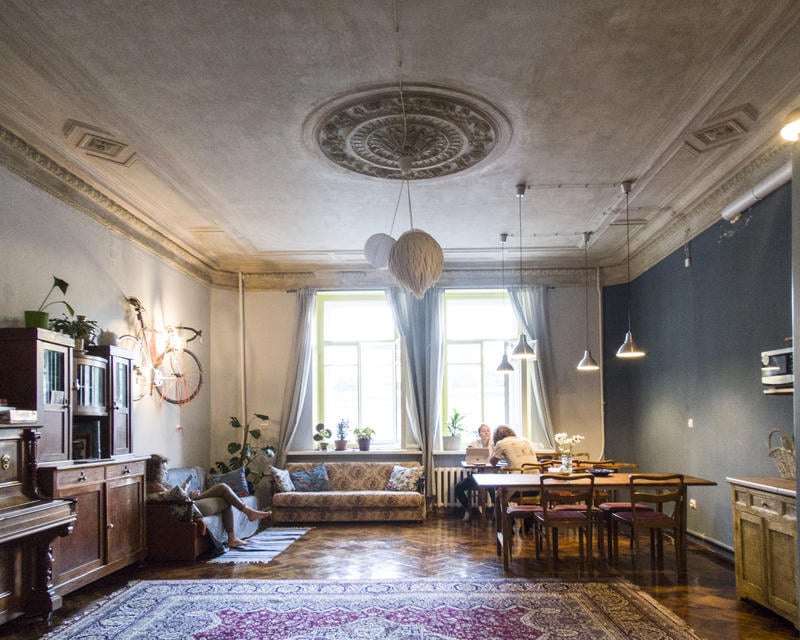
Our winner when it comes to the best hostel in St Petersburg in 2024, Chickadee has struck the balance just right when it comes to sociability and a place to rest up and recharge. The city centre location is ideal for exploring, and members of staff are happy to fill you in about hidden gems and local secrets. Fill up on a traditional Russian breakfast (it’s free!) and whip up a feast in the well-equipped kitchen. Laundry and Wi-Fi are also free and the common room has a piano, books, and … a wall-mounted bicycle! Do note that minimum periods of stay apply at certain times.
Soul Kitchen – Best Hostel for Solo Travelers in St Petersburg

Our pick for the best hostel for solo travellers in St Petersburg, Soul Kitchen is a chilled-out hostel with a friendly and sociable atmosphere. Meet and mingle in the games room, complete with foosball, a Wii, and board games, or have a movie marathon with the wide assortment of DVDs. Swap recipes and have an international cook-off in the spacious kitchen. Dorm beds have curtains for privacy, reading lights, and a shelf, and private rooms are quite fancy! Lockers and 24-hour security keep things safe and secure. A tour desk, free Wi-Fi, laundry facilities, airport transfers, hair dryers, and free parking add to the comfort.
Hostel Samovar – Best Cheap Hostel in St Petersburg

In our eyes, Hostel Samovar is the best cheap hostel in St Petersburg, hands down. Prices are more than reasonable for the single-gender dorms and private rooms, and the facilities are top notch. You’ll find free tea and coffee in the well-equipped kitchen and cable TV and board games in the sociable common room. Wi-Fi is free and the friendly members of staff regularly arrange cheap outings. And, housekeeping services keep the place looking spick and span. Travellers can keep their stuff safe and secure in lockers, and the hostel is in a quiet neighbourhood yet within walking distance of the famous Nevsky Prospect.

We’ve tested countless backpacks over the years, but there’s one that has always been the best and remains the best buy for adventurers: the broke backpacker-approved Osprey Aether and Ariel series.
Want more deetz on why these packs are so damn perfect? Then read our comprehensive review for the inside scoop!
Vitamin Hostel – Best Hostel for Couples in St Petersburg
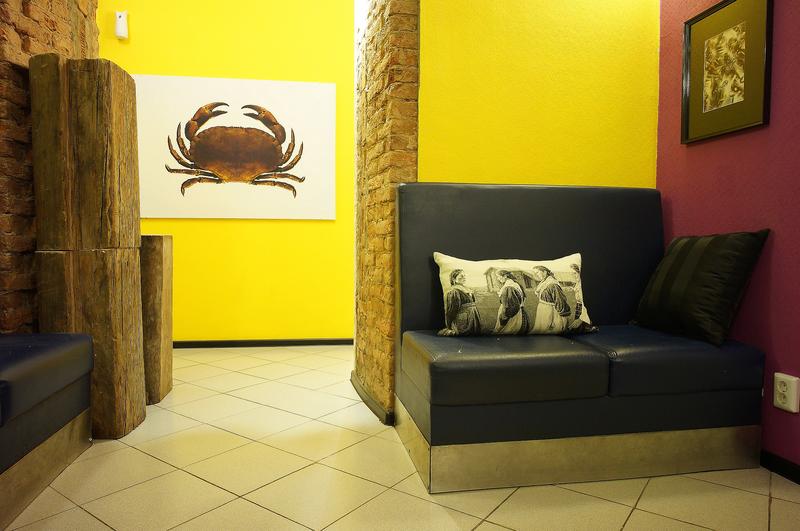
Among the best hostels in St Petersburg for couples, the intimate Vitamin Hostel has all the convenience of a hostel and private rooms for two. You and your sweetheart will need to share a bathroom with other couples, but whatever you get up to when the lights go off in the privacy of your own room is between you and the walls. With just ten rooms, you can enjoy a peaceful stay while also being able to socialise with other loved-up travellers if you wish. The historic building adds to the romantic vibe. Facilities include a kitchen, TV room, free laundry facilities, and free Wi-Fi. Do note that a minimum two-night stay usually applies.
The Cuba Hostel – Best Party Hostel in St Petersburg
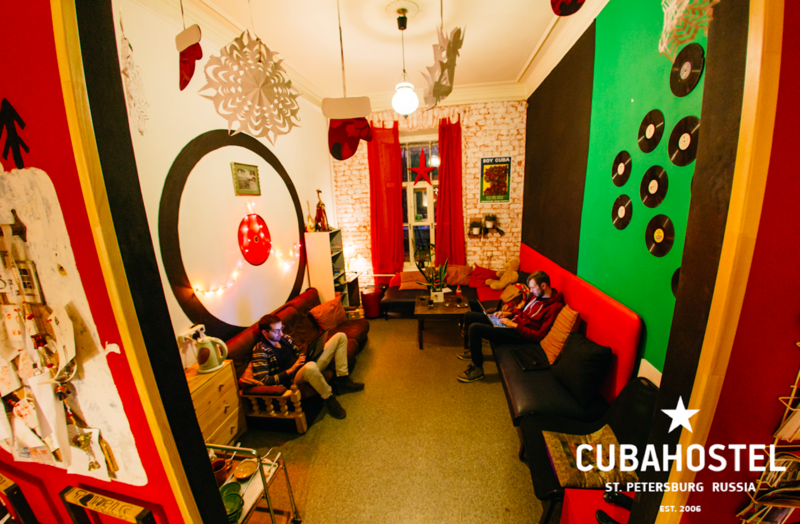
If you’re looking for the best party hostel in St Petersburg, The Cuba Hostel promises heaps of fun and frolics. The party-loving members of staff are always down for a night on the town, showing you the hidden nightspots and helping you to have many nights out to remember (or, possibly, not!) in St Petersburg. The onsite bar is always lively and you’ll even get treated to free vodka shots! Soothe aching heads in the steam room and lounge, and use the kitchen to create the perfect hangover cure.
Fontaka River View Hostel – Best Hostel for Digital Nomads in St Petersburg

One of the best hostels in St Petersburg for digital nomads , Fontaka River View Hostel has free Wi-Fi and computers that you can use, as well as large common areas where it’s easy to find a quiet spot to get your head down and focus on important tasks. Power outlets are plentiful. Free and unlimited tea and coffee might be just the pick-me-up you need to meet those deadlines. Grab a bite to eat from the snack bar or take time out and cook a wholesome meal in the spacious kitchen. There are mixed and female dorms as well as private rooms for two.

Stash your cash safely with this money belt. It will keep your valuables safely concealed, no matter where you go.
It looks exactly like a normal belt except for a SECRET interior pocket perfectly designed to hide a wad of cash, a passport photocopy or anything else you may wish to hide. Never get caught with your pants down again! (Unless you want to…)
More of the best hostels in St Petersburg
Some neighborhoods are more fun than others – discover which are the best areas to stay in St Petersburg and then book the right hostel!
Babushka House
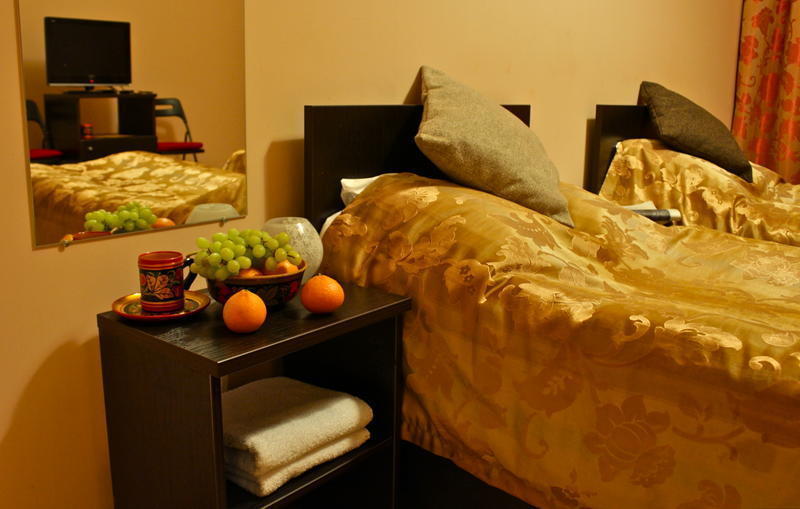
One of the best budget hostels in St Petersburg, Babushka House is a hip and happening hostel with a sociable heart. There are regular excursions for travellers to uncover St Petersburg’s best spots, as well as guitar evenings, international dinners, and pancake feasts. The mini bar keeps you topped up with beers and snacks and you can mingle with other cool cats in the lounge. There’s a TV, DVDs, free Wi-Fi, and board games to keep you entertained when there’s not some crazy event taking place. A well-equipped kitchen, free breakfasts, laundry facilities, and a steam room, combined with affordable prices, make this a recommended hostel in St Petersburg.
Traveller’s Palace

A gorgeous themed hostel close to major transportation links, Traveller’s Palace is an ideal St Petersburg backpacker’s hostel for people who love to eat, sleep, and breathe culture and heritage. Travel back to the time of the Tsars and enjoy splendour in each of the uniquely designed dorms and private rooms. Safe and secure, thanks to round-the-clock security, key card access, and individual lockers, the hostel has a brand-spanking new modern kitchen, a common room, laundry facilities, and free Wi-Fi … that’s more mod-cons than the Tsars had!
Dolce Vita Hostel
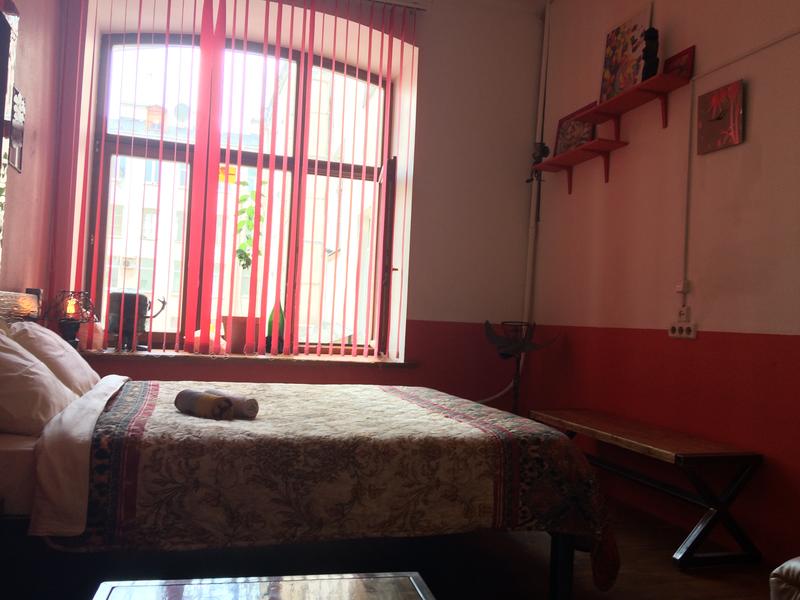
The Dolce Vita Hostel really does offer a taste of the good life in the heart of historic St Petersburg. Located on Nevsky Prospekt, the hostel is comfortable, bright, and airy. Keep yourself looking on form with the washing machine and iron, cook up a storm in the kitchen, and relax with a nice cup of tea at the end of a busy day sightseeing in St Petersburg. The cosy lounge is inviting and a great place to meet other travellers and unwind. This top hostel in St Petersburg offers free Wi-Fi and a large communal TV.
Metro-Tour Hostel

Located just a short walk from Elektrosila Metro Station and with airport transfers available, there’s no need to hunt high and low for an affordable and comfortable St Petersburg hostel near the airport when you book a stay at the calm and relaxed Metro-Tour Hostel. There are heaps of amenities and attractions close to hand too. There are dorms for five and eight as well as private rooms for one and two. The family-run café serves tasty and affordable meals, though there’s also a shared kitchen if you want to channel your inner super chef. Unwind in the lounge or steam room, and sleep soundly thanks to 24-hour security and safety deposit boxes.
Simple Hostel
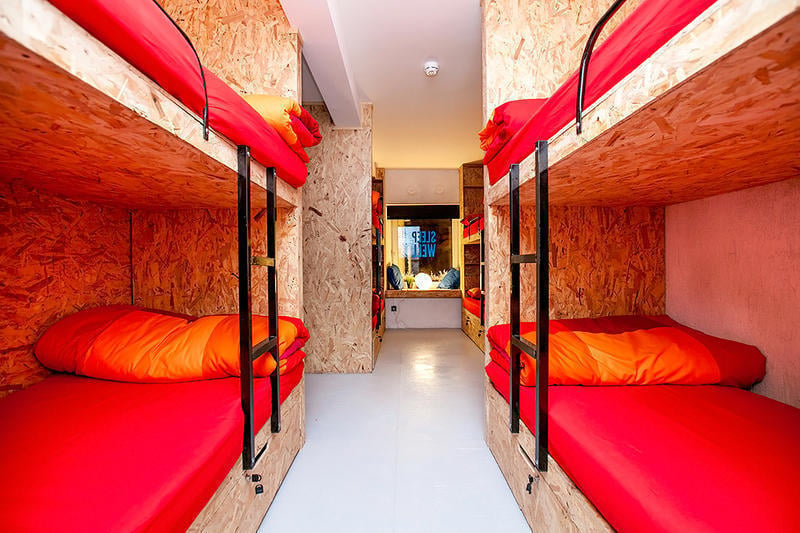
A top hostel in St Petersburg for solo travellers and small groups of friends looking to meet new buddies and stay in sociable digs, the bright and colourful Simple Hostel is far from basic. Friendly members of staff are waiting to greet you, and there’s a new kitchen/dining area, a cosy TV lounge, free Wi-Fi, and free-to-use laptops. Laundry facilities, luggage storage, and a steam room are available too. Pick up a free city map and get your peddle power on to explore St Petersburg on a rented bike.
Baby Lemonade Hostel
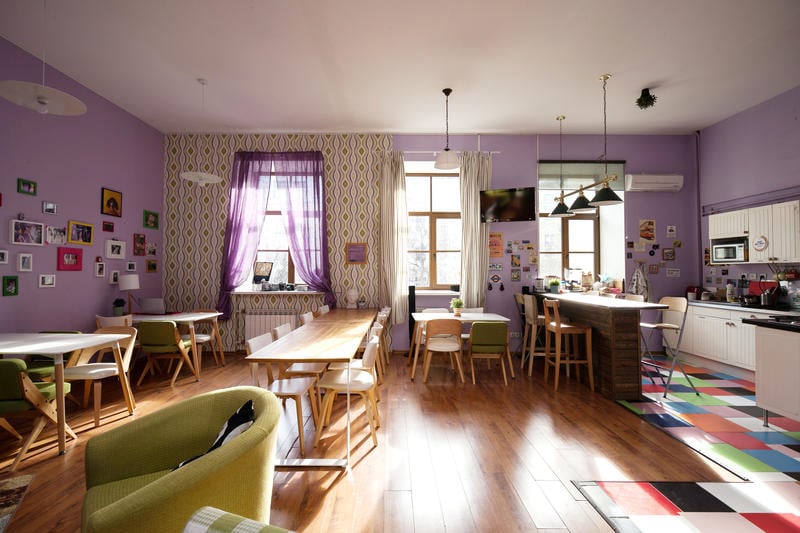
Fresh, fun, and funky, Baby Lemonade has to be the coolest hostel in St Petersburg. Enter a trippy time warp and be transported back to the 60s and 70s, decades of flower power, love, and peace. All dorms and rooms are unique, and the sociable common area is pretty awesome too. Peace out with other laid-back travellers in the cafe and join in with the lively weekend parties. Rustle up a meal in the kitchen, catch up with your laundry (nobody likes a stinky backpacker!), and browse the net with free Wi-Fi.
No Rain No Pain
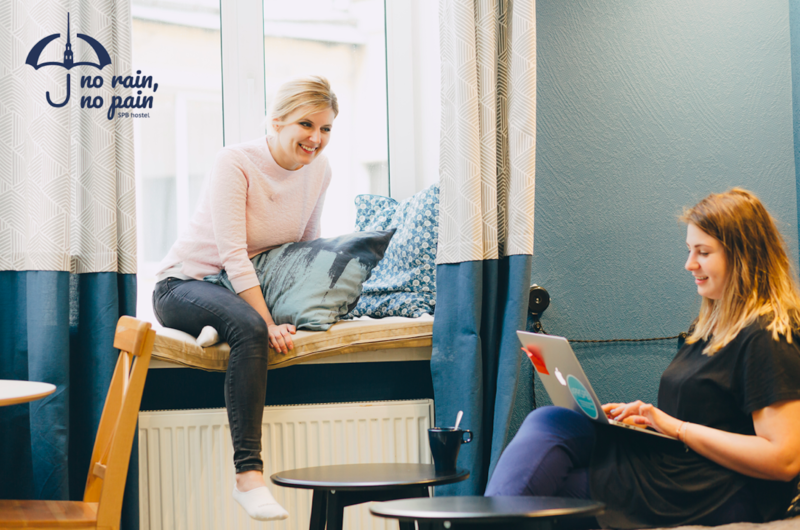
Although St Petersburg is known for being one of the rainiest cities in the world, No Rain No Pain does exactly what it says—it makes enjoying St Petersburg fun, and dry, whatever the weather. This awesome St Petersburg backpacker’s hostel provides umbrellas and raincoats and, if you do get wet, there are dryers for clothes and shoes, as well as laundry facilities. Warm up with a cup of hot tea or coffee—it’s on the house. Prefer to stay indoors? Chill in the common room, with free Wi-Fi, or get creative in the large kitchen.
Kryshi Mira
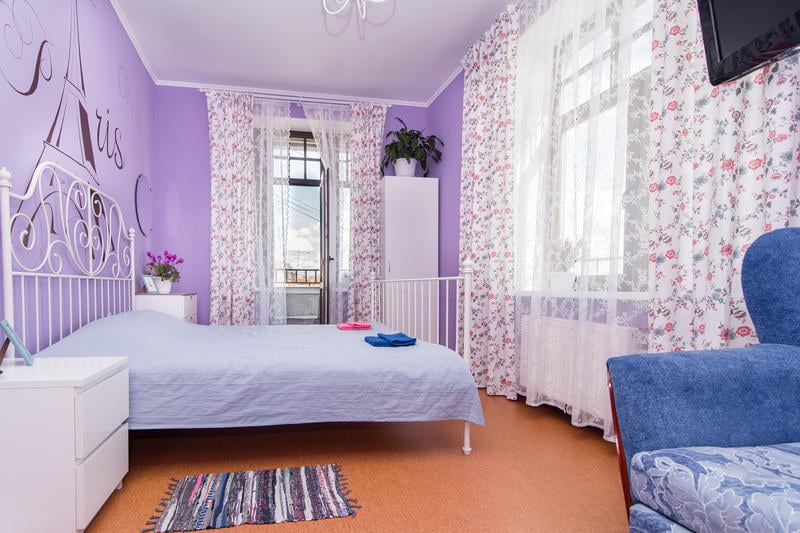
A highly recommended hostel in St Petersburg, Kryshi Mira is in the charming neighbourhood of Tsentralny, filled with historic character and close to many of St Petersburg’s major attractions . Double and family rooms are available as well as mixed and female-only dorms, and all guests can make full use of the large and modern kitchen. Mingle and share travelling tips in the TV lounge. Laundry facilities add to the comfort and Wi-Fi is free. Do note that you’ll need to have your own towel or pay to rent one.
Likehome Hostel
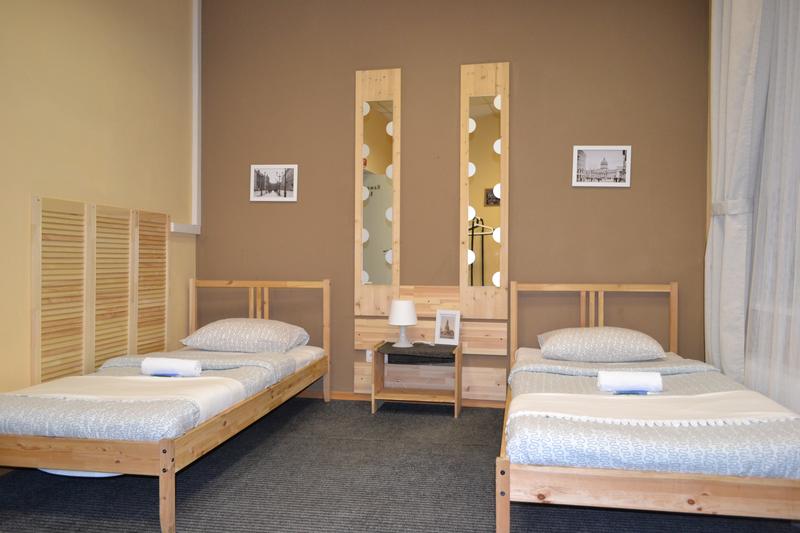
As the name suggests, Likehome Hostel is a cosy and welcoming home-from-home in St Petersburg. Situated in the Petrograd district, it’s a top youth hostel in St Petersburg for travellers who love historic sightseeing. It’s close to the metro too, making getting around a piece of cake. The welcoming hostel has female-only dorms for four and eight, and male-only dorms for four and ten, as well as private rooms in different sizes, ideal for families, couples, and groups of mates. Grab last-minute souvenirs from the onsite gift shop, relax in the lounge, and save money by cooking your own meals in the kitchen.
GooDHoliday
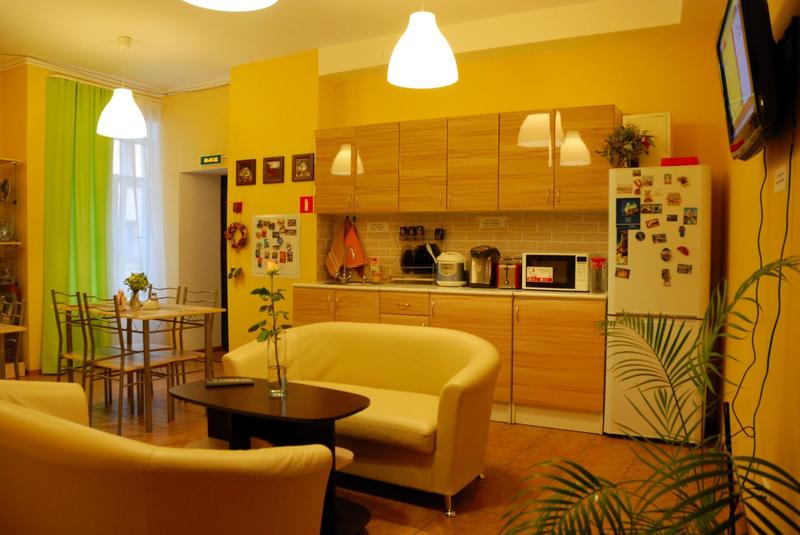
GooDHoliday has a youthful vibe and is located close to a variety of fabulous bars, clubs, and restaurants. It’s a top St Petersburg hostel for backpackers who want to make the most of their nights as well as their days. The nearest metro station is just a five-minute walk away. The kitchen-cum-living room is sociable and you can challenge your new pals to a board game play-off. Freebies include Wi-Fi and tea and coffee.
Forever Young Hostel
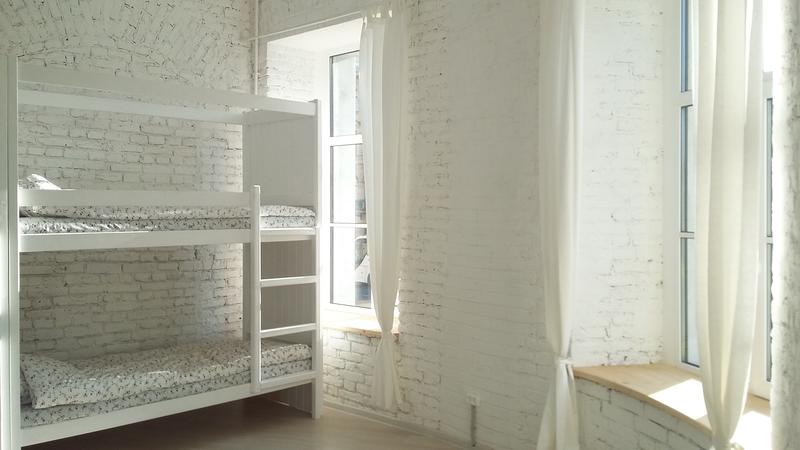
Located in the heart of St Petersburg and house within an old-world building, Forever Young Hostel is close to Baltic Train Station. There are two six-bed mixed dorms along with private rooms for between two and four. Have a comfortable stay with an inviting lounge and kitchen, and benefit from free Wi-Fi, tea and coffee, parking, and towels.
Inbox Capsule Hostel
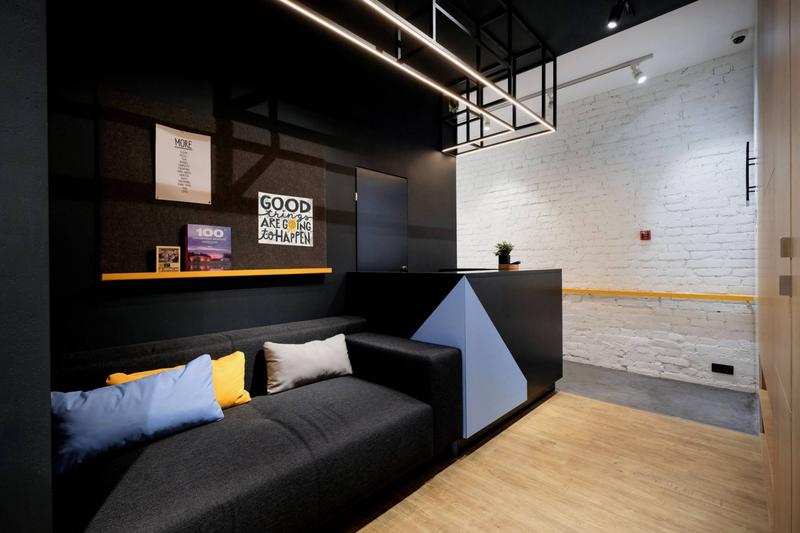
A great hostel in St Petersburg for solo backpackers, couples, and friends, Inbox Capsule Hostel has private rooms for one and two as well as pod-like beds in spacious dorms. Each sleeping capsule has a hanging rail, a personal light and a power outlet, and you can shutter yourself away for sweet dreams in peace and privacy. Each guest has a locker under the double-stacked sleep boxes. Dorms have a long desk, and they are bright with urban chic. There’s on onsite café as well as a kitchen and a lounge, and other handy amenities include luggage storage and laundry facilities. Wi-Fi and breakfast are free.
Polosaty Hostel
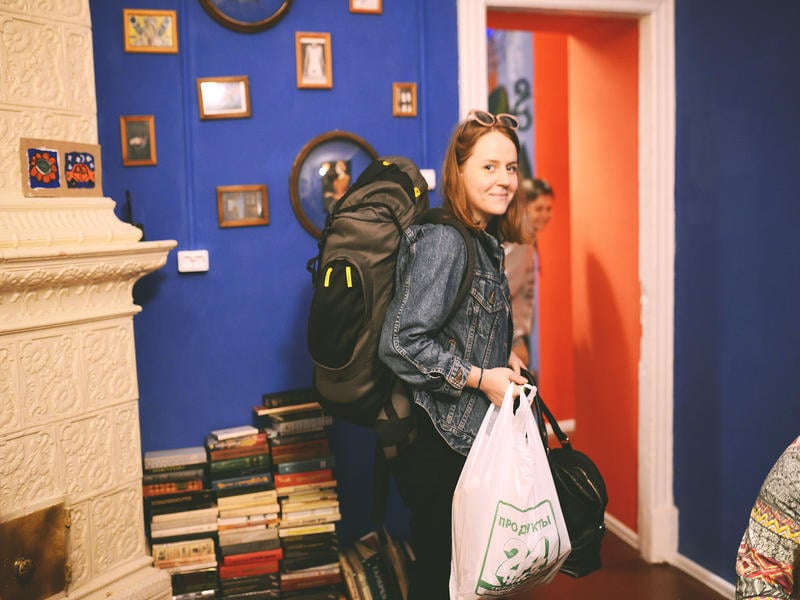
A great youth hostel in St Petersburg for travellers who value tranquillity and a sense of calm, with splashes of quirkiness and hand-made charms, the Polosaty Hostel is a great base from which to explore St Petersburg and then return to a friendly atmosphere and a good night’s rest. The members of staff are always happy to provide tips and recommendations for your city stay, and there’s a kitchen and lunge so you can truly feel at ease. Wi-Fi access is free, as are city maps. We wouldn’t be surprised if this didn’t become one of the best hostels in St Petersburg in 2021.
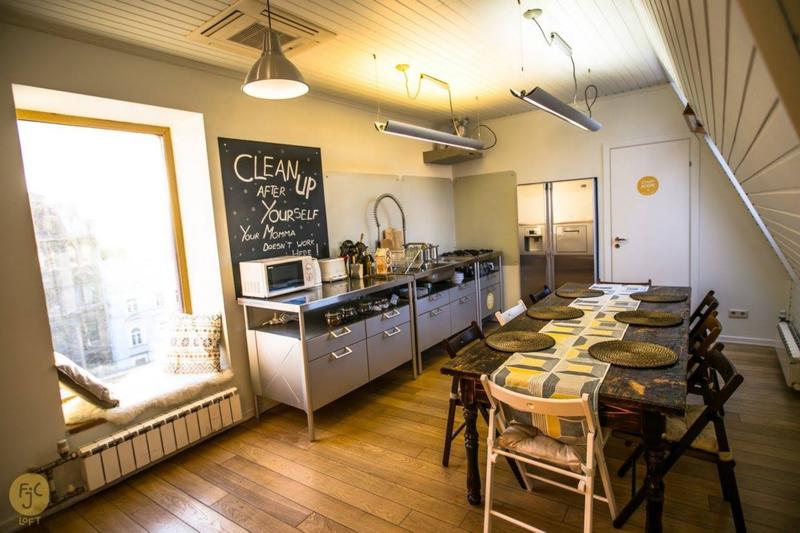
Situated in a trendy part of the St Petersburg and with fab views of the starry night and city streets, FJC Loft is a great all-round youth hostel in St Petersburg. Hand-painted beds add something a little unique and everyone has a locker. Black-out curtains ensure the rising sun doesn’t wake you prematurely from your slumber. The comfy lounge has a TV, board games, and book exchange and there’s even a separate quieter zone for getting work done. You can get out and about with handy tips from the staff and tours arranged onsite. Furthermore, there’s a kitchen, laundry facilities, free Wi-Fi, luggage storage, and a steam room.
Pants, socks, underwear, soap?! Take it from me, packing for a hostel stay is not always quite as straightforward as it seems. Working out what to bring and what to leave at home is an art I have perfected over many years.

Snoring dorm-mates can ruin your nights rest and seriously damage the hostel experience. This is why I always travel with a pack of decent ear plugs.

Hanging Laundry Bag
Trust us, this is an absolute game changer. Super compact, a hanging mesh laundry bag stops your dirty clothes from stinking, you don’t know how much you need one of these… so just get it, thank us later.

Sea To Summit Micro Towel
Hostel towels are scummy and take forever to dry. Microfibre towels dry quickly, are compact, lightweight, and can be used as a blanket or yoga mat if need be.

Monopoly Deal
Forget about Poker! Monopoly Deal is the single best travel card game that we have ever played. Works with 2-5 players and guarantees happy days.

Grayl Geopress Water Bottle
Always travel with a water bottle! They save you money and reduce your plastic footprint on our planet. The Grayl Geopress acts as a purifier AND temperature regulator. Boom!
Check out our definitive Hostel Packing list for our top packing tips!
Seriously, St Pete is a highly underrated destination. Hopefully with the help of this guide, you’ll have a much better idea of where you want to stay so you can book your hostel quickly and getting to drinking vodk… I mean, exploring St. Petersburg!
And remember, if you can’t decide, our number one recommendation for the best hostels in St. Petersburg is Chickadee Hostel.
Here are some questions backpackers ask about hostels in Saint Petersburg.
What are the best hostels in St Petersburg?
This city is such an underrated gem! Get your trip off to the best start by staying at one of these hostels: – Chickadee Hostel – Vitamin Rooms – The Cuba Hostel
Where should a digital nomad stay in St Petersburg?
We’d go with Fontaka River View Hostel for a great place to knuckle down and get your hustle on while in St Petersburg.
What are some good cheap hostels in St Petersburg?
There are a couple of great options throughout the city, such as The Cuba Hostel and Hostel Samovar
Where can I book hostels for St Petersburg?
A great way to find a hostel that suits you and your budget is to head over to Hostelworld! It’s our preferred way to find a place to stay while on the road.
What are the best hostels in Saint Petersburg for couples?
Check out these awesome couple hostels in Saint Petersburg: Vitamin Hostel Likehome Hostel Inbox Capsule Hostel
What is the best hostel in Saint Petersburg near the airport?
The Pulkovo Airport is quite far from the city center, so it is usually better to find the best place that offers airport transfers. Once you’re in the city, we highly recommend Metro-Tour Hostel, just a short walk from Elektrosila Metro Station.
Travel Safety Tips for Saint Petersburg
ALWAYS sort out your backpacker insurance before your trip. There’s plenty to choose from in that department, but a good place to start is Safety Wing .
They offer month-to-month payments, no lock-in contracts, and require absolutely no itineraries: that’s the exact kind of insurance long-term travellers and digital nomads need.

SafetyWing is cheap, easy, and admin-free: just sign up lickety-split so you can get back to it!
Click the button below to learn more about SafetyWing’s setup or read our insider review for the full tasty scoop.
Hopefully by now you’ve found the perfect hostel for your upcoming trip to Saint Petersburg.
Planning an epic trip all across Russia or even Europe itself?
Don’t worry – we’ve got you covered!
For more cool hostel guides around Europe, check out:
- Best hostels in Moscow
- Best hostels in Oslo
- Best hostels in Tallinn
- Best hostels in Vilnius
- Best hostels in Warsaw
Over to you
By now I hope our epic guide to the best hostels in Saint Petersburg has helped you choose the perfect hostel for your adventure!
If you think we’ve missed anything or have any further thoughts, hit us up in the comments!
- Not sure what to do once you arrive? We’ve got all the best places to visit in St Petersburg covered.
- Check out the best places to stay in St Petersburg before you arrive.
- Prepare for your trip with our backpacking packing list .
Buy Us a Coffee !
A couple of you lovely readers suggested we set up a tip jar for direct support as an alternative to booking through our links. So we created one!
You can now buy The Broke Backpacker a coffee . If you like and use our content to plan your trips, it’s a much appreciated way to show appreciation 🙂

Alya and Campbell
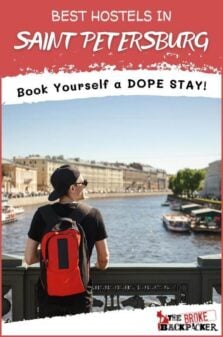
Share or save this post

Leave a Reply Cancel reply
Your email address will not be published. Required fields are marked *
Save my name, email, and website in this browser for the next time I comment.
Notify me of followup comments via e-mail.

IMAGES
VIDEO
COMMENTS
The Klymit Luxe is notable as well. Measuring 12.5 x 22 inhces, it is one of the largest pillows we studied but packs down to just 0.8 liters. On the extreme end of the scale is the Hest Pillow, with a packed size of 11.4 liters. But, as noted above, this is the most comfortable option in our lineup.
Best Camping & Backpacking Pillow Overall: Therm-a-Rest Compressible ($32) Jump to Review. Best Budget Backpacking Pillow: Trekology Aluft Pro ($22) Jump to Review. Best Stuff Sack Pillow for Ultralight Backpacking: Hyperlite Mountain Gear Stuff Sack Pillow ($59) Jump to Review. Best Budget Camping Pillow: Wise Owl Outfitters Camping Pillow ...
A Close Second (That's More Packable) 2. Nemo Fillo Pillow ($45) Best for: Camping and backpacking. Type: Inflatable w/ foam. Weight: 9.2 oz. Dimensions: 17 x 11 x 4 in. What we like: Combination of air and foam offers great cushioning and support with minimal bulk.
Cost: $39.95. Best For: Car Camper, Wilderness Backpacker. The Klymit Luxe Pillow will surprise you with its size. The weight makes it a backpacking pillow (just over 6 ounces), but the impressive 22-inch width gives it a true-pillow ability, allowing you to roll your head side to side like you're on a real bed.
There are four main types of backpacking pillows: stuff sack pillows, inflatable pillows, compressible pillows, and hybrid pillows. We tested a number of different types when looking for the best backpacking pillow — like the inflatables, compressibles, and hybrids shown here. INFLATABLE PILLOWS: Inflatable pillows use an air sack as the main ...
Best Stuff Sack Pillow: Therm-a-Rest Trekker. "A wonderfully soft, uber-practical liner that lets you save precious pack space for other things.". Best Ultralight: Exped Air Pillow UL. "The Air UL's ultralight weight, tiny packed size, and durable fabric make it the perfect pick for long-term backcountry travel.".
PHOTO: REI. $37 at Amazon $37 at REI $47 at Backcountry.com. This is a hardy, machine-washable pillow good for front-country camping, road trips, and air travel. The fill can get lumpy after a lot ...
Hyperlite Mountain Gear Ultralight Backpacking Pillow: Stuff sack with lightly padded top: Good: 19 oz: 12 x 17" Unavailable: Variable: $59: Zpacks Ultralight Medium Pillow: Stuff sack with lightly padded top ... backpacking, travel to find the best lightweight rain jackets. We tested side-by-side for waterproofing, breathability, comfort ...
Best Overall: Therm-a-Rest Air Head Down Pillow. Best Memory Foam: NEMO Fillo Backpacking & Camping Pillow. Best Oversize: Sea to Summit Aeros Down Pillow. Best Lightweight: Therm-a-Rest Air Head Lite Pillow. Best Budget: Outdoor Vitals Ultralight Stretch Pillow. Best Pillowcase: Rumpl Stuffable Pillowcase. Pillow. Price. Weight.
Camping pillow quick picks. Comfortable and inflatable: Nemo Fillo Elite Ultralight Backpacking Pillow. For ultra-light backpackers: Outdoor Vitals Ultra-Light Nonslip Stretch Pillow. For car ...
Editor's Note: We updated our Best Camping Pillows guide on August 19, 2024, to totally revamp our current selections. Favorites include the EXPED Mega Pillow, L.L.Bean Flannel Camp Pillow, and ...
Comfort: 7/10. Bottom Line. Sea to Summit's Aeros Premium Pillow is another strong pick for those who need a pillow suitable for backpacking but aren't entirely willing to sacrifice comfort. This pillow comes in two size offerings, with the smaller of the two being very light and suitable for traveling around.
Weight is one of the top considerations for any mountaineering or backpacking trip. Unlike a car camping pillow, backpacking pillows need to be relatively lightweight. Any extra weight can slow you down on the trail or leave your back aching at the end of a big day. For extended trips or larger mountaineering objectives, things can get heavy ...
Best Inflatable Pillow: Therm-a-Rest Air Head Inflatable Travel Pillow. Best Budget Backpacking Pillow: Klymit Luxe Pillow. Best Luxury Backpacking Pillow: Sea to Summit Aeros Premium Pillow. Best for Neck & Back Support: Exped Air Pillow. Best Backpacking Pillow for Kids: TETON Sports Camp Pillow.
May not be high enough for some sleepers. Get Price. 3. Wise Owl Outfitters Camping Pillow. For those on a budget, I'd recommend getting the Wise Owl Outfitters Camping Pillow. It's a great bargain for a quality backpacking and camping pillow. You get foamy support with a soft, micro-suede cover for added softness.
2 breaths. InstantCamp Pillow. 42. 2.4 oz. Nylon. 4 breaths. If you're on the hunt for the perfect backpacking pillow, it's time to look past the inflatables. After field testing 9 popular options over the course of a month, we think the Therm-a-Rest Trekker Pillow Case is the best 'pillow' for most backpackers.
Trekology ALUFT 2.0 Ultralight Camping Pillow (Best Budget Pillow) Sea to Summit Aeros Premium (Best Value Pillow) Therma-a-Rest Air Head™ Down Pillow (Best for Comfort) Big Agnes Q Core Deluxe Inflatable Travel Pillow (Best Of the Rest) Best Stuff Sack Backpacking Pillows.
Camping Pillow - Soft & Breathable Backpacking Pillow for Camping w/Gel Memory Foam, Cotton - Water-Resistant, Blue Camp Pillows for Sleeping - 17" x 14" x 4.5" Travel Size Camp Pillow. 22. $3399. FREE delivery Mon, May 20 on $35 of items shipped by Amazon. Girls Inflatable Camping Pillow Lite Kids w.
Price: $39.99 or less Button Enhancement : Best Travel Pillows - Cabeau Evolution S3 - Amazon . Best Affordable: MVLOC Travel Pillow. Travelers appreciate the support (and the price tag) of this ...
This inflatable neck pillow blows up for travel with just a few deep breaths, and at only 2.5 ounces, it packs down conveniently into a small, zippered case that's stuffable into any bag.
The TUBE combines free extra luggage and travel neck pillow, saving up to $100s and more in excess luggage fees and optimizing packing efficiency ... Travel neck pillow and Backpack. From the brand. Previous page. TUBE: The travel pillow that pays for itself! Pack efficiently and skip the checked luggage fees with a winning combination of ...
Will not separate set 40L hiking backpack- Lithic Lithic 35 degree sleeping bag, mummy bag, down Yukon outfitters hammock tarp Yukon outfitters mosquito hammock Location ... Aer Travel Pack 2 backpack. San Francisco, CA. $30 $40. 15'' Gray Herringbone Laptop Backpack [NEW] Redwood City, CA. $34.
For your comfort, you will find slippers, free toiletries and a hairdryer. There is a 24-hour front desk and hairdresser's at the property. Church of the Savior on Spilled Blood is 2.3 km from Backpacker hostel, while Saint Isaac's Cathedral is 2.6 km from the property. The nearest airport is Pulkovo Airport, 14 km from Backpacker hostel. Show More
Visit St. Pete-Clearwater. Home to America's Best Beaches, a vibrant arts community and amazing outdoor experiences, St. Pete-Clearwater is a sunny destination that travelers adore. In fact, we were named among the top 100 most-loved travel destinations in the world! And Forbes named St. Pete among its "Best Places to Travel in the U.S." for 2023!
Dolce Vita Hostel. Dolce Vita is one of the best hostels in St Petersburg Russia. $$$. Tour Desk. Luggage Storage. Elevator. The Dolce Vita Hostel really does offer a taste of the good life in the heart of historic St Petersburg. Located on Nevsky Prospekt, the hostel is comfortable, bright, and airy.